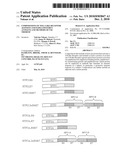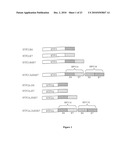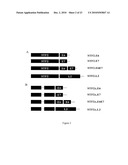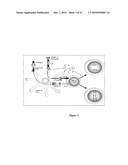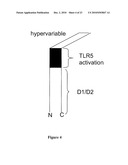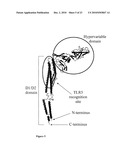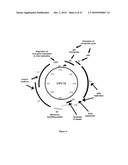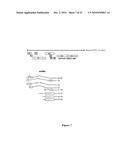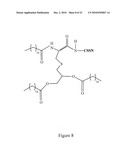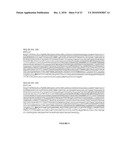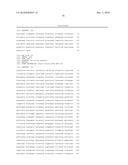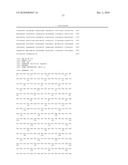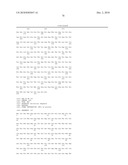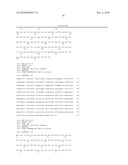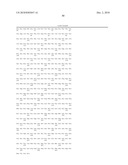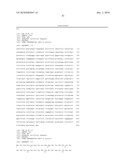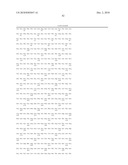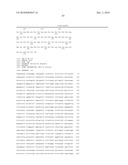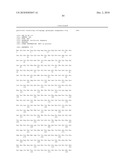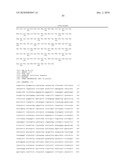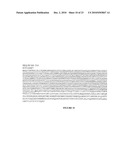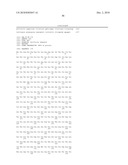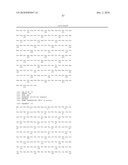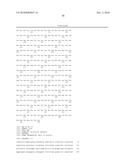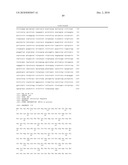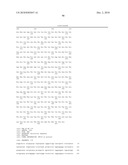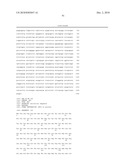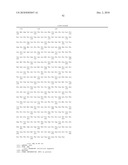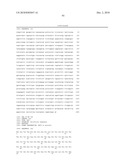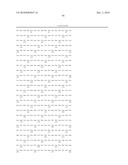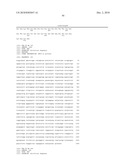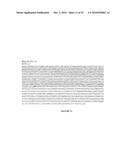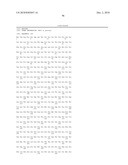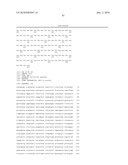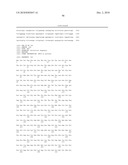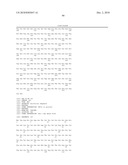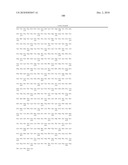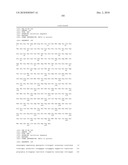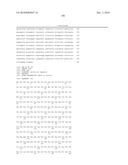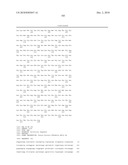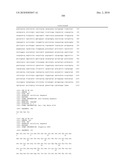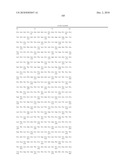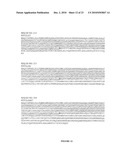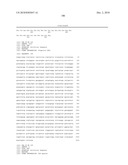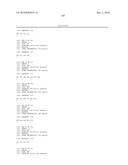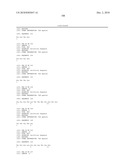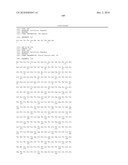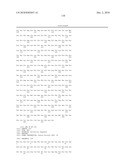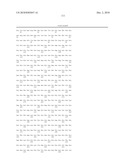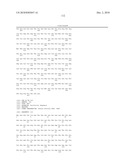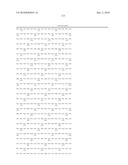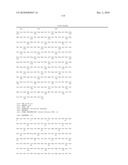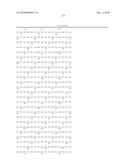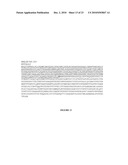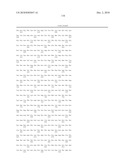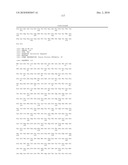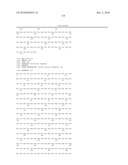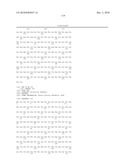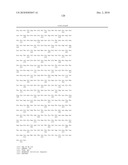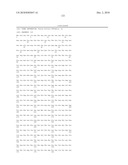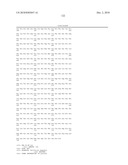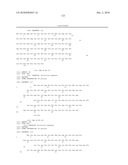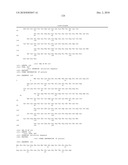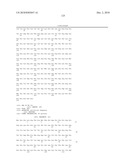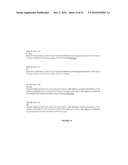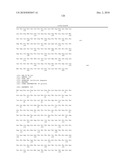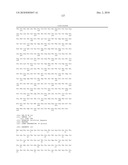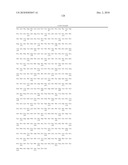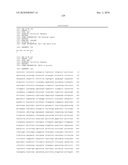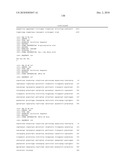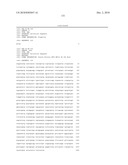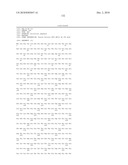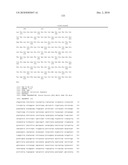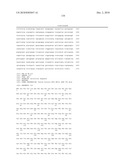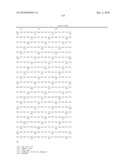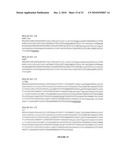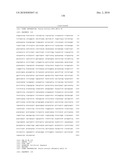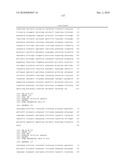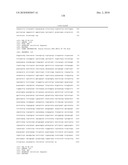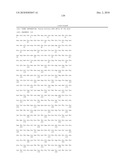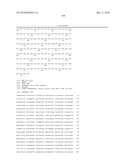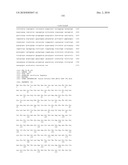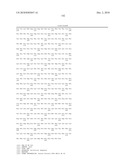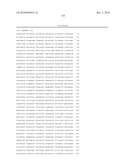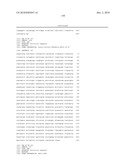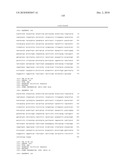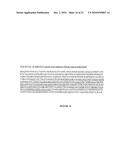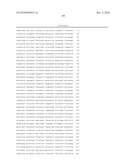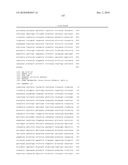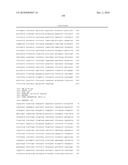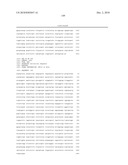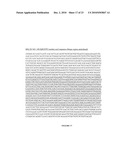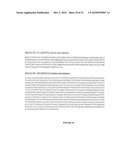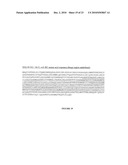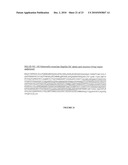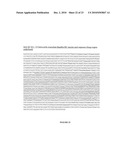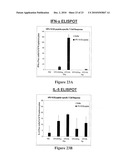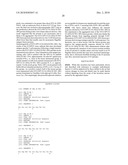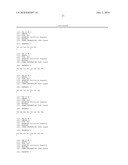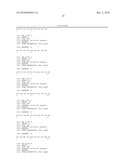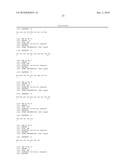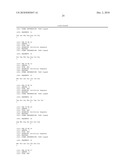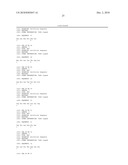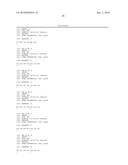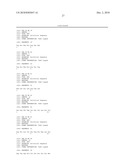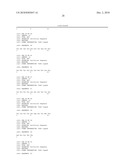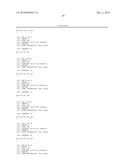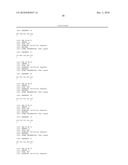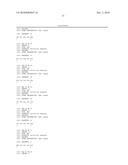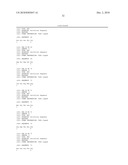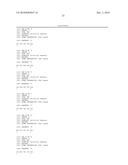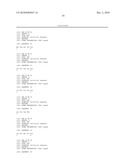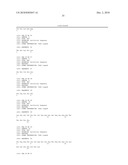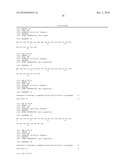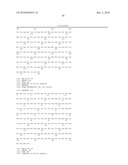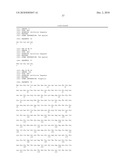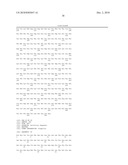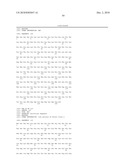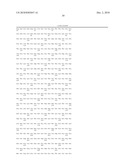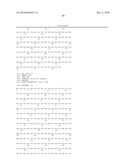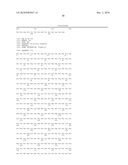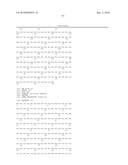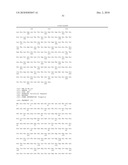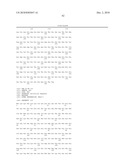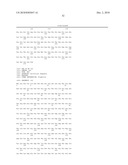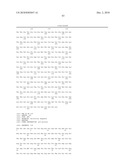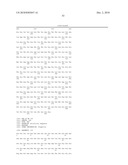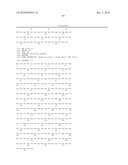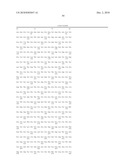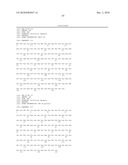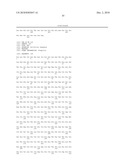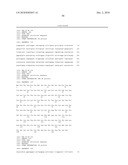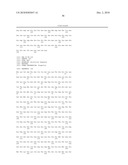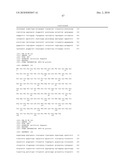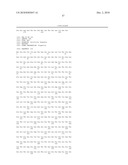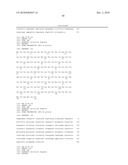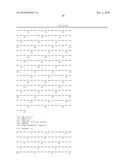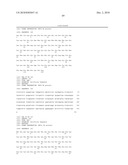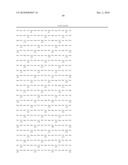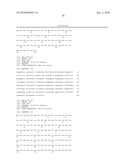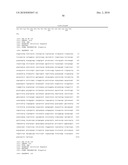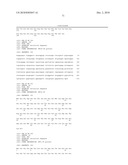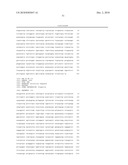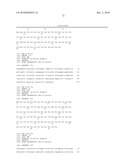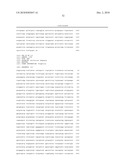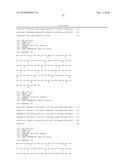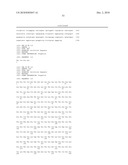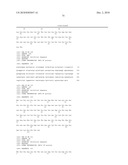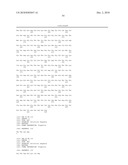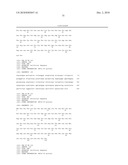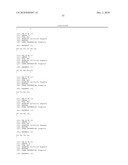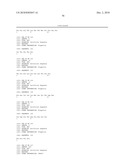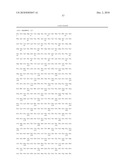Patent application title: COMPOSITIONS OF TOLL-LIKE RECEPTOR AGONISTS AND PAPILLOMAVIRUS ANTIGENS AND METHODS OF USE THEREOF
Inventors:
Valerian Nakaar (Hamden, CT, US)
James W. Huleatt (Nazareth, PA, US)
Thomas J. Powell (Madison, CT, US)
Thomas J. Powell (Madison, CT, US)
Albert E. Price (New Haven, CT, US)
IPC8 Class: AA61K3912FI
USPC Class:
4241861
Class name: Antigen, epitope, or other immunospecific immunoeffector (e.g., immunospecific vaccine, immunospecific stimulator of cell-mediated immunity, immunospecific tolerogen, immunospecific immunosuppressor, etc.) amino acid sequence disclosed in whole or in part; or conjugate, complex, or fusion protein or fusion polypeptide including the same disclosed amino acid sequence derived from virus
Publication date: 2010-12-02
Patent application number: 20100303847
Claims:
1. A composition that includes at least one protein that includes at least
a portion of at least one Toll-like Receptor agonist and at least a
portion of at least one papillomavirus tumor suppressor binding protein,
wherein the protein activates a Toll-like Receptor.
2. The composition of claim 1, wherein the Toll-like Receptor agonist and the papillomavirus suppressor binding protein are components of a fusion protein.
3. The composition of claim 1, wherein the Toll-like Receptor agonist is a Toll-like Receptor 5 agonist.
4. The composition of claim 3, wherein the Toll-like Receptor 5 agonist includes at least a portion of at least one flagellin.
5. The composition of claim 4, wherein the flagellin lacks at least a portion of a hinge region.
6. The composition of claim 1, wherein the papillomavirus tumor suppressor binding protein includes at least one member selected from the group consisting of at least a portion of an E6 protein and at least a portion of an E7 protein.
7. The composition of claim 1, further including at least a portion of at least one member selected from the group consisting of a papillomavirus transforming protein and a papillomavirus capsid protein.
8. The composition of claim 7, wherein the papillomavirus transforming protein binds at least one member selected from the group consisting of a pRB protein and a p107 protein.
9. The composition of claim 7, wherein the papillomavirus capsid protein includes at least a portion of a major capsid protein.
10. The composition of claim 9, wherein the major capsid protein includes an L1 protein.
11. The composition of claim 7, wherein the papillomavirus capsid protein includes at least a portion of a minor capsid protein.
12. The composition of claim 11, wherein the minor capsid protein includes an L2 protein.
13. A composition that includes at least one protein that includes at least a portion of at least one Toll-like Receptor agonist and at least a portion of at least one papillomavirus transforming protein, wherein the protein activates a Toll-like Receptor agonist.
14. The composition of claim 13, wherein the Toll-like Receptor agonist and the papillomavirus transforming protein are components of a fusion protein.
15. The composition of claim 13, wherein the papillomavirus transforming protein includes at least one member selected from the group consisting of at least a portion of an E6 protein and at least a portion of an E7 protein.
16. A composition that includes at least one protein that includes at least a portion of at least one Toll-like Receptor agonist and at least a portion of at least one papillomavirus capsid protein, wherein the protein activates a Toll-like Receptor.
17. The composition of claim 16, wherein the Toll-like Receptor agonist and the papillomavirus capsid protein are components of a fusion protein.
18. The composition of claim 16, wherein the papillomavirus capsid protein includes at least a portion of at least one papillomavirus major capsid protein.
19. The composition of claim 16, wherein the papillomavirus capsid protein includes at least a portion of at least one papillomavirus minor capsid protein.
20. The composition of claim 19, wherein the papillomavirus minor capsid protein includes at least a portion of an L2 protein.
21. A composition that includes at least a portion of at least one Toll-like Receptor 5 agonist and at least a portion of at least one papillomavirus protein, wherein the papillomavirus protein includes at least one member selected from the group consisting of a papillomavirus E6 protein, a papillomavirus E7 protein and a papillomavirus L2 protein.
22. The composition of claim 21, wherein the Toll-like Receptor 5 agonist and the papillomavirus protein are components of a fusion protein.
23. The composition of claim 21, wherein the Toll-like Receptor 5 agonist includes at least a portion of at least one flagellin.
24. A method of stimulating an immune response in a subject, comprising the step of administering to the subject a composition that includes at least one protein that includes at least a portion of at least one Toll-like Receptor 5 agonist and at least a portion of at least one papillomavirus tumor suppressor binding protein, wherein the protein activates a Toll-like Receptor 5.
25. A method of stimulating an immune response in a subject, comprising the step of administering to the subject a composition that includes at least a portion of at least one Toll-like Receptor 5 agonist and at least a portion of at least one papillomavirus transforming protein, wherein the protein activates a Toll-like Receptor agonist 5.
26. A method of stimulating an immune response in a subject, comprising the step of administering to the subject a composition that includes at least a portion of at least one Toll-like Receptor 5 agonist and at least a portion of at least one papillomavirus capsid protein, wherein the protein activates a Toll-like Receptor 5.
27. A method of stimulating an immune response in a subject, comprising the step of administering to the subject a composition that includes a papillomavirus protein, wherein the papillomavirus protein includes at least a portion of at least a portion of a Toll-like Receptor 5 agonist and at least a portion of at least one member selected from the group consisting of a papillomavirus E6 protein, a papillomavirus E7 protein and a papillomavirus L2 protein.
Description:
RELATED APPLICATION(S)
[0001]This application is a continuation of International Application No. PCT/US2008/013149, which designated the United States and was filed on Nov. 26, 2008, published in English, which claims the benefit of U.S. Provisional Application No. 61/004,680, filed on Nov. 29, 2007. The entire teachings of the above applications are incorporated herein by reference.
BACKGROUND OF THE INVENTION
[0002]Papillomaviruses are DNA-viruses that infect the skin and mucous membranes of humans and a variety of animals. Over 100 different human papillomavirus (HPV) types have been identified. HPVs are transmitted by skin-to-skin contact. HPV infection can result in the abnormal growth and proliferation of infected cells. Gardasil® is a vaccine to prevent infection with some types of HPV (6, 11, 16, and 18), but is generally effective only if administered before an individual is infected with HPV. Thus, there is a need to develop new, improved and effective methods of treatment for preventing and managing disease associated with HPV infection.
SUMMARY OF THE INVENTION
[0003]The present invention relates to compositions that include HPV proteins, such as compositions that stimulate a protective immune response, and methods of making proteins that stimulate a protective immune response in a subject.
[0004]In an embodiment, the invention is a composition that includes at least one protein that includes at least a portion of at least one Toll-like Receptor agonist and at least a portion of at least one papillomavirus tumor suppressor binding protein, wherein the protein activates a Toll-like Receptor.
[0005]In another embodiment, the invention is a composition that includes at least one protein that includes at least a portion of at least one Toll-like Receptor agonist and at least a portion of at least one papillomavirus transforming protein, wherein the protein activates a Toll-like Receptor agonist.
[0006]In yet another embodiment, the invention is a composition that includes at least one protein that includes at least a portion of at least one Toll-like Receptor agonist and at least a portion of at least one papillomavirus capsid protein, wherein the protein activates a Toll-like Receptor.
[0007]In still another embodiment, the invention is a composition that includes at least a portion of at least one Toll-like Receptor 5 agonist and at least a portion of at least one papillomavirus protein, wherein the papillomavirus protein includes at least one member selected from the group consisting of a papillomavirus E6 protein, a papillomavirus E7 protein and a papillomavirus L2 protein.
[0008]An additional embodiment of the invention is a method of stimulating an immune response in a subject, comprising the step of administering to the subject a composition that includes at least one protein that includes at least a portion of at least one Toll-like Receptor agonist and at least a portion of at least one papillomavirus tumor suppressor binding protein, wherein the protein activates a Toll-like Receptor.
[0009]Another embodiment of the invention is a method of stimulating an immune response in a subject, comprising the step of administering to the subject a composition that includes at least a portion of at least one Toll-like Receptor agonist and at least a portion of at least one papillomavirus transforming protein, wherein the protein activates a Toll-like Receptor agonist.
[0010]A further embodiment of the invention is a method of stimulating an immune response in a subject, comprising the step of administering to the subject a composition that includes at least a portion of at least one Toll-like Receptor agonist and at least a portion of at least one papillomavirus capsid protein, wherein the protein activates a Toll-like Receptor.
[0011]In still another embodiment, the invention is a method of stimulating an immune response in a subject, comprising the step of administering to the subject a composition that includes a papillomavirus protein, wherein the papillomavirus protein includes at least a portion of at least a portion of a Toll-like Receptor 5 agonist and at least a portion of at least one member selected from the group consisting of a papillomavirus E6 protein, a papillomavirus E7 protein and a papillomavirus L2 protein.
[0012]The methods and composition of the invention can be employed to stimulate an immune response, in particular, a protective immune response, in a subject. Advantages of the claimed invention include, for example, cost effective methods and compositions that can be produced in relatively large quantities for use in the prevention and treatment of disease associated with papillomavirus infection. The claimed compositions and methods can be employed to prevent or treat papillomavirus infection, in particular human papillomavirus (HPV) and, therefore, avoid serious illness and death consequent to HPV infection.
BRIEF DESCRIPTION OF THE FIGURES
[0013]FIG. 1 depicts flagellin--HPV constructs.
[0014]FIG. 2 depicts constructs of flagellin and HPV antigen fusion proteins. The constructs include full length Salmonella typhimurium fljb (STF2) and STF2Δ, a flagellin lacking a portion of the hinge region.
[0015]FIG. 3 depicts the activation of an antigen-presenting cell (APC) by Toll-like Receptor (TLR) signaling.
[0016]FIG. 4 depicts the D1 domain, D2 domain, TLR5 activation domain and hypervariable (D3 domain) of flagellin.
[0017]FIG. 5 depicts the D1 domain, D2 domain, TLR5 activation domain and hypervariable (D3 domain) of flagellin (Yonekura, et al. Nature 424: 643-650 (2003)).
[0018]FIG. 6 depicts the HPV16 genome.
[0019]FIG. 7 depicts the HPV genome, mRNA and proteins.
[0020]FIG. 8 depicts a tripalmitoylated peptide.
[0021]FIG. 9 depicts the amino acid sequence of fusion proteins of the invention (STF2.E7; SEQ ID NO: 208 and STF2.E6; SEQ ID NO: 209).
[0022]FIG. 10 depicts the amino acid sequence of a fusion protein that includes STF2 and at least a portion of an E6 protein and an E7 protein (STF2.E6E7; SEQ ID NO: 210).
[0023]FIG. 11 depicts the amino acid sequence of a fusion protein that includes STF2 and at least a portion of a L2 protein (STF2.L2; SEQ ID NO: 211).
[0024]FIG. 12 depicts the amino sequence of a fusion protein that includes STF2Δ and at least a portion of an E7 protein (STF2Δ.E7; SEQ ID NO: 212), STF2Δ and at least a portion of an E6 protein (STF2ΔE6; SEQ ID NO: 213) and STF2Δ and at least a portion of an E6 protein and at least a portion of an E7 protein (STF2Δ.E6E7; SEQ ID NO: 214).
[0025]FIG. 13 depicts the amino acid sequence of a fusion protein of STF2Δ and at least a portion of an L2 protein (STF2Δ.L2; SEQ ID NO: 215).
[0026]FIG. 14 depicts the amino acid sequence of E7 (SEQ ID NOs: 216 and 217) and E6 proteins (SEQ ID NO: 218 and 219) for use in the compositions of the invention.
[0027]FIG. 15 depicts the amino acid sequences of proteins that include E6 and E7 HPV proteins (E6E7; SEQ ID NOs: 220 and 221) and L2 proteins (SEQ ID NOs: 222 and 223) for use in the compositions of the invention.
[0028]FIG. 16 depicts the amino acid sequence (SEQ ID NO: 98) of a flagellin for use in the compositions of the invention. The hinge region of the flagellin is underlined.
[0029]FIG. 17 depicts the nucleic acid sequence encoding a flagellin for use in the compositions of the invention (SEQ ID NO: 108). The nucleic acid sequence encoding the hinge region is underlined.
[0030]FIG. 18 depicts the amino acid sequence of a flagellin lacking a hinge region (SEQ ID NO: 101) for use in compositions of the invention and the corresponding nucleic acid sequence (SEQ ID NO: 109).
[0031]FIG. 19 depicts the amino acid sequence of a flagellin (SEQ ID NO: 106) for use in the compositions of the invention. The hinge region of the flagellin is underlined.
[0032]FIG. 20 depicts a nucleic acid sequence (SEQ ID NO: 111) encoding a flagellin for use in compositions of the invention. The nucleic acid sequence encoding the hinge region of the flagellin is underlined.
[0033]FIG. 21 depicts the amino acid sequence (SEQ ID NO: 102) of flagellin for use in the compositions of the invention. The hinge region of the flagellin is underlined.
[0034]FIG. 22 depicts a nucleic acid sequence (SEQ ID NO: 110) encoding a flagellin for use in the compositions of the invention. The nucleic acid sequence encoding the hinge region of flagellin is underlined.
[0035]FIGS. 23A and 23B depict HPV16 E6 antigen-specific T-cell responses in response to immunization with STF.2HPV16 E6 (SEQ ID NO: 209) by ELISPOT assay in IFN-γ-positive cells (FIG. 23A; 30 μg or 3 μg STF2.E6 in TITERMAX®) and IL-5-positive cells (FIG. 23B; 30 μg or 3 μg STF2.E6 in TITERMAX®).
DETAILED DESCRIPTION OF THE INVENTION
[0036]The features and other details of the invention, either as steps of the invention or as combinations of parts of the invention, will now be more particularly described and pointed out in the claims. It will be understood that the particular embodiments of the invention are shown by way of illustration and not as limitations of the invention. The principle features of this invention can be employed in various embodiments without departing from the scope of the invention.
[0037]The invention is generally directed to compositions of papillomavirus proteins, in particular, human papillomavirus (HPV) proteins and methods of stimulating an immune response, such as a protective immune response, in a subject employing the compositions described herein.
[0038]In an embodiment, the invention is a composition that includes at least one protein that includes at least a portion of at least one Toll-like Receptor agonist and at least a portion of at least one papillomavirus tumor suppressor binding protein, wherein the protein activates a Toll-like Receptor.
[0039]"Component," as used herein in reference to the compositions described herein, refers to constituents of the protein. For example, a "papillomavirus component," as used herein, refers to part of the protein that includes at least a portion or the entirety of a papillomavirus protein, in particular, a papillomavirus protein that binds to a tumor suppressor protein (e.g., an E6 protein that binds p53), a papillomavirus transforming protein (e.g., an E7 papillomavirus protein that binds a pRB protein; and/or a p107 protein) and a papillomavirus capsid protein (e.g., a major capsid protein, such as an L1 protein, a minor capsid protein, such as an L2 protein). Likewise, a "Toll-like Receptor agonist component," as used herein, refers to at least part of the protein that includes at least a portion of a Toll-like Receptor agonist. The Toll-like Receptor agonist component can be a flagellin component. "Flagellin component," as used herein, refers to at least part of the protein that includes at least a portion of or the entirety a flagellin.
[0040]"At least a portion," as used herein in reference to components of the proteins of the invention, means any part or the entirety of the component. For example, at least a portion of a papillomavirus protein can include at least one member selected from the group consisting of an E6, an E7 and an L2 protein. "At least a portion" is also referred to as "fragment."
[0041]Pathogen-associated molecular patterns (PAMPs), such as a flagellin or a bacterial lipoprotein, refer to a class of molecules (e.g., protein, peptide, carbohydrate, lipid, lipopeptide, nucleic acid) found in microorganisms that, when bound to a pattern recognition receptor (PRR), can trigger an innate immune response. The PRR can be a Toll-like Receptor (TLR).
[0042]TLRs are the best characterized type of Pattern Recognition Receptor (PRR) expressed on antigen-presenting cells (APC). APC utilize TLRs to survey the microenvironment and detect signals of pathogenic infection by engaging the cognate ligands of TLRs, PAMPs. TLR activation triggers the innate immune response, the first line of defense against pathogenic insult, manifested as release of cytokines, chemokines and other inflammatory mediators; recruitment of phagocytic cells; and important cellular mechanisms which lead to the expression of costimulatory molecules and efficient processing and presentation of antigens to T-cells. TLRs can control both innate and the adaptive immune responses.
[0043]Toll-like Receptors were named based on homology to the Drosophila melangogaster Toll protein. Toll-like Receptors are type I transmembrane signaling receptor proteins characterized by an extracellular leucine-rich repeat domain and an intracellular domain homologous to an interleukin 1 receptor. Toll-like Receptors include TLR1, TLR2, TLR3, TLR4, TLR5, TLR6, TLR7, TLR 8, TLR9, TLR10, TLR11 and TLR12.
[0044]The binding of PAMPs to TLRs activates innate immune pathways. Target cells can result in the display of co-stimulatory molecules on the cell surface, as well as antigenic peptide in the context of major histocompatibility complex molecules (see FIG. 3). The compositions and proteins of the invention include a TLR (e.g., TLR5), promoting differentiation and maturation of the APC, including production and display of co-stimulatory signals (see FIG. 3). The proteins of the invention can be internalized by interaction with TLR and processed through the lysosomal pathway to generate antigenic peptides, which are displayed on the surface in the context of the major histocompatibility complex.
[0045]The compositions and proteins of the invention employ TLR agonists that trigger cellular events resulting in the expression of costimulatory molecules, secretion of critical cytokines and chemokines; and efficient processing and presentation of antigens to T-cells. As discussed above, TLRs recognize PAMPs including bacterial cell wall components (e.g., bacterial lipoproteins and lipopolysaccharides), bacterial DNA sequences that contain unmethylated CpG residues and bacterial flagellin that act as initiators of the innate immune response and gatekeepers of the adaptive immune response (Medzhitov, R., et al., Cold Springs Harb. Symp. Quant. Biol. 64:429 (1999); Pasare, C., et al., Semin, Immunol 16:23 (2004); Medzhitov, R., et al., Nature 388:394 (1997); Barton, G. M., et al., Curr. Opin. Immunol 14:380 (2002); Bendelac, A., et al., J. Exp. Med. 195:F19 (2002)).
[0046]The compositions and proteins of the invention can trigger an immune response to a papillomavirus protein component (e.g., E6, E7, L2 protein) and trigger signal transduction pathways of the innate and adaptive immune system of the subject to thereby stimulate the immune system of a subject to generate antibodies and protective immunity to the papillomavirus protein component of the composition. Thus, stimulation of the immune system of the subject may prevent infection by a papillomavirus, such as HPV, and thereby treat the subject or prevent the subject from disease, illness and, possibly, death.
[0047]"Agonist," as used herein in referring to a TLR, means a molecule that activates a TLR signaling pathway. As discussed above, a TLR signaling pathway is an intracellular signal transduction pathway employed by a particular TLR that can be activated by a TLR ligand or a TLR agonist. Common intracellular pathways are employed by TLRs and include, for example, NF-κB, Jun N-terminal kinase and mitogen-activated protein kinase. The Toll-like Receptor agonist can include at least one member selected from the group consisting of a TLR1 agonist, a TLR2 agonist (e.g., Pam3Cys, Pam2Cys, bacterial lipoprotein), a TLR3 agonist (e.g., dsRNA), a TLR4 agonist (e.g., bacterial lipopolysaccharide), a TLR5 agonist (e.g., a flagellin), a TLR6 agonist, a TLR7 agonist, a TLR8 agonist, a TLR9 agonist (e.g., unmethylated DNA motifs), TLR10 agonist, a TLR11 agonist and a TLR12 agonist. Exemplary suitable Toll-like Receptor agonist components for use in the invention are described, for example, in U.S. application Ser. Nos.: 11/820,148, 11/879,695, 11/714,873, and 11/714,684, the entire teachings of all of which are hereby incorporated by reference in their entirety.
[0048]The Toll-like Receptor agonists for use in the methods and compositions of the invention can also be a Toll-like Receptor agonist component that is at least a portion of a Toll-like Receptor agonist, wherein the Toll-like Receptor agonist component includes at least one cysteine residue in a position where a cysteine does not occur in the native Toll-like Receptor agonist, whereby the Toll-like Receptor agonist component activates a Toll-like Receptor.
[0049]TLR4 ligands (e.g., TLR4 agonists, such as SEQ ID NOs: 1-48) for use in the compositions and methods of the invention can include at least one member selected from the group consisting of (see, PCT/US 2006/002906/WO 2006/083706; PCT/US 2006/003285/WO 2006/083792; PCT/US 2006/041865; PCT/US 2006/042051).
[0050]TLR2 ligands (e.g., TLR2 agonists, such as SEQ ID NOs: 49-88) for use in the compositions and methods of the invention can also include at least one member selected from the group consisting of (see, PCT/US 2006/002906/WO 2006/083706; PCT/US 2006/003285/WO 2006/083792; PCT/US 2006/041865; PCT/US 2006/042051).
[0051]The TLR2 ligand (e.g., TLR2 agonist) can also include at least a portion of at least one member selected from the group consisting of flagellin modification protein FlmB of Caulobacter crescentus; Bacterial Type III secretion system protein; invasin protein of Salmonella; Type 4 fimbrial biogenesis protein (PilX) of Pseudomonas; Salmonella SciJ protein; putative integral membrane protein of Streptomyces; membrane protein of Pseudomonas; adhesin of Bordetella pertusis; peptidase B of Vibrio cholerae; virulence sensor protein of Bordetella; putative integral membrane protein of Neisseria meningitidis; fusion of flagellar biosynthesis proteins FliR and FlhB of Clostridium; outer membrane protein (porin) of Acinetobacter; flagellar biosynthesis protein FlhF of Helicobacter; ompA related protein of Xanthomonas; omp2a porin of Brucella; putative porin/fimbrial assembly protein (LHrE) of Salmonella; wbdk of Salmonella; Glycosyltransferase involved in LPS biosynthesis; Salmonella putative permease.
[0052]The TLR2 ligand (e.g., TLR agonist) can include at least a portion of at least one member selected from the group consisting of lipoprotein/lipopeptides (a variety of pathogens); peptidoglycan (Gram-positive bacteria); lipoteichoic acid (Gram-positive bacteria); lipoarabinomannan (mycobacteria); a phenol-soluble modulin (Staphylococcus epidermidis); glycoinositolphospholipids (Trypanosoma Cruzi); glycolipids (Treponema maltophilum); porins (Neisseria); zymosan (fungi) and atypical LPS (Leptospira interrogans and Porphyromonas gingivalis).
[0053]The TLR2 ligand (e.g., TLR2 agonist, such as SEQ ID NOs: 89-91) can also include at least one member selected from the group consisting of (see, PCT/US 2006/002906/WO 2006/083706; PCT/US 2006/003285/WO 2006/083792; PCT/US 2006/041865; PCT/US 2006/042051).
[0054]The TLR2 agonist can include at least a portion of a bacterial lipoprotein (BLP).
[0055]The TLR2 agonist can be a bacterial lipoprotein, such as Pam2Cys (S-[2,3-bis(palmitoyloxy) propyl] cysteine), Pam3Cys ([Palmitoyl]-Cys((RS)-2,3-di(palmitoyloxy)-propyl cysteine) or Pseudomonas aeruginosa OprI lipoprotein (OprI). Exemplary OprI lipoproteins include SEQ ID NO: 92, encoded by SEQ ID NO: 93. An exemplary protein component of an E. coli bacterial lipoprotein for use in the invention described herein is SEQ ID NO: 94 encoded by SEQ ID NO: 95. A bacterial lipoprotein that activates a TLR2 signaling pathway (a TLR2 agonist) is a bacterial protein that includes a palmitoleic acid (Omueti, K. O., et al., J. Biol. Chem. 280: 36616-36625 (2005)). For example, expression of SEQ ID NOS: 93 and 95 in bacterial expression systems (e.g., E. coli) results in the addition of a palmitoleic acid moiety to a cysteine residue of the resulting protein (e.g., SEQ ID NOS: 92 and 94) thereby generating a TLR2 agonist for use in the compositions, fusion proteins and polypeptides of the invention. Production of tripalmitoylated-lipoproteins (also referred to as triacyl-lipoproteins) in bacteria occurs through the addition of a diacylglycerol group to the sulfhydryl group of a cysteine (e.g., cysteine 21 of SEQ ID NO: 94) followed by cleavage of the signal sequence and addition of a third acyl chain to the free N-terminal group of the same cysteine (e.g., cysteine 21 of SEQ ID NO: 94) (Sankaran, K., et al., J. Biol. Chem. 269:19706 (1994)), to generate a tripalmitylated peptide (a TLR2 agonist) as shown, for example, in FIG. 8.
[0056]The Toll-like Receptor agonist in the compositions of the invention can further include at least one cysteine residue at the terminal amino acid of the amino-terminus and/or the terminal amino acid of the carboxy-terminus of the Toll-like Receptor agonist. For example, GGKLS (SEQ ID NO: 96) can further include at least one cysteine residue in a peptide bond to the amino-terminal glycine residue and/or at least one cysteine residue in a peptide bond to the carboxy-terminal glycine residue (e.g., FCGLG, such as SEQ ID NO: 97) can further include at least one cysteine residue in a peptide bond to the amino-terminal lysine residue and/or at least one cysteine residue in a peptide bond to the carboxy-terminal glycine residue; sequences can further include at least one cysteine residue in a peptide bond to the amino-terminal glutamic acid residue and/or at least one cysteine residue in a peptide bond to the carboxy-terminal proline residue. Cysteine residues can also be included at the carboxy or amino-terminus of a TLR5 agonist, such as a flagellin, as discussed below.
[0057]TLR agonists can also include SEQ ID NOs: 195-207.
[0058]In an embodiment, the TLR agonist is a TLR5 agonist, such as flagellin. The flagellin in the compositions and methods described herein can be at least a portion of a S. typhimurium flagellin (GenBank Accession Number AF045151); at least a portion of the S. typhimurium flagellin selected from the group consisting of SEQ ID NO: 98, SEQ ID NO: 99, SEQ ID NO: 100 and SEQ ID NO: 101; at least a portion of an S. muenchen flagellin (GenBank Accession Number AB028476) that includes at least a portion of SEQ ID NO: 102 and SEQ ID NO: 103; at least a portion of P. aeruginosa flagellin that includes at least a portion of SEQ ID NO: 104; at least a portion of a Listeria monocytogenes flagellin that includes at least a portion of SEQ ID NO: 105; at least a portion of an E. coli flagellin that includes at least a portion of SEQ ID NO: 106 and SEQ ID NO: 107; at least a portion of a Yersinia flagellin; and at least a portion of a Campylobacter flagellin.
[0059]The flagellin employed in the compositions of the invention can also include the polypeptides of SEQ ID NO: 98, SEQ ID NO: 101, SEQ ID NO: 102 and SEQ ID NO: 106; at least a portion of SEQ ID NO: 98, at least a portion of SEQ ID NO: 101, at least a portion of SEQ ID NO: 102, at least a portion of SEQ ID NO: 193 and at least a portion of SEQ ID NO: 106; and a polypeptide encoded by SEQ ID NO: 108, SEQ ID NO: 109, SEQ ID NO: 110 and SEQ ID NO: 111; or at least a portion of a polypeptide encoded by SEQ ID NO: 108, SEQ ID NO: 109, SEQ ID NO: 110, SEQ ID NO: 111 and SEQ ID NO: 194. Exemplary flagellin constructs for use in the invention are described, for example, in U.S. application Ser. Nos. 11/820,148; 11/714,873 and 11/714,684, the teachings of all of which are hereby incorporated by reference in their entirety.
[0060]The flagellin employed in the compositions and method of the invention can lack at least a portion of a hinge region. Hinge regions are the hypervariable regions of a flagellin. Hinge regions of a flagellin are also referred to herein as "D3 domain or region," "propeller domain or region," "hypervariable domain or region" and "variable domain or region." "Lack" of a hinge region of a flagellin, means that at least one amino acid or at least one nucleic acid codon encoding at least one amino acid that comprises the hinge region of a flagellin is absent in the flagellin. Examples of hinge regions include amino acids 176-415 of SEQ ID NO: 98, which are encoded by nucleic acids 528-1245 of SEQ ID NO: 108; amino acids 174-422 of SEQ ID NO: 106, which are encoded by nucleic acids 522-1266 of SEQ ID NO: 111; or amino acids 173-464 of SEQ ID NO: 102, which are encoded by nucleic acids 519-1392 of SEQ ID NO: 110. Thus, if amino acids 176-415 were absent from the flagellin of SEQ ID NO: 98, the flagellin would lack a hinge region. A flagellin lacking at least a portion of a hinge region is also referred to herein as a "truncated version" of a flagellin.
[0061]"At least a portion of a hinge region," as used herein, refers to any part of the hinge region of the flagellin, or the entirety of the hinge region. "At least a portion of a hinge region" is also referred to herein as a "fragment of a hinge region." At least a portion of the hinge region of fljB/STF2 can be, for example, amino acids 200-300 of SEQ ID NO: 98. Thus, if amino acids 200-300 were absent from SEQ ID NO: 98, the resulting amino acid sequence of STF2 would lack at least a portion of a hinge region.
[0062]Alternatively, at least a portion of a naturally occurring flagellin can be replaced with at least a portion of an artificial hinge region. "Naturally occurring," in reference to a flagellin amino acid sequence, means the amino acid sequence present in the native flagellin (e.g., S. typhimurium flagellin, S. muenchin flagellin, E. coli flagellin). The naturally occurring hinge region is the hinge region that is present in the native flagellin. For example, amino acids 176-415 of SEQ ID NO: 98, amino acids 174-422 of SEQ ID NO: 106 and amino acids 173-464 of SEQ ID NO: 102, are the amino acids corresponding to the natural hinge region of STF2, E. coli fliC and S. muenchen flagellins, fliC, respectively. "Artificial," as used herein in reference to a hinge region of a flagellin, means a hinge region that is inserted in the native flagellin in any region of the flagellin that contains or contained the native hinge region.
[0063]The hinge region of a flagellin can be deleted and replaced with at least a portion of an HPV protein component (e.g., E6, E7, L2).
[0064]An artificial hinge region may be employed in a flagellin that lacks at least a portion of a hinge region, which may facilitate interaction of the carboxy- and amino-terminus of the flagellin for binding to TLR5 and, thus, activation of the TLR5 innate signal transduction pathway. A flagellin lacking at least a portion of a hinge region is designated by the name of the flagellin followed by a "Δ." For example, an STF2 (e.g., SEQ ID NO: 98) that lacks at least a portion of a hinge region is referenced to as "STF2Δ" or "fljB/STF2Δ" (e.g., SEQ ID NO: 101).
[0065]The flagellin for use in the methods and compositions of the invention can be a at least a portion of a flagellin, wherein the flagellin component includes at least one cysteine residue and whereby the flagellin component activates a Toll-like Receptor 5; a flagellin component that is at least a portion of a flagellin, wherein at least one lysine of the flagellin component has been substituted with at least one arginine, whereby the flagellin component activates a Toll-like Receptor 5; a flagellin component that is at least a portion of a flagellin, wherein at least one lysine of the flagellin component has been substituted with at least one serine residue, whereby the flagellin component activates a Toll-like Receptor 5; a flagellin component that is at least a portion of a flagellin, wherein at least one lysine of the flagellin component has been substituted with at least one histidine residue, whereby the flagellin component activates a Toll-like Receptor 5, as described herein.
[0066]The Toll-like Receptor agonist and the papillomavirus proteins employed in the compositions and methods of the invention (e.g., papillomavirus suppressor binding protein, papillomavirus capsid protein, papillomavirus transforming protein) can be components of a fusion protein.
[0067]"Fusion proteins," as used herein, refers to the joining of two components (also referred to herein as "fused" or :linked") (e.g., a Toll-like receptor agonist and at least a portion of an HPV antigen, such as at least a portion of at least one member selected from the group consisting of a papillomavirus suppressor binding protein, a papillomavirus capsid protein, a papillomavirus transforming protein). Fusion proteins of the invention can be generated from at least two similar or distinct components. Fusion proteins of the invention can be generated by recombinant DNA technologies or by chemical conjugation of the components of the fusion protein. Recombinant DNA technologies and chemical conjugation techniques are well established procedures and known to one of skill in the art. Exemplary techniques to generate fusion proteins that include Toll-like Receptor agonists are described herein and in U.S. application Ser. Nos. 11/714,684 and 11/714,873, the teachings of both of which are hereby incorporated by reference in their entirety.
[0068]Exemplary fusion proteins of the invention and nucleic acids encoding the fusion proteins include the nucleic acid sequence (SEQ ID NO: 230) and encoded amino acid sequence (SEQ ID NO: 231) of an E6 protein for use in the invention (STF2.HPV16 E6CTLHis6); the nucleic acid sequence (SEQ ID NO: 232) and encoded amino acid sequence (SEQ ID NO: 233) of a fusion protein for use in the invention (STF2.HPV16 4xE6CTL His6); the nucleic acid sequence (SEQ ID NO: 234) of a fusion protein of the invention (STF2.HPV16 E7; SEQ ID NO: 208); the nucleic acid sequence (SEQ ID NO: 235) of a fusion protein of the invention (STF2Δ.HPV16 E7; SEQ ID NO: 212); the nucleic acid sequence (SEQ ID NO: 236) of an E7 protein for use in the invention (HPV16 E7; SEQ ID NO: 151); the nucleic acid sequence (SEQ ID NO: 237) of an E7 protein for use in the invention (HPV16 E7His6); the nucleic acid sequence (SEQ ID NO: 238) and encoded amino acid sequence (SEQ ID NO: 239) of a fusion protein of the invention (STF2.HPV16 E7CTLHis6); the nucleic acid sequence (SEQ ID NO: 240) and encoded amino acid sequence (SEQ ID NO: 241) of a fusion protein of the invention (STF2.HPV16 4xE7CTLHis6); the nucleic acid sequence (SEQ ID NO: 242) of a fusion protein of the invention (STF2.HPV16 E6E7; SEQ ID NO: 210); the nucleic acid sequence (SEQ ID NO: 243) of a fusion protein of the invention (STF2Δ.HPV16 E6E7; SEQ ID NO: 214); the nucleic acid sequence (SEQ ID NO: 244) of an E6E7 protein for use in the invention (HPV16 E6E7; SEQ ID NO: 221); the nucleic acid sequence (SEQ ID NO: 245) of an E6E7 protein for use in the invention (HPV16 E6E7His6; SEQ ID NO: 220); the nucleic acid sequence (SEQ ID NO: 246) of a fusion protein of the invention (STF2.HPV16 L2; SEQ ID NO: 211); the nucleic acid sequence (SEQ ID NO: 247) of a fusion protein of the invention (STF2Δ.HPV16 L2; SEQ ID NO: 215); the nucleic acid sequence (SEQ ID NO: 248) of an L2 protein for use in the invention (HPV16 L2; SEQ ID NO: 166); and the nucleic acid sequence (SEQ ID NO: 249) of an L2 protein for use in the invention (HPV16 L2His6; SEQ ID NO: 222).
[0069]In an embodiment, a carboxy-terminus of the papillomavirus component is fused (also referred to herein as "linked") to an amino terminus of the flagellin component of the protein. In another embodiment, an amino-terminus of the papillomavirus protein component is fused to a carboxy-terminus of the flagellin component of the protein.
[0070]Fusion proteins of the invention can be designated by the components of the fusion proteins separated by a ".". For example, "STF2.E6" refers to a protein comprising one STF2 protein and one E6 protein; and "STF2Δ.E6" refers to a fusion protein comprising one STF2 protein without the hinge region and E6 protein. Exemplary fusion proteins of the invention include SEQ ID NOS: 208-215.
[0071]Proteins of the invention can include, for example, two, three, four, five, six or more Toll-like Receptor agonists (e.g., flagellin) and two, three, four, five, six or more HPV proteins. When two or more TLR agonists and/or two or more proteins comprise proteins of the invention, they are also referred to as "multimers." For example, a multimer of an E6 protein can be four E6 sequences, which is referred to herein as 4xE6.
[0072]The proteins of the invention can further include a linker between at least one component of the protein (e.g., an E6, E7, L2 protein) and at least one other component of the protein (e.g., flagellin component) of the composition, a linker (e.g., an amino acid linker) between at least two of similar components of the protein (e.g., an E6, E7, L2 protein) or any combination thereof. The linker can be between the papillomavirus component and Toll-like Receptor agonist component of a fusion protein. "Linker," as used herein in reference to a protein of the invention, refers to a connector between components of the protein in a manner that the components of the protein are not directly joined. For example, one part of the protein (e.g., flagellin component) can be linked to a distinct part (e.g., E6, E7, L2 component) of the protein. Likewise, at least two or more similar or like components of the protein can be linked (e.g., two flagellin components can further include a linker between each flagellin component, or two papillomavirus protein (e.g., E6, E7, L2 protein) components can further include a linker between each papillomavirus protein).
[0073]Additionally, or alternatively, the proteins of the invention can include a combination of a linker between distinct components of the protein and similar or like components of the protein. For example, a protein can comprise at least two TLR agonists that further includes a linker between, for example, two or more flagellin; at least two papillomavirus protein components that further include a linker between them; a linker between one component of the protein (e.g., flagellin) and another distinct component of the protein (e.g., papillomavirus protein component), or any combination thereof.
[0074]The linker can be an amino acid linker. The amino acid linker can include synthetic or naturally occurring amino acid residues. The amino acid linker employed in the proteins of the invention can include at least one member selected from the group consisting of a lysine residue, a glutamic acid residue, a serine residue and an arginine residue.
[0075]The Toll-like Receptor agonist of the proteins of the invention can be fused to a carboxy-terminus, the amino-terminus or both the carboxy- and amino-terminus of the HPV protein component.
[0076]Proteins can be generated by fusing the HPV protein to at least one of four regions (Regions 1, 2, 3 and 4) of flagellin, which have been identified based on the crystal structure of flagellin (PDB:1UCU) (see, for example, FIGS. 4 and 5). Region 1 is also referred to as Domain O or DO. Region 2 is also referred to as Domain 1 or D1. Region 3 is also referred to as D2. Region 4 is also referred to as D3.
[0077]Region 1 is TIAL (SEQ ID NO: 112) . . . - . . . GLG (194-211 of SEQ ID NO: 99). The corresponding residues for Salmonella typhimurium fljB construct are TTLD (SEQ ID NO: 114) . . . - . . . GTN (196-216 of SEQ ID NO: 113). This region is an extended peptide sitting in a groove of two beta strands (GTDQKID (SEQ ID NO: 115) and NGEVTL (SEQ ID NO: 116) of (SEQ ID NO: 99).
[0078]Region 2 of the Salmonella flagellin is a small loop GTG (238-240 of SEQ ID NO: 99) in 1UCU structure (see, for example, FIGS. 4 and 5). The corresponding loop in Salmonella fljB is GADAA (SEQ ID NO: 117) (244-248 of SEQ ID NO: 113).
[0079]Region 3 is a bigger loop that resides on the opposite side of the Region 1 peptide (see, for example, FIGS. 4 and 5). This loop can be simultaneously substituted together with region 1 to create a double copy of the antigen (e.g., an E6, E7, L2 protein portion). The loop starts from AGGA (SEQ ID NO: 118) and ends at PATA (SEQ ID NO: 119) (259-274 of SEQ ID NO: 99). The corresponding Salmonella fljB sequence is AAGA (SEQ ID NO: 126 . . . - . . . ATTK (SEQ ID NO: 120) (266-281 of SEQ ID NO: 113). The sequence AGATKTTMPAGA (SEQ ID NO: 121) (267-278 of SEQ ID NO: 113) can be replaced with an papillomavirus protein.
[0080]Region 4 is the loop (GVTGT (SEQ ID NO: 229)) connecting a short α-helix (TEAKAALTAA (SEQ ID NO: 123)) and a β-strand (ASVVKMSYTDN (SEQ ID NO: 124) SEQ ID NO: 99 (see FIG. 2). The corresponding loop in Salmonella fljB is a longer loop VDATDANGA (SEQ ID NO: 125 (307-315 of SEQ ID NO: 113). An HPV protein, including an HPV antigen, can be inserted into or replace this region.
[0081]The compositions of the invention include at least a portion of a papillomavirus. Papillomaviruses are small, non-enveloped icosahedral particles about 52-55 nm diameter. There are 72 capsomers (60 hexameric and 12 pentameric) arranged on a T=7 lattice. The papillomavirus genome includes circular, double-stranded DNA about 8 kb in size, which is associated with cellular histones to form a chromatin-like substance. At least 12 different HPV genomes have been sequenced, all of which share a similar genetic organization.
[0082]Individual isolates of papillomaviruses are highly species specific. Papillomaviruses infect the basal cells of the dermal layer of the skin, where early gene expression can be detected. Late gene expression, expression of structural proteins and vegetative DNA synthesis is restricted to terminally differentiated cells of the epidermis, which may be associated with cellular differentiation and viral gene expression.
[0083]Genes of the papillomavirus include the E1 gene, the E2 gene, the E3 gene, E4 gene, E5 gene, E6 gene, E7 gene, E8 gene, L1 gene and L2 genes (FIGS. 6 and 7). The E1 gene is a DNA-dependent ATPase, ATP dependent helicase, that permits unwinding of the viral genome and act as an elongation factor for DNA replication.
[0084]The E2 gene is responsible for recognition and binding of origin of replication and exists in two forms--a full length form (transcriptional transactivator) and a truncated form (transcriptional repressor).
[0085]The E4 gene is a late expression. The C terminal of the E4 gene product binds an intermediate filament, allowing release of virus-like particles. The E4 gene is also involved in transformation of the host cell by deregulation of the host cell mitogenic signaling pathway.
[0086]The E5 gene participates in obstruction of growth suppression mechanisms, such as EGF receptor, activates mitogenic signaling pathways by transcription factors, c-Jun and c-Fos, which may be important in ubiquitin pathway degradation of p53 complex by the E6 gene.
[0087]The E6 gene participates in transformation of the host cell by binding p53 tumor suppressor protein.
[0088]The E7 gene is a transforming protein, which binds to pRB/p107.
[0089]The L1 gene is a major capsid protein, which can form virus-like particles.
[0090]The L2 gene is a minor capsid protein, which may participate in DNA packaging protein.
[0091]Transcription has been studied in detail by transfection of cloned papillomavirus DNA into cells. Only one strand of the genome is transcribed. Two classes of proteins are produced--(1) early proteins: non-structural regulatory proteins, including trans-acting transcriptional regulators (E2, E7); and (2) late proteins: structural proteins L1 and L2.
[0092]Transformation in HPV can include the binding of E2 to the early promoter and decrease expression of E6/E7 and loss of E2 at the first stage in transformation. E6 binds to p53 by a cellular protein (p100) and targets it for degradation by the ubiquitin pathway. E7 binds pRB and prevents phosphorylation, which generally would result in apoptosis. However, E6 and E7 interact with a number of cellular proteins that influence the outcome of infection.
[0093]The HPV E7 proteins are small (HPV16 E7 about 98 amino acids), zinc binding phosphoproteins which are in the nucleus. They are structurally and functionally similar to the E1A protein of subgenus C adenoviruses. The first about 16 amino-terminal amino acids of HPV16 E7 contain a region homologous to a segment of the conserved region 1 (CR1) of the E1A protein of subgenus C adenoviruses. The next domain, up to about amino acid 37, is homologous to the entire region 2 (CR2) of E1A. Genetic studies have established that these domains are required for cell transformation in vitro, suggesting similarities in the mechanism of transformation by these viruses. The CR2 homology region contains the LXCXE (SEQ ID NO: 224) motif (residues 22-26) involved in binding to the tumor suppressor protein pRb. This sequence is also present in SV40 and polyoma large T antigens. The high risk HPV E7 proteins (e.g., HPV16 and HPV18) have about A ten-fold higher affinity for pRb protein than the low risk HPV E7 proteins (e.g., HPV6). Association of the E7 protein with pRb promotes cell proliferation by the same mechanism as the E1A proteins of adenoviruses and SV40 large T antigen. E7 may promote degradation of Rb family proteins rather than simply inhibiting their function by complex formation. The CR2 region also contains the casein kinase II phosphorylation site (residues 31 and 32). The remaining 61 amino acids of E7 protein have very little similarity to E1A, however a sequence CXXC (SEQ ID NO: 192) involved in zinc binding is present in both proteins. The E7 protein contains two of these motifs which mediate dimerization of the protein. Mutation in one of the two zinc binding motifs destroys transforming activity, although this mutant is able to associate with Rb protein. Thus, dimerization may be important for the transforming activity of E7.
[0094]The HPV E6 are small basic proteins (HPV16 E6 about 151 amino acids) which are localized to the nuclear matrix and non-nuclear membrane fraction. They contain four cysteine motifs, which are thought to be involved in zinc binding. E6 encoded by high risk HPVs associates with the wild type p53 tumor suppressor protein. For association with p53, the E6 protein requires a cellular protein of about 100 kDa, termed E6-associated protein (E6-AP). Like SV40 large T antigen and Ad5 E1B 58 kDa, E6 proteins of high risk HPVs abrogate the ability of wild type p53 to activate transcription. However, the mechanism of E6 action is different than that of SV40 large T and the E1B protein since it involves degradation of p53. The E6-dependent degradation of p53 may occur through the cellular ubiquitin proteolysis pathway. (O'Brien, P. M., et al., Trends in Microbiol. 11:300-305 (2003)).
[0095]The genome of the papillomavirus can be replicated as a multicopy nuclear plasmid (episome). Two mechanisms are involved in genome replication--phase replication and vegetative replication.
[0096]Phase replication occurs in cells in the lower levels of the dermis. Initially, the virus DNA is amplified to between about 50 to about 400 copies/diploid genome then replicates once per cell division, the copy number/cell remaining constant. The E1 protein is involved in this phase of replication.
[0097]Vegetative replication occurs in terminally differentiated cells in the epidermis. In terminally differentiated cells (or growth-arrested cells in culture) control of copy number appears to be lost and the DNA is amplified up to very high copy numbers. The papillomavirus is shed from epidermal cells when these are sloughed off and is transmitted by direct contact (especially genital warts) and indirect contact.
[0098]The risk of cancer from HPV infection and site of infection from HPF can vary with type of HPV as shown in Tables 1 and 2.
TABLE-US-00001 TABLE 1 Site of infection Risk of Cancer Skin Genital High risk HPV5 HPV16 (Flat lesions) HPV8 HPV18 Low risk HPV1 HPV6 (Warty lesions) HPV2 HPV11
TABLE-US-00002 TABLE 2 Epidemiological classification of HPV types Established High Risk 16, 18, 31, 33, 35, 39, 45, 51, 52, 56, 58, 59 Probably High Risk 26, 53, 66, 68, 73, 82 Established Low Risk 6, 11, 40, 42, 43, 44, 54, 61, 70, 72, 81, CP6108
[0099]Human papillomaviruses (HPVs) are viruses that cause benign and malignant tumors. More than 100 HPV genotypes have been identified and about 30 infect the genital tract (Table 1). The latter have been classified as either "high-risk," those more likely to cause dysplasia and cancer, or "low risk," which more often cause benign lesions such as warts. HPV16 alone is responsible for about 25% of all infections, 50% of high-grade cervical dysplasia and 60% of cervical cancer. It is also responsible for about 60% of anal dysplasia and anal cancer. HPV16 and HPV18 are identified as high risk HPVs which are mainly responsible for HPV correlated human cancer. HPV6 and HPV11 cause almost all cases of genital warts.
[0100]In high risk HPV infected cells, the oncoproteins E6 and E7 are usually co-expressed, with abrogates negative growth regulatory signaling pathways of the host cell through interaction with p53 and pRB tumor suppressor proteins. As a result, the proliferation of high-risk HPV infected cells becomes de-regulated, and consequently transformation ensues. Both of these proteins are required to maintain the transformed states of HPV-induced neoplastic cells. The fusion between the flagellin and the oncoprotein may potentiate the immune response by activating the innate immune system which is coupled to the adaptive immune system.
[0101]"Tumor suppressor binding protein," as used in reference to a papillomavirus, refers to a protein that associates with at least one protein that binds at least one gene that reduces the likelihood or ability of a cell to proliferate uncontrollably. A consequence of binding to the tumor suppressor protein can include uncontrolled cell proliferation, including tumor and cancer formation.
[0102]"Activates," when referring to a Toll-like Receptor (TLR), means that the component (e.g., a flagellin component or a Toll-like Receptor agonist component) or the protein of the invention stimulates a response associated with a TLR. For example, bacterial flagellin activates TLR5 and host inflammatory responses (Smith, K. D., et al., Nature Immunology 4:1247-1253 (2003)). Bacterial lipopeptide activates TLR1; Pam3Cys, Pam2Cys activate TLR2; dsRNA activates TLR3; LBS (LPS-binding protein) and LPS (lipopolysaccharide) activate TLR4; imidazoquinolines (anti-viral compounds and ssRNA) activate TLR7; and bacterial DNA (CpG DNA) activates TLR9. TLR1 and TLR6 require heterodimerization with TLR2 to recognize ligands (e.g., TLR agonists, TLR antagonists). TLR1/2 are activated by triacyl lipoprotein (or a lipopeptide, such as Pam3Cys), whereas TLR6/2 are activated by diacyl lipoproteins (e g., Pam2Cys), although there may be some cross-recognition. In addition to the natural ligands, synthetic small molecules including the imidazoquinolines, with subclasses that are specific for TLR7 or TLR8 can activate both TLR7 and TLR8. There are also synthetic analogs of LPS that activate TLR4, such as monophosphoryl lipid A [MPL].
[0103]TLR activation can result in signaling through MyD88 and NF-κB. There is some evidence that different TLRs induce different immune outcomes. For example, Hirschfeld, et al. Infect Immun 69:1477-1482 (2001)) and Re, et al. J Biol Chem 276:37692-37699 (2001) demonstrated that TLR2 and TLR4 activate different gene expression patterns in dendritic cells. Pulendran, et al J Immunol 167:5067-5076 (2001)) demonstrated that these divergent gene expression patterns were recapitulated at the protein level in an antigen-specific response, when lipopolysaccharides that signal through TLR2 or TLR4 were used to guide the response (TLR4 favored a Th1-like response with abundant IFNγ secretion, while TLR2 favored a Th2-line response with abundant IL-5, IL-10, and IL-13 with lower IFNγ levels). There is redundancy in the outcome of signaling through different TLRs.
[0104]Activation of TLRs can result in increased effector cell activity that can be detected, for example, by measuring IFNγ-secreting CD8+ cells (e.g., cytotoxic T-cell activity); increased antibody responses that can be detected by, for example, ELISA, virus neutralization, and flow cytometry (Schnare, M., et al., Nat Immunol 2:947 (2001); Alexopoulou, L., et al., Nat Med 8:878 (2002); Pasare, C., et al., Science 299:1033 (2003); Napolitani, G., et al., Nat Immunol 6:769 (2005); and Applequist, S. E., et al., J Immunol 175:3882 (2005)).
[0105]The Toll-like Receptor agonist of the compositions of the invention can include a Toll-like Receptor 5 agonist. The Toll-like Receptor 5 agonist can include at least a portion of at least one flagellin (e.g., SEQ ID NO: 193, SEQ ID NO: 135) The flagellin includes at least one member selected from the group consisting of a Salmonella typhimurium flagellin (e.g., SEQ ID NO: 1), an E. coli flagellin, a S. muenchen flagellin, a Yersinia flagellin, a P. aeruginosa flagellin and a L. monocytogenes flagellin. The flagellin can lack at least a portion of a hinge region (e.g., SEQ ID NO: 135).
[0106]The papillomavirus tumor suppressor binding protein can include a human papillomavirus tumor suppressor binding protein, such as at least a portion of a p53 tumor suppressor binding protein (e.g., at least a portion of an E6 protein). Exemplary E6 proteins, the nucleic acids encoding the E6 proteins and Gen Bank Accession Numbers for use include SEQ ID NOs: 136 and 137-150. For example, the amino acid sequences (SEQ ID NOs: 137 and 139) of an HPV2 E6 protein (GenBank Accession No: NP--040305, SEQ ID NO: 137 and AB014920, SEQ ID NO: 139) and the corresponding nucleic acid sequences (SEQ ID NOs: 138 and 140); the amino acid sequence (GenBank Accession No: BAA42817, SEQ ID NO: 141 and GenBank Accession No: AAF00064, SEQ ID NO: 143) and corresponding nucleic acid sequences (SEQ ID NOs: 142 and 144) of an E6 protein of HPV5 for use in the compositions of the invention; the amino acid sequence (GenBank Accession No: AAD47251, SEQ ID NO: 145 and GenBank Accession No: P04019, SEQ ID NO: 147) and the corresponding nucleic acid sequences (SEQ ID NOS: 146 and 148) of an E6 protein of HPV 11 for use in the compositions of the invention; and the amino acid sequence (GenBank Accession No: CAA00542, SEQ ID NO: 149) and corresponding nucleic acid sequence (SEQ ID NO: 150) of an E6 protein of HPV18.
[0107]The compositions that include at least at least one protein that includes at least a portion of at least one Toll-like Receptor agonist and at least a portion of at least one papillomavirus tumor suppressor binding protein, wherein the protein activates a Toll-like Receptor can further include at least a portion of at least one member selected from the group consisting of a papillomavirus transforming protein, such as papillomavirus transforming protein that binds to at least one retinoblastoma protein (pRB), including at least one member selected from the group consisting of a pRB protein and a p107 protein, such as at least a portion of an E7 protein and a papillomavirus capsid protein. Exemplary E7 proteins, nucleic acids encoding the E7 proteins and Gen Bank Accession Numbers for an E7 protein include SEQ ID NOs: 151 and 152-164. For example, the amino acid sequence (GenBank Accession No: NP--040307, SEQ ID NO: 152; GenBank Accession No: AB014921, SEQ ID NO: 154; GenBank Accession No: CAA52694, SEQ ID NO: 156) and the corresponding nucleic acid sequences (SEQ ID NOs: 153, 155 and 157) of an E7 protein of HPV1, 2 and 5; the amino acid sequence (GenBank Accession No: AAF00065, SEQ ID NO: 158; GenBank Accession No: P06430, SEQ ID NO: 160; GenBank Accession No: P04020, SEQ ID NO: 161; and GenBank Accession No: CAA00543, SEQ ID NO: 163) and the corresponding nucleic acid sequences for SEQ ID NOS: 158, 161 and 163, respectively (SEQ ID NOs: 159, 162 and 164) of an E7 protein of HPV6, 8, 11 and 18.
[0108]Genetic evidence from retinoblastoma patients and experiments describing the mechanism of cellular transformation by the DNA tumor viruses have defined a central role for the retinoblastoma protein (pRB) family of tumor suppressors in the normal regulation of the eukaryotic cell cycle. These proteins include pRB, p107 and p130, which act in a cell cycle-dependent manner to regulate the activity of a number of important cellular transcription factors, such as the E2F-family, which in turn regulate expression of genes whose products are important for cell cycle progression. In addition, inhibition of E2F activity by the pRB family proteins is required for cell cycle exit after terminal differentiation or nutrient depletion. The loss of functional pRB, due to mutation of both RB1 alleles, results in deregulated E2F activity and a predisposition to specific malignancies. Similarly, inactivation of the pRB family by the transforming proteins of the DNA tumor viruses overcomes cellular quiescence and prevents terminal differentiation by blocking the interaction of pRB, p107, and p130 with the E2F proteins, leading to cell cycle progression and, ultimately, cellular transformation. The pRB family of proteins may be negative cell cycle regulators and the E2F family of transcription factors may be central components in the cell cycle machinery (See, for example, Inman, G. J., et al., J. Gen. Virol. 76:2141-2149 (1995); Sidle, A., et al., Critical Reviews in Biochemistry and Molecular Biology, 31: 237-271 (1996); Robanus-Maandag, E., et al., Genes & Development 12:1599-1609 (1998); Classon, M., et al., PNAS 97:10820-25 (2000); Liu, S-L., et al., Oncogene 19:3352-3362 (2000)).
[0109]A papillomavirus capsid protein (also referred to as "protein coat") includes the protein components that surround the nucleic acid of the papillomavirus and its associated protein core. The papillomavirus capside protein can include at least a portion of at least one member selected from the group consisting of at least one papillomavirus major capsid protein and at least one papillomavirus minor capsid protein (e.g., an L2 protein, such as at least a portion of SEQ ID NO: 166). Exemplary L2 proteins for use in the invention include the amino acid (GenBank Accession No: CAA00832, SEQ ID NO: 167) and corresponding nucleic acid sequence (SEQ ID NO: 168) of an L2 protein of HPV1; the amino acid sequence (GenBank Accession No: AAY86489, SEQ ID NO: 169) and corresponding nucleic acid sequence (SEQ ID NO: 170) of an L2 protein of HPV2; the amino acid sequence (GenBank Accession No: AAY86491, SEQ ID NO: 171) and corresponding nucleic acid sequence (SEQ ID NO: 172) of an L2 protein of HPV5; the amino acid sequence (GenBank Accession No: AAF00067, SEQ ID NO: 173) and corresponding nucleic acid sequence (SEQ ID NO: 174) of an L2 protein of HPV6; the amino acid sequence (GenBank Accession No: P06419, SEQ ID NO: 175) of an L2 protein of HPV8; the amino acid sequence (GenBank Accession No: P04013, SEQ ID NO: 176) and corresponding nucleic acid sequence (SEQ ID NO: 177) of an L2 protein of HPV11; the amino acid sequence (GenBank Accession No: AAP20600, SEQ ID NO: 178) and corresponding nucleic acid sequence (SEQ ID NO: 179) of an L2 protein of an HPV18; and the amino acid sequence (GenBank Accession No: AAC80445, SEQ ID NO: 184) and corresponding nucleic acid sequence (SEQ ID NO: 185) of an L2 protein of HPV6.
[0110]The papillovirus capsid protein can include at least a portion of a major capsid protein (e.g., an L1 protein) or at least a portion of a minor capsid protein (e.g., an L2 protein). Exemplary L2 proteins, nucleic acids encoding the L2 proteins and Gen Bank Accession numbers include SEQ ID NOs: 166 and 167-179. Exemplary L1 proteins, nucleic acids encoding the L1 protein and Gen Bank Accession Numbers include SEQ ID NOs: 180-191. Exemplary L1 proteins for use in the invention include the amino acid sequence (GenBank Accession No: AAY86492, SEQ ID NO: 182) and corresponding nucleic acid sequence (SEQ ID NO: 183) of an L1 protein of HPV5; the amino acid sequence (GenBank Accession No: AAC80445, SEQ ID NO: 184) and corresponding nucleic acid sequence (SEQ ID NO: 185) of an L2 protein of HPV6; the amino acid sequence (GenBank Accession No: P06417, SEQ ID NO: 186; and GenBank Accession No: AAK21269, SEQ ID NO: 187) of an L1 protein of HPV8 and 11, respectively; the amino acid sequence (GenBank Accession No: AAY57806, SEQ ID NO: 188) and corresponding nucleic acid sequence (SEQ ID NO: 189) of an L1 protein of HPV16; and the amino acid sequence (GenBank Accession No: AAW58852, SEQ ID NO: 190) and corresponding nucleic acid sequence (SEQ ID NO: 225) of an L1 protein of HPV18.
[0111]The papillomavirus capsid protein can be a human papillomavirus capsid protein. The papillomavirus capsid protein can include at least one member selected from the group consisting of an HPV1 papillomavirus capsid protein, an HPV2 papillomavirus capsid protein, an HPV5 papillomavirus capsid protein, an HPV6 papillomavirus capsid protein, an HPV8 papillomavirus capsid protein, an HPV11 papillomavirus capsid protein, an HPV16 papillomavirus capsid protein and an HPV18 papillomavirus capsid protein.
[0112]The papillomavirus transforming protein can include a human papillomavirus transforming protein. The papillomavirus transforming protein can include at least one member selected from the group consisting of an HPV1 papillomavirus transforming protein, an HPV2 papillomavirus transforming protein, an HPV5 papillomavirus transforming protein, an HPV6 papillomavirus transforming protein, an HPV8 papillomavirus transforming protein, an HPV11 papillomavirus transforming protein, an HPV16 papillomavirus transforming protein and an HPV18 papillomavirus transforming protein.
[0113]The papillomavirus tumor suppressor binding protein can include at least one member selected from the group consisting of an HPV1 papillomavirus tumor suppressor binding protein, an HPV2 papillomavirus tumor suppressor binding protein, an HPV5 papillomavirus tumor suppressor binding protein, an HPV6 papillomavirus tumor suppressor binding protein, an HPV8 papillomavirus tumor suppressor binding protein, an HPV11 papillomavirus tumor suppressor binding protein, an HPV16 papillomavirus tumor suppressor binding protein and an HPV18 papillomavirus tumor suppressor binding protein.
[0114]In another embodiment, the invention is a composition that includes at least one protein that includes at least a portion of at least one Toll-like Receptor agonist and at least a portion of at least one papillomavirus transforming protein, wherein the protein activates a Toll-like Receptor agonist.
[0115]A papillomavirus transforming protein (e.g., an E6 protein, such as at least a portion of SEQ ID NO: 136 (HPV16 E6); an E7 protein, such as at least a portion of SEQ ID NO: 151 (HPV16 E7)) can refer to a protein of the papillomavirus that participates in the conversion of a normal cell (e.g., an epithelial cell) into a neoplastic cell. The papillomavirus transforming protein can bind to at least one member selected from the group consisting of a pRB protein and a p107 protein.
[0116]The papillomavirus antigens for use in the compositions of the invention can include substitution of a cysteine residue in the native or naturally occurring amino acid sequence with another amino acid residue, such as alanine, glutamic acid, aspartic acid, glycine, isoleucine, leucine, glutamine, argenine, serine, or valine.
[0117]Exemplary cysteine residues suitable for substitution are shown in Table 3. It is believed that substitution of cysteine residues may reduce intradisulfide bonds in the papillomavirus antigens to thereby increase exposure of antigenic epitopes of the papillomavirus antigen.
TABLE-US-00003 TABLE 3 Protein SEQ ID NO: Sequence (aa) positions of cyteinyl residues HPV1 E6 137 16, 26, 29, 58, 59, 62, 99, 102, 132, 135 HPV2 E6 139 13, 21, 35, 38, 68, 71, 88, 108, 111, 141, 144, 148 HPV5 E6 141 37, 41, 44, 54, 69, 73, 74, 77, 78, 114, 117, 129, 130 HPV6 E6 143 17, 31, 34, 64, 66, 67, 104, 107, 112, 131, 137, 140, 144 HPV8 E6 145 17, 21, 24, 34, 42, 53, 54, 56, 57, 58, 94, 97, 109, 110 HPV11 E6 147 17, 31, 34, 64, 66, 67, 104, 107, 112, 137, 140, 144 HPV16 E6 136 23, 37, 40, 58, 70, 73, 87, 104, 110, 113, 118, 143, 146, 147 HPV18 E6 149 18, 32, 35, 65, 68, 105, 108, 138, 141, 142 HPV1 E7 152 26, 52, 55, 85 HPV2 E7 154 26, 55, 56, 58, 68, 88, 91 HPV5 E7 156 29, 56, 58, 61, 91, 94, 98 HPV6 E7 158 25, 57, 58, 59, 61, 71, 91, 94 HPV8 E7 160 29, 56, 58, 60, 61, 91, 94, 98 HPV11 E7 161 25, 57, 58, 59, 61, 71, 91, 94 HPV16 E7 151 24, 58, 59, 61, 68, 91, 94 HPV18 E7 163 27, 63, 65, 66, 68, 98, 101 HPV2 L2 169 10, 16 HPV5 L2 171 19, 25 HPV6 L2 173 21, 27 HPV8 L2 175 19, 25 HPV11 L2 176 20, 26 HPV16 L2 166 22, 28 HPV18 L2 178 21, 27 HPV2 L1 180 101, 158, 172, 181, 221, 225, 319, 340, 373, 422 HPV5 L1 182 103, 161, 164, 175, 185, 229, 246, 255, 395, 444 HPV6 L1 184 99, 153, 157, 171, 181, 221, 225, 320, 341, 374, 423 HPV8 L1 186 103, 161, 164, 175, 184, 228, 245, 254, 394, 443 HPV11 L1 187 99, 172, 182, 222, 226, 321, 342, 375, 424, 154, 158 HPV16 L1 188 9, 20, 24, 38, 44, 88, 92, 187, 208, 242 HPV18 L1 190 32, 153, 208, 212, 226, 236, 269, 276, 280, 300, 340, 375, 396, 431, 480
[0118]In another embodiment, the invention is a composition that includes at least one protein that includes at least a portion of at least one Toll-like Receptor agonist and at least a portion of at least one papillomavirus capsid protein, wherein the protein activates a Toll-like Receptor.
[0119]In an additional embodiment, the invention is a composition that includes at least a portion of at least one Toll-like Receptor 5 agonist and at least a portion of at least one papillomavirus protein, wherein the papillomavirus protein includes at least one member selected from the group consisting of a papillomavirus E6 protein (e.g., SEQ ID NOS: 136, 137, 139, 141, 143, 145, 147, 149, 227), a papillomavirus E7 protein (e.g., SEQ ID NOS: 151, 152, 154, 156, 158, 160, 161, 163) and a papillomavirus L2 protein (e.g., SEQ ID NOS: 166, 167, 169, 171, 173, 175, 176, 178). The Toll-like Receptor 5 agonist and the papillomavirus protein can be components of a fusion protein.
[0120]In still another embodiment, the invention is a method of stimulating an immune response in a subject, comprising the step of administering to the subject a composition that includes at least one protein that includes at least a portion of at least one Toll-like Receptor agonist and at least a portion of at least one papillomavirus tumor suppressor binding protein, wherein the protein activates a Toll-like Receptor.
[0121]"At least a portion," as used herein in reference to a flagellin (e.g., fljB/STF2, E. coli fliC, S. muenchen fliC), refers to any part of the flagellin (e.g., motif C; motif N; domain 1, 2, 3) or the entirety of the flagellin that can initiate an intracellular signal transduction pathway for a Toll-like Receptor.
[0122]In an embodiment, the flagellin component lacks at least a portion of a hinge region. The flagellin component can include at least one member selected from the group consisting of Salmonella typhimurium flagellin component, an E. coli flagellin component, a S. muenchen flagellin component, a Yersinia flagellin component, a Campylobacter flagellin component, a P. aeruginosa flagellin component and a L. monocytogenes flagellin component.
[0123]The compositions described herein (e.g., at least one papillomavirus protein component and at least one flagellin component) can further include at least one member selected from the group consisting of a Toll-like Receptor 2 agonist component, a Toll-like Receptor 3 agonist component, a Toll-like Receptor 4 agonist component, a Toll-like Receptor 6 agonist component, a Toll-like Receptor 7 agonist component, a Toll-like Receptor 8 agonist component, a Toll-like Receptor 9 agonist component, a Toll-like Receptor 10 agonist component, a Toll-like Receptor 11 agonist component and a Toll-like Receptor 12 agonist component.
[0124]At least one cysteine residue can be substituted for at least one amino acid residue in a naturally occurring flagellin amino acid sequence of the flagellin component.
[0125]The cysteine residue that substitutes for at least one amino acid residue in a naturally occurring flagellin amino acid sequence of the flagellin component can be remote to at least one amino acid of the Toll-like Receptor 5 recognition site of the flagellin component. "Toll-like Receptor 5 recognition site," means that part of the TLR5 ligand (e.g., TLR5 agonist) that interacts with TLR5 to mediate a cellular response. "Toll-like Receptor 5 recognition site" is also referred to as a "Toll-like Receptor 5 activation site" and a "Toll-like Receptor 5 activation domain."
[0126]Likewise, "Toll-like Receptor recognition site," means that part of the Toll-like Receptor ligand (e.g., a Toll-like Receptor agonist) that interacts with its respective TLR to mediate a cellular response. "Toll-like Receptor recognition site" is also referred to as a "Toll-like Receptor activation site" and a "Toll-like Receptor activation domain."
[0127]The HPV protein component can be chemically conjugated to flagellin components and Toll-like Receptor agonist components. Chemical conjugation (also referred to herein as "chemical coupling") can include conjugation by a reactive group, such as a thiol group (e.g., a cysteine residue) or by derivatization of a primary (e.g., a amino-terminal) or secondary (e.g., lysine) group. Different crosslinkers can be used to chemically conjugate TLR ligands (e.g., TLR agonists) to HPV protein component. Exemplary cross linking agents are commerically available, for example, from Pierce (Rockland, Ill.). Methods to chemically conjugate the HPV component to the flagellin component are well-known and include the use of commercially available cross-linkers, such as those described herein.
[0128]For example, conjugation of an HPV protein component to a flagellin component or a Toll-like Receptor agonist component of the invention can be through at least one cysteine residue of the flagellin component or the Toll-like Receptor component and at least one cysteine residue of an HPV protein component employing established techniques. The HPV protein component can be derivatized with a homobifunctional, sulfhydryl-specific crosslinker; desalted to remove the unreacted crosslinker; and then the partner added and conjugated via at least one cysteine residue cysteine. Exemplary reagents for use in the conjugation methods can be purchased commercially from Pierce (Rockland, Ill.), for example, BMB (Catalog No: 22331), BMDB (Catalog No: 22332), BMH (Catalog No: 22330), BMOE (Catalog No: 22323), BM[PEO]3 (Catalog No: 22336), BM[PEO]4 (Catalog No:22337), DPDPB (Catalog No: 21702), DTME (Catalog No: 22335), HBVS (Catalog No: 22334).
[0129]Alternatively, the HPV protein component can also be conjugated to lysine residues on flagellin components, flagellin, Toll-like Receptor agonist components and Toll-like Receptor agonists of the invention. A protein component containing no cysteine residues is derivatized with a heterobifunctional amine and sulfhydryl-specific crosslinker. After desalting, the cysteine-containing partner is added and conjugated. Exemplary reagents for use in the conjugation methods can be purchased from Pierce (Rockland, Ill.), for example, AMAS (Catalog No: 22295), BMPA (Catalog No. 22296), BMPS (Catalog No: 22298), EMCA (Catalog No: 22306), EMCS (Catalog No: 22308), GMBS (Catalog No: 22309), KMUA (Catalog No: 22211), LC-SMCC (Catalog No: 22362), LC-SPDP (Catalog No: 21651), MBS (Catalog No: 22311), SATA (Catalog No: 26102), SATP (Catalog No: 26100), SBAP (Catalog No: 22339), SIA (Catalog No: 22349), SIAB (Catalog No: 22329), SMCC (Catalog No: 22360), SMPB (Catalog No: 22416), SMPH (Catalog No. 22363), SMPT (Catalog No: 21558), SPDP (Catalog No: 21857), Sulfo-EMCS (Catalog No: 22307), Sulfo-GMBS (Catalog No: 22324), Sulfo-KMUS (Catalog No: 21111), Sulfo-LC-SPDP (Catalog No: 21650), Sulfo-MBS (Catalog No: 22312), Sulfo-SIAB(Catalog No: 22327), Sulfo-SMCC (Catalog No: 22322), Sulfo-SMPB (Catalog No: 22317), Sulfo-LC-SMPT (Catalog No.: 21568).
[0130]Additionally, or alternatively, HPV protein components can also be conjugated to flagellin components or Toll-like Receptor agonist components of the invention via at least one lysine residue on both conjugate partners. The two conjugate partners are combined along with a homo-bifunctional amine-specific crosslinker. The appropriate hetero-conjugate is then purified away from unwanted aggregates and homo-conjugates. Exemplary reagents for use in the conjugation methods can be purchased from Pierce (Rockland, Ill.), for example, BSOCOES (Catalog No: 21600), BS3 (Catalog No: 21580), DFDNB (Catalog No: 21525), DMA (Catalog No: 20663), DMP (Catalog No: 21666), DMS (Catalog No: 20700), DSG (Catalog No: 20593), DSP (Catalog No: 22585), DSS (Catalog No: 21555), DST (Catalog No: 20589), DTBP (Catalog No: 20665), DTSSP (Catalog No: 21578), EGS (Catalog No: 21565), MSA (Catalog No: 22605), Sulfo-DST (Catalog No: 20591), Sulfo-EGS (Catalog No: 21566), THPP (Catalog No: 22607).
[0131]Similarly, protein components can be conjugated to flagellin components or Toll-like Receptor agonist components of the invention via at least one carboxyl group (e.g., glutamic acid, aspartic acid, or the carboxy-terminus of the peptide or protein) on one partner and amines on the other partner. The two conjugation partners are mixed together along with the appropriate heterobifunctional crosslinking reagent. The appropriate hetero-conjugate is then purified away from unwanted aggregates and homo-conjugates. Exemplary reagents for use in the conjugation methods can be purchased from Pierce (Rockland, Ill.), for example, AEDP (Catalog No: 22101), EDC (Catalog No: 22980) and TFCS (Catalog No: 22299).
[0132]TLRs can be activated by nucleic acids. For example, TLR3 is activated by double-stranded (ds) RNA; TLR7 and TLR8 are activated by single-stranded (ss) RNA; and TLR9 is activated by CpG DNA sequences. Several different techniques can be employed to conjugate Toll-like Receptor agonist components of nucleic acid TLRs to HPV protein components. For example, for un-modified DNA molecule, the 5' phosphate group can be modified with the water-soluble carbodiimide EDC (Pierce; Rockford, Ill., Catalog No: 22980) followed by imidazole to form a terminal phosphoylimidazolide. A terminal amine can then be substituted for this reactive group by the addition of ethylenediamine. The amine-modified nucleic acid can then be conjugated to a cysteine on an HPV protein component using a heterobifunctional maleimide (cysteine-specific) and NHS-ester (lysine-specific) crosslinker, as described above.
[0133]Alternatively, or additionally, a sulfhydryl group can be incorporated at the 5' end by substituting cystamine for ethylenediamine in the second step. After reduction of the disulfide bond, the free sulfhydryl can be conjugated to cysteines on HPV protein components, flagellin components and, Toll-like Receptor agonist components employing a homo-bifunctional maleimide-based crosslinker, or to lysines using a heterobifunctional crosslinker, as described above. Alternately, or additionally, synthetic oligonucleotides can be synthesized with modified bases on either the 5' or 3' end. These modified bases can include primary amine or sulfhydryl groups which can be conjugated to proteins using the methods described above. The 3' end of RNA molecules may be chemically modified to allow coupling with proteins or other macromolecules. The diol on the 3'-ribose residue may be oxidized using sodium meta-periodate to produce an aldehyde group. The aldehyde may then be conjugated to proteins using a hydrazide-containing crosslinker, such as MPBH (Pierce; Rockland, Ill., Catalog No: 22305), which covalently modifies the carbonyl group, and then conjugates to free thiols on proteins via a maleimide group. Alternatively, the 3' hydroxyl group may be derivatized directly with an isocyanate-containing crosslinker, such as PMPI (Pierce; Rockland, Ill., Catalog No: 28100), which also contains a maleimide group for conjugation to protein sulfhydryls.
[0134]Synthetic small-molecule TLR ligands (e.g., Toll-like Receptor agonists, Toll-like Receptor antagonists) have been identified. For example, imiquimod, which potently activates TLR7, and resiquimod, an activator of both TLR7 and TLR8. Analogs of these compounds with varying levels of potency and specificity have been synthesized. The ability to conjugate a small molecule TLR agonist to an HPV protein component can depend on the chemical nature of the TLR ligand. Some TLR agonists may have active groups that can be exploited for chemical conjugation. For example, imiquimod, as well as its analog gardiquimod (InvivoGen; San Diego, Calif.) and the TLR7-activating adenine analog CL087 (InvivoGen, San Diego, Calif.), have primary amine groups (--NH2), which can be targets for derivatization by crosslinkers containing imidoesters or NHS esters. In another strategy, gardiquimod contains an exposed hydroxyl (--OH) group, which can be derivatized by an isocyanate-containing crosslinker, such as PMPI (Pierce; Rockland, Ill. Catalog No: 28100) for subsequent crosslinking to protein sulfhydryl groups.
[0135]In addition, custom synthesis of derivatives of small-molecule TLR agonists can be arranged in order to attach novel functional groups at different positions in the molecule to facilitate crosslinking. Custom derivatives can also include groups, such as maleimides, which can then be used for direct linking to protein antigens.
[0136]Chemical conjugation of an HPV protein component to the flagellin component can result in increased aqueous solubility of the antigen (e.g., an essentially hydrophobic antigen, such as a maturational cleavage site antigen) as a component of the composition.
[0137]The composition comprising a flagellin component that is at least a portion of a flagellin, wherein the flagellin component includes at least one cysteine residue and whereby the flagellin component activates a Toll-like Receptor 5 can include a cysteine residue in the hypervariable region of the flagellin component.
[0138]At least one cysteine residue substitutes for at least one amino acid in a naturally occurring flagellin amino acid sequence flagellin component. The cysteine residue can substitute for at least one amino acid selected from the group consisting of amino acid 1, 237, 238, 239, 240, 241 and 495 of SEQ ID NO: 99; at least one amino acid selected from the group consisting of amino acid 1, 240, 241, 242, 243, 244 and 505 of SEQ ID NO: 98; at least one amino acid selected from the group consisting of amino acid 1, 237, 238, 239, 240, 241 and 504 of SEQ ID NO: 102; at least one amino acid selected from the group consisting of amino acid 1, 211, 212, 213 and 393 of SEQ ID NO: 104; at least one amino acid selected from the group consisting of amino acid 1, 151, 152, 153, 154 and 287 of SEQ ID NO: 105; at least one amino acid selected from the group consisting of amino acid 1, 238, 239, 240, 241, 242, 243 and 497 of SEQ ID NO: 106; at least one amino acid selected from the group consisting of amino acid 1, 237, 238, 239, 240, 241 and 495 of SEQ ID NO: 99.
[0139]The flagellin component or Toll-like Receptor agonist component can include at least a portion of a naturally occurring flagellin amino acid sequence in combination with the cysteine residue.
[0140]The composition of the invention wherein the cysteine residue substitutes for at least one amino acid in a naturally occurring flagellin amino acid sequence flagellin component, or wherein the flagellin component includes at least a portion of a naturally occurring flagellin amino acid sequence in combination with the cysteine residue, can activate a Toll-like Receptor 5. For example, a cysteine residue can be placed within the D1/D2 domain proximate to the amino-terminus and carboxy-terminus, remote to the TLR5 recognition site (see, for example, FIGS. 4 and 5). Alternatively, or additionally, the cysteine residue can be placed at the distal point of the hypervariable domain (see, for example, FIGS. 4 and 5) at about amino acid 237, about 238, about 239, about 240 and about 241 of SEQ ID NO: 99. Substituting polar or charged amino acids is preferable to substituting hydrophobic amino acids with cysteine residues. Substitution within the TLR5 recognition site is least preferable.
[0141]Flagellin from Salmonella typhimurium STF1 (F1iC) is depicted in SEQ ID NO: 99 (Accession No: P06179). The TLR5 recognition site is amino acid about 79 to about 117 and about 408 to about 439 of SEQ ID NO: 99. Cysteine residues can substitute for or be included in combination with amino acid about 408 to about 439 of SEQ ID NO: 99; amino acids about 1 and about 495 of SEQ ID NO: 99; amino acids about 237 to about 241 of SEQ ID NO: 99; and/or amino acids about 79 to about 117 and about 408 to about 439 of SEQ ID NO: 99.
[0142]Salmonella typhimurium flagellin STF2 (F1jB) is depicted in SEQ ID NO: 98. The TLR5 recognition site is amino acids about 80 to about 118 and about 420 to about 451 of SEQ ID NO: 98. Cysteine residues can substitute for or be included in combination with amino acids about 1 and about 505 of SEQ ID NO: 98; amino acids about 240 to about 244 of SEQ ID NO: 98; amino acids about 79 to about 117 and/or about 419 to about 450 of SEQ ID NO: 98.
[0143]Salmonella muenchen flagellin is depicted in SEQ ID NO: 102 (Accession No: #P06179). The TLR5 recognition site is amino acids about 79 to about 117 and about 418 to about 449 of SEQ ID NO: 102. Cysteine residues can substitute for or be included in combination with amino acids about 1 and about 504 of SEQ ID NO: 102; about 237 to about 241 of SEQ ID NO: 102; about 79 to about 117; and/or about 418 to about 449 of SEQ ID NO: 102.
[0144]Escherichia coli flagellin is depicted in SEQ ID NO: 106 (Accession No: P04949). The TLR5 recognition site is amino acids about 79 to about 117 and about 410 to about 441 of SEQ ID NO: 106. Cysteine residues can substitute for or be included in combination with amino acids about 1 and about 497 of SEQ ID NO: 106; about 238 to about 243 of SEQ ID NO: 106; about 79 to about 117; and/or about 410 to about 441 of SEQ ID NO: 106.
[0145]Pseudomonas auruginosa flagellin is depicted in SEQ ID NO: 104. The TLR5 recognition site is amino acids about 79 to about 114 and about 308 to about 338 of SEQ ID NO: 104. Cysteine residues can substitute for or be included in combination with amino acids about 1 and about 393 of SEQ ID NO: 104; about 211 to about 213 of SEQ ID NO: 104; about 79 to about 114; and/or about 308 to about 338 of SEQ ID NO: 104.
[0146]Listeria monocytogenes flagellin is depicted in SEQ ID NO: 105. The TLR5 recognition site is amino acids about 78 to about 116 and about 200 to about 231 of SEQ ID NO: 105. Cysteine residues can substitute for or be included in combination with amino acids about 1 and about 287 of SEQ ID NO: 105; about 151 to about 154 of SEQ ID NO: 105; about 78 to about 116; and/or about 200 to about 231 of SEQ ID NO: 105.
[0147]Experimentally defined TLR5 recognition sites on STF2 have been described (see, for example, Smith, K. D., et al., Nature Immunology 4:1247-1253 (2003) at amino acids about 79 to about 117 and about 420 to about 451. In addition, Smith, K. D., et al., Nature Immunology 4:1247-1253 (2003), based on sequence homology, identified TLR5 recognition sites on other flagellins, such as STF1 at amino acids about 79 to about 117, about 408 to about 439; P. aeruginosa at amino acids about 79 to about 117, about 308 to about 339; L. pneumophila at amino acids about 79 to about 117, about 381 to about 419; E. coli at amino acids about 79 to about 117, about 477, about 508; S. marcesens at amino acids about 79 to about 117, about 265-about 296; B. subtilus at amino acids about 77 to about 117, about 218 to about 249; and L. monocytogenes at amino acids about 77 to about 115, about 200 to about 231.
[0148]The high-resolution structure STF1 (F1iC) (SEQ ID NO: 99) has been determined and can be a basis for analysis of TLR5 recognition by a flagellin and the location of cysteine substitutions/additions. Flagellin resembles a "boomerang," with the amino- and carboxy-termini at the end of one arm (see, for example, FIGS. 4 and 5). The TLR5 recognition site is located roughly on the outer side of the boomerang just below the bend toward the amino- and carboxy-termini of the flagellin. The hinge region, which is not required for TLR5 recognition, is located above the bend. The region of greatest sequence homology of flagellins is in the TLR5 recognition site. The next region of sequence homology is in the D1 and D2 domains, which include the TLR5 recognition site and the amino- and carboxy-termini. The D0 and D1 domains, with or without a linker, is STF2Δ (SEQ ID NO: 101), which can activate TLR5. The region of least sequence homology between flagellins is the hypervariable region.
[0149]It is believed that the ability of the flagellin component or Toll-like Receptor agonist component to activate TLR5 can be accomplished by maintaining the conjugation sites (cysteine residues substituted for at least one amino acid in a naturally occurring flagellin amino acid sequence flagellin component or at least a portion of a naturally occurring flagellin amino acid sequence in combination with the cysteine residue) remote from the TLR5 or TLR recognition site. For example, for STF1 (SEQ ID NO: 99), for which a high resolution structural determination is available, this may be achieved in the D1 domain, D2 domain or in the hinge region. In the D1/D2 domain the amino- and carboxy-termini can be remote (also referred to herein as "distal") from the TLR5 recognition site, and moving away from either the amino or carboxy terminus may bring the conjugation site closer to the recognition site and may interfere with TLR5 activity. In the hinge region amino acids about 237 to about 241 of SEQ ID NO: 99, are approximately at the other tip of the "boomerang" and are about the same distance from the TLR5 recognition site as the amino- and carboxy-termini. This site may also be a location that maintains TLR5 recognition.
[0150]Amino acid identity can be taken into consideration for the location of conjugation sites. Polar and charged amino acids (e.g., serine, aspartic acid, lysine) are more likely to be surface exposed and amenable to attachment of an antigen. Hydrophobic amino acids (e.g., valine, phenalalanine) are more likely to be buried and participate in structural interactions and should be avoided.
[0151]Compositions that include flagellin components with cysteine residues or Toll-like Receptor agonist components with cysteine residues activate TLR5 and can be chemically conjugated to antigens.
[0152]The composition comprising a flagellin component that is at least a portion of a flagellin, wherein the flagellin component includes at least one cysteine residue and whereby the flagellin component activates a Toll-like Receptor 5 can include at least one lysine of the flagellin component that has been substituted with at least one member selected from the group consisting of an arginine residue, a serine residue and a histidine residue.
[0153]In an additional embodiment, the Toll-like Receptor agonist component include at least a portion of a Toll-like Receptor agonist, wherein the Toll-like Receptor agonist component includes at least one cysteine residue in a position where a cysteine residue does not occur in the native Toll-like Receptor agonist, whereby the Toll-like Receptor agonist component activates a Toll-like Receptor.
[0154]The cysteine residue in the composition comprising a Toll-like Receptor agonist component that is at least a portion of a Toll-like Receptor agonist, wherein the Toll-like Receptor agonist component includes at least one cysteine residue in a position where a cysteine residue does not occur in the native Toll-like Receptor agonist, whereby the Toll-like Receptor agonist component activates a Toll-like Receptor, substitutes for at least one amino acid in a naturally occurring amino acid sequence of a Toll-like Receptor agonist component. The cysteine can substitute for at least one amino acid remote to the Toll-like Receptor recognition site of the Toll-like Receptor agonist component.
[0155]The Toll-like Receptor agonist component includes at least a portion of a naturally occurring Toll-like Receptor agonist amino acid sequence in combination with a cysteine residue. The cysteine residue in combination with the naturally occurring Toll-like Receptor agonist can be remote to the Toll-like Receptor recognition site of the Toll-like Receptor agonist component.
[0156]The composition can include at least a portion of a papillomavirus protein and at least a portion of a Toll-like Receptor agonist component that is at least a portion of a Toll-like Receptor agonist, wherein the Toll-like Receptor agonist component includes at least one cysteine residue in a position where a cysteine residue does not occur in the native Toll-like Receptor agonist, whereby the Toll-like Receptor agonist component activates a Toll-like Receptor can further include at least a portion of at least one HPV protein component.
[0157]The composition can include at least a portion of a papillomavirus protein and a flagellin component that is at least a portion of a flagellin, wherein at least one lysine of the flagellin component has been substituted with at least one arginine, whereby the flagellin component activates a Toll-like Receptor 5.
[0158]"Substituted," as used herein in reference to the flagellin, flagellin component, Toll-like Receptor agonist or Toll-like Receptor agonist component, means that at least one amino acid, such as a lysine of the flagellin component, has been modified to another amino acid residue, for example, a conservative substitution (e.g., arginine, serine, histidine) to thereby form a substituted flagellin component or substituted Toll-like Receptor agonist component. The substituted flagellin component or substituted Toll-like Receptor agonist component can be made by generating recombinant constructs that encode flagellin with the substitutions, by chemical means, by the generation of proteins or peptides of at least a portion of the flagellin by protein synthesis techniques, or any combination thereof.
[0159]The lysine residue that is substituted with an amino acid (e.g., arginine, serine, histidine) can be at least one lysine residue selected from the group consisting of lysine 19, 41, 58, 135, 160, 177, 179, 203, 215, 221, 228, 232, 241, 251, 279, 292, 308, 317, 326, 338, 348, 357, 362, 369, 378, 384, 391 and 410 of SEQ ID NO: 99.
[0160]The flagellin can be a S. typhimurium flagellin that includes SEQ ID NO: 100. The lysine residue that is substituted with an amino acid (e.g., arginine, serine, histidine) can be at least one lysine residue selected from the group consisting of lysine 20, 42, 59, 136, 161, 177, 182, 189, 209, 227, 234, 249, 271, 281, 288, 299, 319, 325, 328, 337, 341, 355, 357, 369, 381, 390, 396, 403, 414 and 422 of SEQ ID NO: 100.
[0161]The flagellin can be an E. coli fliC that includes SEQ ID NO: 107. The flagellin can be a S. muenchen that include the includes SEQ ID NO: 103. The flagellin can be a P. aeruginosa flagellin that includes SEQ ID NO: 104. The flagellin can be a Listeria monocytogenes flagellin that includes SEQ ID NO: 105.
[0162]The compositions of the invention can include a flagellin that has lysines substituted in a region adjacent to the motif C of the flagellin, the motif N of the flagellin, both the motif C and the motif N of the flagellin, domain 1 of the flagellin, domain 2 of the flagellin or any combination thereof. Motif C and motif N of flagellin and domain 1 and domain 2 of the flagellin can be involved in activation of TLR5 by the flagellin (Murthy, et al., J. Biol. Chem., 279:5667-5675 (2004)).
[0163]Certain lysine residues in flagellin are near or in domain 1, the motif C or motif N, motifs can be important in binding of the flagellin to TLR5. For example, lysine residues at amino acids 58, 135, 160 and 410 of SEQ ID NO: 99 may be substituted with at least one member selected from the group consisting of an arginine residue, a serine residue and a histidine residue. Derivatization of such lysine residues to, for example, chemically conjugated antigens to flagellins, may decrease the ability or the binding affinity of the flagellin to TLR5 and, thus, diminish an innate immune response mediated by TLR5. Substitution of at least one lysine residue in a flagellin that may be near to regions of the flagellin that are important in mediating interactions with TLR5 (e.g., motif C, motif N, domain 1) with another amino acid (e.g., arginine, serine, histidine) may preserve or enhance flagellin binding to TLR5. In a particular embodiment, the amino acid substitution is a conservative amino acid substitution with at least one member selected from the group consisting of arginine, serine and histidine. Exemplary commercially available reagents for chemical conjugation are described herein.
[0164]Certain lysine residues in flagellin are in the domain (domain 1) and can be important for activation of TLR5. For example, lysine residues at positions 58, 135, 160 and 410 of SEQ ID NO: 99 are in domain 1. Derivatization of such lysine residues to, for example, chemically conjugated antigens, may decrease TLR5 bioactivity and, thus, diminish an innate immune response mediated by TLR5.
[0165]Lysine residues that can be substituted can include lysine residues implicated in TLR5 activation. Lysine residues in motif N (amino acids 95-108 of SEQ ID NO: 99) and/or motif C (amino acids 441-449 of SEQ ID NO: 99) can be suitable for substitution. Substitution of certain lysine residue in the flagellin (e.g., lysine at amino acid position 19, 41) with, for example, an arginine, serine or histidine, can maintain binding of the flagellin to TLR5 and leave other lysines available for chemical conjugate to another molecule, such as an antigen (e.g., protein) or another molecule, such as another protein, peptide or polypeptide.
[0166]The X-ray crystal structure of the F41 fragment of flagellin from Salmonella typhimurium shows the domain structure of flagellin (Samatey, F. A., et al., Nature 410:321 (2001)). The full length flagellin protein contains 4 domains, designated as D0, D1, D2 and D3. Three of these domains are shown in the crystal structure because the structure was made with a proteolytic fragment of full length flagellin. The amino acid sequences of Salmonella typhimurium flagellin for these regions, numbered relative to SEQ ID NO: 99 are as follows: [0167]D0 contains the regions A1 through A55 and S451 through R494
[0168]D1 contains the regions N56 through Q176 and T402 through R450
[0169]D2 contains the regions K177 through G189 and A284 through A401
[0170]D3 contains the region Y190 though V283
[0171]Exemplary lysine residues of SEQ ID NO: 812 suitable for substitution with, for example, arginine, histidine, or serine, can include:
[0172]D0 contains 2 lysine residues; K19, K41
[0173]D1 contains 4 lysine residues; K58, K135, K160 and K410
[0174]D2 contains 14 lysine residues at positions 177, 179, 292, 308, 317, 326, 338, 348, 357, 362, 369, 378, 384, 391
[0175]D3 contains 8 lysine residues at positions 203, 215, 221, 228, 232, 241, 251, 279
[0176]Exemplary lysine residues suitable for substitution include lysines at positions 58, 135, 160 and 410 of SEQ ID NO: 99 (Jacchieri, S. G., et. al., J. Bacteriol. 185:4243 (2003); Donnelly, M. A., et al., J. Biol. Chem. 277:40456 (2002)). The sequences were obtained from the Swiss-Prot Protein Knowledgebase located online at http://us.expasy.org/sprot/. Lysine residues that can be modified are indicated with a *.
[0177]Exemplary lysine residues of SEQ ID NO: 100 suitable for substitution can include:
[0178]D0--with two lysines at positions 20, 42;
[0179]D1--with five lysines at positions 59, 136, 161, 414, 422;
[0180]D2--with sixteen lysines at positions 177, 182, 189, 299, 319, 325, 328, 337, 341, 355, 357, 369, 381, 390, 396, 403 and
[0181]D3--with seven lysines at positions 209, 227, 234, 249, 271, 281, 288.
[0182]In an additional embodiment, the invention includes a protein, peptide polypeptide having at least about 70%, at least about 75%, at least about 80%, at least about 85%, at least about 90%, at least about 95%, at least about 98% and at least about 99% sequence identity to the proteins, HPV protein components and flagellin components of the invention.
[0183]The percent identity of two amino acid sequences (or two nucleic acid sequences) can be determined by aligning the sequences for optimal comparison purposes (e.g., gaps can be introduced in the sequence of a first sequence). The amino acid sequence or nucleic acid sequences at corresponding positions are then compared, and the percent identity between the two sequences is a function of the number of identical positions shared by the sequences (i.e., % identity=# of identical positions/total # of positions×100). The length of the protein or nucleic acid encoding can be aligned for comparison purposes is at least 30%, preferably, at least 40%, more preferably, at least 60%, and even more preferably, at least 70%, 75%, 80%, 85%, 90%, 95%, 98%, 99% or 100%, of the length of the reference sequence, for example, the nucleic acid sequence of a papillomavirus protein (e.g., SEQ ID NOS: 137, 139, 141, 143, 145, 147, 149, 152, 154, 156, 158, 160, 161, 163, 167, 169, 171, 173, 175, 176, 178, 180, 182, 184, 186, 188, 190, 216-222), Toll-like Receptor agonist (e.g., SEQ ID NOs: 135, 193, 194) or fusion protein (e.g., SEQ ID NOs: 208, 209, 210, 211, 212, 213, 214, 215) of the invention.
[0184]The actual comparison of the two sequences can be accomplished by well-known methods, for example, using a mathematical algorithm. A preferred, non-limiting example of such a mathematical algorithm is described in Karlin et al. (Proc. Natl. Acad. Sci. USA, 90:5873-5877 (1993), the teachings of which are hereby incorporated by reference in its entirety). Such an algorithm is incorporated into the BLASTN and BLASTX programs (version 2.2) as described in Schaffer et al. (Nucleic Acids Res., 29:2994-3005 (2001), the teachings of which are hereby incorporated by reference in its entirety). When utilizing BLAST and Gapped BLAST programs, the default parameters of the respective programs (e.g., BLASTN; available at the Internet site for the National Center for Biotechnology Information) can be used. In one embodiment, the database searched is a non-redundant (NR) database, and parameters for sequence comparison can be set at: no filters; Expect value of 10; Word Size of 3; the Matrix is BLOSUM62; and Gap Costs have an Existence of 11 and an Extension of 1.
[0185]Another mathematical algorithm employed for the comparison of sequences is the algorithm of Myers and Miller, CABIOS (1989), the teachings of which are hereby incorporated by reference in its entirety. Such an algorithm is incorporated into the ALIGN program (version 2.0), which is part of the GCG (Accelrys, San Diego, Calif.) sequence alignment software package. When utilizing the ALIGN program for comparing amino acid sequences, a PAM120 weight residue table, a gap length penalty of 12, and a gap penalty of 4 is used. Additional algorithms for sequence analysis are known in the art and include ADVANCE and ADAM as described in Torellis and Robotti (Comput. Appl. Biosci., 10: 3-5 (1994), the teachings of which are hereby incorporated by reference in its entirety); and FASTA described in Pearson and Lipman (Proc. Natl. Acad. Sci. USA, 85: 2444-2448 (1988), the teachings of which are hereby incorporated by reference in its entirety).
[0186]The percent identity between two amino acid sequences can also be accomplished using the GAP program in the GCG software package (Accelrys, San Diego, Calif.) using either a Blossom 63 matrix or a PAM250 matrix, and a gap weight of 12, 10, 8, 6, or 4 and a length weight of 2, 3, or 4. In yet another embodiment, the percent identity between two nucleic acid sequences can be accomplished using the GAP program in the GCG software package (Accelrys, San Diego, Calif.), using a gap weight of 50 and a length weight of 3.
[0187]The nucleic acid sequence encoding a HPV protein component, or flagellin component of the invention and polypeptides of the invention can include nucleic acid sequences that hybridize to nucleic acid sequences or complements of nucleic acid sequences of the invention and nucleic acid sequences that encode amino acid sequences and fusion proteins of the invention under selective hybridization conditions (e.g., highly stringent hybridization conditions). As used herein, the terms "hybridizes under low stringency," "hybridizes under medium stringency," "hybridizes under high stringency," or "hybridizes under very high stringency conditions," describe conditions for hybridization and washing of the nucleic acid sequences. Guidance for performing hybridization reactions, which can include aqueous and nonaqueous methods, can be found in Aubusel, F. M., et al., Current Protocols in Molecular Biology, John Wiley & Sons, N.Y. (2001), the teachings of which are hereby incorporated herein in its entirety.
[0188]For applications that require high selectivity, relatively high stringency conditions to form hybrids can be employed. In solutions used for some membrane based hybridizations, addition of an organic solvent, such as formamide, allows the reaction to occur at a lower temperature. High stringency conditions are, for example, relatively low salt and/or high temperature conditions. High stringency are provided by about 0.02 M to about 0.10 M NaCl at temperatures of about 50° C. to about 70° C. High stringency conditions allow for limited numbers of mismatches between the two sequences. In order to achieve less stringent conditions, the salt concentration may be increased and/or the temperature may be decreased. Medium stringency conditions are achieved at a salt concentration of about 0.1 to 0.25 M NaCl and a temperature of about 37° C. to about 55° C., while low stringency conditions are achieved at a salt concentration of about 0.15 M to about 0.9 M NaCl, and a temperature ranging from about 20° C. to about 55° C. Selection of components and conditions for hybridization are well known to those skilled in the art and are reviewed in Ausubel et al. (1997, Short Protocols in Molecular Biology, John Wiley & Sons, New York N.Y., Units 2.8-2.11, 3.18-3.19 and 4-64.9).
[0189]A further embodiment of the invention is a method of stimulating an immune response in a subject, comprising the step of administering to the subject a composition that includes at least a portion of at least one Toll-like Receptor agonist and at least a portion of at least one papillomavirus transforming protein, wherein the protein activates a Toll-like Receptor agonist.
[0190]Another embodiment of the invention is a method of stimulating an immune response in a subject, comprising the step of administering to the subject a composition that includes at least a portion of at least one Toll-like Receptor agonist and at least a portion of at least one papillomavirus capsid protein, wherein the protein activates a Toll-like Receptor.
[0191]In yet another embodiment, the invention is a method of stimulating an immune response in a subject, comprising the step of administering to the subject a composition that includes a papillomavirus protein, wherein the papillomavirus protein includes at least a portion of at least a portion of a Toll-like Receptor 5 agonist and at least a portion of at least one member selected from the group consisting of a papillomavirus E6 protein, a papillomavirus E7 protein and a papillomavirus L2 protein.
[0192]The compositions of the invention can be employed to stimulate a protective immune response in a subject.
[0193]"Stimulating an immune response," as used herein, refers to the generation of antibodies and/or T-cells to at least a portion of the protein, the HPV protein component of the proteins described herein. The antibodies and/or T-cells can be generated to at least a portion of papillomavirus protein (e.g., E6, E7, L2 protein).
[0194]Stimulating an immune response in a subject can include the production of humoral and/or cellular immune responses that are reactive against the antigen, such as a papillomavirus protein.
[0195]The compositions of the invention for use in methods to stimulate immune responses in subjects, can be evaluated for the ability to stimulate an immune response in a subject using well-established methods. Exemplary methods to determine whether the compositions of the invention stimulate an immune response in a subject, include measuring the production of antibodies specific to the antigen (e.g., IgG antibodies) by a suitable technique such as, ELISA assays; the potential to induce antibody-dependent enhancement (ADE) of a secondary infection; macrophage-like assays; and the ability to generate serum antibodies in non-human models (e.g., mice, rabbits, monkeys) (Putnak, et al., Vaccine 23:4442-4452 (2005)).
[0196]"Stimulates a protective immune response," as used herein, means administration of the compositions of the invention results in production of antibodies to the protein to thereby cause a subject to survive challenge by an otherwise lethal dose of a papillomavirus protein. Techniques to determine a lethal dose of a virus are known to one of skill in the art. Exemplary techniques for determining a lethal dose can include administration of varying doses of virus and a determination of the percent of subjects that survive following administration of the dose of virus (e.g., LD10, LD20, LD40, LD50, LD60, LD70, LD80, LD90). For example, a lethal dose of a virus that results in the death of 50% of a population of subjects is referred to as an "LD50"; a lethal dose of a virus that results in the death of 80% of a population of subjects is referred to herein as "LD80"; a lethal dose of a virus that results in death of 90% of a population of subjects is referred to herein as "LD90."
[0197]For example, determination of the LD90 can be conducted in subjects (e.g., mice) by implanting subcutaneously varying doses (e.g., dilutions, such as log and half-log dilutions) of mouse TC-1 lung tumor cells and measuring tumor volume for about 5 to about 6 weeks post-implantation. Protective immunity in experimentally-immunized mice compared to non-immunized mice can be assessed, for example, by measuring a reduction in tumor volume, a delay in onset of tumor growth, or an increase in survival time of the experimentally-immunized host compared to the non-immunized host (Berm dez-Humaran, Luis G, et al., J. Immunol., 175: 7297-7302 (2005); Qian, X, et al., Immunol Lett., 102:191-201 (2006)). Fusion proteins described herein can be made in a prokaryotic host cell or a eukaryotic host cell. The prokaryotic host cell can be at least one member selected from the group consisting of an E. coli prokaryotic host cell, a Pseudomonas prokaryotic host cell, a Bacillus prokaryotic host cell, a Salmonella prokaryotic host cell and a P. fluorescens prokaryotic host cell. The eukaryotic host cell can include a Saccharomyces eukaryotic host cell, an insect eukaryotic host cell (e.g., at least one member selected from the group consisting of a Baculovirus infected insect cell, such as Spodoptera frugiperda (Sf9) or Trichoplusia ni (High5) cells; and a Drosophila insect cell, such as Dme12 cells), a fungal eukaryotic host cell, a parasite eukaryotic host cell (e.g., a Leishmania tarentolae eukaryotic host cell), CHO cells, yeast cells (e.g., Pichia) and a Kluyveromyces lactis host cell.
[0198]Suitable eukaryotic host cells to make the fusion proteins described herein and vectors can also include plant cells (e.g., tomato; chloroplast; mono- and dicotyledonous plant cells; Arabidopsis thaliana; Hordeum vulgare; Zea mays; potato, such as Solanum tuberosum; carrot, such as Daucus carota L.; and tobacco, such as Nicotiana tabacum, Nicotiana benthamiana (Gils, M., et al., Plant Biotechnol J. 3:613-20 (2005); He, D. M., et al., Colloids Surf B Biointerfaces, (2006); Huang, Z., et al., Vaccine 19:2163-71 (2001); Khandelwal, A., et al., Virology. 308:207-15 (2003); Marquet-Blouin, E., et al., Plant Mol Biol 51:459-69 (2003); Sudarshana, M. R., et al. Plant Biotechnol J. 4:551-9 (2006); Varsani, A., et al., Virus Res, 120:91-6 (2006); Kamarajugadda S., et al., Expert Rev Vaccines 5:839-49 (2006); Koya V, et al., Infect Immun. 73:8266-74 (2005); Zhang, X., et al., Plant Biotechnol J. 4:419-32 (2006)).
[0199]The fusion proteins of the invention can be made by well-established methods and can be purified and characterized employing well-known methods (e.g., gel chromatography, cation exchange chromatography, SDS-PAGE), as described herein.
[0200]In an embodiment, the methods of making a protein of the invention, in particular, a fusion protein, can include a step of deleting a signal sequence of the fusion protein or component of the fusion protein (e.g., an HPV antigen) in the nucleic acid sequence encoding the fusion protein or component of the fusion protein to thereby prevent secretion of the protein in the host cell, which results in accumulation of the protein in the cell. The accumulated protein can be purified from the cell.
[0201]In another embodiment, the methods of making a protein of the invention, in particular, a fusion protein, can include a step of deleting at least one glycosylation site (e.g., an N-glycosylation site NXST (SEQ ID NO: 226)) in the nucleic acid sequence encoding the fusion protein or component of the fusion protein (e.g., at least a portion of an HPV antigen, at least a portion of a flagellin).
[0202]A "subject," as used herein, can be a mammal, such as a primate or rodent (e.g., rat, mouse). In a particular embodiment, the subject is a human.
[0203]An "effective amount," when referring to the amount of a composition and fusion protein of the invention, refers to that amount or dose of the composition and fusion protein, that, when administered to the subject is an amount sufficient for therapeutic efficacy (e.g., an amount sufficient to stimulate an immune response in the subject). The compositions and fusion proteins of the invention can be administered in a single dose or in multiple doses.
[0204]The methods of the present invention can be accomplished by the administration of the compositions and fusion proteins of the invention by enteral or parenteral means. Specifically, the route of administration is by oral ingestion (e.g., drink, tablet, capsule form) or intramuscular injection of the composition and fusion protein. Other routes of administration as also encompassed by the present invention including intravenous, intradermal, intraarterial, intraperitoneal, or subcutaneous routes, and nasal administration. Suppositories or transdermal patches can also be employed.
[0205]The compositions and proteins of the invention can be administered ex vivo to a subject's autologous dendritic cells. Following exposure of the dendritic cells to the composition and protein of the invention, the dendritic cells can be administered to the subject.
[0206]The compositions and proteins of the invention can be administered alone or can be coadministered to the patient. Coadministration is meant to include simultaneous or sequential administration of the composition, protein or polypeptide of the invention individually or in combination. Where the composition and protein are administered individually, the mode of administration can be conducted sufficiently close in time to each other (for example, administration of the composition close in time to administration of the fusion protein) so that the effects on stimulating an immune response in a subject are maximal. It is also envisioned that multiple routes of administration (e.g., intramuscular, oral, transdermal) can be used to administer the compositions and proteins of the invention.
[0207]The compositions and proteins of the invention can be administered alone or as admixtures with conventional excipients, for example, pharmaceutically, or physiologically, acceptable organic, or inorganic carrier substances suitable for enteral or parenteral application which do not deleteriously react with the extract. Suitable pharmaceutically acceptable carriers include water, salt solutions (such as Ringer's solution), alcohols, oils, gelatins and carbohydrates such as lactose, amylose or starch, fatty acid esters, hydroxymethycellulose, and polyvinyl pyrrolidine. Such preparations can be sterilized and, if desired, mixed with auxiliary agents such as lubricants, preservatives, stabilizers, wetting agents, emulsifiers, salts for influencing osmotic pressure, buffers, coloring, and/or aromatic substances and the like which do not deleteriously react with the compositions, proteins or polypeptides of the invention. The preparations can also be combined, when desired, with other active substances to reduce metabolic degradation. The compositions and proteins of the invention can be administered by is oral administration, such as a drink, intramuscular or intraperitoneal injection or intranasal delivery. The compositions and proteins alone, or when combined with an admixture, can be administered in a single or in more than one dose over a period of time to confer the desired effect (e.g., alleviate or prevent HPV infection, to alleviate symptoms of HPV infection).
[0208]When parenteral application is needed or desired, particularly suitable admixtures for the compositions and proteins are injectable, sterile solutions, preferably oily or aqueous solutions, as well as suspensions, emulsions, or implants, including suppositories. In particular, carriers for parenteral administration include aqueous solutions of dextrose, saline, pure water, ethanol, glycerol, propylene glycol, peanut oil, sesame oil, polyoxyethylene-block polymers, and the like. Ampules are convenient unit dosages. The compositions, proteins or polypeptides can also be incorporated into liposomes or administered via transdermal pumps or patches. Pharmaceutical admixtures suitable for use in the present invention are well-known to those of skill in the art and are described, for example, in Pharmaceutical Sciences (17th Ed., Mack Pub. Co., Easton, Pa.) and WO 96/05309 the teachings of which are hereby incorporated by reference.
[0209]The compositions and proteins of the invention can be administered to a subject on a support that presents the compositions, proteins and polypeptides of the invention to the immune system of the subject to generate an immune response in the subject. The presentation of the compositions, proteins and polypeptides of the invention would preferably include exposure of antigenic portions of the viral protein to generate antibodies. The components (e.g., PAMP and a viral protein) of the compositions, proteins and polypeptides of the invention are in close physical proximity to one another on the support. The compositions and proteins of the invention can be attached to the support by covalent or noncovalent attachment. Preferably, the support is biocompatible. "Biocompatible," as used herein, means that the support does not generate an immune response in the subject (e.g., the production of antibodies). The support can be a biodegradable substrate carrier, such as a polymer bead or a liposome. The support can further include alum or other suitable adjuvants. The support can be a virus (e.g., adenovirus, poxvirus, alphavirus), bacteria (e.g., Salmonella) or a nucleic acid (e.g., plasmid DNA).
[0210]The dosage and frequency (single or multiple doses) administered to a subject can vary depending upon a variety of factors, including prior exposure to an HPV antigen, an HPV protein, the duration of HPV infection, prior treatment of the HPV infection, the route of administration of the composition, protein or polypeptide; size, age, sex, health, body weight, body mass index, and diet of the subject; nature and extent of symptoms of viral exposure, viral infection and the particular viral responsible for the HPV infection or treatment or infection of an HPV antigen, kind of concurrent treatment, complications from the viral exposure, viral infection or exposure or other health-related problems. Other therapeutic regimens or agents can be used in conjunction with the methods and compositions, proteins or polypeptides of the present invention. For example, the administration of the compositions and proteins can be accompanied by other viral therapeutics or use of agents to treat the symptoms of a condition associated with or consequent to exposure to the HPV, and HPV antigen, or HPV infection, for example. Adjustment and manipulation of established dosages (e.g., frequency and duration) are well within the ability of those skilled in the art.
[0211]The composition and/or dose of the fusion proteins can be administered to the human in a single dose or in multiple doses, such as at least two doses. When multiple doses are administered to the subject, a second or dose in addition to the initial dose can be administered days (e.g., 1, 2, 3, 4, 5, 6 or 7), weeks (e.g., 1, 2, 3, 4, 5, 6, 7, 8, 9, 10), months (e.g., 1, 2, 3, 4, 5, 6, 7, 8, 9, 10) or years (e.g., 1, 2, 3, 4, 5, 6, 7, 8, 9, 10) after the initial dose. For example, a second dose of the composition can be administered about 7 days, about 14 days or about 28 days following administration of a first dose.
[0212]The compositions and methods of employing the compositions of the invention can further include a carrier protein. The carrier protein can be at least one member selected from the group consisting of a tetanus toxoid, a Vibrio cholerae toxoid, a diphtheria toxoid, a cross-reactive mutant of diphtheria toxoid, a E. coli B subunit of a heat labile enterotoxin, a tobacco mosaic virus coat protein, a rabies virus envelope protein, a rabies virus envelope glycoprotein, a thyroglobulin, a heat shock protein 60, a keyhole limpet hemocyanin and an early secreted antigen tuberculosis-6.
[0213]"Carrier," as used herein, refers to a molecule (e.g., protein, peptide) that can enhance stimulation of a protective immune response. Carriers can be physically attached (e.g., linked by recombinant technology, peptide synthesis, chemical conjugation or chemical reaction) to a composition or admixed with the composition.
[0214]Carriers for use in the methods and compositions described herein can include, for example, at least one member selected from the group consisting of Tetanus toxoid (TT), Vibrio cholerae toxoid, Diphtheria toxoid (DT), a cross-reactive mutant (CRM) of diphtheria toxoid, E. coli enterotoxin, E. coli B subunit of heat labile enterotoxin (LTB), Tobacco mosaic virus (TMV) coat protein, protein Rabies virus (RV) envelope protein (glycoprotein), thyroglobulin (Thy), heat shock protein HSP 60 Kda, Keyhole limpet hemocyamin (KLH), an early secreted antigen tuberculosis-6 (ESAT-6), exotoxin A, choleragenoid, hepatitis B core antigen, and the outer membrane protein complex of N. meningiditis (OMPC) (see, for example, Schneerson, R., et al., Prog Clin Biol Res 47:77-94 (1980); Schneerson, R., et al., J Exp Med 152:361-76 (1980); Chu, C., et al., Infect Immun 40: 245-56 (1983); Anderson, P., Infect Immun 39:233-238 (1983); Anderson, P., et al., J Clin Invest 76:52-59 (1985); Fenwick, B. W., et al., 54:583-586 (1986); Que, J. U., et al. Infect Immun 56:2645-9 (1988); Que, J. U., et al. Infect Immun 56:2645-9 (1988); (Que, J. U., et al. Infect Immun 56:2645-9 (1988); Murray, K., et al., Biol Chem 380:277-283 (1999); Fingerut, E., et al., Vet Immunol Immunopathol 112:253-263 (2006); and Granoff, D. M., et al., Vaccine 11:Suppl 1:S46-51 (1993)).
[0215]Exemplary carrier proteins for use in the methods and compositions described herein can include at least one member selected from the group consisting of Cross-reactive mutant (CRM) of diphtheria toxin including CRM197 (SEQ ID NO: 127); Coat protein of Tobacco mosaic virus (TMV) coat protein (SEQ ID. NO: 128); Coat protein of alfalfa mosaic virus (AMV) (SEQ ID NO: 129); Coat protein of Potato virus X (SEQ ID NO: 130); Porins from Neisseria sp, e.g., class I outer membrane protein of Neisseria meningitides (SEQ ID NO: 131); Major fimbrial subunit protein type I (Fimbrillin) (SEQ ID NO: 132); Mycoplasma fermentans macrophage activating lipopeptide (MALP-2) (SEQ ID NO: 133); p19 protein of Mycobacterium tuberculosis (SEQ ID NO: 134).
[0216]The compositions of the invention can further include at least one adjuvant. Adjuvants contain agents that can enhance the immune response against substances that are poorly immunogenic on their own (see, for example, Immunology Methods Manual, vol. 2, I. Lefkovits, ed., Academic Press, San Diego, Calif., 1997, ch. 13). Immunology Methods Manual is available as a four volume set, (Product Code Z37, 435-0); on CD-ROM, (Product Code Z37, 436-9); or both, (Product Code Z37, 437-7). Adjuvants can be, for example, mixtures of natural or synthetic compounds that, when administered with compositions of the invention, such as proteins that stimulate a protective immune response made by the methods described herein, further enhance the immune response to the protein. Compositions that further include adjuvants may further increase the protective immune response stimulated by compositions of the invention by, for example, stimulating a cellular and/or a humoral response (i.e., protection from disease versus antibody production). Adjuvants can act by enhancing protein uptake and localization, extend or prolong protein release, macrophage activation, and T and B cell stimulation. Adjuvants for use in the methods and compositions described herein can be mineral salts, oil emulsions, mycobacterial products, saponins, synthetic products and cytokines. Adjuvants can be physically attached (e.g., linked by recombinant technology, by peptide synthesis or chemical reaction) to a composition described herein or admixed with the compositions described herein.
[0217]Therapeutic vaccines designed to treat pre-existing HPV infections are not available. The compositions described herein may have several advantages, such as, reducing the transforming activity of either E6 and E7; E6E7 allows for a greater number of epitopes to be delivered in the vaccine, compared to E6 or E7 alone or peptides derived from these proteins; and production and formulation of a single protein in the vaccine preparation or a blend of E6 and E7 products as multivalent vaccines.
[0218]The teachings of all patents, published applications and references cited herein are incorporated by reference in their entirety.
[0219]A description of example embodiments of the invention follows.
EXEMPLIFICATION
Cloning, Production and Immunogenicity Testing of Recombinant Flagellin-HPV Antigen Fusion Proteins in E. coli
Cloning and Protein Expression
Methods:
DNA Cloning:
[0220]Synthetic genes encoding the E6, E7 and L2 proteins of Human Papilloma Virus strain 16 (HPV 16) were codon optimized for expression in E. coli and synthesized by a commercial vendor (DNA 2.0; Menlo Park, Calif.). The genes were designed to incorporate flanking BlpI sites on both the 5' and 3' ends. The gene fragments were excised from the respective plasmids with BlpI and cloned by compatible ends into either the STF2.blp or STF2Δ.blp vector cassette. The fusion constructs incorporating the full-length flagellin gene were designated STF2.E6 (SEQ ID NO: 165, which encodes SEQ ID NO: 209), STF2.E7 (SEQ ID NO: 234) and STF2.L2 (SEQ ID NO: 246) (FIG. 1). The analogous constructs for the flagellin gene lacking a hinge region (also referred to herein as "truncated flagellin") were designated as STF2Δ.E6 (SEQ ID NO: 191, which encodes SEQ ID NO: 213), STF2 Δ.E7 (SEQ ID NO: 235) and STF2Δ.L2 (SEQ ID NO: 247). In addition, a synthetic gene combining E6 and E7 was fused with STF2 and STF2 Δ to create STF2.E6E7 (SEQ ID NO: 242) and STF2Δ.E6E7 (SEQ ID NO: 243), respectively.
[0221]In each case, the constructed plasmids were used to transform competent E. coli TOP10 cells and putative recombinants were identified by PCR screening and restriction mapping analysis. The integrity of the constructs was verified by DNA sequencing, constructs were used to transform the expression host, BLR(DE3) (Novagen, San Diego, Calif.; Cat #69053). Transformants were selected on plates containing kanamycin (50 μg/mL), tetracycline (5 μg/mL) and glucose (0.5%). Colonies were picked and inoculated into 2 mL of LB medium supplemented with 25 μg/mL kanamycin, 12.5 μg/mL tetracycline and 0.5% glucose and grown overnight. Aliquots of these cultures were used to innoculate fresh cultures in the same medium formulation, which were cultured until an optical density (OD600 nm)=0.6 was reached, at which time protein expression was induced by the addition of 1 mM IPTG and cultured for 3 hours at 37° C. The cells were then harvested and analyzed for protein expression.
[0222]SDS-PAGE and Western Blot: Protein expression and identity were determined by gel electrophoresis and immunoblot analysis. Cells were harvested by centrifugation and lysed in Laemmli buffer. An aliquot of 10 μl of each lysate was diluted in SDS-PAGE sample buffer with or without 100 mM dithiothreitol (DTT) as a reductant. The samples were boiled for 5 minutes and loaded onto a 10% SDS polyacrylamide gel and electrophoresed by SDS-PAGE. The gel was stained with Coomassie R-250 (Bio-Rad; Hercules, Calif.) to visualize protein bands. For Western Blot, 0.5 ml/lane of cell lysate was electrophoresed and electrotransfered onto a PVDF membrane and blocked with 5% (w/v) dry milk.
[0223]The membrane was then probed with anti-flagellin antibody (Inotek; Beverly, Mass.). After probing with alkaline phosphatase-conjugated secondary antibody (Pierce; Rockland, Ill.), protein bands were visualized with an alkaline phosphatase chromogenic substrate (Promega, Madison, Wis.). Bacterial clones which yielded protein bands of the correct molecular weight and reactive with the appropriate antibodies were selected for production of protein for use in biological assays and animal immunogenicity experiments.
[0224]DNA constructs linking flagellin with HPV 16 antigens are listed in Table 4.
TABLE-US-00004 TABLE 4 Flagellin - HPV 16 antigen DNA constructs for expression in E. coli Predicted molecular weight SEQ ID NO: Construct (Da) 165 STF2.E6 71,489 234 STF2.E7 63,323 242 STF2.E6E7 82,362 191 STF2Δ.E6 48,495 235 STF2Δ.E7 40,330 243 STF2Δ.E6E7 59,369 246 STF2.L2 103,009 247 STF2Δ.L2 80,016 230 STF2.E6. CTLHis6 55,402 232 STF2.4xE6CTLHis6 61,394 238 STF2.E7.CTLHis6 55,600 240 STF2.4xE7CTLHis6 62,187 228 HPV16E6His6 20,010 237 HPV16E7His6 11,845 245 HPV16E6E7His6 30,833 249 HPV16L2His6 51,531
Results:
[0225]As assayed by Coomassie blue staining of the SDS-PAGE gel, all the clones displayed a band that migrated at the expected molecular weight. The absence of this band in the control culture (without IPTG) indicates that it is specifically induced by IPTG. Western blotting with antibodies specific for flagellin confirmed that this induced species is the flagellin-HPV antigen fusion protein and suggested that both parts of the fusion protein were expressed intact.
Purification of STF2.HPV16 E6 (SEQ ID NO: 209)
Methods
[0226]Bacterial growth and cell lysis: STF2.HPV16E6 (SEQ ID NO: 209) was expressed in the E. coli host strain BLR (DE3). E. coli cells were cultured and harvested as described above. The individual strain was retrieved from a glycerol stock and grown in shake flasks to a final volume of 12 liters. Cells were grown in LB medium containing 50 μg/mL kanamycin/12.5 μg/mL tetracycline/0.5% dextrose to OD600=0.6 and induced by the addition of 1 mM IPTG for 3 hours at 37° C. The cells were harvested by centrifugation (7000 rpm×7 minutes in a Sorvall RC5C centrifuge) and resuspended in 1×PBS, 1% glycerol, 1 μg/mL DNAse I, 1 mM PMSF, protease inhibitor cocktail and 1 mg/mL lysozyme. The cells were then lysed by two passes through a microfluidizer at 15,000 psi. The lysate was then centrifuged at 45,000×g for one hour to separate soluble and insoluble fractions.
[0227]Purification of STF2.HPV16E6 (SEQ ID NO: 209) from E. coli: Following cell lysis and centrifugation (see above) the supernatant (soluble) fraction was collected and supplemented with 50 mM Tris, pH 8. The solution was then applied to a Source Q anion exchange column (GE Healthcare: Piscataway, N.J.) equilibrated in Buffer A (50 mM Tris, pH 8.0+5 mM EDTA). Flow-through and eluate fractions were assayed by SDS-PAGE followed by Coomassie blue staining and Western blotting.
[0228]The flagellin-E6 fusion protein did not bind to the column and was found in the flow-through fraction. The flow-through fraction was dialyzed overnight to Buffer B (20 mM citric acid, pH 3.5/8M urea/5 mM EDTA/1 mM beta-mercaptoethanol) and applied to a Source S cation exchange column equilibrated in Buffer B. After eluting with a 5 column-volume linear gradient of 0-1M NaCl in Buffer B, eluate fractions were assayed by SDS-PAGE with Coomassie blue staining and Western blotting. The flagellin-E6 protein did not bind to this column and was again recovered in the flow-through fraction. The flow-through fraction was dialyzed overnight to Buffer C (50 mM Tris, pH 8.0/5 mM EDTA/8M urea) and applied to a Source Q anion exchange column (GE Healthcare; Piscataway, N.J.) equilibrated in Buffer C. After eluting with a 5 column linear gradient of 0-1M NaCl in Buffer C, flow-thru and eluate fractions were assayed by SDS-PAGE followed by Coomassie blue staining and Western blotting. The flagellin-E6 protein did not bind to this column and was again found in the flow-through fraction. The flagellin-E6 protein was refolded by ten-fold dilution into Buffer D (20 mM Tris, pH 8.0/0.15M NaCl/2 mM EGTA/2 μM ZnCl2) and applied to a Superdex 200 size-exclusion column (GE Healthcare; Piscataway, N.J.) equilibrated in Buffer D. Eluate fractions were assayed by SDS-PAGE followed by Coomassie blue staining and Western blotting. Peak fractions were pooled, sterile filtered and stored at -80° C.
[0229]SDS-PAGE and Western Blot analysis: Protein identity and purity of STF2.HPV16 E6 (SEQ ID NO: 209) was determined by SDS-PAGE. An aliquot of 5 of each sample was diluted in SDS-PAGE sample buffer with or without 100 mM DTT as a reductant. The samples were boiled for 5 minutes and loaded onto a 10% polyacrylamide gel (LifeGels; French's Forest, New South Wales, AUS) and electrophoresed. The gel was stained with Coomassie R250 (Bio-Rad; Hercules, Calif.) to visualize protein bands. For western blot, 0.5 μg/lane total protein was electrophoresed as described above and the gels were then electro-transferred to a PVDF membrane and blocked with 5% (w/v) non-fat dry milk before probing with anti-flagellin antibody (Inotek; Beverly, Mass.). After probing with alkaline phosphatase-conjugated secondary antibodies (Pierce; Rockland, Ill.), protein bands were visualized with an alkaline phosphatase chromogenic substrate (Promega; Madison, Wis.).
[0230]Protein assay: Total protein concentration for all proteins was determined using the Micro BCA (bicinchonic acid) Assay (Pierce; Rockland, Ill.) in the microplate format, using bovine serum albumin as a standard, according to the manufacturer's instructions.
[0231]Endotoxin assay: Endotoxin levels for all proteins were determined using the QCL-1000 Quantitative Chromogenic LAL test kit (Cambrex; E. Rutherford, N.J.), following the manufacturer's instructions for the microplate method.
[0232]TLR bioactivity assay: HEK293 cells constitutively express TLR5, and secrete several soluble factors, including IL-8, in response to TLR5 signaling. Cells were seeded in 96-well microplates (50,000 cells/well), and STF2.HPV16 E6 (SEQ ID NO: 209) was added and incubated overnight. The next day, the conditioned medium was harvested, transferred to a clean 96-well microplate, and frozen at -20° C. After thawing, the conditioned medium was assayed for the presence of IL-8 in a sandwich ELISA using an anti-human IL-8 matched antibody pair (Pierce; Rockland, Ill.) #M801E and M802B) following the manufacturer's instructions. Optical density was measured using a microplate spectrophotometer (FARCyte, GE Healthcare; Piscataway, N.J.).
[0233]Animal studies: Female C57B/6 mice (Jackson Laboratory, Bar Harbor, Me.) were used at the age of 6-8 weeks. Mice were divided into groups of 6 and received inguinal subcutaneous (s.c.) immunizations on days 0 and 14 as follows: [0234]1. PBS (Phosphate-buffered saline) [0235]2. 3 μg of STF2.HPV16 E6 (SEQ ID NO: 209) in PBS [0236]3. 30 μg STF2.HPV16E6 (SEQ ID NO: 209) in PBS [0237]4. 3 μg of STF2.HPV16E6 (SEQ ID NO: 209) formulated in TITERMAX® Gold adjuvant (CytRx; Norcross, Ga.), according to the manufacturer's instructions. [0238]5. 30 μg of STF2.HPV16 E6 (SEQ ID NO: 209) formulated in TITERMAX® Gold adjuvant.
[0239]Seven (7) days following the primary immunization, 2 animals from each group were sacrificed, spleens removed and splenocytes used in ELISPOT assays to analyze antigen-specific immune responses.
[0240]Antigen-specific ELISPOT assays: Spleen cells (106 cells/well) from animals 7 days following the primary immunization with of STF2.HPV16 E6 (SEQ ID NO: 209) were added to 96-well Multiscreen-IP plates (Millipore; Billerica, Mass.) coated with anti-IFNγ or IL-5 capture antibody (eBioscience; San Diego, Calif.) diluted in PBS according to the manufacturer's instructions. T cells were then stimulated overnight with naive antigen-presenting cells (APCs) (106 cells/well) in the absence or presence of a HPV E6--specific antigenic peptide, NH3-EVYDFAFRDL-COOH (AnaSpec; San Jose, Calif.) (SEQ ID NO: 250). Anti-CD3 (BD Pharmingen; San Jose, Calif.) was used as a positive control at a final concentration of 0.25 μg/ml. Plates were incubated overnight at 37° C./5% CO2, then washed and incubated with biotinylated detection antibody diluted in PBS/10% fetal bovine serum (FBS) according to the manufacturer's instructions. Plates were developed using the ELISPOT Blue Color Development Module according to the manufacturer's protocol (R&D Systems; Minneapolis, Minn.). Antigen-specific responses were assayed in duplicate from individual animals and quantified using an automated ELISPOT reader (Cellular Technology Ltd.; Cleveland, Ohio). Data is represented as the number of antigen-specific responses/106 APC.
RESULTS AND DISCUSSION
[0241]Protein yield and purity: STF2.HPV16 E6 (SEQ ID NO: 209) was produced in high yield from E. coli cell culture. After purification the yield was about 5.7 mg total protein, the purity was estimated to be greater than about 85% by SDS-PAGE, with an endotoxin level of about 0.97 EU/μg. However, the final size exclusion chromatography (SEC) step in the purification showed the STF2.HPV16 E6 (SEQ ID NO: 209) protein eluting in the void volume (data not shown). This result suggested that the protein is not monomeric and is likely to be aggregated. The STF2.HPV16 E6 (SEQ ID NO: 209) fusion protein showed positive in vitro TLR5 bioactivity, albeit lower than that usually seen for monomeric flagellin-antigen fusion proteins.
Immunogenicity of STF2.HPV16 E6 (SEQ ID NO: 209): The results of the ELISPOT assay indicate that mice developed antigen-specific T cell responses following a single immunization with STF2.HPV E6 (SEQ ID NO: 209) and that mock-immunized mice did not. Upon stimulation with antigen presenting cells (APCs) primed with the HPV16 E6 peptide (SEQ ID NO: 259), approximately 10 cells/106 splenocytes secreted IFN-γ, vs. none in the mock immunized group. A similar number of cells from animals immunized with STF2.HPV16 E6 (SEQ ID NO: 209) secreted IL-5, vs. approximately 3 in the mock group. Naive APCs mock-primed with buffer did not stimulate production of IFN-γ or IL-5 in any of the groups. As a positive control, half of the mouse groups were immunized with STF2.HPV16 E6 (SEQ ID NO: 209) protein formulated in TiterMax Gold adjuvant (CytRx; Norcross, Ga.). Not surprisingly, this powerful adjuvant (which is not acceptable for human use) significantly boosted the number of IFN-γ and IL-5 secreting cells (FIGS. 23A and 23B).
[0242]One factor which may influence the immune response elicited by STF2.HPV16 E6 (SEQ ID NO: 209) in this experiment is the aggregated state of the STF2.HPV16 E6 (SEQ ID NO: 209) fusion protein, which may hinder the flagellin domain from signaling properly through TLR5. Monomeric STF2.HPV16 E6 (SEQ ID NO: 209) fusion protein may elicit stronger antigen-specific T-cell responses. Furthermore, one or more boosts with the fusion protein may improve the antigen-specific response elicited by STF2.HPV16 E6 (SEQ ID NO: 209) administered without adjuvant. Alternatively, mutation of one or more cysteine residues in the E6 protein to another amino acid may result in an E6 flagellin fusion protein that may have increased immunogenicity due to decreased disulfide bonding in the E6 proteins and, thus, increased exposure of E6 epitopes.
EQUIVALENTS
[0243]While this invention has been particularly shown and described with references to example embodiments thereof, it will be understood by those skilled in the art that various changes in form and details may be made therein without departing from the scope of the invention encompassed by the appended claims.
Sequence CWU
1
SEQUENCE LISTING
<160> NUMBER OF SEQ ID NOS: 250
<210> SEQ ID NO 1
<211> LENGTH: 8
<212> TYPE: PRT
<213> ORGANISM: Artificial Sequence
<220> FEATURE:
<223> OTHER INFORMATION: TLR4 ligand
<400> SEQUENCE: 1
Gly Gly Lys Ser Gly Arg Thr Gly
1 5
<210> SEQ ID NO 2
<211> LENGTH: 9
<212> TYPE: PRT
<213> ORGANISM: Artificial Sequence
<220> FEATURE:
<223> OTHER INFORMATION: TLR4 ligand
<400> SEQUENCE: 2
Lys Gly Tyr Asp Trp Leu Val Val Gly
1 5
<210> SEQ ID NO 3
<211> LENGTH: 10
<212> TYPE: PRT
<213> ORGANISM: Artificial Sequence
<220> FEATURE:
<223> OTHER INFORMATION: TLR4 ligand
<400> SEQUENCE: 3
Glu Asp Met Val Tyr Arg Ile Gly Val Pro
1 5 10
<210> SEQ ID NO 4
<211> LENGTH: 6
<212> TYPE: PRT
<213> ORGANISM: Artificial Sequence
<220> FEATURE:
<223> OTHER INFORMATION: TLR4 ligand
<400> SEQUENCE: 4
Val Lys Leu Ser Gly Ser
1 5
<210> SEQ ID NO 5
<211> LENGTH: 8
<212> TYPE: PRT
<213> ORGANISM: Artificial Sequence
<220> FEATURE:
<223> OTHER INFORMATION: TLR4 ligand
<400> SEQUENCE: 5
Gly Met Leu Ser Leu Ala Leu Phe
1 5
<210> SEQ ID NO 6
<211> LENGTH: 7
<212> TYPE: PRT
<213> ORGANISM: Artificial Sequence
<220> FEATURE:
<223> OTHER INFORMATION: TLR4 ligand
<400> SEQUENCE: 6
Cys Val Val Gly Ser Val Arg
1 5
<210> SEQ ID NO 7
<211> LENGTH: 8
<212> TYPE: PRT
<213> ORGANISM: Artificial Sequence
<220> FEATURE:
<223> OTHER INFORMATION: TLR4 ligand
<400> SEQUENCE: 7
Ile Val Arg Gly Cys Leu Gly Trp
1 5
<210> SEQ ID NO 8
<211> LENGTH: 8
<212> TYPE: PRT
<213> ORGANISM: Artificial Sequence
<220> FEATURE:
<223> OTHER INFORMATION: TLR4 ligand
<400> SEQUENCE: 8
Ala Ala Glu Glu Arg Thr Leu Gly
1 5
<210> SEQ ID NO 9
<211> LENGTH: 9
<212> TYPE: PRT
<213> ORGANISM: Artificial Sequence
<220> FEATURE:
<223> OTHER INFORMATION: TLR4 ligand
<400> SEQUENCE: 9
Trp Ala Arg Val Val Gly Trp Leu Arg
1 5
<210> SEQ ID NO 10
<211> LENGTH: 9
<212> TYPE: PRT
<213> ORGANISM: Artificial Sequence
<220> FEATURE:
<223> OTHER INFORMATION: TLR4 ligand
<400> SEQUENCE: 10
Ser Glu Gly Tyr Arg Leu Phe Gly Gly
1 5
<210> SEQ ID NO 11
<211> LENGTH: 10
<212> TYPE: PRT
<213> ORGANISM: Artificial Sequence
<220> FEATURE:
<223> OTHER INFORMATION: TLR4 ligand
<400> SEQUENCE: 11
Leu Val Gly Gly Val Val Arg Arg Gly Ser
1 5 10
<210> SEQ ID NO 12
<211> LENGTH: 10
<212> TYPE: PRT
<213> ORGANISM: Artificial Sequence
<220> FEATURE:
<223> OTHER INFORMATION: TLR4 ligand
<400> SEQUENCE: 12
Gly Arg Val Asn Asp Leu Trp Leu Ala Ala
1 5 10
<210> SEQ ID NO 13
<211> LENGTH: 10
<212> TYPE: PRT
<213> ORGANISM: Artificial Sequence
<220> FEATURE:
<223> OTHER INFORMATION: TLR4 ligand
<400> SEQUENCE: 13
Ser Gly Trp Met Leu Trp Arg Glu Gly Ser
1 5 10
<210> SEQ ID NO 14
<211> LENGTH: 10
<212> TYPE: PRT
<213> ORGANISM: Artificial Sequence
<220> FEATURE:
<223> OTHER INFORMATION: TLR4 ligand
<400> SEQUENCE: 14
Glu Arg Met Glu Asp Arg Gly Gly Asp Leu
1 5 10
<210> SEQ ID NO 15
<211> LENGTH: 9
<212> TYPE: PRT
<213> ORGANISM: Artificial Sequence
<220> FEATURE:
<223> OTHER INFORMATION: TLR4 ligand
<400> SEQUENCE: 15
Lys Leu Cys Cys Phe Thr Glu Cys Met
1 5
<210> SEQ ID NO 16
<211> LENGTH: 10
<212> TYPE: PRT
<213> ORGANISM: Artificial Sequence
<220> FEATURE:
<223> OTHER INFORMATION: TLR4 ligand
<400> SEQUENCE: 16
Ala Val Gly Ser Met Glu Arg Gly Arg Gly
1 5 10
<210> SEQ ID NO 17
<211> LENGTH: 9
<212> TYPE: PRT
<213> ORGANISM: Artificial Sequence
<220> FEATURE:
<223> OTHER INFORMATION: TLR4 ligand
<400> SEQUENCE: 17
Arg Asp Trp Val Gly Gly Asp Leu Val
1 5
<210> SEQ ID NO 18
<211> LENGTH: 10
<212> TYPE: PRT
<213> ORGANISM: Artificial Sequence
<220> FEATURE:
<223> OTHER INFORMATION: TLR4 ligand
<400> SEQUENCE: 18
Phe Phe Glu Val Ala Lys Ile Ser Gln Gln
1 5 10
<210> SEQ ID NO 19
<211> LENGTH: 5
<212> TYPE: PRT
<213> ORGANISM: Artificial Sequence
<220> FEATURE:
<223> OTHER INFORMATION: TLR4 ligand
<400> SEQUENCE: 19
Trp Trp Tyr Trp Cys
1 5
<210> SEQ ID NO 20
<211> LENGTH: 7
<212> TYPE: PRT
<213> ORGANISM: Artificial Sequence
<220> FEATURE:
<223> OTHER INFORMATION: TLR4 ligand
<400> SEQUENCE: 20
Met His Leu Cys Ser His Ala
1 5
<210> SEQ ID NO 21
<211> LENGTH: 7
<212> TYPE: PRT
<213> ORGANISM: Artificial Sequence
<220> FEATURE:
<223> OTHER INFORMATION: TLR4 ligand
<400> SEQUENCE: 21
Trp Leu Phe Arg Arg Ile Gly
1 5
<210> SEQ ID NO 22
<211> LENGTH: 7
<212> TYPE: PRT
<213> ORGANISM: Artificial Sequence
<220> FEATURE:
<223> OTHER INFORMATION: TLR4 ligand
<400> SEQUENCE: 22
Tyr Trp Phe Trp Arg Ile Gly
1 5
<210> SEQ ID NO 23
<211> LENGTH: 7
<212> TYPE: PRT
<213> ORGANISM: Artificial Sequence
<220> FEATURE:
<223> OTHER INFORMATION: TLR4 ligand
<400> SEQUENCE: 23
Met His Leu Tyr Cys Ile Ala
1 5
<210> SEQ ID NO 24
<211> LENGTH: 8
<212> TYPE: PRT
<213> ORGANISM: Artificial Sequence
<220> FEATURE:
<223> OTHER INFORMATION: TLR4 ligand
<400> SEQUENCE: 24
Trp Pro Leu Phe Pro Trp Ile Val
1 5
<210> SEQ ID NO 25
<211> LENGTH: 7
<212> TYPE: PRT
<213> ORGANISM: Artificial Sequence
<220> FEATURE:
<223> OTHER INFORMATION: TLR4 ligand
<400> SEQUENCE: 25
Asp Met Arg Ser His Ala Arg
1 5
<210> SEQ ID NO 26
<211> LENGTH: 7
<212> TYPE: PRT
<213> ORGANISM: Artificial Sequence
<220> FEATURE:
<223> OTHER INFORMATION: TLR4 ligand
<400> SEQUENCE: 26
Met His Leu Cys Thr His Ala
1 5
<210> SEQ ID NO 27
<211> LENGTH: 6
<212> TYPE: PRT
<213> ORGANISM: Artificial Sequence
<220> FEATURE:
<223> OTHER INFORMATION: TLR4 ligand
<400> SEQUENCE: 27
Asn Leu Phe Pro Phe Tyr
1 5
<210> SEQ ID NO 28
<211> LENGTH: 7
<212> TYPE: PRT
<213> ORGANISM: Artificial Sequence
<220> FEATURE:
<223> OTHER INFORMATION: TLR4 ligand
<400> SEQUENCE: 28
Met His Leu Cys Thr Arg Ala
1 5
<210> SEQ ID NO 29
<211> LENGTH: 7
<212> TYPE: PRT
<213> ORGANISM: Artificial Sequence
<220> FEATURE:
<223> OTHER INFORMATION: TLR4 ligand
<400> SEQUENCE: 29
Arg His Leu Trp Tyr His Ala
1 5
<210> SEQ ID NO 30
<211> LENGTH: 7
<212> TYPE: PRT
<213> ORGANISM: Artificial Sequence
<220> FEATURE:
<223> OTHER INFORMATION: TLR4 ligand
<400> SEQUENCE: 30
Trp Pro Phe Ser Ala Tyr Trp
1 5
<210> SEQ ID NO 31
<211> LENGTH: 6
<212> TYPE: PRT
<213> ORGANISM: Artificial Sequence
<220> FEATURE:
<223> OTHER INFORMATION: TLR4 ligand
<400> SEQUENCE: 31
Trp Tyr Leu Arg Gly Ser
1 5
<210> SEQ ID NO 32
<211> LENGTH: 7
<212> TYPE: PRT
<213> ORGANISM: Artificial Sequence
<220> FEATURE:
<223> OTHER INFORMATION: TLR4 ligand
<400> SEQUENCE: 32
Gly Lys Gly Thr Asp Leu Gly
1 5
<210> SEQ ID NO 33
<211> LENGTH: 6
<212> TYPE: PRT
<213> ORGANISM: Artificial Sequence
<220> FEATURE:
<223> OTHER INFORMATION: TLR4 ligand
<400> SEQUENCE: 33
Ile Phe Val Arg Met Arg
1 5
<210> SEQ ID NO 34
<211> LENGTH: 7
<212> TYPE: PRT
<213> ORGANISM: Artificial Sequence
<220> FEATURE:
<223> OTHER INFORMATION: TLR4 ligand
<400> SEQUENCE: 34
Trp Leu Phe Arg Pro Val Phe
1 5
<210> SEQ ID NO 35
<211> LENGTH: 7
<212> TYPE: PRT
<213> ORGANISM: Artificial Sequence
<220> FEATURE:
<223> OTHER INFORMATION: TLR4 ligand
<400> SEQUENCE: 35
Phe Leu Gly Trp Leu Met Gly
1 5
<210> SEQ ID NO 36
<211> LENGTH: 7
<212> TYPE: PRT
<213> ORGANISM: Artificial Sequence
<220> FEATURE:
<223> OTHER INFORMATION: TLR4 ligand
<400> SEQUENCE: 36
Met His Leu Trp His His Ala
1 5
<210> SEQ ID NO 37
<211> LENGTH: 7
<212> TYPE: PRT
<213> ORGANISM: Artificial Sequence
<220> FEATURE:
<223> OTHER INFORMATION: TLR4 ligand
<400> SEQUENCE: 37
Trp Trp Phe Pro Trp Lys Ala
1 5
<210> SEQ ID NO 38
<211> LENGTH: 7
<212> TYPE: PRT
<213> ORGANISM: Artificial Sequence
<220> FEATURE:
<223> OTHER INFORMATION: TLR4 ligand
<400> SEQUENCE: 38
Trp Tyr Leu Pro Trp Leu Gly
1 5
<210> SEQ ID NO 39
<211> LENGTH: 7
<212> TYPE: PRT
<213> ORGANISM: Artificial Sequence
<220> FEATURE:
<223> OTHER INFORMATION: TLR4 ligand
<400> SEQUENCE: 39
Trp Pro Phe Pro Arg Thr Phe
1 5
<210> SEQ ID NO 40
<211> LENGTH: 7
<212> TYPE: PRT
<213> ORGANISM: Artificial Sequence
<220> FEATURE:
<223> OTHER INFORMATION: TLR4 ligand
<400> SEQUENCE: 40
Trp Pro Phe Pro Ala Tyr Trp
1 5
<210> SEQ ID NO 41
<211> LENGTH: 7
<212> TYPE: PRT
<213> ORGANISM: Artificial Sequence
<220> FEATURE:
<223> OTHER INFORMATION: TLR4 ligand
<400> SEQUENCE: 41
Phe Leu Gly Leu Arg Trp Leu
1 5
<210> SEQ ID NO 42
<211> LENGTH: 10
<212> TYPE: PRT
<213> ORGANISM: Artificial Sequence
<220> FEATURE:
<223> OTHER INFORMATION: TLR4 ligand
<400> SEQUENCE: 42
Ser Arg Thr Asp Val Gly Val Leu Glu Val
1 5 10
<210> SEQ ID NO 43
<211> LENGTH: 10
<212> TYPE: PRT
<213> ORGANISM: Artificial Sequence
<220> FEATURE:
<223> OTHER INFORMATION: TLR4 ligand
<400> SEQUENCE: 43
Arg Glu Lys Val Ser Arg Gly Asp Lys Gly
1 5 10
<210> SEQ ID NO 44
<211> LENGTH: 10
<212> TYPE: PRT
<213> ORGANISM: Artificial Sequence
<220> FEATURE:
<223> OTHER INFORMATION: TLR4 ligand
<400> SEQUENCE: 44
Asp Trp Asp Ala Val Glu Ser Glu Tyr Met
1 5 10
<210> SEQ ID NO 45
<211> LENGTH: 10
<212> TYPE: PRT
<213> ORGANISM: Artificial Sequence
<220> FEATURE:
<223> OTHER INFORMATION: TLR4 ligand
<400> SEQUENCE: 45
Val Ser Ser Ala Gln Glu Val Arg Val Pro
1 5 10
<210> SEQ ID NO 46
<211> LENGTH: 10
<212> TYPE: PRT
<213> ORGANISM: Artificial Sequence
<220> FEATURE:
<223> OTHER INFORMATION: TLR4 ligand
<400> SEQUENCE: 46
Leu Thr Tyr Gly Gly Leu Glu Ala Leu Gly
1 5 10
<210> SEQ ID NO 47
<211> LENGTH: 10
<212> TYPE: PRT
<213> ORGANISM: Artificial Sequence
<220> FEATURE:
<223> OTHER INFORMATION: TLR4 ligand
<400> SEQUENCE: 47
Val Glu Glu Tyr Ser Ser Ser Gly Val Ser
1 5 10
<210> SEQ ID NO 48
<211> LENGTH: 10
<212> TYPE: PRT
<213> ORGANISM: Artificial Sequence
<220> FEATURE:
<223> OTHER INFORMATION: TLR4 ligand
<400> SEQUENCE: 48
Val Cys Glu Val Ser Asp Ser Val Met Ala
1 5 10
<210> SEQ ID NO 49
<211> LENGTH: 5
<212> TYPE: PRT
<213> ORGANISM: Artificial Sequence
<220> FEATURE:
<223> OTHER INFORMATION: TLR2 ligand
<400> SEQUENCE: 49
Asn Pro Pro Thr Thr
1 5
<210> SEQ ID NO 50
<211> LENGTH: 5
<212> TYPE: PRT
<213> ORGANISM: Artificial Sequence
<220> FEATURE:
<223> OTHER INFORMATION: TLR2 ligand
<400> SEQUENCE: 50
Met Arg Arg Ile Leu
1 5
<210> SEQ ID NO 51
<211> LENGTH: 4
<212> TYPE: PRT
<213> ORGANISM: Artificial Sequence
<220> FEATURE:
<223> OTHER INFORMATION: TLR2 ligand
<400> SEQUENCE: 51
Met Ile Ser Ser
1
<210> SEQ ID NO 52
<211> LENGTH: 5
<212> TYPE: PRT
<213> ORGANISM: Artificial Sequence
<220> FEATURE:
<223> OTHER INFORMATION: TLR2 ligand
<400> SEQUENCE: 52
Arg Gly Gly Ser Lys
1 5
<210> SEQ ID NO 53
<211> LENGTH: 4
<212> TYPE: PRT
<213> ORGANISM: Artificial Sequence
<220> FEATURE:
<223> OTHER INFORMATION: TLR2 ligand
<400> SEQUENCE: 53
Arg Gly Gly Phe
1
<210> SEQ ID NO 54
<211> LENGTH: 5
<212> TYPE: PRT
<213> ORGANISM: Artificial Sequence
<220> FEATURE:
<223> OTHER INFORMATION: TLR2 ligand
<400> SEQUENCE: 54
Asn Arg Thr Val Phe
1 5
<210> SEQ ID NO 55
<211> LENGTH: 5
<212> TYPE: PRT
<213> ORGANISM: Artificial Sequence
<220> FEATURE:
<223> OTHER INFORMATION: TLR2 ligand
<400> SEQUENCE: 55
Asn Arg Phe Gly Leu
1 5
<210> SEQ ID NO 56
<211> LENGTH: 5
<212> TYPE: PRT
<213> ORGANISM: Artificial Sequence
<220> FEATURE:
<223> OTHER INFORMATION: TLR2 ligand
<400> SEQUENCE: 56
Ser Arg His Gly Arg
1 5
<210> SEQ ID NO 57
<211> LENGTH: 5
<212> TYPE: PRT
<213> ORGANISM: Artificial Sequence
<220> FEATURE:
<223> OTHER INFORMATION: TLR2 ligand
<400> SEQUENCE: 57
Ile Met Arg His Pro
1 5
<210> SEQ ID NO 58
<211> LENGTH: 5
<212> TYPE: PRT
<213> ORGANISM: Artificial Sequence
<220> FEATURE:
<223> OTHER INFORMATION: TLR2 ligand
<400> SEQUENCE: 58
Glu Val Cys Ala Pro
1 5
<210> SEQ ID NO 59
<211> LENGTH: 5
<212> TYPE: PRT
<213> ORGANISM: Artificial Sequence
<220> FEATURE:
<223> OTHER INFORMATION: TLR2 ligand
<400> SEQUENCE: 59
Ala Cys Gly Val Tyr
1 5
<210> SEQ ID NO 60
<211> LENGTH: 5
<212> TYPE: PRT
<213> ORGANISM: Artificial Sequence
<220> FEATURE:
<223> OTHER INFORMATION: TLR2 ligand
<400> SEQUENCE: 60
Cys Gly Pro Lys Leu
1 5
<210> SEQ ID NO 61
<211> LENGTH: 5
<212> TYPE: PRT
<213> ORGANISM: Artificial Sequence
<220> FEATURE:
<223> OTHER INFORMATION: TLR2 ligand
<400> SEQUENCE: 61
Ala Gly Cys Phe Ser
1 5
<210> SEQ ID NO 62
<211> LENGTH: 5
<212> TYPE: PRT
<213> ORGANISM: Artificial Sequence
<220> FEATURE:
<223> OTHER INFORMATION: TLR2 ligand
<400> SEQUENCE: 62
Ser Gly Gly Leu Phe
1 5
<210> SEQ ID NO 63
<211> LENGTH: 5
<212> TYPE: PRT
<213> ORGANISM: Artificial Sequence
<220> FEATURE:
<223> OTHER INFORMATION: TLR2 ligand
<400> SEQUENCE: 63
Ala Val Arg Leu Ser
1 5
<210> SEQ ID NO 64
<211> LENGTH: 5
<212> TYPE: PRT
<213> ORGANISM: Artificial Sequence
<220> FEATURE:
<223> OTHER INFORMATION: TLR2 ligand
<400> SEQUENCE: 64
Gly Gly Lys Leu Ser
1 5
<210> SEQ ID NO 65
<211> LENGTH: 5
<212> TYPE: PRT
<213> ORGANISM: Artificial Sequence
<220> FEATURE:
<223> OTHER INFORMATION: TLR2 ligand
<400> SEQUENCE: 65
Val Ser Glu Gly Val
1 5
<210> SEQ ID NO 66
<211> LENGTH: 5
<212> TYPE: PRT
<213> ORGANISM: Artificial Sequence
<220> FEATURE:
<223> OTHER INFORMATION: TLR2 ligand
<400> SEQUENCE: 66
Lys Cys Gln Ser Phe
1 5
<210> SEQ ID NO 67
<211> LENGTH: 5
<212> TYPE: PRT
<213> ORGANISM: Artificial Sequence
<220> FEATURE:
<223> OTHER INFORMATION: TLR2 ligand
<400> SEQUENCE: 67
Phe Cys Gly Leu Gly
1 5
<210> SEQ ID NO 68
<211> LENGTH: 5
<212> TYPE: PRT
<213> ORGANISM: Artificial Sequence
<220> FEATURE:
<223> OTHER INFORMATION: TLR2 ligand
<400> SEQUENCE: 68
Pro Glu Ser Gly Val
1 5
<210> SEQ ID NO 69
<211> LENGTH: 5
<212> TYPE: PRT
<213> ORGANISM: Artificial Sequence
<220> FEATURE:
<223> OTHER INFORMATION: TLR2 ligand
<400> SEQUENCE: 69
Asp Pro Asp Ser Gly
1 5
<210> SEQ ID NO 70
<211> LENGTH: 5
<212> TYPE: PRT
<213> ORGANISM: Artificial Sequence
<220> FEATURE:
<223> OTHER INFORMATION: TLR2 ligand
<400> SEQUENCE: 70
Ile Gly Arg Phe Arg
1 5
<210> SEQ ID NO 71
<211> LENGTH: 5
<212> TYPE: PRT
<213> ORGANISM: Artificial Sequence
<220> FEATURE:
<223> OTHER INFORMATION: TLR2 ligand
<400> SEQUENCE: 71
Met Gly Thr Leu Pro
1 5
<210> SEQ ID NO 72
<211> LENGTH: 5
<212> TYPE: PRT
<213> ORGANISM: Artificial Sequence
<220> FEATURE:
<223> OTHER INFORMATION: TLR2 ligand
<400> SEQUENCE: 72
Ala Asp Thr His Gln
1 5
<210> SEQ ID NO 73
<211> LENGTH: 5
<212> TYPE: PRT
<213> ORGANISM: Artificial Sequence
<220> FEATURE:
<223> OTHER INFORMATION: TLR2 ligand
<400> SEQUENCE: 73
His Leu Leu Pro Gly
1 5
<210> SEQ ID NO 74
<211> LENGTH: 5
<212> TYPE: PRT
<213> ORGANISM: Artificial Sequence
<220> FEATURE:
<223> OTHER INFORMATION: TLR2 ligand
<400> SEQUENCE: 74
Gly Pro Leu Leu His
1 5
<210> SEQ ID NO 75
<211> LENGTH: 5
<212> TYPE: PRT
<213> ORGANISM: Artificial Sequence
<220> FEATURE:
<223> OTHER INFORMATION: TLR2 ligand
<400> SEQUENCE: 75
Asn Tyr Arg Arg Trp
1 5
<210> SEQ ID NO 76
<211> LENGTH: 5
<212> TYPE: PRT
<213> ORGANISM: Artificial Sequence
<220> FEATURE:
<223> OTHER INFORMATION: TLR2 ligand
<400> SEQUENCE: 76
Leu Arg Gln Gly Arg
1 5
<210> SEQ ID NO 77
<211> LENGTH: 5
<212> TYPE: PRT
<213> ORGANISM: Artificial Sequence
<220> FEATURE:
<223> OTHER INFORMATION: TLR2 ligand
<400> SEQUENCE: 77
Ile Met Trp Phe Pro
1 5
<210> SEQ ID NO 78
<211> LENGTH: 5
<212> TYPE: PRT
<213> ORGANISM: Artificial Sequence
<220> FEATURE:
<223> OTHER INFORMATION: TLR2 ligand
<400> SEQUENCE: 78
Arg Val Val Ala Pro
1 5
<210> SEQ ID NO 79
<211> LENGTH: 5
<212> TYPE: PRT
<213> ORGANISM: Artificial Sequence
<220> FEATURE:
<223> OTHER INFORMATION: TLR2 ligand
<400> SEQUENCE: 79
Ile His Val Val Pro
1 5
<210> SEQ ID NO 80
<211> LENGTH: 5
<212> TYPE: PRT
<213> ORGANISM: Artificial Sequence
<220> FEATURE:
<223> OTHER INFORMATION: TLR2 ligand
<400> SEQUENCE: 80
Met Phe Gly Val Pro
1 5
<210> SEQ ID NO 81
<211> LENGTH: 5
<212> TYPE: PRT
<213> ORGANISM: Artificial Sequence
<220> FEATURE:
<223> OTHER INFORMATION: TLR2 ligand
<400> SEQUENCE: 81
Cys Val Trp Leu Gln
1 5
<210> SEQ ID NO 82
<211> LENGTH: 5
<212> TYPE: PRT
<213> ORGANISM: Artificial Sequence
<220> FEATURE:
<223> OTHER INFORMATION: TLR2 ligand
<400> SEQUENCE: 82
Ile Tyr Lys Leu Ala
1 5
<210> SEQ ID NO 83
<211> LENGTH: 4
<212> TYPE: PRT
<213> ORGANISM: Artificial Sequence
<220> FEATURE:
<223> OTHER INFORMATION: TLR2 ligand
<400> SEQUENCE: 83
Lys Gly Trp Phe
1
<210> SEQ ID NO 84
<211> LENGTH: 5
<212> TYPE: PRT
<213> ORGANISM: Artificial Sequence
<220> FEATURE:
<223> OTHER INFORMATION: TLR2 ligand
<400> SEQUENCE: 84
Lys Tyr Met Pro His
1 5
<210> SEQ ID NO 85
<211> LENGTH: 5
<212> TYPE: PRT
<213> ORGANISM: Artificial Sequence
<220> FEATURE:
<223> OTHER INFORMATION: TLR2 ligand
<400> SEQUENCE: 85
Val Gly Lys Asn Asp
1 5
<210> SEQ ID NO 86
<211> LENGTH: 5
<212> TYPE: PRT
<213> ORGANISM: Artificial Sequence
<220> FEATURE:
<223> OTHER INFORMATION: TLR2 ligand
<400> SEQUENCE: 86
Thr His Lys Pro Lys
1 5
<210> SEQ ID NO 87
<211> LENGTH: 5
<212> TYPE: PRT
<213> ORGANISM: Artificial Sequence
<220> FEATURE:
<223> OTHER INFORMATION: TLR2 ligand
<400> SEQUENCE: 87
Ser His Ile Ala Leu
1 5
<210> SEQ ID NO 88
<211> LENGTH: 5
<212> TYPE: PRT
<213> ORGANISM: Artificial Sequence
<220> FEATURE:
<223> OTHER INFORMATION: TLR2 ligand
<400> SEQUENCE: 88
Ala Trp Ala Gly Thr
1 5
<210> SEQ ID NO 89
<211> LENGTH: 20
<212> TYPE: PRT
<213> ORGANISM: Artificial Sequence
<220> FEATURE:
<223> OTHER INFORMATION: TLR2 ligand
<400> SEQUENCE: 89
Lys Gly Gly Val Gly Pro Val Arg Arg Ser Ser Arg Leu Arg Arg Thr
1 5 10 15
Thr Gln Pro Gly
20
<210> SEQ ID NO 90
<211> LENGTH: 23
<212> TYPE: PRT
<213> ORGANISM: Artificial Sequence
<220> FEATURE:
<223> OTHER INFORMATION: TLR2 ligand
<400> SEQUENCE: 90
Gly Arg Arg Gly Leu Cys Arg Gly Cys Arg Thr Arg Gly Arg Ile Lys
1 5 10 15
Gln Leu Gln Ser Ala His Lys
20
<210> SEQ ID NO 91
<211> LENGTH: 22
<212> TYPE: PRT
<213> ORGANISM: Artificial Sequence
<220> FEATURE:
<223> OTHER INFORMATION: TLR2 ligand
<400> SEQUENCE: 91
Arg Trp Gly Tyr His Leu Arg Asp Arg Lys Tyr Lys Gly Val Arg Ser
1 5 10 15
His Lys Gly Val Pro Arg
20
<210> SEQ ID NO 92
<211> LENGTH: 23
<212> TYPE: PRT
<213> ORGANISM: Artificial Sequence
<220> FEATURE:
<223> OTHER INFORMATION: OprI lipoprotein
<400> SEQUENCE: 92
Met Asn Asn Val Leu Lys Phe Ser Ala Leu Ala Leu Ala Ala Val Leu
1 5 10 15
Ala Thr Gly Cys Ser Ser His
20
<210> SEQ ID NO 93
<211> LENGTH: 72
<212> TYPE: DNA
<213> ORGANISM: Artificial Sequence
<220> FEATURE:
<223> OTHER INFORMATION: OprI lipoprotein
<400> SEQUENCE: 93
atgaaagcta ctaaactggt actgggcgcg gtaatcctgg gttctactct gctggcaggt 60
tgctccagca ac 72
<210> SEQ ID NO 94
<211> LENGTH: 24
<212> TYPE: PRT
<213> ORGANISM: Artificial Sequence
<220> FEATURE:
<223> OTHER INFORMATION: OprI lipoprotein
<400> SEQUENCE: 94
Met Lys Ala Thr Lys Leu Val Leu Gly Ala Val Ile Leu Gly Ser Thr
1 5 10 15
Leu Leu Ala Gly Cys Ser Ser Asn
20
<210> SEQ ID NO 95
<211> LENGTH: 72
<212> TYPE: DNA
<213> ORGANISM: Artificial Sequence
<220> FEATURE:
<223> OTHER INFORMATION: OprI lipoprotein
<400> SEQUENCE: 95
atgaaagcta ctaaactggt actgggcgcg gtaatcctgg gttctactct gctggcaggt 60
tgctccagca ac 72
<210> SEQ ID NO 96
<211> LENGTH: 5
<212> TYPE: PRT
<213> ORGANISM: Artificial Sequence
<220> FEATURE:
<223> OTHER INFORMATION: TLR agonist
<400> SEQUENCE: 96
Gly Gly Lys Leu Ser
1 5
<210> SEQ ID NO 97
<211> LENGTH: 5
<212> TYPE: PRT
<213> ORGANISM: Artificial Sequence
<220> FEATURE:
<223> OTHER INFORMATION: TLR agonist
<400> SEQUENCE: 97
Phe Cys Gly Leu Gly
1 5
<210> SEQ ID NO 98
<211> LENGTH: 506
<212> TYPE: PRT
<213> ORGANISM: Artificial Sequence
<220> FEATURE:
<223> OTHER INFORMATION: Flagellin
<400> SEQUENCE: 98
Met Ala Gln Val Ile Asn Thr Asn Ser Leu Ser Leu Leu Thr Gln Asn
1 5 10 15
Asn Leu Asn Lys Ser Gln Ser Ala Leu Gly Thr Ala Ile Glu Arg Leu
20 25 30
Ser Ser Gly Leu Arg Ile Asn Ser Ala Lys Asp Asp Ala Ala Gly Gln
35 40 45
Ala Ile Ala Asn Arg Phe Thr Ala Asn Ile Lys Gly Leu Thr Gln Ala
50 55 60
Ser Arg Asn Ala Asn Asp Gly Ile Ser Ile Ala Gln Thr Thr Glu Gly
65 70 75 80
Ala Leu Asn Glu Ile Asn Asn Asn Leu Gln Arg Val Arg Glu Leu Ala
85 90 95
Val Gln Ser Ala Asn Ser Thr Asn Ser Gln Ser Asp Leu Asp Ser Ile
100 105 110
Gln Ala Glu Ile Thr Gln Arg Leu Asn Glu Ile Asp Arg Val Ser Gly
115 120 125
Gln Thr Gln Phe Asn Gly Val Lys Val Leu Ala Gln Asp Asn Thr Leu
130 135 140
Thr Ile Gln Val Gly Ala Asn Asp Gly Glu Thr Ile Asp Ile Asp Leu
145 150 155 160
Lys Gln Ile Asn Ser Gln Thr Leu Gly Leu Asp Ser Leu Asn Val Gln
165 170 175
Lys Ala Tyr Asp Val Lys Asp Thr Ala Val Thr Thr Lys Ala Tyr Ala
180 185 190
Asn Asn Gly Thr Thr Leu Asp Val Ser Gly Leu Asp Asp Ala Ala Ile
195 200 205
Lys Ala Ala Thr Gly Gly Thr Asn Gly Thr Ala Ser Val Thr Gly Gly
210 215 220
Ala Val Lys Phe Asp Ala Asp Asn Asn Lys Tyr Phe Val Thr Ile Gly
225 230 235 240
Gly Phe Thr Gly Ala Asp Ala Ala Lys Asn Gly Asp Tyr Glu Val Asn
245 250 255
Val Ala Thr Asp Gly Thr Val Thr Leu Ala Ala Gly Ala Thr Lys Thr
260 265 270
Thr Met Pro Ala Gly Ala Thr Thr Lys Thr Glu Val Gln Glu Leu Lys
275 280 285
Asp Thr Pro Ala Val Val Ser Ala Asp Ala Lys Asn Ala Leu Ile Ala
290 295 300
Gly Gly Val Asp Ala Thr Asp Ala Asn Gly Ala Glu Leu Val Lys Met
305 310 315 320
Ser Tyr Thr Asp Lys Asn Gly Lys Thr Ile Glu Gly Gly Tyr Ala Leu
325 330 335
Lys Ala Gly Asp Lys Tyr Tyr Ala Ala Asp Tyr Asp Glu Ala Thr Gly
340 345 350
Ala Ile Lys Ala Lys Thr Thr Ser Tyr Thr Ala Ala Asp Gly Thr Thr
355 360 365
Lys Thr Ala Ala Asn Gln Leu Gly Gly Val Asp Gly Lys Thr Glu Val
370 375 380
Val Thr Ile Asp Gly Lys Thr Tyr Asn Ala Ser Lys Ala Ala Gly His
385 390 395 400
Asp Phe Lys Ala Gln Pro Glu Leu Ala Glu Ala Ala Ala Lys Thr Thr
405 410 415
Glu Asn Pro Leu Gln Lys Ile Asp Ala Ala Leu Ala Gln Val Asp Ala
420 425 430
Leu Arg Ser Asp Leu Gly Ala Val Gln Asn Arg Phe Asn Ser Ala Ile
435 440 445
Thr Asn Leu Gly Asn Thr Val Asn Asn Leu Ser Glu Ala Arg Ser Arg
450 455 460
Ile Glu Asp Ser Asp Tyr Ala Thr Glu Val Ser Asn Met Ser Arg Ala
465 470 475 480
Gln Ile Leu Gln Gln Ala Gly Thr Ser Val Leu Ala Gln Ala Asn Gln
485 490 495
Val Pro Gln Asn Val Leu Ser Leu Leu Arg
500 505
<210> SEQ ID NO 99
<211> LENGTH: 494
<212> TYPE: PRT
<213> ORGANISM: Artificial Sequence
<220> FEATURE:
<223> OTHER INFORMATION: Flagellin
<400> SEQUENCE: 99
Ala Gln Val Ile Asn Thr Asn Ser Leu Ser Leu Leu Thr Gln Asn Asn
1 5 10 15
Leu Asn Lys Ser Gln Ser Ala Leu Gly Thr Ala Ile Glu Arg Leu Ser
20 25 30
Ser Gly Leu Arg Ile Asn Ser Ala Lys Asp Asp Ala Ala Gly Gln Ala
35 40 45
Ile Ala Asn Arg Phe Thr Ala Asn Ile Lys Gly Leu Thr Gln Ala Ser
50 55 60
Arg Asn Ala Asn Asp Gly Ile Ser Ile Ala Gln Thr Thr Glu Gly Ala
65 70 75 80
Leu Asn Glu Ile Asn Asn Asn Leu Gln Arg Val Arg Glu Leu Ala Val
85 90 95
Gln Ser Ala Asn Ser Thr Asn Ser Gln Ser Asp Leu Asp Ser Ile Gln
100 105 110
Ala Glu Ile Thr Gln Arg Leu Asn Glu Ile Asp Arg Val Ser Gly Gln
115 120 125
Thr Gln Phe Asn Gly Val Lys Val Leu Ala Gln Asp Asn Thr Leu Thr
130 135 140
Ile Gln Val Gly Ala Asn Asp Gly Glu Thr Ile Asp Ile Asp Leu Lys
145 150 155 160
Gln Ile Asn Ser Gln Thr Leu Gly Leu Asp Thr Leu Asn Val Gln Gln
165 170 175
Lys Tyr Lys Val Ser Asp Thr Ala Ala Thr Val Thr Gly Tyr Ala Asp
180 185 190
Thr Thr Ile Ala Leu Asp Asn Ser Thr Phe Lys Ala Ser Ala Thr Gly
195 200 205
Leu Gly Gly Thr Asp Gln Lys Ile Asp Gly Asp Leu Lys Phe Asp Asp
210 215 220
Thr Thr Gly Lys Tyr Tyr Ala Lys Val Thr Val Thr Gly Gly Thr Gly
225 230 235 240
Lys Asp Gly Tyr Tyr Glu Val Ser Val Asp Lys Thr Asn Gly Glu Val
245 250 255
Thr Leu Ala Gly Gly Ala Thr Ser Pro Leu Thr Gly Gly Leu Pro Ala
260 265 270
Thr Ala Thr Glu Asp Val Lys Asn Val Gln Val Ala Asn Ala Asp Leu
275 280 285
Thr Glu Ala Lys Ala Ala Leu Thr Ala Ala Gly Val Thr Gly Thr Ala
290 295 300
Ser Val Val Lys Met Ser Tyr Thr Asp Asn Asn Gly Lys Thr Ile Asp
305 310 315 320
Gly Gly Leu Ala Val Lys Val Gly Asp Asp Tyr Tyr Ser Ala Thr Gln
325 330 335
Asn Lys Asp Gly Ser Ile Ser Ile Asn Thr Thr Lys Tyr Thr Ala Asp
340 345 350
Asp Gly Thr Ser Lys Thr Ala Leu Asn Lys Leu Gly Gly Ala Asp Gly
355 360 365
Lys Thr Glu Val Val Ser Ile Gly Gly Lys Thr Tyr Ala Ala Ser Lys
370 375 380
Ala Glu Gly His Asn Phe Lys Ala Gln Pro Asp Leu Ala Glu Ala Ala
385 390 395 400
Ala Thr Thr Thr Glu Asn Pro Leu Gln Lys Ile Asp Ala Ala Leu Ala
405 410 415
Gln Val Asp Thr Leu Arg Ser Asp Leu Gly Ala Val Gln Asn Arg Phe
420 425 430
Asn Ser Ala Ile Thr Asn Leu Gly Asn Thr Val Asn Asn Leu Thr Ser
435 440 445
Ala Arg Ser Arg Ile Glu Asp Ser Asp Tyr Ala Thr Glu Val Ser Asn
450 455 460
Met Ser Arg Ala Gln Ile Leu Gln Gln Ala Gly Thr Ser Val Leu Ala
465 470 475 480
Gln Ala Asn Gln Val Pro Gln Asn Val Leu Ser Leu Leu Arg
485 490
<210> SEQ ID NO 100
<211> LENGTH: 506
<212> TYPE: PRT
<213> ORGANISM: Artificial Sequence
<220> FEATURE:
<223> OTHER INFORMATION: Flagellin
<400> SEQUENCE: 100
Met Ala Gln Val Ile Asn Thr Asn Ser Leu Ser Leu Leu Thr Gln Asn
1 5 10 15
Asn Leu Asn Lys Ser Gln Ser Ala Leu Gly Thr Ala Ile Glu Arg Leu
20 25 30
Ser Ser Gly Leu Arg Ile Asn Ser Ala Lys Asp Asp Ala Ala Gly Gln
35 40 45
Ala Ile Ala Asn Arg Phe Thr Ala Asn Ile Lys Gly Leu Thr Gln Ala
50 55 60
Ser Arg Asn Ala Asn Asp Gly Ile Ser Ile Ala Gln Thr Thr Glu Gly
65 70 75 80
Ala Leu Asn Glu Ile Asn Asn Asn Leu Gln Arg Val Arg Glu Leu Ala
85 90 95
Val Gln Ser Ala Asn Ser Thr Asn Ser Gln Ser Asp Leu Asp Ser Ile
100 105 110
Gln Ala Glu Ile Thr Gln Arg Leu Asn Glu Ile Asp Arg Val Ser Gly
115 120 125
Gln Thr Gln Phe Asn Gly Val Lys Val Leu Ala Gln Asp Asn Thr Leu
130 135 140
Thr Ile Gln Val Gly Ala Asn Asp Gly Glu Thr Ile Asp Ile Asp Leu
145 150 155 160
Lys Gln Ile Asn Ser Gln Thr Leu Gly Leu Asp Ser Leu Asn Val Gln
165 170 175
Lys Ala Tyr Asp Val Lys Asp Thr Ala Val Thr Thr Lys Ala Tyr Ala
180 185 190
Asn Asn Gly Thr Thr Leu Asp Val Ser Gly Leu Asp Asp Ala Ala Ile
195 200 205
Lys Ala Ala Thr Gly Gly Thr Asn Gly Thr Ala Ser Val Thr Gly Gly
210 215 220
Ala Val Lys Phe Asp Ala Asp Asn Asn Lys Tyr Phe Val Thr Ile Gly
225 230 235 240
Gly Phe Thr Gly Ala Asp Ala Ala Lys Asn Gly Asp Tyr Glu Val Asn
245 250 255
Val Ala Thr Asp Gly Thr Val Thr Leu Ala Ala Gly Ala Thr Lys Thr
260 265 270
Thr Met Pro Ala Gly Ala Thr Thr Lys Thr Glu Val Gln Glu Leu Lys
275 280 285
Asp Thr Pro Ala Val Val Ser Ala Asp Ala Lys Asn Ala Leu Ile Ala
290 295 300
Gly Gly Val Asp Ala Thr Asp Ala Asn Gly Ala Glu Leu Val Lys Met
305 310 315 320
Ser Tyr Thr Asp Lys Asn Gly Lys Thr Ile Glu Gly Gly Tyr Ala Leu
325 330 335
Lys Ala Gly Asp Lys Tyr Tyr Ala Ala Asp Tyr Asp Glu Ala Thr Gly
340 345 350
Ala Ile Lys Ala Lys Thr Thr Ser Tyr Thr Ala Ala Asp Gly Thr Thr
355 360 365
Lys Thr Ala Ala Asn Gln Leu Gly Gly Val Asp Gly Lys Thr Glu Val
370 375 380
Val Thr Ile Asp Gly Lys Thr Tyr Asn Ala Ser Lys Ala Ala Gly His
385 390 395 400
Asp Phe Lys Ala Gln Pro Glu Leu Ala Glu Ala Ala Ala Lys Thr Thr
405 410 415
Glu Asn Pro Leu Gln Lys Ile Asp Ala Ala Leu Ala Gln Val Asp Ala
420 425 430
Leu Arg Ser Asp Leu Gly Ala Val Gln Asn Arg Phe Asn Ser Ala Ile
435 440 445
Thr Asn Leu Gly Asn Thr Val Asn Asn Leu Ser Glu Ala Arg Ser Arg
450 455 460
Ile Glu Asp Ser Asp Tyr Ala Thr Glu Val Ser Asn Met Ser Arg Ala
465 470 475 480
Gln Ile Leu Gln Gln Ala Gly Thr Ser Val Leu Ala Gln Ala Asn Gln
485 490 495
Val Pro Gln Asn Val Leu Ser Leu Leu Arg
500 505
<210> SEQ ID NO 101
<211> LENGTH: 277
<212> TYPE: PRT
<213> ORGANISM: Artificial Sequence
<220> FEATURE:
<223> OTHER INFORMATION: Flagellin
<400> SEQUENCE: 101
Met Ala Gln Val Ile Asn Thr Asn Ser Leu Ser Leu Leu Thr Gln Asn
1 5 10 15
Asn Leu Asn Lys Ser Gln Ser Ala Leu Gly Thr Ala Ile Glu Arg Leu
20 25 30
Ser Ser Gly Leu Arg Ile Asn Ser Ala Lys Asp Asp Ala Ala Gly Gln
35 40 45
Ala Ile Ala Asn Arg Phe Thr Ala Asn Ile Lys Gly Leu Thr Gln Ala
50 55 60
Ser Arg Asn Ala Asn Asp Gly Ile Ser Ile Ala Gln Thr Thr Glu Gly
65 70 75 80
Ala Leu Asn Glu Ile Asn Asn Asn Leu Gln Arg Val Arg Glu Leu Ala
85 90 95
Val Gln Ser Ala Asn Ser Thr Asn Ser Gln Ser Asp Leu Asp Ser Ile
100 105 110
Gln Ala Glu Ile Thr Gln Arg Leu Asn Glu Ile Asp Arg Val Ser Gly
115 120 125
Gln Thr Gln Phe Asn Gly Val Lys Val Leu Ala Gln Asp Asn Thr Leu
130 135 140
Thr Ile Gln Val Gly Ala Asn Asp Gly Glu Thr Ile Asp Ile Asp Leu
145 150 155 160
Lys Gln Ile Asn Ser Gln Thr Leu Gly Leu Asp Ser Leu Asn Val His
165 170 175
Gly Ala Pro Val Asp Pro Ala Ser Pro Trp Thr Glu Asn Pro Leu Gln
180 185 190
Lys Ile Asp Ala Ala Leu Ala Gln Val Asp Ala Leu Arg Ser Asp Leu
195 200 205
Gly Ala Val Gln Asn Arg Phe Asn Ser Ala Ile Thr Asn Leu Gly Asn
210 215 220
Thr Val Asn Asn Leu Ser Glu Ala Arg Ser Arg Ile Glu Asp Ser Asp
225 230 235 240
Tyr Ala Thr Glu Val Ser Asn Met Ser Arg Ala Gln Ile Leu Gln Gln
245 250 255
Ala Gly Thr Ser Val Leu Ala Gln Ala Asn Gln Val Pro Gln Asn Val
260 265 270
Leu Ser Leu Leu Arg
275
<210> SEQ ID NO 102
<211> LENGTH: 506
<212> TYPE: PRT
<213> ORGANISM: Artificial Sequence
<220> FEATURE:
<223> OTHER INFORMATION: Flagellin
<400> SEQUENCE: 102
Met Ala Gln Val Ile Asn Thr Asn Ser Leu Ser Leu Leu Thr Gln Asn
1 5 10 15
Asn Leu Asn Lys Ser Gln Ser Ala Leu Gly Thr Ala Ile Glu Arg Leu
20 25 30
Ser Ser Gly Leu Arg Ile Asn Ser Ala Lys Asp Asp Ala Ala Gly Gln
35 40 45
Ala Ile Ala Asn Arg Phe Thr Ala Asn Ile Lys Gly Leu Thr Gln Ala
50 55 60
Ser Arg Asn Ala Asn Asp Gly Ile Ser Ile Ala Gln Thr Thr Glu Gly
65 70 75 80
Ala Leu Asn Glu Ile Asn Asn Asn Leu Gln Arg Val Arg Glu Leu Ala
85 90 95
Val Gln Ser Ala Asn Gly Thr Asn Ser Gln Ser Asp Leu Asp Ser Ile
100 105 110
Gln Ala Glu Ile Thr Gln Arg Leu Asn Glu Ile Asp Arg Val Ser Gly
115 120 125
Gln Thr Gln Phe Asn Gly Val Lys Val Leu Ala Gln Asp Asn Thr Leu
130 135 140
Thr Ile Gln Val Gly Ala Asn Asp Gly Glu Thr Ile Asp Ile Asp Leu
145 150 155 160
Lys Glu Ile Ser Ser Lys Thr Leu Gly Leu Asp Lys Leu Asn Val Gln
165 170 175
Asp Ala Tyr Thr Pro Lys Glu Thr Ala Val Thr Val Asp Lys Thr Thr
180 185 190
Tyr Lys Asn Gly Thr Asp Thr Ile Thr Ala Gln Ser Asn Thr Asp Ile
195 200 205
Gln Thr Ala Ile Gly Gly Gly Ala Thr Gly Val Thr Gly Ala Asp Ile
210 215 220
Lys Phe Lys Asp Gly Gln Tyr Tyr Leu Asp Val Lys Gly Gly Ala Ser
225 230 235 240
Ala Gly Val Tyr Lys Ala Thr Tyr Asp Glu Thr Thr Lys Lys Val Asn
245 250 255
Ile Asp Thr Thr Asp Lys Thr Pro Leu Ala Thr Ala Glu Ala Thr Ala
260 265 270
Ile Arg Gly Thr Ala Thr Ile Thr His Asn Gln Ile Ala Glu Val Thr
275 280 285
Lys Glu Gly Val Asp Thr Thr Thr Val Ala Ala Gln Leu Ala Ala Ala
290 295 300
Gly Val Thr Gly Ala Asp Lys Asp Asn Thr Ser Leu Val Lys Leu Ser
305 310 315 320
Phe Glu Asp Lys Asn Gly Lys Val Ile Asp Gly Gly Tyr Ala Val Lys
325 330 335
Met Gly Asp Asp Phe Tyr Ala Ala Thr Tyr Asp Glu Lys Thr Gly Thr
340 345 350
Ile Thr Ala Lys Thr Thr Thr Tyr Thr Asp Gly Ala Gly Val Ala Gln
355 360 365
Thr Gly Ala Val Lys Phe Gly Gly Ala Asn Gly Lys Ser Glu Val Val
370 375 380
Thr Ala Thr Asp Gly Lys Thr Tyr Leu Ala Ser Asp Leu Asp Lys His
385 390 395 400
Asn Phe Arg Thr Gly Gly Glu Leu Lys Glu Val Asn Thr Asp Lys Thr
405 410 415
Glu Asn Pro Leu Gln Lys Ile Asp Ala Ala Leu Ala Gln Val Asp Thr
420 425 430
Leu Arg Ser Asp Leu Gly Ala Val Gln Asn Arg Phe Asn Ser Ala Ile
435 440 445
Thr Asn Leu Gly Asn Thr Val Asn Asn Leu Ser Ser Ala Arg Ser Arg
450 455 460
Ile Glu Asp Ser Asp Tyr Ala Thr Glu Val Ser Asn Met Ser Arg Ala
465 470 475 480
Gln Ile Leu Gln Gln Ala Gly Thr Ser Val Leu Ala Gln Ala Asn Gln
485 490 495
Val Pro Gln Asn Val Leu Ser Leu Leu Arg
500 505
<210> SEQ ID NO 103
<211> LENGTH: 504
<212> TYPE: PRT
<213> ORGANISM: Artificial Sequence
<220> FEATURE:
<223> OTHER INFORMATION: Flagellin
<400> SEQUENCE: 103
Ala Gln Val Ile Asn Thr Asn Ser Leu Ser Leu Leu Thr Gln Asn Asn
1 5 10 15
Leu Asn Lys Ser Gln Ser Ala Leu Gly Thr Ala Ile Glu Arg Leu Ser
20 25 30
Ser Gly Leu Arg Ile Asn Ser Ala Lys Asp Asp Ala Ala Gly Gln Ala
35 40 45
Ile Ala Asn Arg Phe Thr Ala Asn Ile Lys Gly Leu Thr Gln Ala Ser
50 55 60
Arg Asn Ala Asn Asp Gly Ile Ser Ile Ala Gln Thr Thr Glu Gly Ala
65 70 75 80
Leu Asn Glu Ile Asn Asn Asn Leu Gln Arg Val Arg Glu Leu Ala Val
85 90 95
Gln Ser Ala Asn Gly Thr Asn Ser Gln Ser Asp Leu Asp Ser Ile Gln
100 105 110
Ala Glu Ile Thr Gln Arg Leu Asn Glu Ile Asp Arg Val Ser Gly Gln
115 120 125
Thr Gln Phe Asn Gly Val Lys Val Leu Ala Gln Asp Asn Thr Leu Thr
130 135 140
Ile Gln Val Gly Ala Asn Asp Gly Glu Thr Ile Asp Ile Asp Leu Lys
145 150 155 160
Glu Ile Ser Ser Lys Thr Leu Gly Leu Asp Lys Leu Asn Val Gln Asp
165 170 175
Ala Tyr Thr Pro Lys Glu Thr Ala Val Thr Val Asp Lys Thr Thr Tyr
180 185 190
Lys Asn Gly Thr Asp Thr Ile Thr Ala Gln Ser Asn Thr Asp Ile Gln
195 200 205
Thr Ala Ile Gly Gly Gly Ala Thr Gly Val Thr Gly Ala Asp Ile Lys
210 215 220
Phe Lys Asp Gly Gln Tyr Tyr Leu Asp Val Lys Gly Gly Ala Ser Ala
225 230 235 240
Gly Val Tyr Lys Ala Thr Tyr Asp Glu Thr Thr Lys Lys Val Asn Ile
245 250 255
Asp Thr Thr Asp Lys Thr Pro Leu Ala Thr Ala Glu Ala Thr Ala Ile
260 265 270
Arg Gly Thr Ala Thr Ile Thr His Asn Gln Ile Ala Glu Val Thr Lys
275 280 285
Glu Gly Val Asp Thr Thr Thr Val Ala Ala Gln Leu Ala Ala Ala Gly
290 295 300
Val Thr Gly Ala Asp Lys Asp Asn Thr Ser Leu Val Lys Leu Ser Phe
305 310 315 320
Glu Asp Lys Asn Gly Lys Val Ile Asp Gly Gly Tyr Ala Val Lys Met
325 330 335
Gly Asp Asp Phe Tyr Ala Ala Thr Tyr Asp Glu Lys Gln Val Gln Leu
340 345 350
Leu Leu Asn Asn His Tyr Thr Asp Gly Ala Gly Val Leu Gln Thr Gly
355 360 365
Ala Val Lys Phe Gly Gly Ala Asn Gly Lys Ser Glu Val Val Thr Ala
370 375 380
Thr Val Gly Lys Thr Tyr Leu Ala Ser Asp Leu Asp Lys His Asn Phe
385 390 395 400
Arg Thr Gly Gly Glu Leu Lys Glu Val Asn Thr Asp Lys Thr Glu Asn
405 410 415
Pro Leu Gln Lys Ile Asp Ala Ala Leu Ala Gln Val Asp Thr Leu Arg
420 425 430
Ser Asp Leu Gly Ala Val Gln Asn Arg Phe Asn Ser Ala Ile Thr Asn
435 440 445
Leu Gly Asn Thr Val Asn Asn Leu Ser Ser Ala Arg Ser Arg Ile Glu
450 455 460
Asp Ser Asp Tyr Ala Thr Glu Val Ser Asn Met Ser Arg Ala Gln Ile
465 470 475 480
Leu Gln Gln Ala Gly Thr Ser Val Leu Ala Gln Ala Asn Gln Val Pro
485 490 495
Gln Asn Val Leu Ser Leu Leu Arg
500
<210> SEQ ID NO 104
<211> LENGTH: 393
<212> TYPE: PRT
<213> ORGANISM: Artificial Sequence
<220> FEATURE:
<223> OTHER INFORMATION: Flagellin
<400> SEQUENCE: 104
Ala Leu Thr Val Asn Thr Asn Ile Ala Ser Leu Asn Thr Gln Arg Asn
1 5 10 15
Leu Asn Asn Ser Ser Ala Ser Leu Asn Thr Ser Leu Gln Arg Leu Ser
20 25 30
Thr Gly Ser Arg Ile Asn Ser Ala Lys Asp Asp Ala Ala Gly Leu Gln
35 40 45
Ile Ala Asn Arg Leu Thr Ser Gln Val Asn Gly Leu Asn Val Ala Thr
50 55 60
Lys Asn Ala Asn Asp Gly Ile Ser Leu Ala Gln Thr Ala Glu Gly Ala
65 70 75 80
Leu Gln Gln Ser Thr Asn Ile Leu Gln Arg Met Arg Asp Leu Ser Leu
85 90 95
Gln Ser Ala Asn Gly Ser Asn Ser Asp Ser Glu Arg Thr Ala Leu Asn
100 105 110
Gly Glu Val Lys Gln Leu Gln Lys Glu Leu Asp Arg Ile Ser Asn Thr
115 120 125
Thr Thr Phe Gly Gly Arg Lys Leu Leu Asp Gly Ser Phe Gly Val Ala
130 135 140
Ser Phe Gln Val Gly Ser Ala Ala Asn Glu Ile Ile Ser Val Gly Ile
145 150 155 160
Asp Glu Met Ser Ala Glu Ser Leu Asn Gly Thr Tyr Phe Lys Ala Asp
165 170 175
Gly Gly Gly Ala Val Thr Ala Ala Thr Ala Ser Gly Thr Val Asp Ile
180 185 190
Ala Ile Gly Ile Thr Gly Gly Ser Ala Val Asn Val Lys Val Asp Met
195 200 205
Lys Gly Asn Glu Thr Ala Glu Gln Ala Ala Ala Lys Ile Ala Ala Ala
210 215 220
Val Asn Asp Ala Asn Val Gly Ile Gly Ala Phe Ser Asp Gly Asp Thr
225 230 235 240
Ile Ser Tyr Val Ser Lys Ala Gly Lys Asp Gly Ser Gly Ala Ile Thr
245 250 255
Ser Ala Val Ser Gly Val Val Ile Ala Asp Thr Gly Ser Thr Gly Val
260 265 270
Gly Thr Ala Ala Gly Val Thr Pro Ser Ala Thr Ala Phe Ala Lys Thr
275 280 285
Asn Asp Thr Val Ala Lys Ile Asp Ile Ser Thr Ala Lys Gly Ala Gln
290 295 300
Ser Ala Val Leu Val Ile Asp Glu Ala Ile Lys Gln Ile Asp Ala Gln
305 310 315 320
Arg Ala Asp Leu Gly Ala Val Gln Asn Arg Phe Asp Asn Thr Ile Asn
325 330 335
Asn Leu Lys Asn Ile Gly Glu Asn Val Ser Ala Ala Arg Gly Arg Ile
340 345 350
Glu Asp Thr Asp Phe Ala Ala Glu Thr Ala Asn Leu Thr Lys Asn Gln
355 360 365
Val Leu Gln Gln Ala Gly Thr Ala Ile Leu Ala Gln Ala Asn Gln Leu
370 375 380
Pro Gln Ser Val Leu Ser Leu Leu Arg
385 390
<210> SEQ ID NO 105
<211> LENGTH: 287
<212> TYPE: PRT
<213> ORGANISM: Artificial Sequence
<220> FEATURE:
<223> OTHER INFORMATION: Flagellin
<400> SEQUENCE: 105
Met Lys Val Asn Thr Asn Ile Ile Ser Leu Lys Thr Gln Glu Tyr Leu
1 5 10 15
Arg Lys Asn Asn Glu Gly Met Thr Gln Ala Gln Glu Arg Leu Ala Ser
20 25 30
Gly Lys Arg Ile Asn Ser Ser Leu Asp Asp Ala Ala Gly Leu Ala Val
35 40 45
Val Thr Arg Met Asn Val Lys Ser Thr Gly Leu Asp Ala Ala Ser Lys
50 55 60
Asn Ser Ser Met Gly Ile Asp Leu Leu Gln Thr Ala Asp Ser Ala Leu
65 70 75 80
Ser Ser Met Ser Ser Ile Leu Gln Arg Met Arg Gln Leu Ala Val Gln
85 90 95
Ser Ser Asn Gly Ser Phe Ser Asp Glu Asp Arg Lys Gln Tyr Thr Ala
100 105 110
Glu Phe Gly Ser Leu Ile Lys Glu Leu Asp His Val Ala Asp Thr Thr
115 120 125
Asn Tyr Asn Asn Ile Lys Leu Leu Asp Gln Thr Ala Thr Asn Ala Ala
130 135 140
Thr Gln Val Ser Ile Gln Ala Ser Asp Lys Ala Asn Asp Leu Ile Asn
145 150 155 160
Ile Asp Leu Phe Asn Ala Lys Gly Leu Ser Ala Gly Thr Ile Thr Leu
165 170 175
Gly Ser Gly Ser Thr Val Ala Gly Tyr Ser Ala Leu Ser Val Ala Asp
180 185 190
Ala Asp Ser Ser Gln Glu Ala Thr Glu Ala Ile Asp Glu Leu Ile Asn
195 200 205
Asn Ile Ser Asn Gly Arg Ala Leu Leu Gly Ala Gly Met Ser Arg Leu
210 215 220
Ser Tyr Asn Val Ser Asn Val Asn Asn Gln Ser Ile Ala Thr Lys Ala
225 230 235 240
Ser Ala Ser Ser Ile Glu Asp Ala Asp Met Ala Ala Glu Met Ser Glu
245 250 255
Met Thr Lys Tyr Lys Ile Leu Thr Gln Thr Ser Ile Ser Met Leu Ser
260 265 270
Gln Ala Asn Gln Thr Pro Gln Met Leu Thr Gln Leu Ile Asn Ser
275 280 285
<210> SEQ ID NO 106
<211> LENGTH: 595
<212> TYPE: PRT
<213> ORGANISM: Artificial Sequence
<220> FEATURE:
<223> OTHER INFORMATION: Flagellin
<400> SEQUENCE: 106
Met Ala Gln Val Ile Asn Thr Asn Ser Leu Ser Leu Ile Thr Gln Asn
1 5 10 15
Asn Ile Asn Lys Asn Gln Ser Ala Leu Ser Ser Ser Ile Glu Arg Leu
20 25 30
Ser Ser Gly Leu Arg Ile Asn Ser Ala Lys Asp Asp Ala Ala Gly Gln
35 40 45
Ala Ile Ala Asn Arg Phe Thr Ser Asn Ile Lys Gly Leu Thr Gln Ala
50 55 60
Ala Arg Asn Ala Asn Asp Gly Ile Ser Val Ala Gln Thr Thr Glu Gly
65 70 75 80
Ala Leu Ser Glu Ile Asn Asn Asn Leu Gln Arg Ile Arg Glu Leu Thr
85 90 95
Val Gln Ala Ser Thr Gly Thr Asn Ser Asp Ser Asp Leu Asp Ser Ile
100 105 110
Gln Asp Glu Ile Lys Ser Arg Leu Asp Glu Ile Asp Arg Val Ser Gly
115 120 125
Gln Thr Gln Phe Asn Gly Val Asn Val Leu Ala Lys Asp Gly Ser Met
130 135 140
Lys Ile Gln Val Gly Ala Asn Asp Gly Gln Thr Ile Thr Ile Asp Leu
145 150 155 160
Lys Lys Ile Asp Ser Asp Thr Leu Gly Leu Asn Gly Phe Asn Val Asn
165 170 175
Gly Ser Gly Thr Ile Ala Asn Lys Ala Ala Thr Ile Ser Asp Leu Thr
180 185 190
Ala Ala Lys Met Asp Ala Ala Thr Asn Thr Ile Thr Thr Thr Asn Asn
195 200 205
Ala Leu Thr Ala Ser Lys Ala Leu Asp Gln Leu Lys Asp Gly Asp Thr
210 215 220
Val Thr Ile Lys Ala Asp Ala Ala Gln Thr Ala Thr Val Tyr Thr Tyr
225 230 235 240
Asn Ala Ser Ala Gly Asn Phe Ser Leu Ser Asn Val Ser Asn Asn Thr
245 250 255
Ser Glu Lys Ala Gly Asp Val Ala Ala Ser Leu Leu Pro Pro Ala Gly
260 265 270
Gln Thr Ala Ser Gly Val Tyr Lys Ala Ala Ser Gly Glu Val Asn Phe
275 280 285
Asp Val Asp Ala Asn Gly Lys Ile Thr Ile Gly Gly Gln Lys Ala Tyr
290 295 300
Leu Thr Ser Asp Gly Asn Leu Thr Thr Asn Asp Ala Gly Gly Ala Thr
305 310 315 320
Ala Ala Thr Leu Asp Gly Leu Phe Lys Lys Ala Gly Asp Gly Gln Ser
325 330 335
Ile Gly Phe Lys Lys Thr Ala Ser Val Thr Met Gly Gly Thr Thr Tyr
340 345 350
Asn Phe Lys Thr Gly Ala Asp Ala Asp Ala Ala Thr Ala Asn Ala Gly
355 360 365
Val Ser Phe Thr Asp Thr Ala Ser Lys Glu Thr Val Leu Asn Lys Val
370 375 380
Ala Thr Ala Lys Gln Gly Lys Ala Ala Ala Ala Asp Gly Asp Thr Ser
385 390 395 400
Ala Thr Ile Thr Tyr Lys Ser Gly Val Gln Thr Tyr Gln Ala Val Phe
405 410 415
Ala Ala Gly Asp Gly Thr Ala Ser Ala Lys Tyr Ala Asp Lys Ala Asp
420 425 430
Val Ser Asn Ala Thr Ala Thr Tyr Thr Asp Ala Asp Gly Glu Met Thr
435 440 445
Thr Ile Gly Ser Tyr Thr Thr Lys Tyr Ser Ile Asp Ala Asn Asn Gly
450 455 460
Lys Val Thr Val Asp Ser Gly Thr Gly Thr Gly Lys Tyr Ala Pro Lys
465 470 475 480
Val Gly Ala Glu Val Tyr Val Ser Ala Asn Gly Thr Leu Thr Thr Asp
485 490 495
Ala Thr Ser Glu Gly Thr Val Thr Lys Asp Pro Leu Lys Ala Leu Asp
500 505 510
Glu Ala Ile Ser Ser Ile Asp Lys Phe Arg Ser Ser Leu Gly Ala Ile
515 520 525
Gln Asn Arg Leu Asp Ser Ala Val Thr Asn Leu Asn Asn Thr Thr Thr
530 535 540
Asn Leu Ser Glu Ala Gln Ser Arg Ile Gln Asp Ala Asp Tyr Ala Thr
545 550 555 560
Glu Val Ser Asn Met Ser Lys Ala Gln Ile Ile Gln Gln Ala Gly Asn
565 570 575
Ser Val Leu Ala Lys Ala Asn Gln Val Pro Gln Gln Val Leu Ser Leu
580 585 590
Leu Gln Gly
595
<210> SEQ ID NO 107
<211> LENGTH: 497
<212> TYPE: PRT
<213> ORGANISM: Artificial Sequence
<220> FEATURE:
<223> OTHER INFORMATION: Flagellin
<400> SEQUENCE: 107
Ala Gln Val Ile Asn Thr Asn Ser Leu Ser Leu Ile Thr Gln Asn Asn
1 5 10 15
Ile Asn Lys Asn Gln Ser Ala Leu Ser Ser Ser Ile Glu Arg Leu Ser
20 25 30
Ser Gly Leu Arg Ile Asn Ser Ala Lys Asp Asp Ala Ala Gly Gln Ala
35 40 45
Ile Ala Asn Arg Phe Thr Ser Asn Ile Lys Gly Leu Thr Gln Ala Ala
50 55 60
Arg Asn Ala Asn Asp Gly Ile Ser Val Ala Gln Thr Thr Glu Gly Ala
65 70 75 80
Leu Ser Glu Ile Asn Asn Asn Leu Gln Arg Val Arg Glu Leu Thr Val
85 90 95
Gln Ala Thr Thr Gly Thr Asn Ser Glu Ser Asp Leu Ser Ser Ile Gln
100 105 110
Asp Glu Ile Lys Ser Arg Leu Asp Glu Ile Asp Arg Val Ser Gly Gln
115 120 125
Thr Gln Phe Asn Gly Val Asn Val Leu Ala Lys Asn Gly Ser Met Lys
130 135 140
Ile Gln Val Gly Ala Asn Asp Asn Gln Thr Ile Thr Ile Asp Leu Lys
145 150 155 160
Gln Ile Asp Ala Lys Thr Leu Gly Leu Asp Gly Phe Ser Val Lys Asn
165 170 175
Asn Asp Thr Val Thr Thr Ser Ala Pro Val Thr Ala Phe Gly Ala Thr
180 185 190
Thr Thr Asn Asn Ile Lys Leu Thr Gly Ile Thr Leu Ser Thr Glu Ala
195 200 205
Ala Thr Asp Thr Gly Gly Thr Asn Pro Ala Ser Ile Glu Gly Val Tyr
210 215 220
Thr Asp Asn Gly Asn Asp Tyr Tyr Ala Lys Ile Thr Gly Gly Asp Asn
225 230 235 240
Asp Gly Lys Tyr Tyr Ala Val Thr Val Ala Asn Asp Gly Thr Val Thr
245 250 255
Met Ala Thr Gly Ala Thr Ala Asn Ala Thr Val Thr Asp Ala Asn Thr
260 265 270
Thr Lys Ala Thr Thr Ile Thr Ser Gly Gly Thr Pro Val Gln Ile Asp
275 280 285
Asn Thr Ala Gly Ser Ala Thr Ala Asn Leu Gly Ala Val Ser Leu Val
290 295 300
Lys Leu Gln Asp Ser Lys Gly Asn Asp Thr Asp Thr Tyr Ala Leu Lys
305 310 315 320
Asp Thr Asn Gly Asn Leu Tyr Ala Ala Asp Val Asn Glu Thr Thr Gly
325 330 335
Ala Val Ser Val Lys Thr Ile Thr Tyr Thr Asp Ser Ser Gly Ala Ala
340 345 350
Ser Ser Pro Thr Ala Val Lys Leu Gly Gly Asp Asp Gly Lys Thr Glu
355 360 365
Val Val Asp Ile Asp Gly Lys Thr Tyr Asp Ser Ala Asp Leu Asn Gly
370 375 380
Gly Asn Leu Gln Thr Gly Leu Thr Ala Gly Gly Glu Ala Leu Thr Ala
385 390 395 400
Val Ala Asn Gly Lys Thr Thr Asp Pro Leu Lys Ala Leu Asp Asp Ala
405 410 415
Ile Ala Ser Val Asp Lys Phe Arg Ser Ser Leu Gly Ala Val Gln Asn
420 425 430
Arg Leu Asp Ser Ala Val Thr Asn Leu Asn Asn Thr Thr Thr Asn Leu
435 440 445
Ser Glu Ala Gln Ser Arg Ile Gln Asp Ala Asp Tyr Ala Thr Glu Val
450 455 460
Ser Asn Met Ser Lys Ala Gln Ile Ile Gln Gln Ala Gly Asn Ser Val
465 470 475 480
Leu Ala Lys Ala Asn Gln Val Pro Gln Gln Val Leu Ser Leu Leu Gln
485 490 495
Gly
<210> SEQ ID NO 108
<211> LENGTH: 1518
<212> TYPE: DNA
<213> ORGANISM: Artificial Sequence
<220> FEATURE:
<223> OTHER INFORMATION: Flagellin
<400> SEQUENCE: 108
atggcacaag taatcaacac taacagtctg tcgctgctga cccagaataa cctgaacaaa 60
tcccagtccg cactgggcac cgctatcgag cgtctgtctt ctggtctgcg tatcaacagc 120
gcgaaagacg atgcggcagg tcaggcgatt gctaaccgtt tcaccgcgaa catcaaaggt 180
ctgactcagg cttcccgtaa cgctaacgac ggtatctcca ttgcgcagac cactgaaggc 240
gcgctgaacg aaatcaacaa caacctgcag cgtgtgcgtg aactggcggt tcagtctgct 300
aacagcacca actcccagtc tgacctcgac tccatccagg ctgaaatcac ccagcgcctg 360
aacgaaatcg accgtgtatc cggccagact cagttcaacg gcgtgaaagt cctggcgcag 420
gacaacaccc tgaccatcca ggttggcgcc aacgacggtg aaactatcga tatcgatctg 480
aagcagatca actctcagac cctgggtctg gactcactga acgtgcagaa agcgtatgat 540
gtgaaagata cagcagtaac aacgaaagct tatgccaata atggtactac actggatgta 600
tcgggtcttg atgatgcagc tattaaagcg gctacgggtg gtacgaatgg tacggcttct 660
gtaaccggtg gtgcggttaa atttgacgca gataataaca agtactttgt tactattggt 720
ggctttactg gtgctgatgc cgccaaaaat ggcgattatg aagttaacgt tgctactgac 780
ggtacagtaa cccttgcggc tggcgcaact aaaaccacaa tgcctgctgg tgcgacaact 840
aaaacagaag tacaggagtt aaaagataca ccggcagttg tttcagcaga tgctaaaaat 900
gccttaattg ctggcggcgt tgacgctacc gatgctaatg gcgctgagtt ggtcaaaatg 960
tcttataccg ataaaaatgg taagacaatt gaaggcggtt atgcgcttaa agctggcgat 1020
aagtattacg ccgcagatta cgatgaagcg acaggagcaa ttaaagctaa aactacaagt 1080
tatactgctg ctgacggcac taccaaaaca gcggctaacc aactgggtgg cgtagacggt 1140
aaaaccgaag tcgttactat cgacggtaaa acctacaatg ccagcaaagc cgctggtcat 1200
gatttcaaag cacaaccaga gctggcggaa gcagccgcta aaaccaccga aaacccgctg 1260
cagaaaattg atgccgcgct ggcgcaggtg gatgcgctgc gctctgatct gggtgcggta 1320
caaaaccgtt tcaactctgc tatcaccaac ctgggcaata ccgtaaacaa tctgtctgaa 1380
gcgcgtagcc gtatcgaaga ttccgactac gcgaccgaag tttccaacat gtctcgcgcg 1440
cagattctgc agcaggccgg tacttccgtt ctggcgcagg ctaaccaggt cccgcagaac 1500
gtgctgtctc tgttacgt 1518
<210> SEQ ID NO 109
<211> LENGTH: 832
<212> TYPE: DNA
<213> ORGANISM: Artificial Sequence
<220> FEATURE:
<223> OTHER INFORMATION: Flagellin
<400> SEQUENCE: 109
atggcacaag taatcaacac taacagtctg tcgctgctga cccagaataa cctgaacaaa 60
tcccagtccg cactgggcac cgctatcgag cgtctgtctt ctggtctgcg tatcaacagc 120
gcgaaagacg atgcggcagg tcaggcgatt gctaaccgtt tcaccgcgaa catcaaaggt 180
ctgactcagg cttcccgtaa cgctaacgac ggtatctcca ttgcgcagac cactgaaggc 240
gcgctgaacg aaatcaacaa caacctgcag cgtgtgcgtg aactggcggt tcagtctgct 300
aacagcacca actcccagtc tgacctcgac tccatccagg ctgaaatcac ccagcgcctg 360
aacgaaatcg accgtgtatc cggccagact cagttcaacg gcgtgaaagt cctggcgcag 420
gacaacaccc tgaccatcca ggttggcgcc aacgacggtg aaactatcga tatcgatctg 480
aagcagatca actctcagac cctgggtctg gactcactga acgtgcatgg agcgccggtg 540
gatcctgcta gcccatggac cgaaaacccg ctgcagaaaa ttgatgccgc gctggcgcag 600
gtggatgcgc tgcgctctga tctgggtgcg gtacaaaacc gtttcaactc tgctatcacc 660
aacctgggca ataccgtaaa caatctgtct gaagcgcgta gccgtatcga agattccgac 720
tacgcgaccg aagtttccaa catgtctcgc gcgcagattt tgcagcaggc cggtacttcc 780
gttctggcgc aggctaacca ggtcccgcag aacgtgctgt ctctgttacg tg 832
<210> SEQ ID NO 110
<211> LENGTH: 1522
<212> TYPE: DNA
<213> ORGANISM: Artificial Sequence
<220> FEATURE:
<223> OTHER INFORMATION: Flagellin
<400> SEQUENCE: 110
aatggcacaa gtcattaata caaacagcct gtcgctgttg acccagaata acctgaacaa 60
atcccagtcc gctctgggca ccgctatcga gcgtctgtct tccggtctgc gtatcaacag 120
cgcgaaagac gatgcggcag gtcaggcgat tgctaaccgt ttcaccgcga acatcaaagg 180
tctgactcag gcttcccgta acgctaacga cggtatctcc attgcgcaga ccactgaagg 240
cgcgctgaac gaaatcaaca acaacctgca gcgtgtgcgt gaactggcgg ttcagtctgc 300
taacggtact aactcccagt ctgaccttga ctctatccag gctgaaatca cccagcgtct 360
gaacgaaatc gaccgtgtat ccggtcagac tcagttcaac ggcgtgaaag tcctggcgca 420
ggacaacacc ctgaccatcc aggttggtgc caacgacggt gaaactattg atattgattt 480
aaaagaaatt agctctaaaa cactgggact tgataagctt aatgtccagg atgcctacac 540
cccgaaagaa actgctgtaa ccgttgataa aactacctat aaaaatggta cagatactat 600
tacagcccag agcaatactg atatccaaac tgcaattggc ggtggtgcaa cgggggttac 660
tggggctgat atcaaattta aagatggtca atactattta gatgttaaag gcggtgcttc 720
tgctggtgtt tataaagcca cttatgatga aactacaaag aaagttaata ttgatacgac 780
tgataaaact ccgttagcaa ctgcggaagc tacagctatt cggggaacgg ccactataac 840
ccacaaccaa attgctgaag taacaaaaga gggtgttgat acgaccacag ttgcggctca 900
acttgctgct gcaggggtta ctggtgccga taaggacaat actagccttg taaaactatc 960
gtttgaggat aaaaacggta aggttattga tggtggctat gcagtgaaaa tgggcgacga 1020
tttctatgcc gctacatatg atgagaaaac aggtacaatt actgctaaaa caaccactta 1080
tacagatggt gctggcgttg ctcaaactgg agctgtgaaa tttggtggcg caaatggtaa 1140
atctgaagtt gttactgcta ccgatggtaa aacttactta gcaagcgacc ttgacaaaca 1200
taacttcaga acaggcggtg agcttaaaga ggttaataca gataagactg aaaacccact 1260
gcagaaaatt gatgctgcct tggcacaggt tgatacactt cgttctgacc tgggtgcggt 1320
acagaaccgt ttcaactccg ctatcaccaa cctgggcaat accgtaaata acctgtcttc 1380
tgcccgtagc cgtatcgaag attccgacta cgcgaccgaa gtctccaaca tgtctcgcgc 1440
gcagattctg cagcaggccg gtacctccgt tctggcgcag gctaaccagg ttccgcaaaa 1500
cgtcctctct ttactgcgtt aa 1522
<210> SEQ ID NO 111
<211> LENGTH: 1788
<212> TYPE: DNA
<213> ORGANISM: Artificial Sequence
<220> FEATURE:
<223> OTHER INFORMATION: Flagellin
<400> SEQUENCE: 111
atggcacaag tcattaatac caacagcctc tcgctgatca ctcaaaataa tatcaacaag 60
aaccagtctg cgctgtcgag ttctatcgag cgtctgtctt ctggcttgcg tattaacagc 120
gcgaaggatg acgccgcagg tcaggcgatt gctaaccgtt ttacttctaa cattaaaggc 180
ctgactcagg ctgcacgtaa cgccaacgac ggtatttccg ttgcgcagac caccgaaggc 240
gcgctgtccg aaatcaacaa caacttacag cgtatccgtg aactgacggt tcaggcttct 300
accgggacta actccgattc agatctggac tccattcagg acgaaatcaa atcccgtctg 360
gacgaaattg accgcgtatc tggccagacc cagttcaacg gcgtgaacgt actggcgaaa 420
gacggttcaa tgaaaattca ggttggtgcg aatgacggcc agactatcac gattgatctg 480
aagaaaattg actcagatac gctggggctg aatggtttta acgtgaatgg ttccggtacg 540
atagccaata aagcggcgac cattagcgac ctgacagcag cgaaaatgga tgctgcaact 600
aatactataa ctacaacaaa taatgcgctg actgcatcaa aggcgcttga tcaactgaaa 660
gatggtgaca ctgttactat caaagcagat gctgctcaaa ctgccacggt ttatacatac 720
aatgcatcag ctggtaactt ctcactcagt aatgtatcga ataatacttc agaaaaagca 780
ggtgatgtag cagctagcct tctcccgccg gctgggcaaa ctgctagtgg tgtttataaa 840
gcagcaagcg gtgaagtgaa ctttgatgtt gatgcgaatg gtaaaatcac aatcggagga 900
cagaaagcat atttaactag tgatggtaac ttaactacaa acgatgctgg tggtgcgact 960
gcggctacgc ttgatggttt attcaagaaa gctggtgatg gtcaatcaat cgggtttaag 1020
aagactgcat cagtcacgat ggggggaaca acttataact ttaaaacggg tgctgatgct 1080
gatgctgcaa ctgctaacgc aggggtatcg ttcactgata cagctagcaa agaaaccgtt 1140
ttaaataaag tggctacagc taaacaaggc aaagcagctg cagctgacgg tgatacatcc 1200
gcaacaatta cctataaatc tggcgttcag acgtatcagg ctgtatttgc cgcaggtgac 1260
ggtactgcta gcgcaaaata tgccgataaa gctgacgttt ctaatgcaac agcaacatac 1320
actgatgctg atggtgaaat gactacaatt ggttcataca ccacgaagta ttcaatcgat 1380
gctaacaacg gcaaggtaac tgttgattct ggaactggta cgggtaaata tgcgccgaaa 1440
gtaggggctg aagtatatgt tagtgctaat ggtactttaa caacagatgc aactagcgaa 1500
ggcacagtaa caaaagatcc actgaaagct ctggatgaag ctatcagctc catcgacaaa 1560
ttccgttctt ccctgggtgc tatccagaac cgtctggatt ccgcagtcac caacctgaac 1620
aacaccacta ccaacctgtc cgaagcgcag tcccgtattc aggacgccga ctatgcgacc 1680
gaagtgtcca acatgtcgaa agcgcagatc attcagcagg ccggtaactc cgtgctggca 1740
aaagccaacc aggtaccgca gcaggttctg tctctgctgc agggttag 1788
<210> SEQ ID NO 112
<211> LENGTH: 4
<212> TYPE: PRT
<213> ORGANISM: Artificial Sequence
<220> FEATURE:
<223> OTHER INFORMATION: Flagellin
<400> SEQUENCE: 112
Thr Ile Ala Leu
1
<210> SEQ ID NO 113
<211> LENGTH: 505
<212> TYPE: PRT
<213> ORGANISM: Artificial Sequence
<220> FEATURE:
<223> OTHER INFORMATION: Flagellin
<400> SEQUENCE: 113
Ala Gln Val Ile Asn Thr Asn Ser Leu Ser Leu Leu Thr Gln Asn Asn
1 5 10 15
Leu Asn Lys Ser Gln Ser Ala Leu Gly Thr Ala Ile Glu Arg Leu Ser
20 25 30
Ser Gly Leu Arg Ile Asn Ser Ala Lys Asp Asp Ala Ala Gly Gln Ala
35 40 45
Ile Ala Asn Arg Phe Thr Ala Asn Ile Lys Gly Leu Thr Gln Ala Ser
50 55 60
Arg Asn Ala Asn Asp Gly Ile Ser Ile Ala Gln Thr Thr Glu Gly Ala
65 70 75 80
Leu Asn Glu Ile Asn Asn Asn Leu Gln Arg Val Arg Glu Leu Ala Val
85 90 95
Gln Ser Ala Asn Ser Thr Asn Ser Gln Ser Asp Leu Asp Ser Ile Gln
100 105 110
Ala Glu Ile Thr Gln Arg Leu Asn Glu Ile Asp Arg Val Ser Gly Gln
115 120 125
Thr Gln Phe Asn Gly Val Lys Val Leu Ala Gln Asp Asn Thr Leu Thr
130 135 140
Ile Gln Val Gly Ala Asn Asp Gly Glu Thr Ile Asp Ile Asp Leu Lys
145 150 155 160
Gln Ile Asn Ser Gln Thr Leu Gly Leu Asp Ser Leu Asn Val Gln Lys
165 170 175
Ala Tyr Asp Val Lys Asp Thr Ala Val Thr Thr Lys Ala Tyr Ala Asn
180 185 190
Asn Gly Thr Thr Leu Asp Val Ser Gly Leu Asp Asp Ala Ala Ile Lys
195 200 205
Ala Ala Thr Gly Gly Thr Asn Gly Thr Ala Ser Val Thr Gly Gly Ala
210 215 220
Val Lys Phe Asp Ala Asp Asn Asn Lys Tyr Phe Val Thr Ile Gly Gly
225 230 235 240
Phe Thr Gly Ala Asp Ala Ala Lys Asn Gly Asp Tyr Glu Val Asn Val
245 250 255
Ala Thr Asp Gly Thr Val Thr Leu Ala Ala Gly Ala Thr Lys Thr Thr
260 265 270
Met Pro Ala Gly Ala Thr Thr Lys Thr Glu Val Gln Glu Leu Lys Asp
275 280 285
Thr Pro Ala Val Val Ser Ala Asp Ala Lys Asn Ala Leu Ile Ala Gly
290 295 300
Gly Val Asp Ala Thr Asp Ala Asn Gly Ala Glu Leu Val Lys Met Ser
305 310 315 320
Tyr Thr Asp Lys Asn Gly Lys Thr Ile Glu Gly Gly Tyr Ala Leu Lys
325 330 335
Ala Gly Asp Lys Tyr Tyr Ala Ala Asp Tyr Asp Glu Ala Thr Gly Ala
340 345 350
Ile Lys Ala Lys Thr Thr Ser Tyr Thr Ala Ala Asp Gly Thr Thr Lys
355 360 365
Thr Ala Ala Asn Gln Leu Gly Gly Val Asp Gly Lys Thr Glu Val Val
370 375 380
Thr Ile Asp Gly Lys Thr Tyr Asn Ala Ser Lys Ala Ala Gly His Asp
385 390 395 400
Phe Lys Ala Gln Pro Glu Leu Ala Glu Ala Ala Ala Lys Thr Thr Glu
405 410 415
Asn Pro Leu Gln Lys Ile Asp Ala Ala Leu Ala Gln Val Asp Ala Leu
420 425 430
Arg Ser Asp Leu Gly Ala Val Gln Asn Arg Phe Asn Ser Ala Ile Thr
435 440 445
Asn Leu Gly Asn Thr Val Asn Asn Leu Ser Glu Ala Arg Ser Arg Ile
450 455 460
Glu Asp Ser Asp Tyr Ala Thr Glu Val Ser Asn Met Ser Arg Ala Gln
465 470 475 480
Ile Leu Gln Gln Ala Gly Thr Ser Val Leu Ala Gln Ala Asn Gln Val
485 490 495
Pro Gln Asn Val Leu Ser Leu Leu Arg
500 505
<210> SEQ ID NO 114
<211> LENGTH: 4
<212> TYPE: PRT
<213> ORGANISM: Artificial Sequence
<220> FEATURE:
<223> OTHER INFORMATION: Flagellin
<400> SEQUENCE: 114
Thr Thr Leu Asp
1
<210> SEQ ID NO 115
<211> LENGTH: 7
<212> TYPE: PRT
<213> ORGANISM: Artificial Sequence
<220> FEATURE:
<223> OTHER INFORMATION: Flagellin
<400> SEQUENCE: 115
Gly Thr Asp Gln Lys Ile Asp
1 5
<210> SEQ ID NO 116
<211> LENGTH: 6
<212> TYPE: PRT
<213> ORGANISM: Artificial Sequence
<220> FEATURE:
<223> OTHER INFORMATION: Flagellin
<400> SEQUENCE: 116
Asn Gly Glu Val Thr Leu
1 5
<210> SEQ ID NO 117
<211> LENGTH: 5
<212> TYPE: PRT
<213> ORGANISM: Artificial Sequence
<220> FEATURE:
<223> OTHER INFORMATION: Flagellin
<400> SEQUENCE: 117
Gly Ala Asp Ala Ala
1 5
<210> SEQ ID NO 118
<211> LENGTH: 4
<212> TYPE: PRT
<213> ORGANISM: Artificial Sequence
<220> FEATURE:
<223> OTHER INFORMATION: Flagellin
<400> SEQUENCE: 118
Ala Gly Gly Ala
1
<210> SEQ ID NO 119
<211> LENGTH: 4
<212> TYPE: PRT
<213> ORGANISM: Artificial Sequence
<220> FEATURE:
<223> OTHER INFORMATION: Flagellin
<400> SEQUENCE: 119
Pro Ala Thr Ala
1
<210> SEQ ID NO 120
<211> LENGTH: 4
<212> TYPE: PRT
<213> ORGANISM: Artificial Sequence
<220> FEATURE:
<223> OTHER INFORMATION: Flagellin
<400> SEQUENCE: 120
Ala Thr Thr Lys
1
<210> SEQ ID NO 121
<211> LENGTH: 12
<212> TYPE: PRT
<213> ORGANISM: Artificial Sequence
<220> FEATURE:
<223> OTHER INFORMATION: Flagellin
<400> SEQUENCE: 121
Ala Gly Ala Thr Lys Thr Thr Met Pro Ala Gly Ala
1 5 10
<210> SEQ ID NO 122
<211> LENGTH: 5
<212> TYPE: PRT
<213> ORGANISM: Artificial Sequence
<220> FEATURE:
<223> OTHER INFORMATION: Flagellin
<400> SEQUENCE: 122
Val Thr Gly Thr Gly
1 5
<210> SEQ ID NO 123
<211> LENGTH: 10
<212> TYPE: PRT
<213> ORGANISM: Artificial Sequence
<220> FEATURE:
<223> OTHER INFORMATION: Flagellin
<400> SEQUENCE: 123
Thr Glu Ala Lys Ala Ala Leu Thr Ala Ala
1 5 10
<210> SEQ ID NO 124
<211> LENGTH: 11
<212> TYPE: PRT
<213> ORGANISM: Artificial Sequence
<220> FEATURE:
<223> OTHER INFORMATION: Flagellin
<400> SEQUENCE: 124
Ala Ser Val Val Lys Met Ser Tyr Thr Asp Asn
1 5 10
<210> SEQ ID NO 125
<211> LENGTH: 9
<212> TYPE: PRT
<213> ORGANISM: Artificial Sequence
<220> FEATURE:
<223> OTHER INFORMATION: Flagellin
<400> SEQUENCE: 125
Val Asp Ala Thr Asp Ala Asn Gly Ala
1 5
<210> SEQ ID NO 126
<211> LENGTH: 4
<212> TYPE: PRT
<213> ORGANISM: Artificial Sequence
<220> FEATURE:
<223> OTHER INFORMATION: Flagellin
<400> SEQUENCE: 126
Ala Ala Gly Ala
1
<210> SEQ ID NO 127
<211> LENGTH: 535
<212> TYPE: PRT
<213> ORGANISM: Artificial Sequence
<220> FEATURE:
<223> OTHER INFORMATION: CRM197
<400> SEQUENCE: 127
Gly Ala Asp Asp Val Val Asp Ser Ser Lys Ser Phe Val Met Glu Asn
1 5 10 15
Phe Ser Ser Tyr His Gly Thr Lys Pro Gly Tyr Val Asp Ser Ile Gln
20 25 30
Lys Gly Ile Gln Lys Pro Lys Ser Gly Thr Gln Gly Asn Tyr Asp Asp
35 40 45
Asp Trp Lys Gly Phe Tyr Ser Thr Asp Asn Lys Tyr Asp Ala Ala Gly
50 55 60
Tyr Ser Val Asp Asn Glu Asn Pro Leu Ser Gly Lys Ala Gly Gly Val
65 70 75 80
Val Lys Val Thr Tyr Pro Gly Leu Thr Lys Val Leu Ala Leu Lys Val
85 90 95
Asp Asn Ala Glu Thr Ile Lys Lys Glu Leu Gly Leu Ser Leu Thr Glu
100 105 110
Pro Leu Met Glu Gln Val Gly Thr Glu Glu Phe Ile Lys Arg Phe Gly
115 120 125
Asp Gly Ala Ser Arg Val Val Leu Ser Leu Pro Phe Ala Glu Gly Ser
130 135 140
Ser Ser Val Glu Tyr Ile Asn Asn Trp Glu Gln Ala Lys Ala Leu Ser
145 150 155 160
Val Glu Leu Glu Ile Asn Phe Glu Thr Arg Gly Lys Arg Gly Gln Asp
165 170 175
Ala Met Tyr Glu Tyr Met Ala Gln Ala Cys Ala Gly Asn Arg Val Arg
180 185 190
Arg Ser Val Gly Ser Ser Leu Ser Cys Ile Asn Leu Asp Trp Asp Val
195 200 205
Ile Arg Asp Lys Thr Lys Thr Lys Ile Glu Ser Leu Lys Glu His Gly
210 215 220
Pro Ile Lys Asn Lys Met Ser Glu Ser Pro Asn Lys Thr Val Ser Glu
225 230 235 240
Glu Lys Ala Lys Gln Tyr Leu Glu Glu Phe His Gln Thr Ala Leu Glu
245 250 255
His Pro Glu Leu Ser Glu Leu Lys Thr Val Thr Gly Thr Asn Pro Val
260 265 270
Phe Ala Gly Ala Asn Tyr Ala Ala Trp Ala Val Asn Val Ala Gln Val
275 280 285
Ile Asp Ser Glu Thr Ala Asp Asn Leu Glu Lys Thr Thr Ala Ala Leu
290 295 300
Ser Ile Leu Pro Gly Ile Gly Ser Val Met Gly Ile Ala Asp Gly Ala
305 310 315 320
Val His His Asn Thr Glu Glu Ile Val Ala Gln Ser Ile Ala Leu Ser
325 330 335
Ser Leu Met Val Ala Gln Ala Ile Pro Leu Val Gly Glu Leu Val Asp
340 345 350
Ile Gly Phe Ala Ala Tyr Asn Phe Val Glu Ser Ile Ile Asn Leu Phe
355 360 365
Gln Val Val His Asn Ser Tyr Asn Arg Pro Ala Tyr Ser Pro Gly His
370 375 380
Lys Thr Gln Pro Phe Leu His Asp Gly Tyr Ala Val Ser Trp Asn Thr
385 390 395 400
Val Glu Asp Ser Ile Ile Arg Thr Gly Phe Gln Gly Glu Ser Gly His
405 410 415
Asp Ile Lys Ile Thr Ala Glu Asn Thr Pro Leu Pro Ile Ala Gly Val
420 425 430
Leu Leu Pro Thr Ile Pro Gly Lys Leu Asp Val Asn Lys Ser Lys Thr
435 440 445
His Ile Ser Val Asn Gly Arg Lys Ile Arg Met Arg Cys Arg Ala Ile
450 455 460
Asp Gly Asp Val Thr Phe Cys Arg Pro Lys Ser Pro Val Tyr Val Gly
465 470 475 480
Asn Gly Val His Ala Asn Leu His Val Ala Phe His Arg Ser Ser Ser
485 490 495
Glu Lys Ile His Ser Asn Glu Ile Ser Ser Asp Ser Ile Gly Val Leu
500 505 510
Gly Tyr Gln Lys Thr Val Asp His Thr Lys Val Asn Ser Lys Leu Ser
515 520 525
Leu Phe Phe Glu Ile Lys Ser
530 535
<210> SEQ ID NO 128
<211> LENGTH: 164
<212> TYPE: PRT
<213> ORGANISM: Artificial Sequence
<220> FEATURE:
<223> OTHER INFORMATION: TMV coat protein
<400> SEQUENCE: 128
Met Met Ala Tyr Ser Ile Pro Thr Pro Ser Gln Leu Val Tyr Phe Thr
1 5 10 15
Glu Asn Tyr Ala Asp Tyr Ile Pro Phe Val Asn Arg Leu Ile Asn Ala
20 25 30
Arg Ser Asn Ser Phe Gln Thr Gln Ser Gly Arg Asp Glu Leu Arg Glu
35 40 45
Ile Leu Ile Lys Ser Gln Val Ser Val Val Ser Pro Ile Ser Arg Phe
50 55 60
Pro Ala Glu Pro Ala Tyr Tyr Ile Tyr Leu Arg Asp Pro Ser Ile Ser
65 70 75 80
Thr Val Tyr Thr Ala Leu Leu Gln Ser Thr Asp Thr Arg Asn Arg Val
85 90 95
Ile Glu Val Glu Asn Ser Thr Asn Val Thr Thr Ala Glu Gln Leu Asn
100 105 110
Ala Val Arg Arg Thr Asp Asp Ala Ser Thr Ala Ile His Asn Asn Leu
115 120 125
Glu Gln Leu Leu Ser Leu Leu Thr Asn Gly Thr Gly Val Phe Asn Arg
130 135 140
Thr Ser Phe Glu Ser Ala Ser Gly Leu Thr Trp Leu Val Thr Thr Thr
145 150 155 160
Pro Arg Thr Ala
<210> SEQ ID NO 129
<211> LENGTH: 221
<212> TYPE: PRT
<213> ORGANISM: Artificial Sequence
<220> FEATURE:
<223> OTHER INFORMATION: AMV
<400> SEQUENCE: 129
Met Ser Ser Ser Gln Lys Lys Ala Gly Gly Lys Ala Gly Lys Pro Thr
1 5 10 15
Lys Arg Ser Gln Asn Tyr Ala Ala Leu Arg Lys Ala Gln Leu Pro Lys
20 25 30
Pro Pro Ala Leu Lys Val Pro Val Ala Lys Pro Thr Asn Thr Ile Leu
35 40 45
Pro Gln Thr Gly Cys Val Trp Gln Ser Leu Gly Thr Pro Leu Ser Leu
50 55 60
Ser Ser Ser Asn Gly Leu Gly Ala Arg Phe Leu Tyr Ser Phe Leu Lys
65 70 75 80
Asp Phe Ala Ala Pro Arg Ile Leu Glu Glu Asp Leu Ile Phe Arg Met
85 90 95
Val Phe Ser Ile Thr Pro Ser His Ala Gly Ser Phe Cys Leu Thr Asp
100 105 110
Asp Val Thr Thr Glu Asp Gly Arg Ala Val Ala His Gly Asn Pro Met
115 120 125
Gln Glu Phe Pro His Gly Ala Phe His Ala Asn Glu Lys Phe Gly Phe
130 135 140
Glu Leu Val Phe Thr Ala Pro Thr His Ala Gly Met Gln Asn Gln Asn
145 150 155 160
Phe Lys His Ser Tyr Ala Val Ala Leu Cys Leu Asp Phe Asp Ala Leu
165 170 175
Pro Glu Gly Ser Arg Asn Pro Ser Tyr Arg Phe Asn Glu Val Trp Val
180 185 190
Glu Arg Lys Ala Phe Pro Arg Ala Gly Pro Leu Arg Ser Leu Ile Thr
195 200 205
Val Gly Leu Phe Asp Asp Ala Asp Asp Leu Asp Arg Gln
210 215 220
<210> SEQ ID NO 130
<211> LENGTH: 237
<212> TYPE: PRT
<213> ORGANISM: Artificial Sequence
<220> FEATURE:
<223> OTHER INFORMATION: coat protein of Potato Virus x
<400> SEQUENCE: 130
Met Thr Thr Pro Ala Asn Thr Thr Gln Ala Thr Gly Ser Thr Thr Ser
1 5 10 15
Thr Thr Thr Lys Thr Ala Gly Ala Thr Pro Ala Thr Thr Ser Gly Leu
20 25 30
Phe Thr Ile Pro Asp Gly Glu Phe Phe Ser Thr Ala Arg Ala Ile Val
35 40 45
Ala Ser Asn Ala Val Ala Thr Asn Glu Asp Leu Ser Lys Ile Glu Ala
50 55 60
Ile Trp Lys Asp Met Lys Val Pro Thr Asp Thr Met Ala Gln Ala Ala
65 70 75 80
Trp Asp Leu Val Arg His Cys Ala Asp Val Gly Ser Ser Ala Gln Thr
85 90 95
Glu Met Ile Asp Thr Gly Pro Tyr Ser Asn Gly Ile Ser Arg Ala Arg
100 105 110
Leu Ala Ala Ala Ile Lys Glu Val Cys Thr Leu Arg Gln Phe Cys Met
115 120 125
Lys Tyr Ala Pro Val Val Trp Asn Trp Met Leu Thr Asn Asn Ser Pro
130 135 140
Pro Ala Asn Trp Gln Ala Gln Gly Phe Lys Pro Glu His Lys Phe Ala
145 150 155 160
Ala Phe Asp Phe Phe Asn Gly Val Thr Asn Pro Ala Ala Ile Met Pro
165 170 175
Lys Glu Gly Leu Ile Arg Pro Pro Ser Glu Ala Glu Met Asn Ala Ala
180 185 190
Gln Thr Ala Ala Phe Val Lys Ile Thr Lys Ala Arg Ala Gln Ser Asn
195 200 205
Asp Phe Ala Ser Leu Asp Ala Ala Val Thr Arg Gly Arg Ile Thr Gly
210 215 220
Thr Thr Thr Ala Glu Ala Val Val Thr Leu Pro Pro Pro
225 230 235
<210> SEQ ID NO 131
<211> LENGTH: 395
<212> TYPE: PRT
<213> ORGANISM: Artificial Sequence
<220> FEATURE:
<223> OTHER INFORMATION: Class I OMP
<400> SEQUENCE: 131
Met Arg Lys Lys Leu Thr Ala Leu Val Leu Ser Ala Leu Pro Leu Ala
1 5 10 15
Ala Val Ala Asp Val Ser Leu Tyr Gly Glu Ile Lys Ala Gly Val Glu
20 25 30
Gly Arg Asn Tyr Gln Leu Gln Leu Thr Glu Ala Gln Ala Ala Asn Gly
35 40 45
Gly Ala Ser Gly Gln Val Lys Val Thr Lys Val Thr Lys Ala Lys Ser
50 55 60
Arg Ile Arg Thr Lys Ile Ser Asp Phe Gly Ser Phe Ile Gly Phe Lys
65 70 75 80
Gly Ser Glu Asp Leu Gly Glu Gly Leu Lys Ala Val Trp Gln Leu Glu
85 90 95
Gln Asp Val Ser Val Ala Gly Gly Gly Ala Thr Gln Trp Gly Asn Arg
100 105 110
Glu Ser Phe Ile Gly Leu Ala Gly Glu Phe Gly Thr Leu Arg Ala Gly
115 120 125
Arg Val Ala Asn Gln Phe Asp Asp Ala Ser Gln Ala Ile Asp Pro Trp
130 135 140
Asp Ser Asn Asn Asp Val Ala Ser Gln Leu Gly Ile Phe Lys Arg His
145 150 155 160
Asp Asp Met Pro Val Ser Val Arg Tyr Asp Ser Pro Glu Phe Ser Gly
165 170 175
Phe Ser Gly Ser Val Gln Phe Val Pro Ala Gln Asn Ser Lys Ser Ala
180 185 190
Tyr Lys Pro Ala Tyr Trp Thr Thr Val Asn Thr Gly Ser Ala Thr Thr
195 200 205
Thr Thr Phe Val Pro Ala Val Val Gly Lys Pro Gly Ser Asp Val Tyr
210 215 220
Tyr Ala Gly Leu Asn Tyr Lys Asn Gly Gly Phe Ala Gly Asn Tyr Ala
225 230 235 240
Phe Lys Tyr Ala Arg His Ala Asn Val Gly Arg Asp Ala Phe Glu Leu
245 250 255
Phe Leu Leu Gly Ser Gly Ser Asp Gln Ala Lys Gly Thr Asp Pro Leu
260 265 270
Lys Asn His Gln Val His Arg Leu Thr Gly Gly Tyr Glu Glu Gly Gly
275 280 285
Leu Asn Leu Ala Leu Ala Ala Gln Leu Asp Leu Ser Glu Asn Gly Asp
290 295 300
Lys Thr Lys Asn Ser Thr Thr Glu Ile Ala Ala Thr Ala Ser Tyr Arg
305 310 315 320
Phe Gly Asn Ala Val Pro Arg Ile Ser Tyr Ala His Gly Phe Asp Phe
325 330 335
Ile Glu Arg Gly Lys Lys Gly Glu Asn Thr Ser Tyr Asp Gln Ile Ile
340 345 350
Ala Gly Val Asp Tyr Asp Phe Ser Lys Arg Thr Ser Ala Ile Val Ser
355 360 365
Gly Ala Trp Leu Lys Arg Asn Thr Gly Ile Gly Asn Tyr Thr Gln Ile
370 375 380
Asn Ala Ala Ser Val Gly Leu Arg His Lys Phe
385 390 395
<210> SEQ ID NO 132
<211> LENGTH: 347
<212> TYPE: PRT
<213> ORGANISM: Artificial Sequence
<220> FEATURE:
<223> OTHER INFORMATION: Fimbrillin
<400> SEQUENCE: 132
Met Val Leu Lys Thr Ser Asn Ser Asn Arg Ala Phe Gly Val Gly Asp
1 5 10 15
Asp Glu Ser Lys Val Ala Lys Leu Thr Val Met Val Tyr Asn Gly Glu
20 25 30
Gln Gln Glu Ala Ile Lys Ser Ala Glu Asn Ala Thr Lys Val Glu Asp
35 40 45
Ile Lys Cys Ser Ala Gly Gln Arg Thr Leu Val Val Met Ala Asn Thr
50 55 60
Gly Ala Met Glu Leu Val Gly Lys Thr Leu Ala Glu Val Lys Ala Leu
65 70 75 80
Thr Thr Glu Leu Thr Ala Glu Asn Gln Glu Ala Ala Gly Leu Ile Met
85 90 95
Thr Ala Glu Pro Lys Thr Ile Val Leu Lys Ala Gly Lys Asn Tyr Ile
100 105 110
Gly Tyr Ser Gly Thr Gly Glu Gly Asn His Ile Glu Asn Asp Pro Leu
115 120 125
Lys Ile Lys Arg Val His Ala Arg Met Ala Phe Thr Glu Ile Lys Val
130 135 140
Gln Met Ser Ala Ala Tyr Asp Asn Ile Tyr Thr Phe Val Pro Glu Lys
145 150 155 160
Ile Tyr Gly Leu Ile Ala Lys Lys Gln Ser Asn Leu Phe Gly Ala Thr
165 170 175
Leu Val Asn Ala Asp Ala Asn Tyr Leu Thr Gly Ser Leu Thr Thr Phe
180 185 190
Asn Gly Ala Tyr Thr Pro Ala Asn Tyr Ala Asn Val Pro Trp Leu Ser
195 200 205
Arg Asn Tyr Val Ala Pro Ala Ala Asp Ala Pro Gln Gly Phe Tyr Val
210 215 220
Leu Glu Asn Asp Tyr Ser Ala Asn Gly Gly Thr Ile His Pro Thr Ile
225 230 235 240
Leu Cys Val Tyr Gly Lys Leu Gln Lys Asn Gly Ala Asp Leu Ala Gly
245 250 255
Ala Asp Leu Ala Ala Ala Gln Ala Ala Asn Trp Val Asp Ala Glu Gly
260 265 270
Lys Thr Tyr Tyr Pro Val Leu Val Asn Phe Asn Ser Asn Asn Tyr Thr
275 280 285
Tyr Asp Ser Asn Tyr Thr Pro Lys Asn Lys Ile Glu Arg Asn His Lys
290 295 300
Tyr Asp Ile Lys Leu Thr Ile Thr Gly Pro Gly Thr Asn Asn Pro Glu
305 310 315 320
Asn Pro Ile Thr Glu Ser Ala His Leu Asn Val Gln Cys Thr Val Ala
325 330 335
Glu Trp Val Leu Val Gly Gln Asn Ala Thr Trp
340 345
<210> SEQ ID NO 133
<211> LENGTH: 428
<212> TYPE: PRT
<213> ORGANISM: Artificial Sequence
<220> FEATURE:
<223> OTHER INFORMATION: MALP-2
<400> SEQUENCE: 133
Met Lys Lys Ser Lys Lys Ile Leu Leu Gly Leu Ser Pro Ile Ala Ala
1 5 10 15
Val Leu Pro Ala Val Ala Val Ser Cys Gly Asn Asn Asp Glu Ser Asn
20 25 30
Ile Ser Phe Lys Glu Lys Asp Ile Ser Lys Tyr Thr Thr Thr Asn Ala
35 40 45
Asn Gly Lys Gln Val Val Lys Asn Ala Glu Leu Leu Lys Leu Lys Pro
50 55 60
Val Leu Ile Thr Asp Glu Gly Lys Ile Asp Asp Lys Ser Phe Asn Gln
65 70 75 80
Ser Ala Phe Glu Ala Leu Lys Ala Ile Asn Lys Gln Thr Gly Ile Glu
85 90 95
Ile Asn Ser Val Glu Pro Ser Ser Asn Phe Glu Ser Ala Tyr Asn Ser
100 105 110
Ala Leu Ser Ala Gly His Lys Ile Trp Val Leu Asn Gly Phe Lys His
115 120 125
Gln Gln Ser Ile Lys Gln Tyr Ile Asp Ala His Arg Glu Glu Leu Glu
130 135 140
Arg Asn Gln Ile Lys Ile Ile Gly Ile Asp Phe Asp Ile Glu Thr Glu
145 150 155 160
Tyr Lys Trp Phe Tyr Ser Leu Gln Phe Asn Ile Lys Glu Ser Ala Phe
165 170 175
Thr Thr Gly Tyr Ala Ile Ala Ser Trp Leu Ser Glu Gln Asp Glu Ser
180 185 190
Lys Arg Val Val Ala Ser Phe Gly Val Gly Ala Phe Pro Gly Val Thr
195 200 205
Thr Phe Asn Glu Gly Phe Ala Lys Gly Ile Leu Tyr Tyr Asn Gln Lys
210 215 220
His Lys Ser Ser Lys Ile Tyr His Thr Ser Pro Val Lys Leu Asp Ser
225 230 235 240
Gly Phe Thr Ala Gly Glu Lys Met Asn Thr Val Ile Asn Asn Val Leu
245 250 255
Ser Ser Thr Pro Ala Asp Val Lys Tyr Asn Pro His Val Ile Leu Ser
260 265 270
Val Ala Gly Pro Ala Thr Phe Glu Thr Val Arg Leu Ala Asn Lys Gly
275 280 285
Gln Tyr Val Ile Gly Val Asp Ser Asp Gln Gly Met Ile Gln Asp Lys
290 295 300
Asp Arg Ile Leu Thr Ser Val Leu Lys His Ile Lys Gln Ala Val Tyr
305 310 315 320
Glu Thr Leu Leu Asp Leu Ile Leu Glu Lys Glu Glu Gly Tyr Lys Pro
325 330 335
Tyr Val Val Lys Asp Lys Lys Ala Asp Lys Lys Trp Ser His Phe Gly
340 345 350
Thr Gln Lys Glu Lys Trp Ile Gly Val Ala Glu Asn His Phe Ser Asn
355 360 365
Thr Glu Glu Gln Ala Lys Ile Asn Asn Lys Ile Lys Glu Ala Ile Lys
370 375 380
Met Phe Lys Glu Leu Pro Glu Asp Phe Val Lys Tyr Ile Asn Ser Asp
385 390 395 400
Lys Ala Leu Lys Asp Gly Asn Lys Ile Asp Asn Val Ser Glu Arg Leu
405 410 415
Glu Ala Ile Ile Ser Ala Ile Asn Lys Ala Ala Lys
420 425
<210> SEQ ID NO 134
<211> LENGTH: 143
<212> TYPE: PRT
<213> ORGANISM: Artificial Sequence
<220> FEATURE:
<223> OTHER INFORMATION: p19 protein
<400> SEQUENCE: 134
Ala Thr Thr Leu Pro Val Gln Arg His Pro Arg Ser Leu Phe Pro Glu
1 5 10 15
Phe Ser Glu Leu Phe Ala Ala Phe Pro Ser Phe Ala Gly Leu Arg Pro
20 25 30
Thr Phe Asp Thr Arg Leu Met Arg Leu Glu Asp Glu Met Lys Glu Gly
35 40 45
Arg Tyr Glu Val Arg Ala Glu Leu Pro Gly Val Asp Pro Asp Lys Asp
50 55 60
Val Asp Ile Met Val Arg Asp Gly Gln Leu Thr Ile Lys Ala Glu Arg
65 70 75 80
Thr Glu Gln Lys Asp Phe Asp Gly Arg Ser Glu Phe Ala Tyr Gly Ser
85 90 95
Phe Val Arg Thr Val Ser Leu Pro Val Gly Ala Asp Glu Asp Asp Ile
100 105 110
Lys Ala Thr Tyr Asp Lys Gly Ile Leu Thr Val Ser Val Ala Val Ser
115 120 125
Glu Gly Lys Pro Thr Glu Lys His Ile Gln Ile Arg Ser Thr Asn
130 135 140
<210> SEQ ID NO 135
<211> LENGTH: 277
<212> TYPE: PRT
<213> ORGANISM: Artificial Sequence
<220> FEATURE:
<223> OTHER INFORMATION: Flagellin without a hinge region (STF2
delta)
<400> SEQUENCE: 135
Met Ala Gln Val Ile Asn Thr Asn Ser Leu Ser Leu Leu Thr Gln Asn
1 5 10 15
Asn Leu Asn Lys Ser Gln Ser Ala Leu Gly Thr Ala Ile Glu Arg Leu
20 25 30
Ser Ser Gly Leu Arg Ile Asn Ser Ala Lys Asp Asp Ala Ala Gly Gln
35 40 45
Ala Ile Ala Asn Arg Phe Thr Ala Asn Ile Lys Gly Leu Thr Gln Ala
50 55 60
Ser Arg Asn Ala Asn Asp Gly Ile Ser Ile Ala Gln Thr Thr Glu Gly
65 70 75 80
Ala Leu Asn Glu Ile Asn Asn Asn Leu Gln Arg Val Arg Glu Leu Ala
85 90 95
Val Gln Ser Ala Asn Ser Thr Asn Ser Gln Ser Asp Leu Asp Ser Ile
100 105 110
Gln Ala Glu Ile Thr Gln Arg Leu Asn Glu Ile Asp Arg Val Ser Gly
115 120 125
Gln Thr Gln Phe Asn Gly Val Lys Val Leu Ala Gln Asp Asn Thr Leu
130 135 140
Thr Ile Gln Val Gly Ala Asn Asp Gly Glu Thr Ile Asp Ile Asp Leu
145 150 155 160
Lys Gln Ile Asn Ser Gln Thr Leu Gly Leu Asp Ser Leu Asn Val His
165 170 175
Gly Ala Pro Val Asp Pro Ala Ser Pro Trp Thr Glu Asn Pro Leu Gln
180 185 190
Lys Ile Asp Ala Ala Leu Ala Gln Val Asp Ala Leu Arg Ser Asp Leu
195 200 205
Gly Ala Val Gln Asn Arg Phe Asn Ser Ala Ile Thr Asn Leu Gly Asn
210 215 220
Thr Val Asn Asn Leu Ser Glu Ala Arg Ser Arg Ile Glu Asp Ser Asp
225 230 235 240
Tyr Ala Thr Glu Val Ser Asn Met Ser Arg Ala Gln Ile Leu Gln Gln
245 250 255
Ala Gly Thr Ser Val Leu Ala Gln Ala Asn Gln Val Pro Gln Asn Val
260 265 270
Leu Ser Leu Leu Arg
275
<210> SEQ ID NO 136
<211> LENGTH: 158
<212> TYPE: PRT
<213> ORGANISM: Artificial Sequence
<220> FEATURE:
<223> OTHER INFORMATION: HPV16 E6
<400> SEQUENCE: 136
Met His Gln Lys Arg Thr Ala Met Phe Gln Asp Pro Gln Glu Arg Pro
1 5 10 15
Arg Lys Leu Pro Gln Leu Cys Thr Glu Leu Gln Thr Thr Ile His Asp
20 25 30
Ile Ile Leu Glu Cys Val Tyr Cys Lys Gln Gln Leu Leu Arg Arg Glu
35 40 45
Val Tyr Asp Phe Ala Phe Arg Asp Leu Cys Ile Val Tyr Arg Asp Gly
50 55 60
Asn Pro Tyr Ala Val Cys Asp Lys Cys Leu Lys Phe Tyr Ser Lys Ile
65 70 75 80
Ser Glu Tyr Arg His Tyr Cys Tyr Ser Leu Tyr Gly Thr Thr Leu Glu
85 90 95
Gln Gln Tyr Asn Lys Pro Leu Cys Asp Leu Leu Ile Arg Cys Ile Asn
100 105 110
Cys Gln Lys Pro Leu Cys Pro Glu Glu Lys Gln Arg His Leu Asp Lys
115 120 125
Lys Gln Arg Phe His Asn Ile Arg Gly Arg Trp Thr Gly Arg Cys Met
130 135 140
Ser Cys Cys Arg Ser Ser Arg Thr Arg Arg Glu Thr Gln Leu
145 150 155
<210> SEQ ID NO 137
<211> LENGTH: 140
<212> TYPE: PRT
<213> ORGANISM: Artificial Sequence
<220> FEATURE:
<223> OTHER INFORMATION: HPV E6 protein
<400> SEQUENCE: 137
Met Ala Thr Pro Ile Arg Thr Val Arg Gln Leu Ser Glu Ser Leu Cys
1 5 10 15
Ile Pro Tyr Ile Asp Val Leu Leu Pro Cys Asn Phe Cys Asn Tyr Phe
20 25 30
Leu Ser Asn Ala Glu Lys Leu Leu Phe Asp His Phe Asp Leu His Leu
35 40 45
Val Trp Arg Asp Asn Leu Val Phe Gly Cys Cys Gln Gly Cys Ala Arg
50 55 60
Thr Val Ser Leu Leu Glu Phe Val Leu Tyr Tyr Gln Glu Ser Tyr Glu
65 70 75 80
Val Pro Glu Ile Glu Glu Ile Leu Asp Arg Pro Leu Leu Gln Ile Glu
85 90 95
Leu Arg Cys Val Thr Cys Ile Lys Lys Leu Ser Val Ala Glu Lys Leu
100 105 110
Glu Val Val Ser Asn Gly Glu Arg Val His Arg Val Arg Asn Arg Leu
115 120 125
Lys Ala Lys Cys Ser Leu Cys Arg Leu Tyr Ala Ile
130 135 140
<210> SEQ ID NO 138
<211> LENGTH: 420
<212> TYPE: DNA
<213> ORGANISM: Artificial Sequence
<220> FEATURE:
<223> OTHER INFORMATION: E6 protein
<400> SEQUENCE: 138
atggcgacac caatccggac cgtcagacag ctttccgaaa gcctctgtat cccatatatt 60
gatgttttat tgccttgtaa tttttgtaat tattttttgt ctaatgctga gaagctgctt 120
tttgatcatt ttgatttgca tcttgtctgg agagacaatt tggtgtttgg atgctgtcaa 180
gggtgtgcta gaactgttag cctattggag tttgttttat attatcagga gtcttatgag 240
gtaccggaaa tagaagaaat tttggacaga cctttattgc aaattgaact ccgttgtgtt 300
acatgcataa aaaaactgag tgttgctgaa aaattggagg ttgtgtcaaa cggagaaaga 360
gtgcatagag ttagaaacag acttaaagca aagtgtagtt tgtgtcgctt gtatgctata 420
<210> SEQ ID NO 139
<211> LENGTH: 159
<212> TYPE: PRT
<213> ORGANISM: Artificial Sequence
<220> FEATURE:
<223> OTHER INFORMATION: HPV E6 protein
<400> SEQUENCE: 139
Met His Thr Arg Ala Gly Met Ser Glu Glu Asn Pro Cys Pro Arg Asn
1 5 10 15
Ile Phe Leu Leu Cys Lys Glu Tyr Gly Leu Glu Leu Glu Asp Leu Arg
20 25 30
Leu Leu Cys Val Trp Cys Lys Arg Pro Leu Ser Glu Ala Asp Ile Trp
35 40 45
Ala Phe Ala Ile Lys Glu Leu Phe Val Val Trp Arg Lys Gly Phe Pro
50 55 60
Phe Gly Ala Cys Gly Lys Cys Leu Ile Ala Ala Gly Lys Leu Arg Gln
65 70 75 80
Tyr Arg His Trp His Tyr Ser Cys Tyr Gly Asp Thr Val Glu Thr Glu
85 90 95
Thr Gly Ile Pro Ile Pro Gln Leu Phe Met Arg Cys Tyr Ile Cys His
100 105 110
Lys Pro Leu Ser Trp Glu Glu Lys Glu Ala Leu Leu Val Gly Asn Lys
115 120 125
Arg Phe His Asn Ile Ser Gly Arg Trp Thr Gly His Cys Met Asn Cys
130 135 140
Gly Ser Ser Cys Thr Ala Thr Asp Pro Ala Ser Arg Thr Leu His
145 150 155
<210> SEQ ID NO 140
<211> LENGTH: 476
<212> TYPE: DNA
<213> ORGANISM: Artificial Sequence
<220> FEATURE:
<223> OTHER INFORMATION: E6 protein
<400> SEQUENCE: 140
atgcacacaa gggcagggat gtctgaggag aatccatgcc ctaggaacat ctttttgctt 60
tgcaaagagt atggtttgga gctagaggat ttgcgattgc tctgtgtatg gtgcaaacgg 120
ccgttatcag aggctgacat atgggcattt gcaataaaag aactgtttgt agtgtggaga 180
aagggcttcc catttggagc ctgcggaaaa tgcctgattg cagcaggaaa acttagacaa 240
tacagacatt ggcattactc atgctacgga gacacagtgg agactgagac aggaataccc 300
atacctcagc tgtttatgag atgctatatt tgccataagc ccctgagctg ggaggagaag 360
gaggcattac tagttggaaa caagcgtttc cacaacatat caggccggtg gacgggacat 420
tgcatgaact gtgggtcatc atgcacggca accgacccag cctcaaggac attaca 476
<210> SEQ ID NO 141
<211> LENGTH: 157
<212> TYPE: PRT
<213> ORGANISM: Artificial Sequence
<220> FEATURE:
<223> OTHER INFORMATION: HPV5 E6 protein
<400> SEQUENCE: 141
Met Ala Glu Gly Ala Glu His Gln Gln Lys Leu Thr Glu Lys Asp Lys
1 5 10 15
Ala Glu Leu Pro Ser Thr Ile Arg Asp Leu Ala Glu Thr Leu Gly Ile
20 25 30
Pro Leu Ile Asp Cys Ile Ile Pro Cys Asn Phe Cys Gly Lys Phe Leu
35 40 45
Asn Tyr Leu Glu Ala Cys Glu Phe Asp Tyr Lys Lys Leu Ser Leu Ile
50 55 60
Trp Lys Asp Tyr Cys Val Phe Ala Cys Cys Arg Val Cys Cys Gly Ala
65 70 75 80
Thr Ala Thr Tyr Glu Phe Asn Gln Phe Tyr Glu Gln Thr Val Leu Gly
85 90 95
Arg Asp Ile Glu Leu Ala Ser Gly Leu Ser Ile Phe Asp Ile Asp Ile
100 105 110
Arg Cys Gln Thr Cys Leu Ala Phe Leu Asp Ile Ile Glu Lys Leu Asp
115 120 125
Cys Cys Gly Arg Gly Leu Pro Phe His Lys Val Arg Asn Ala Trp Lys
130 135 140
Gly Ile Cys Arg Gln Cys Lys His Phe Tyr His Asp Trp
145 150 155
<210> SEQ ID NO 142
<211> LENGTH: 471
<212> TYPE: DNA
<213> ORGANISM: Artificial Sequence
<220> FEATURE:
<223> OTHER INFORMATION: HPV5 E6 protein
<400> SEQUENCE: 142
atggctgagg gagccgaaca ccaacagaaa ctgacagaaa aagataaggc agaattacct 60
tcaaccatta gagacttagc tgaaacctta ggcatccctc ttattgattg tataatacct 120
tgcaattttt gtggtaaatt tttaaattat ttggaagcct gtgaattcga ctacaaaaaa 180
cttagcctaa tttggaaaga ttattgtgtg tttgcgtgtt gtcgcgtatg ctgtggcgcc 240
actgcaacat acgaatttaa tcaattttat gagcagacag tgttaggaag agatattgag 300
ttagcttcag gactctcgat ttttgatatt gatatcaggt gtcaaacttg cttagcattt 360
cttgacatta tagaaaagtt agattgctgt ggcagaggcc ttccctttca caaggtgagg 420
aacgcctgga agggaatctg taggcagtgt aagcattttt atcatgattg g 471
<210> SEQ ID NO 143
<211> LENGTH: 150
<212> TYPE: PRT
<213> ORGANISM: Artificial Sequence
<220> FEATURE:
<223> OTHER INFORMATION: HPV6 E6 protein
<400> SEQUENCE: 143
Met Glu Ser Ala Asn Ala Ser Thr Ser Ala Thr Thr Ile Asp Gln Leu
1 5 10 15
Cys Lys Thr Phe Asn Leu Ser Met His Thr Leu Gln Ile Asn Cys Val
20 25 30
Phe Cys Lys Asn Ala Leu Thr Thr Ala Glu Ile Tyr Ser Tyr Ala Tyr
35 40 45
Lys Gln Leu Lys Val Leu Phe Arg Gly Gly Tyr Pro Tyr Ala Ala Cys
50 55 60
Ala Cys Cys Leu Glu Phe His Gly Lys Ile Asn Gln Tyr Arg His Phe
65 70 75 80
Asp Tyr Ala Gly Tyr Ala Thr Thr Val Glu Glu Glu Thr Lys Gln Asp
85 90 95
Ile Leu Asp Val Leu Ile Arg Cys Tyr Leu Cys His Lys Pro Leu Cys
100 105 110
Glu Val Glu Lys Val Lys His Ile Leu Thr Lys Ala Arg Phe Ile Lys
115 120 125
Leu Asn Cys Thr Trp Lys Gly Arg Cys Leu His Cys Trp Thr Thr Cys
130 135 140
Met Glu Asp Met Leu Pro
145 150
<210> SEQ ID NO 144
<211> LENGTH: 450
<212> TYPE: DNA
<213> ORGANISM: Artificial Sequence
<220> FEATURE:
<223> OTHER INFORMATION: HPV6 E6 protein
<400> SEQUENCE: 144
atggaaagtg caaatgcctc cacgtctgca acgaccatag accagttgtg caagacgttt 60
aatctatcta tgcatacgtt gcaaattaat tgtgtgtttt gcaagaatgc actgaccact 120
gcagagattt attcatatgc atataaacag ctaaaggtcc tgtttcgagg cggctatcca 180
tatgcagcct gcgcgtgctg cctagaattt catggaaaaa ttaaccaata tagacacttt 240
gattatgctg gatatgcaac aactgttgaa gaagaaacta aacaagacat tttagacgtg 300
ctaattcggt gctacctgtg tcacaaaccg ctgtgtgaag tagaaaaggt aaaacatata 360
ctaaccaagg cacggttcat aaagctaaat tgtacgtgga agggtcgctg cctacactgc 420
tggacaacat gcatggaaga catgttaccc 450
<210> SEQ ID NO 145
<211> LENGTH: 120
<212> TYPE: PRT
<213> ORGANISM: Artificial Sequence
<220> FEATURE:
<223> OTHER INFORMATION: HPV8 E6 protein
<400> SEQUENCE: 145
Ser Thr Ile Lys Glu Leu Ala Glu Ala Leu Gly Ile Pro Leu Gln Asp
1 5 10 15
Cys Leu Val Pro Cys Asn Phe Cys Gly Asn Phe Phe Asp Phe Leu Glu
20 25 30
Leu Cys Glu Phe Asp Lys Lys Arg Leu Cys Leu Ile Trp Lys Asn Tyr
35 40 45
Val Val Thr Ala Cys Cys Arg Cys Cys Cys Val Ala Thr Ala Thr Phe
50 55 60
Glu Phe Asn Glu Tyr Tyr Glu Gln Thr Val Leu Gly Arg Asp Ile Glu
65 70 75 80
Leu Ala Thr Gly Arg Ser Ile Phe Glu Ile Asp Val Arg Cys Gln Asn
85 90 95
Cys Leu Ser Phe Leu Asp Ile Ile Glu Lys Leu Asp Cys Cys Gly Arg
100 105 110
Gly Arg Pro Phe His Lys Val Arg
115 120
<210> SEQ ID NO 146
<211> LENGTH: 361
<212> TYPE: DNA
<213> ORGANISM: Artificial Sequence
<220> FEATURE:
<223> OTHER INFORMATION: HPV8 E6 protein
<400> SEQUENCE: 146
tctactatta aagagttagc tgaggcatta ggtattccac tgcaggactg tttagtacct 60
tgcaactttt gtggtaactt tttcgatttc ttagaactgt gtgagtttga caaaaagaga 120
ctgtgcctaa tttggaaaaa ttacgttgtt actgcgtgtt gtcgttgttg ttgtgtagca 180
accgcaacgt ttgaatttaa tgaatattat gagcaaactg tgctaggcag agatattgaa 240
ttagctacag gacgttcaat ttttgagata gacgttaggt gtcaaaactg cttgtcattt 300
ttggatatca tagagaaatt agattgctgt gggagaggcc gtccctttca taaagttaga 360
g 361
<210> SEQ ID NO 147
<211> LENGTH: 150
<212> TYPE: PRT
<213> ORGANISM: Artificial Sequence
<220> FEATURE:
<223> OTHER INFORMATION: HPV11 E6 protein
<400> SEQUENCE: 147
Met Glu Ser Lys Asp Ala Ser Thr Ser Ala Thr Ser Ile Asp Gln Leu
1 5 10 15
Cys Lys Thr Phe Asn Leu Ser Leu His Thr Leu Gln Ile Gln Cys Val
20 25 30
Phe Cys Arg Asn Ala Leu Thr Thr Ala Glu Ile Tyr Ala Tyr Ala Tyr
35 40 45
Lys Asn Leu Lys Val Val Trp Arg Asp Asn Phe Pro Phe Ala Ala Cys
50 55 60
Ala Cys Cys Leu Glu Leu Gln Gly Lys Ile Asn Gln Tyr Arg His Phe
65 70 75 80
Asn Tyr Ala Ala Tyr Ala Pro Thr Val Glu Glu Glu Thr Asn Glu Asp
85 90 95
Ile Leu Lys Val Leu Ile Arg Cys Tyr Leu Cys His Lys Pro Leu Cys
100 105 110
Glu Ile Glu Lys Leu Lys His Ile Leu Gly Lys Ala Arg Phe Ile Lys
115 120 125
Leu Asn Asn Gln Trp Lys Gly Arg Cys Leu His Cys Trp Thr Thr Cys
130 135 140
Met Glu Asp Leu Leu Pro
145 150
<210> SEQ ID NO 148
<211> LENGTH: 450
<212> TYPE: DNA
<213> ORGANISM: Artificial Sequence
<220> FEATURE:
<223> OTHER INFORMATION: HPV11 E6 protein
<400> SEQUENCE: 148
atggaaagta aagatgcctc cacgtctgca acatctatag accagttgtg caagacgttt 60
aatctttctt tgcacactct gcaaattcag tgcgtgtttt gcaggaatgc actgaccacc 120
gcagagatat atgcatatgc ctataagaac ctaaaggttg tgtggcgaga caactttccc 180
tttgcagcgt gtgcctgttg cttagaactg caagggaaaa ttaaccaata tagacacttt 240
aattatgctg catatgcacc tacagtagaa gaagaaacca atgaagatat tttaaaagtg 300
ttaattcgtt gttacctgtg tcacaagccg ttgtgtgaaa tagaaaaact aaagcacata 360
ttgggaaagg cacgcttcat aaaactaaat aaccagtgga agggtcgttg cttacactgc 420
tggacaacat gcatggaaga cttgttaccc 450
<210> SEQ ID NO 149
<211> LENGTH: 158
<212> TYPE: PRT
<213> ORGANISM: Artificial Sequence
<220> FEATURE:
<223> OTHER INFORMATION: HPV18 E6 protein
<400> SEQUENCE: 149
Met Ala Arg Phe Glu Asp Pro Thr Arg Arg Pro Tyr Lys Leu Pro Asp
1 5 10 15
Leu Cys Thr Glu Leu Ser Thr Ser Leu Gln Asp Ile Glu Ile Thr Cys
20 25 30
Val Tyr Cys Lys Thr Val Leu Glu Leu Thr Glu Val Phe Glu Phe Ala
35 40 45
Phe Lys Asp Leu Phe Val Val Tyr Arg Asp Ser Ile Pro His Ala Ala
50 55 60
Cys His Lys Cys Ile Asp Phe Tyr Ser Arg Ile Arg Glu Leu Arg His
65 70 75 80
Tyr Ser Asp Ser Val Tyr Gly Asp Thr Leu Glu Lys Leu Thr Asn Thr
85 90 95
Gly Leu Tyr Asn Leu Leu Ile Arg Cys Leu Arg Cys Gln Lys Pro Leu
100 105 110
Asn Pro Ala Glu Lys Leu Arg His Leu Asn Glu Lys Arg Arg Phe His
115 120 125
Asn Ile Ala Gly His Tyr Arg Gly Gln Cys His Ser Cys Cys Asn Arg
130 135 140
Ala Arg Gln Glu Arg Leu Gln Arg Arg Arg Glu Thr Gln Val
145 150 155
<210> SEQ ID NO 150
<211> LENGTH: 474
<212> TYPE: DNA
<213> ORGANISM: Artificial Sequence
<220> FEATURE:
<223> OTHER INFORMATION: HPV18 E6 protein
<400> SEQUENCE: 150
atggcgcgct ttgaggatcc aacacggcga ccctacaagc tacctgatct gtgcacggaa 60
ctgagcactt cactgcaaga catagaaata acctgtgtat attgcaagac agtattggaa 120
cttacagagg tatttgaatt tgcatttaaa gatttatttg tggtgtatag agacagtata 180
ccgcatgctg catgccataa atgtatagat ttttattcta gaattagaga attaagacat 240
tattcagact ctgtgtatgg agacacattg gaaaaactaa ctaacactgg gttatacaat 300
ttattaataa ggtgcctgcg gtgccagaaa ccgttgaatc cagcagaaaa acttagacac 360
cttaatgaaa aacgacgatt tcacaacata gctgggcact atagaggcca gtgccattcg 420
tgctgcaacc gagcacgaca ggaaagactc caacgacgca gagaaacaca agta 474
<210> SEQ ID NO 151
<211> LENGTH: 98
<212> TYPE: PRT
<213> ORGANISM: Artificial Sequence
<220> FEATURE:
<223> OTHER INFORMATION: HPV16 E7
<400> SEQUENCE: 151
Met His Gly Asp Thr Pro Thr Leu His Glu Tyr Met Leu Asp Leu Gln
1 5 10 15
Pro Glu Thr Thr Asp Leu Tyr Cys Tyr Glu Gln Leu Asn Asp Ser Ser
20 25 30
Glu Glu Glu Asp Glu Ile Asp Gly Pro Ala Gly Gln Ala Glu Pro Asp
35 40 45
Arg Ala His Tyr Asn Ile Val Thr Phe Cys Cys Lys Cys Asp Ser Thr
50 55 60
Leu Arg Leu Cys Val Gln Ser Thr His Val Asp Ile Arg Thr Leu Glu
65 70 75 80
Asp Leu Leu Met Gly Thr Leu Gly Ile Val Cys Pro Ile Cys Ser Gln
85 90 95
Lys Pro
<210> SEQ ID NO 152
<211> LENGTH: 93
<212> TYPE: PRT
<213> ORGANISM: Artificial Sequence
<220> FEATURE:
<223> OTHER INFORMATION: HPV1 E7 protein
<400> SEQUENCE: 152
Met Val Gly Glu Met Pro Ala Leu Lys Asp Leu Val Leu Gln Leu Glu
1 5 10 15
Pro Ser Val Leu Asp Leu Asp Leu Tyr Cys Tyr Glu Glu Val Pro Pro
20 25 30
Asp Asp Ile Glu Glu Glu Leu Val Ser Pro Gln Gln Pro Tyr Ala Val
35 40 45
Val Ala Ser Cys Ala Tyr Cys Glu Lys Leu Val Arg Leu Thr Val Leu
50 55 60
Ala Asp His Ser Ala Ile Arg Gln Leu Glu Glu Leu Leu Leu Arg Ser
65 70 75 80
Leu Asn Ile Val Cys Pro Leu Cys Thr Leu Gln Arg Gln
85 90
<210> SEQ ID NO 153
<211> LENGTH: 279
<212> TYPE: DNA
<213> ORGANISM: Artificial Sequence
<220> FEATURE:
<223> OTHER INFORMATION: HPV1 E7 protein
<400> SEQUENCE: 153
atggtgggcg aaatgccagc actaaaggac ctggttcttc aacttgaacc aagcgtccta 60
gatttagatc tttattgtta cgaggaggtg cctcctgatg acatagagga ggagttagtg 120
tcgcctcagc aaccttatgc tgtcgttgct tcctgtgcct attgcgagaa actggttcga 180
ttgaccgtcc tcgcggatca cagcgccatt agacagctgg aggaactcct tctgcgatct 240
ttgaacatcg tgtgcccact gtgcacccta cagcgacag 279
<210> SEQ ID NO 154
<211> LENGTH: 92
<212> TYPE: PRT
<213> ORGANISM: Artificial Sequence
<220> FEATURE:
<223> OTHER INFORMATION: HPV2 E7 protein
<400> SEQUENCE: 154
Met His Gly Asn Arg Pro Ser Leu Lys Asp Ile Thr Leu Ile Leu Asp
1 5 10 15
Glu Ile Pro Glu Ile Val Asp Leu His Cys Asp Glu Gln Phe Asp Ser
20 25 30
Ser Glu Glu Glu Asn Asn His Gln Leu Thr Glu Pro Asp Val Gln Ala
35 40 45
Tyr Gly Val Val Thr Thr Cys Cys Lys Cys Gly Arg Thr Val Arg Leu
50 55 60
Val Val Glu Cys Gly Gln Ala Asp Leu Arg Glu Leu Glu Gln Leu Phe
65 70 75 80
Leu Lys Thr Leu Thr Leu Val Cys Pro His Cys Ala
85 90
<210> SEQ ID NO 155
<211> LENGTH: 276
<212> TYPE: DNA
<213> ORGANISM: Artificial Sequence
<220> FEATURE:
<223> OTHER INFORMATION: HPV2 E7 protein
<400> SEQUENCE: 155
atgcacggca accgacccag cctcaaggac attacactaa tattggatga aatacccgaa 60
attgttgacc tacattgcga cgagcaattt gacagctcag aagaagaaaa taaccatcaa 120
ctgacagaac cagatgtgca ggcctacggg gtggtaacta cctgctgtaa gtgtggcaga 180
accgtccggc tggtggttga gtgcggacaa gcagacctaa gagagctgga acagctgttc 240
ttgaagacgc tgactctagt gtgccctcac tgcgcc 276
<210> SEQ ID NO 156
<211> LENGTH: 103
<212> TYPE: PRT
<213> ORGANISM: Artificial Sequence
<220> FEATURE:
<223> OTHER INFORMATION: HPV5 E7 protein
<400> SEQUENCE: 156
Met Ile Gly Lys Glu Val Thr Val Gln Asp Ile Ile Leu Glu Leu Ser
1 5 10 15
Glu Val Gln Pro Glu Val Leu Pro Val Asp Leu Phe Cys Glu Glu Glu
20 25 30
Leu Pro Asn Glu Gln Glu Thr Glu Glu Glu Pro Asp Ile Glu Arg Ile
35 40 45
Ser Tyr Lys Val Ile Ala Pro Cys Gly Cys Arg His Cys Glu Val Lys
50 55 60
Leu Arg Ile Phe Val His Ala Thr Glu Phe Gly Ile Arg Ala Phe Gln
65 70 75 80
Gln Leu Leu Thr Gly Asp Leu Gln Leu Leu Cys Pro Asp Cys Arg Gly
85 90 95
Asn Cys Lys His Asp Gly Ser
100
<210> SEQ ID NO 157
<211> LENGTH: 309
<212> TYPE: DNA
<213> ORGANISM: Artificial Sequence
<220> FEATURE:
<223> OTHER INFORMATION: HPV5 E7 protein
<400> SEQUENCE: 157
atgattggta aagaggtcac cgtgcaagat attattctgg agctcagtga ggtgcagccc 60
gaagtgctac cagttgacct gttttgtgaa gaggaattac caaacgagca ggaaacggag 120
gaggagcctg acatcgaaag gatctcttac aaagttatag ctccgtgcgg ttgcaggcac 180
tgtgaggtca agcttcgcat ttttgtccac gccacagaat ttggtattag agctttccaa 240
cagctattga ccggagatct gcagctcctg tgtcctgact gtcgcggaaa ctgcaaacat 300
gacggatcc 309
<210> SEQ ID NO 158
<211> LENGTH: 98
<212> TYPE: PRT
<213> ORGANISM: Artificial Sequence
<220> FEATURE:
<223> OTHER INFORMATION: HPV6 E7 protein
<400> SEQUENCE: 158
Met His Gly Arg His Val Thr Leu Lys Asp Ile Val Leu Asp Leu Gln
1 5 10 15
Pro Pro Asp Pro Val Gly Leu His Cys Tyr Glu Gln Leu Val Asp Ser
20 25 30
Ser Glu Asp Glu Val Asp Glu Val Asp Gly Gln Asp Ser Gln Pro Leu
35 40 45
Lys Gln His Tyr Gln Ile Val Thr Cys Cys Cys Gly Cys Asp Ser Asn
50 55 60
Val Arg Leu Val Val Gln Cys Thr Glu Thr Asp Ile Arg Glu Val Gln
65 70 75 80
Gln Leu Leu Leu Gly Thr Leu Asn Ile Val Cys Pro Ile Cys Ala Pro
85 90 95
Lys Thr
<210> SEQ ID NO 159
<211> LENGTH: 294
<212> TYPE: DNA
<213> ORGANISM: Artificial Sequence
<220> FEATURE:
<223> OTHER INFORMATION: HPV6 E7 protein
<400> SEQUENCE: 159
atgcatggaa gacatgttac cctaaaggat attgtattag acctgcaacc tccagaccct 60
gtagggttac attgctatga gcaattagta gacagctcag aagatgaggt ggacgaagtg 120
gacggacaag attcacaacc tttaaaacaa cattaccaaa tagtgacctg ttgctgtgga 180
tgtgacagca acgttcgact ggttgtgcag tgtacagaaa cagacatcag agaagtgcaa 240
cagcttctgt tgggaacact aaacatagtg tgtcccatct gcgcaccgaa gaca 294
<210> SEQ ID NO 160
<211> LENGTH: 103
<212> TYPE: PRT
<213> ORGANISM: Artificial Sequence
<220> FEATURE:
<223> OTHER INFORMATION: HPV8 E7 protein
<400> SEQUENCE: 160
Met Ile Gly Lys Glu Val Thr Val Gln Asp Phe Val Leu Lys Leu Ser
1 5 10 15
Glu Ile Gln Pro Glu Val Leu Pro Val Asp Leu Leu Cys Glu Glu Glu
20 25 30
Leu Pro Asn Glu Gln Glu Thr Glu Glu Glu Leu Asp Ile Glu Arg Thr
35 40 45
Val Phe Lys Ile Val Ala Pro Cys Gly Cys Ser Cys Cys Gln Val Lys
50 55 60
Leu Arg Leu Phe Val Asn Ala Thr Asp Ser Gly Ile Arg Thr Phe Gln
65 70 75 80
Glu Leu Leu Phe Arg Asp Leu Gln Leu Leu Cys Pro Glu Cys Arg Gly
85 90 95
Asn Cys Lys His Gly Gly Ser
100
<210> SEQ ID NO 161
<211> LENGTH: 98
<212> TYPE: PRT
<213> ORGANISM: Artificial Sequence
<220> FEATURE:
<223> OTHER INFORMATION: HPV11 E7 protein
<400> SEQUENCE: 161
Met His Gly Arg Leu Val Thr Leu Lys Asp Ile Val Leu Asp Leu Gln
1 5 10 15
Pro Pro Asp Pro Val Gly Leu His Cys Tyr Glu Gln Leu Glu Asp Ser
20 25 30
Ser Glu Asp Glu Val Asp Lys Val Asp Lys Gln Asp Ala Gln Pro Leu
35 40 45
Thr Gln His Tyr Gln Ile Leu Thr Cys Cys Cys Gly Cys Asp Ser Asn
50 55 60
Val Arg Leu Val Val Glu Cys Thr Asp Gly Asp Ile Arg Gln Leu Gln
65 70 75 80
Asp Leu Leu Leu Gly Thr Leu Asn Ile Val Cys Pro Ile Cys Ala Pro
85 90 95
Lys Pro
<210> SEQ ID NO 162
<211> LENGTH: 294
<212> TYPE: DNA
<213> ORGANISM: Artificial Sequence
<220> FEATURE:
<223> OTHER INFORMATION: HPV11 E7 protein
<400> SEQUENCE: 162
atgcatggaa gacttgttac cctaaaggat atagtactag acctgcagcc tcctgaccct 60
gtagggttac attgctatga gcaattagaa gacagctcag aagatgaggt ggacaaggtg 120
gacaaacaag acgcacaacc tttaacacaa cattaccaaa tactgacctg ttgctgtgga 180
tgtgacagca acgtccgact ggttgtggag tgcacagacg gagacatcag acaactacaa 240
gaccttttgc tgggcacact aaatattgtg tgtcccatct gcgcaccaaa acca 294
<210> SEQ ID NO 163
<211> LENGTH: 105
<212> TYPE: PRT
<213> ORGANISM: Artificial Sequence
<220> FEATURE:
<223> OTHER INFORMATION: HPV18 E7 protein
<400> SEQUENCE: 163
Met His Gly Pro Lys Ala Thr Leu Gln Asp Ile Val Leu His Leu Glu
1 5 10 15
Pro Gln Asn Glu Ile Pro Val Asp Leu Leu Cys His Glu Gln Leu Ser
20 25 30
Asp Ser Glu Glu Glu Asn Asp Glu Ile Asp Gly Val Asn His Gln His
35 40 45
Leu Pro Ala Arg Arg Ala Glu Pro Gln Arg His Thr Met Leu Cys Met
50 55 60
Cys Cys Lys Cys Glu Ala Arg Ile Lys Leu Val Val Glu Ser Ser Ala
65 70 75 80
Asp Asp Leu Arg Ala Phe Gln Gln Leu Phe Leu Asn Thr Leu Ser Phe
85 90 95
Val Cys Pro Trp Cys Ala Ser Gln Gln
100 105
<210> SEQ ID NO 164
<211> LENGTH: 315
<212> TYPE: DNA
<213> ORGANISM: Artificial Sequence
<220> FEATURE:
<223> OTHER INFORMATION: HPV18 E7 protein
<400> SEQUENCE: 164
atgcatggac ctaaggcaac attgcaagac attgtattgc atttagagcc ccaaaatgaa 60
attccggttg accttctatg tcacgagcaa ttaagcgact cagaggaaga aaacgatgaa 120
atagatggag ttaatcatca acatttacca gcccgacgag ctgaaccaca acgtcacaca 180
atgttgtgta tgtgttgtaa gtgtgaagcc agaattaagc tagtagtaga aagctcagca 240
gacgaccttc gagcattcca gcagctgttt ctgaacaccc tgtcctttgt gtgtccgtgg 300
tgtgcatccc agcag 315
<210> SEQ ID NO 165
<211> LENGTH: 2002
<212> TYPE: DNA
<213> ORGANISM: Artificial Sequence
<220> FEATURE:
<223> OTHER INFORMATION: Fusion Protein STF2.HPV16 E6
<400> SEQUENCE: 165
atggcacaag taatcaacac taacagtctg tcgctgctga cccagaataa cctgaacaaa 60
tcccagtccg cactgggcac cgctatcgag cgtctgtctt ctggtctgcg tatcaacagc 120
gcgaaagacg atgcggcagg tcaggcgatt gctaaccgtt tcaccgcgaa catcaaaggt 180
ctgactcagg cttcccgtaa cgctaacgac ggtatctcca ttgcgcagac cactgaaggc 240
gcgctgaacg aaatcaacaa caacctgcag cgtgtgcgtg aactggcggt tcagtctgct 300
aacagcacca actcccagtc tgacctcgac tccatccagg ctgaaatcac ccagcgcctg 360
aacgaaatcg accgtgtatc cggccagact cagttcaacg gcgtgaaagt cctggcgcag 420
gacaacaccc tgaccatcca ggttggcgcc aacgacggtg aaactatcga tatcgatctg 480
aagcagatca actctcagac cctgggtctg gactcactga acgtgcagaa agcgtatgat 540
gtgaaagata cagcagtaac aacgaaagct tatgccaata atggtactac actggatgta 600
tcgggtcttg atgatgcagc tattaaagcg gctacgggtg gtacgaatgg tacggcttct 660
gtaaccggtg gtgcggttaa atttgacgca gataataaca agtactttgt tactattggt 720
ggctttactg gtgctgatgc cgccaaaaat ggcgattatg aagttaacgt tgctactgac 780
ggtacagtaa cccttgcggc tggcgcaact aaaaccacaa tgcctgctgg tgcgacaact 840
aaaacagaag tacaggagtt aaaagataca ccggcagttg tttcagcaga tgctaaaaat 900
gccttaattg ctggcggcgt tgacgctacc gatgctaatg gcgctgagtt ggtcaaaatg 960
tcttataccg ataaaaatgg taagacaatt gaaggcggtt atgcgcttaa agctggcgat 1020
aagtattacg ccgcagatta cgatgaagcg acaggagcaa ttaaagctaa aactacaagt 1080
tatactgctg ctgacggcac taccaaaaca gcggctaacc aactgggtgg cgtagacggt 1140
aaaaccgaag tcgttactat cgacggtaaa acctacaatg ccagcaaagc cgctggtcat 1200
gatttcaaag cacaaccaga gctggcggaa gcagccgcta aaaccaccga aaacccgctg 1260
cagaaaattg atgccgcgct ggcgcaggtg gatgcgctgc gctctgatct gggtgcggta 1320
caaaaccgtt tcaactctgc tatcaccaac ctgggcaata ccgtaaacaa tctgtctgaa 1380
gcgcgtagcc gtatcgaaga ttccgactac gcgaccgaag tttccaacat gtctcgcgcg 1440
cagattctgc agcaggccgg tacttccgtt ctggcgcagg ctaaccaggt cccgcagaac 1500
gtgctgagcc tgttagcgca tcaaaaacgt actgctatgt tccaagatcc acaagagcgt 1560
ccacgtaaac tgccgcagct gtgcaccgaa ctgcagacca ctatccacga tatcattctg 1620
gaatgcgtgt attgcaaaca acagctgctg cgtcgtgaag tctacgattt tgcctttcgc 1680
gacctgtgca tcgtttatcg cgacggtaac ccgtatgctg tctgcgacaa atgcctgaaa 1740
ttttacagca aaatctccga gtatcgtcat tactgctatt ctctgtacgg cacgactctg 1800
gaacagcagt ataacaaacc gctgtgcgac ctgctgattc gttgcattaa ctgccagaag 1860
ccgctgtgtc cggaagaaaa acaacgtcac ctggacaaaa agcagcgctt ccacaacatc 1920
cgtggtcgtt ggaccggccg ttgcatgagc tgctgccgct ccagccgtac ccgccgtgaa 1980
actcagctgt aatgagctga gc 2002
<210> SEQ ID NO 166
<211> LENGTH: 473
<212> TYPE: PRT
<213> ORGANISM: Artificial Sequence
<220> FEATURE:
<223> OTHER INFORMATION: HPV16 L2
<400> SEQUENCE: 166
Met Arg His Lys Arg Ser Ala Lys Arg Thr Lys Arg Ala Ser Ala Thr
1 5 10 15
Gln Leu Tyr Lys Thr Cys Lys Gln Ala Gly Thr Cys Pro Pro Asp Ile
20 25 30
Ile Pro Lys Val Glu Gly Lys Thr Ile Ala Asp Gln Ile Leu Gln Tyr
35 40 45
Gly Ser Met Gly Val Phe Phe Gly Gly Leu Gly Ile Gly Thr Gly Ser
50 55 60
Gly Thr Gly Gly Arg Thr Gly Tyr Ile Pro Leu Gly Thr Arg Pro Pro
65 70 75 80
Thr Ala Thr Asp Thr Leu Ala Pro Val Arg Pro Pro Leu Thr Val Asp
85 90 95
Pro Val Gly Pro Ser Asp Pro Ser Ile Val Ser Leu Val Glu Glu Thr
100 105 110
Ser Phe Ile Asp Ala Gly Ala Pro Thr Ser Val Pro Ser Ile Pro Pro
115 120 125
Asp Val Ser Gly Phe Ser Ile Thr Thr Ser Thr Asp Thr Thr Pro Ala
130 135 140
Ile Leu Asp Ile Asn Asn Thr Val Thr Thr Val Thr Thr His Asn Asn
145 150 155 160
Pro Thr Phe Thr Asp Pro Ser Val Leu Gln Pro Pro Thr Pro Ala Glu
165 170 175
Thr Gly Gly His Phe Thr Leu Ser Ser Ser Thr Ile Ser Thr His Asn
180 185 190
Tyr Glu Glu Ile Pro Met Asp Thr Phe Ile Val Ser Thr Asn Pro Asn
195 200 205
Thr Val Thr Ser Ser Thr Pro Ile Pro Gly Ser Arg Pro Val Ala Arg
210 215 220
Leu Gly Leu Tyr Ser Arg Thr Thr Gln Gln Val Lys Val Val Asp Pro
225 230 235 240
Ala Phe Val Thr Thr Pro Thr Lys Leu Ile Thr Tyr Asp Asn Pro Ala
245 250 255
Tyr Glu Gly Ile Asp Val Asp Asn Thr Leu Tyr Phe Ser Ser Asn Asp
260 265 270
Asn Ser Ile Asn Ile Ala Pro Asp Pro Asp Phe Leu Asp Ile Val Ala
275 280 285
Leu His Arg Pro Ala Leu Thr Ser Arg Arg Thr Gly Ile Arg Tyr Ser
290 295 300
Arg Ile Gly Asn Lys Gln Thr Leu Arg Thr Arg Ser Gly Lys Ser Ile
305 310 315 320
Gly Ala Lys Val His Tyr Tyr Tyr Asp Phe Ser Thr Ile Asp Pro Ala
325 330 335
Glu Glu Ile Glu Leu Gln Thr Ile Thr Pro Ser Thr Tyr Thr Thr Thr
340 345 350
Ser His Ala Ala Ser Pro Thr Ser Ile Asn Asn Gly Leu Tyr Asp Ile
355 360 365
Tyr Ala Asp Asp Phe Ile Thr Asp Thr Ser Thr Thr Pro Val Pro Ser
370 375 380
Val Pro Ser Thr Ser Leu Ser Gly Tyr Ile Pro Ala Asn Thr Thr Ile
385 390 395 400
Pro Phe Gly Gly Ala Tyr Asn Ile Pro Leu Val Ser Gly Pro Asp Ile
405 410 415
Pro Ile Asn Ile Thr Asp Gln Ala Pro Ser Leu Ile Pro Ile Val Pro
420 425 430
Gly Ser Pro Gln Tyr Thr Ile Ile Ala Asp Ala Gly Asp Phe Tyr Leu
435 440 445
His Pro Ser Tyr Tyr Met Leu Arg Lys Arg Arg Lys Arg Leu Pro Tyr
450 455 460
Phe Phe Ser Asp Val Ser Leu Ala Ala
465 470
<210> SEQ ID NO 167
<211> LENGTH: 234
<212> TYPE: PRT
<213> ORGANISM: Artificial Sequence
<220> FEATURE:
<223> OTHER INFORMATION: HPV1 L2 protein
<400> SEQUENCE: 167
Met Val Thr Phe Asp Asn Pro Ala Phe Glu Pro Glu Leu Asp Glu Val
1 5 10 15
Ser Ile Ile Phe Gln Arg Asp Leu Asp Ala Leu Ala Gln Thr Pro Val
20 25 30
Pro Glu Phe Arg Asp Val Val Tyr Leu Ser Lys Pro Thr Phe Ser Arg
35 40 45
Glu Pro Gly Gly Arg Leu Arg Val Ser Arg Leu Gly Lys Ser Ser Thr
50 55 60
Ile Arg Thr Arg Leu Gly Thr Ala Ile Gly Ala Arg Thr His Phe Phe
65 70 75 80
Tyr Asp Leu Ser Ser Ile Ala Pro Glu Asp Ser Ile Glu Leu Leu Pro
85 90 95
Leu Gly Glu His Ser Gln Thr Thr Val Ile Ser Ser Asn Leu Gly Asp
100 105 110
Thr Ala Phe Ile Gln Gly Glu Thr Ala Glu Asp Asp Leu Glu Val Ile
115 120 125
Ser Leu Glu Thr Pro Gln Leu Tyr Ser Glu Glu Glu Leu Leu Asp Thr
130 135 140
Asn Glu Ser Val Gly Glu Asn Leu Gln Leu Thr Ile Thr Asn Ser Glu
145 150 155 160
Gly Glu Val Ser Ile Leu Asp Leu Thr Gln Ser Arg Val Arg Pro Pro
165 170 175
Phe Gly Thr Glu Asp Thr Ser Leu His Val Tyr Tyr Pro Asn Ser Ser
180 185 190
Lys Gly Thr Pro Ile Ile Asn Pro Glu Glu Ser Phe Thr Pro Leu Val
195 200 205
Ile Ile Ala Leu Asn Asn Ser Thr Gly Asp Phe Glu Leu His Pro Ser
210 215 220
Leu Arg Lys Arg Arg Lys Arg Ala Tyr Val
225 230
<210> SEQ ID NO 168
<211> LENGTH: 702
<212> TYPE: DNA
<213> ORGANISM: Artificial Sequence
<220> FEATURE:
<223> OTHER INFORMATION: HPV1 L2 protein
<400> SEQUENCE: 168
atggtcactt ttgataatcc agcatttgag ccagagcttg atgaggtgtc tattatcttc 60
caaagagact tagatgctct tgctcagaca ccagtgcctg aatttagaga tgtagtttat 120
ctgagcaagc ccacattttc gcgggaacca gggggacggt taagggttag ccgccttggc 180
aaaagttcaa ctattcgtac acgcctgggc acagcaattg gcgccagaac ccactttttc 240
tatgatttaa gttctattgc tccagaagac tcaattgaat tattgccttt aggtgagcat 300
agtcaaacaa cagtcattag ttccaactta ggtgacacag catttataca aggtgagaca 360
gcagaggatg acttagaagt tatctcttta gaaacaccac aattatattc agaagaagag 420
cttttagaca caaacgaaag tgtgggcgaa aatttgcaac ttactattac taactcagag 480
ggtgaggttt ctatactaga tttaacacaa agcagagtca ggccaccttt tggcactgaa 540
gatactagct tgcatgtata ttacccaaat tcttctaaag ggactccaat aattaatcct 600
gaagaatcat ttacaccttt ggttattata gctcttaaca actcaacagg ggattttgag 660
ttacatccta gtcttagaaa gcgtcgtaaa agagcttatg ta 702
<210> SEQ ID NO 169
<211> LENGTH: 468
<212> TYPE: PRT
<213> ORGANISM: Artificial Sequence
<220> FEATURE:
<223> OTHER INFORMATION: HPV2 L2 protein
<400> SEQUENCE: 169
Met Ser Ile Arg Ala Lys Arg Arg Lys Arg Ala Ser Pro Thr Asp Leu
1 5 10 15
Tyr Arg Thr Cys Lys Gln Ala Gly Thr Cys Pro Pro Asp Ile Ile Pro
20 25 30
Arg Val Glu Gln Asn Thr Leu Ala Asp Lys Leu Leu Lys Trp Gly Ser
35 40 45
Leu Gly Val Phe Phe Gly Gly Leu Gly Ile Gly Thr Gly Ser Gly Thr
50 55 60
Gly Gly Arg Thr Gly Tyr Ile Pro Val Gly Ser Arg Pro Thr Thr Val
65 70 75 80
Val Asp Ile Gly Pro Thr Pro Arg Pro Pro Val Ile Ile Glu Pro Val
85 90 95
Gly Ala Ser Glu Pro Ser Ile Val Thr Leu Val Glu Asp Ser Ser Ile
100 105 110
Ile Asn Ala Gly Ala Ser His Pro Thr Phe Thr Gly Thr Gly Gly Phe
115 120 125
Glu Val Thr Thr Ser Thr Val Thr Asp Pro Ala Val Leu Asp Ile Thr
130 135 140
Pro Ser Gly Thr Ser Val Gln Val Ser Ser Ser Ser Phe Leu Asn Pro
145 150 155 160
Leu Tyr Thr Glu Pro Ala Ile Val Glu Ala Pro Gln Thr Gly Glu Val
165 170 175
Ser Gly His Val Leu Val Ser Thr Ala Thr Ser Gly Ser His Gly Tyr
180 185 190
Glu Glu Ile Pro Met Gln Thr Phe Ala Thr Ser Gly Gly Ser Gly Thr
195 200 205
Glu Pro Ile Ser Ser Thr Pro Leu Pro Gly Val Arg Arg Val Ala Gly
210 215 220
Pro Arg Leu Tyr Ser Arg Ala Asn Gln Gln Val Gln Val Arg Asp Pro
225 230 235 240
Ala Phe Leu Ala Arg Pro Ala Asp Leu Val Thr Phe Asp Asn Pro Val
245 250 255
Tyr Asp Pro Glu Glu Thr Ile Ile Phe Gln His Pro Asp Leu His Glu
260 265 270
Pro Pro Asp Pro Asp Phe Leu Asp Ile Val Ala Leu His Arg Pro Ala
275 280 285
Leu Thr Ser Arg Arg Gly Thr Val Arg Phe Ser Arg Leu Gly Arg Arg
290 295 300
Ala Thr Leu Arg Thr Arg Ser Gly Lys Gln Ile Gly Ala Arg Val His
305 310 315 320
Phe Tyr His Asp Ile Ser Pro Ile Gly Thr Glu Glu Leu Glu Met Glu
325 330 335
Pro Leu Leu Pro Pro Ala Ser Thr Asp Asn Thr Asp Met Leu Tyr Asp
340 345 350
Val Tyr Ala Asp Ser Asp Val Leu Gln Pro Leu Leu Asp Glu Leu Pro
355 360 365
Ala Ala Pro Arg Gly Ser Leu Ser Leu Ala Asp Thr Ala Val Ser Ala
370 375 380
Thr Ser Ala Ser Thr Leu Arg Gly Ser Thr Thr Val Pro Leu Ser Ser
385 390 395 400
Gly Ile Asp Val Pro Val Tyr Thr Gly Pro Asp Ile Glu Pro Pro Asn
405 410 415
Val Pro Gly Met Gly Pro Leu Ile Pro Val Ala Pro Ser Leu Pro Ser
420 425 430
Ser Val Tyr Ile Phe Gly Gly Asp Tyr Tyr Leu Met Pro Ser Tyr Val
435 440 445
Leu Trp Pro Lys Arg Arg Lys Arg Val His Tyr Phe Phe Ala Asp Gly
450 455 460
Phe Val Ala Ala
465
<210> SEQ ID NO 170
<211> LENGTH: 1404
<212> TYPE: DNA
<213> ORGANISM: Artificial Sequence
<220> FEATURE:
<223> OTHER INFORMATION: HPV2 L2 protein
<400> SEQUENCE: 170
atgtctatac gtgccaagcg tcggaagcgc gcctccccca cagacctcta tcgtacctgc 60
aagcaggcag gtacctgccc cccagacatt atcccaagag tggaacagaa cactttagca 120
gataaactcc ttaagtgggg cagtttaggt gtgttttttg ggggtctagg tataggcacc 180
ggcagcggca caggggggcg tactgggtac attcctgtag gttcgcgacc caccactgta 240
gttgacattg gtccaacgcc caggccgcct gttatcattg aacctgtggg ggcctctgaa 300
ccctctattg tcactttggt ggaggactct agcatcatta acgcaggagc ttcacatccc 360
acctttactg gtactggtgg cttcgaagtg acaacctcca ccgttacaga ccccgccgtc 420
ttggatatca ccccctcagg taccagtgtg caggtcagca gcagtagctt tcttaaccca 480
ctatacactg agccagctat tgtggaggct ccccaaacag gggaagtatc tggccatgta 540
cttgttagta cagccacctc agggtctcat ggctatgagg aaataccaat gcagacgttt 600
gccacgtcgg ggggcagcgg tacagagcct atcagtagca cacccctccc tggcgtgcgg 660
agagttgccg gaccccgcct gtacagtaga gccaatcagc aagtgcaagt cagggatcct 720
gcgtttcttg caaggcctgc tgatctagta acatttgaca atcctgtgta tgacccagag 780
gaaactataa tatttcagca tccagacttg catgagccac cggatcctga ttttttggac 840
atagtggcgt tgcatcgtcc cgccctcacg tccagaaggg gtactgtccg ttttagtagg 900
ttgggacgca gggctacact ccgcacccgt agtggtaaac aaattggggc acgggtgcac 960
ttctatcatg atattagccc tataggtact gaggagttgg agatggagcc actgttgccc 1020
ccagcttcta ctgataacac agatatgtta tatgatgttt atgctgattc ggatgtcctt 1080
cagccattgc ttgatgagtt acccgccgcc cctcgcggtt cactctctct ggctgacact 1140
gctgtgtctg ccacctccgc atctacacta cgggggtcca ctactgtccc tttatcaagt 1200
ggtattgatg tgcctgtgta cactggtcct gacattgaac cacccaatgt tcctggcatg 1260
ggacctctga ttcctgtggc tccatcctta ccatcgtctg tgtacatatt tgggggagat 1320
tattatttga tgccaagtta tgtcttgtgg cctaaacgac gtaaacgtgt ccactatttc 1380
tttgcagatg gctttgtggc ggcc 1404
<210> SEQ ID NO 171
<211> LENGTH: 518
<212> TYPE: PRT
<213> ORGANISM: Artificial Sequence
<220> FEATURE:
<223> OTHER INFORMATION: HPV5 L2 protein
<400> SEQUENCE: 171
Met Ala Arg Ala Lys Arg Val Lys Arg Asp Ser Val Thr His Ile Tyr
1 5 10 15
Gln Thr Cys Lys Gln Ala Gly Thr Cys Pro Pro Asp Val Ile Asn Lys
20 25 30
Val Glu Gln Thr Thr Val Ala Asp Asn Ile Leu Lys Tyr Gly Ser Ala
35 40 45
Gly Val Phe Phe Gly Gly Leu Gly Ile Ser Thr Gly Arg Gly Thr Gly
50 55 60
Gly Ala Thr Gly Tyr Val Pro Leu Gly Glu Gly Pro Gly Val Arg Val
65 70 75 80
Gly Gly Thr Pro Thr Val Val Arg Pro Ser Leu Val Pro Glu Thr Ile
85 90 95
Gly Pro Val Asp Ile Leu Pro Ile Asp Thr Val Asn Pro Val Glu Pro
100 105 110
Thr Ala Ser Ser Val Val Pro Leu Thr Glu Ser Thr Gly Ala Asp Leu
115 120 125
Leu Pro Gly Glu Val Glu Thr Ile Ala Glu Ile His Pro Val Pro Glu
130 135 140
Gly Pro Ser Val Asp Thr Pro Val Val Thr Thr Ser Thr Gly Ser Ser
145 150 155 160
Ala Val Leu Glu Val Ala Pro Glu Pro Ile Pro Pro Thr Arg Val Arg
165 170 175
Val Ser Arg Thr Gln Tyr His Asn Pro Ser Phe Gln Ile Ile Thr Glu
180 185 190
Ser Thr Pro Ala Gln Gly Glu Ser Ser Leu Ala Asp His Val Leu Val
195 200 205
Thr Ser Gly Ser Gly Gly Gln Arg Ile Gly Gly Asp Ile Thr Asp Ile
210 215 220
Ile Glu Leu Glu Glu Ile Pro Ser Arg Tyr Thr Phe Glu Ile Glu Glu
225 230 235 240
Pro Thr Pro Pro Arg Arg Ser Ser Thr Pro Leu Pro Arg Asn Gln Ser
245 250 255
Val Gly Arg Arg Arg Gly Phe Ser Leu Thr Asn Arg Arg Leu Val Gln
260 265 270
Gln Val Gln Val Asp Asn Pro Leu Phe Leu Thr Gln Pro Ser Lys Leu
275 280 285
Val Arg Phe Ala Phe Asp Asn Pro Val Phe Glu Glu Glu Val Thr Asn
290 295 300
Ile Phe Glu Asn Asp Leu Asp Val Phe Glu Glu Pro Pro Asp Arg Asp
305 310 315 320
Phe Leu Asp Val Arg Glu Leu Gly Arg Pro Gln Tyr Ser Thr Thr Pro
325 330 335
Ala Gly Tyr Val Arg Val Ser Arg Leu Gly Thr Arg Ala Thr Ile Arg
340 345 350
Thr Arg Ser Gly Ala Gln Ile Gly Ser Gln Val His Phe Tyr Arg Asp
355 360 365
Leu Ser Ser Ile Asn Thr Glu Asp Pro Ile Glu Leu Gln Leu Leu Gly
370 375 380
Gln His Ser Gly Asp Ala Thr Ile Val Gln Gly Pro Val Glu Ser Thr
385 390 395 400
Phe Ile Asp Met Asp Ile Ser Glu Asn Pro Leu Ser Glu Ser Ile Glu
405 410 415
Ala Tyr Ser His Asp Leu Leu Leu Asp Glu Thr Val Glu Asp Phe Ser
420 425 430
Gly Ser Gln Leu Val Ile Gly Asn Arg Arg Ser Thr Asn Ser Tyr Thr
435 440 445
Val Pro Arg Phe Glu Thr Thr Arg Asn Gly Ser Tyr Tyr Thr Gln Asp
450 455 460
Thr Lys Gly Tyr Tyr Val Ala Tyr Pro Glu Ser Arg Asn Asn Ala Glu
465 470 475 480
Ile Ile Tyr Pro Thr Pro Asp Ile Pro Val Val Ile Ile His Pro His
485 490 495
Asp Ser Thr Gly Asp Phe Tyr Leu His Pro Ser Leu Arg Arg Arg Lys
500 505 510
Arg Lys Arg Lys Tyr Leu
515
<210> SEQ ID NO 172
<211> LENGTH: 1554
<212> TYPE: DNA
<213> ORGANISM: Artificial Sequence
<220> FEATURE:
<223> OTHER INFORMATION: HPV5 L2 protein
<400> SEQUENCE: 172
atggcgcgtg caaaaagggt caagcgagac tctgtaactc atatttacca aacctgcaaa 60
caggcaggca cttgcccccc tgatgttatt aataaagtgg aacaaacaac agttgctgac 120
aatattttaa aatatggcag tgctggtgta ttttttggtg gccttggtat tagtacaggc 180
cgaggaactg ggggtgctac agggtacgtg ccacttgggg aaggtcctgg tgtccgtgtc 240
ggaggaaccc ccacggttgt aaggccttcc ttggttcctg aaacaatcgg gcccgttgat 300
attttgccca ttgatacagt taaccccgtg gaacctacag catcatccgt ggtccctcta 360
actgagtcca caggcgctga tttacttcca ggtgaagtag aaacaattgc tgaaatccat 420
cctgtacctg aggggccatc agtggatacc cctgtagtta ccactagcac aggttccagt 480
gctgttttag aggttgcccc agagcctatt cctccaacac gggtcagggt ttcacgcaca 540
cagtatcaca atccatcttt tcaaataata actgagtcta ctccagcaca aggggaatcg 600
tctcttgcag atcacgtttt ggtgacatcg ggttctgggg ggcaacgaat agggggtgat 660
ataactgaca taattgagtt agaggaaatt cctagtaggt atacatttga aattgaagaa 720
ccaactcctc cacgccgcag cagtactcca ttgccacgca atcaatctgt aggccgtagg 780
aggggtttct ctttgactaa tagacgttta gtacagcagg tacaagtgga caatccattg 840
tttctaactc aaccatctaa gttagttcgt tttgcatttg ataatcctgt ttttgaggaa 900
gaagtgacta atatatttga aaatgatctg gatgtctttg aagaacctcc agacagagat 960
tttcttgatg ttagggaatt gggacgtcca caatattcta caacaccagc gggatatgtt 1020
agagtaagca ggttggggac tcgagccact attcgcactc gctctggtgc acagataggg 1080
tcgcaagtcc atttttacag agatcttagc tctattaata ctgaagatcc tattgaatta 1140
caattattag gccaacattc aggtgatgct actatagtcc agggacctgt tgaaagcaca 1200
tttatagata tggatatttc tgaaaatcca ttatctgaaa gcattgaagc atattcacat 1260
gatttattat tagatgaaac ggtggaagat ttcagtgggt ctcagctggt tataggtaat 1320
cgaaggagca caaactctta cactgttcct aggtttgaaa ctacaagaaa tggttcatac 1380
tatacacaag acacaaaggg atattatgtt gcatatccag agtcacgtaa taatgcagaa 1440
atcatttatc ctacacctga tattcctgta gtcattatac accctcatga cagtacaggg 1500
gacttttatt tacatcccag tcttcgcagg cgcaaacgta aaagaaaata tttg 1554
<210> SEQ ID NO 173
<211> LENGTH: 459
<212> TYPE: PRT
<213> ORGANISM: Artificial Sequence
<220> FEATURE:
<223> OTHER INFORMATION: HPV6 L2 protein
<400> SEQUENCE: 173
Met Ala His Ser Arg Ala Arg Arg Arg Lys Arg Ala Ser Ala Thr Gln
1 5 10 15
Leu Tyr Gln Thr Cys Lys Leu Thr Gly Thr Cys Pro Pro Asp Val Ile
20 25 30
Pro Lys Val Glu His Asn Thr Ile Ala Asp Gln Ile Leu Lys Trp Gly
35 40 45
Ser Leu Gly Val Phe Phe Gly Gly Leu Gly Ile Gly Thr Gly Ser Gly
50 55 60
Thr Gly Gly Arg Thr Gly Tyr Val Pro Leu Gly Thr Ser Ala Lys Pro
65 70 75 80
Ser Ile Thr Ser Gly Pro Met Ala Arg Pro Pro Val Val Val Glu Pro
85 90 95
Val Ala Pro Ser Asp Pro Ser Ile Val Ser Leu Ile Glu Glu Ser Ala
100 105 110
Ile Ile Asn Ala Gly Ala Pro Glu Ile Val Pro Pro Ala His Gly Gly
115 120 125
Phe Thr Ile Thr Ser Ser Glu Thr Thr Thr Pro Ala Ile Leu Asp Val
130 135 140
Ser Val Thr Ser His Thr Thr Thr Ser Ile Phe Arg Asn Pro Val Phe
145 150 155 160
Thr Glu Pro Ser Val Thr Gln Pro Gln Pro Pro Val Glu Ala Asn Gly
165 170 175
His Ile Leu Ile Ser Ala Pro Thr Ile Thr Ser His Pro Ile Glu Glu
180 185 190
Ile Pro Leu Asp Thr Phe Val Ile Ser Ser Ser Asp Ser Gly Pro Thr
195 200 205
Ser Ser Thr Pro Val Pro Gly Thr Ala Pro Arg Pro Arg Val Gly Leu
210 215 220
Tyr Ser Arg Ala Leu His Gln Val Gln Val Thr Asp Pro Ala Phe Leu
225 230 235 240
Ser Thr Pro Gln Arg Leu Ile Thr Tyr Asp Asn Pro Val Tyr Glu Gly
245 250 255
Glu Asp Val Ser Val Gln Phe Ser His Asp Ser Ile His Asn Ala Pro
260 265 270
Asp Glu Ala Phe Met Asp Ile Ile Arg Leu His Arg Pro Ala Ile Ala
275 280 285
Ser Arg Arg Gly Leu Val Arg Tyr Ser Arg Ile Gly Gln Arg Gly Ser
290 295 300
Met His Thr Arg Ser Gly Lys His Ile Gly Ala Arg Ile His Tyr Phe
305 310 315 320
Tyr Asp Ile Ser Pro Ile Ala Gln Ala Ala Glu Glu Ile Glu Met His
325 330 335
Pro Leu Val Ala Ala Gln Glu Asp Thr Phe Asp Ile Tyr Ala Glu Ser
340 345 350
Phe Glu Pro Asp Ile Asn Pro Thr Gln His Pro Val Thr Asn Ile Ser
355 360 365
Asp Thr Tyr Leu Thr Ser Thr Pro Asn Thr Val Thr Gln Pro Trp Gly
370 375 380
Asn Thr Thr Val Pro Leu Ser Ile Pro Asn Asp Leu Phe Leu Gln Ser
385 390 395 400
Gly Pro Asp Ile Thr Phe Pro Thr Ala Pro Met Gly Thr Pro Phe Ser
405 410 415
Pro Val Thr Pro Ala Leu Pro Thr Gly Pro Val Phe Ile Thr Gly Ser
420 425 430
Gly Phe Tyr Leu His Pro Ala Trp Tyr Phe Ala Arg Lys Arg Arg Lys
435 440 445
Arg Ile Pro Leu Phe Phe Ser Asp Val Ala Ala
450 455
<210> SEQ ID NO 174
<211> LENGTH: 1377
<212> TYPE: DNA
<213> ORGANISM: Artificial Sequence
<220> FEATURE:
<223> OTHER INFORMATION: HPV6 L2 protein
<400> SEQUENCE: 174
atggcacata gtagggcccg acgacgcaag cgtgcgtcag ctacacagct atatcaaaca 60
tgtaaactca ctggaacatg ccccccagat gtaattccta aggtggaaca caacaccatt 120
gcagatcaaa tattaaaatg ggggagtttg ggggtgtttt ttggagggtt gggtataggc 180
accggttccg gcactggggg tcgtactggc tatgttccct taggaacttc tgcaaaacct 240
tctattacta gtgggcctat ggctcgtcct cctgtggtgg tggagcctgt ggccccttcg 300
gatccatcca ttgtgtcttt aattgaagaa tcggcaatca ttaacgcagg ggcgcctgaa 360
attgtgcccc ctgcacacgg tgggtttaca attacatcct ctgaaacaac tacccctgca 420
atattggatg tatcagttac tagtcatact actactagta tatttagaaa tcctgtcttt 480
acagaacctt ctgtaacaca accccaacca cccgtggagg ctaatggaca tatattaatt 540
tctgcaccca ctataacgtc acaccctata gaggaaattc ctttagatac ttttgtgata 600
tcctctagtg atagcggtcc tacatccagt acccctgttc ctggtactgc acctcggcct 660
cgtgtgggcc tatatagtcg tgcattgcac caggtgcagg ttacagaccc tgcatttctt 720
tccactcctc aacgcttaat tacatatgat aaccctgtat atgaagggga ggatgttagt 780
gtacaattta gtcatgattc tatacacaat gcacctgatg aggcttttat ggacataatt 840
cgtttgcaca gacctgctat tgcgtcccga cgtggccttg tgcggtacag tcgcattgga 900
caacgggggt ctatgcacac tcgcagcgga aagcacatag gggcccgcat tcattatttt 960
tatgatattt cacctattgc acaagctgca gaagaaatag aaatgcaccc tcttgtggct 1020
gcacaggaag atacatttga tatttatgct gaatcttttg aacctgacat taaccctacc 1080
caacaccctg ttacaaatat atcagataca tatttaactt ccacacctaa tacagttaca 1140
caaccgtggg gtaacaccac agttccattg tcaattccta atgacctgtt tttacagtct 1200
ggccctgata taacttttcc tactgcacct atgggaacac cctttagtcc tgtaactcct 1260
gctttaccta caggccctgt tttcattaca ggttctggat tttatttgca tcctgcatgg 1320
tattttgcac gtaaacgccg taaacgtatt cccttatttt tttcagatgt ggcggcc 1377
<210> SEQ ID NO 175
<211> LENGTH: 518
<212> TYPE: PRT
<213> ORGANISM: Artificial Sequence
<220> FEATURE:
<223> OTHER INFORMATION: HPV8 L2 protein
<400> SEQUENCE: 175
Met Ala Arg Ala Arg Arg Val Lys Arg Asp Ser Val Thr His Ile Tyr
1 5 10 15
Gln Thr Cys Lys Gln Ala Gly Thr Cys Pro Pro Asp Val Ile Asn Lys
20 25 30
Val Glu Gln Thr Thr Val Ala Asp Asn Ile Leu Lys Tyr Gly Ser Ala
35 40 45
Gly Val Phe Phe Gly Gly Leu Gly Ile Gly Thr Gly Arg Gly Thr Gly
50 55 60
Gly Val Thr Gly Tyr Thr Pro Leu Ser Glu Gly Pro Gly Ile Arg Val
65 70 75 80
Gly Asn Thr Pro Thr Val Val Arg Pro Ser Leu Val Pro Glu Ala Val
85 90 95
Gly Pro Met Asp Ile Leu Pro Ile Asp Thr Ile Asp Pro Val Glu Pro
100 105 110
Ser Val Ser Ser Val Val Pro Leu Thr Glu Ser Ser Gly Ala Asp Leu
115 120 125
Leu Pro Gly Glu Val Glu Thr Ile Ala Glu Ile His Pro Val Pro Glu
130 135 140
Gly Pro Thr Ile Asp Ser Pro Val Val Thr Thr Ser Lys Gly Ser Ser
145 150 155 160
Ala Ile Leu Glu Val Ala Pro Glu Pro Thr Pro Pro Thr Arg Val Arg
165 170 175
Val Ser Arg Thr Gln Tyr His Asn Pro Ser Phe Gln Ile Ile Thr Asp
180 185 190
Ser Thr Pro Thr Gln Gly Glu Ser Ser Leu Ala Asp His Ile Leu Val
195 200 205
Thr Ser Gly Ser Gly Gly Gln Thr Ile Gly Ser Asp Ile Thr Asp Val
210 215 220
Ile Glu Leu Gln Glu Phe Pro Ser Arg Tyr Ser Phe Glu Ile Asp Glu
225 230 235 240
Pro Thr Pro Pro Arg Gln Ser Ser Thr Pro Ile Glu Arg Pro Gln Val
245 250 255
Val Gly Arg Arg Arg Gly Ile Ser Leu Thr Asn Arg Arg Leu Ile Gln
260 265 270
Gln Val Ala Val Glu Asp Pro Leu Phe Leu Ser Lys Pro Ser Lys Leu
275 280 285
Val Arg Phe Ser Phe Asp Asn Pro Val Phe Glu Glu Glu Val Thr Asn
290 295 300
Ile Phe Glu Gln Asp Val Asp Met Val Glu Glu Pro Pro Asp Arg Asp
305 310 315 320
Phe Leu Asp Val Arg Gln Leu Gly Arg Pro Gln Tyr Ser Thr Thr Pro
325 330 335
Ala Gly Tyr Val Arg Val Ser Arg Leu Gly Thr Arg Gly Thr Ile Arg
340 345 350
Thr Arg Ser Gly Ala Gln Ile Gly Ser Gln Val His Phe Tyr Arg Asp
355 360 365
Leu Ser Ser Ile Asn Thr Glu Asp Pro Ile Glu Leu Gln Leu Leu Gly
370 375 380
Gln His Ser Gly Asp Ser Thr Ile Val Gln Gly Pro Val Glu Ser Thr
385 390 395 400
Phe Val Asn Val Asp Ile Ser Glu Asn Pro Leu Ser Glu Ser Ile Gln
405 410 415
Ala Phe Ser Asp Asp Leu Leu Leu Asp Glu Thr Val Glu Asp Phe Ser
420 425 430
Gly Ser Gln Leu Val Ile Gly Asn Arg Arg Ser Thr Thr Ser Tyr Thr
435 440 445
Val Pro Arg Phe Glu Thr Thr Arg Ser Gly Ser Tyr Tyr Val Gln Asp
450 455 460
Thr Lys Gly Tyr Tyr Val Ala Tyr Pro Glu Ser Arg Asn Asn Glu Glu
465 470 475 480
Ile Ile Tyr Pro Thr Pro Asp Leu Pro Val Val Ile Ile His Thr His
485 490 495
Asp Asn Ser Gly Asp Phe Phe Leu His Pro Ser Leu Arg Arg Arg Lys
500 505 510
Arg Lys Arg Lys Tyr Leu
515
<210> SEQ ID NO 176
<211> LENGTH: 455
<212> TYPE: PRT
<213> ORGANISM: Artificial Sequence
<220> FEATURE:
<223> OTHER INFORMATION: HPV11 L2 protein
<400> SEQUENCE: 176
Met Lys Pro Arg Ala Arg Arg Arg Lys Arg Ala Ser Ala Thr Gln Leu
1 5 10 15
Tyr Gln Thr Cys Lys Ala Thr Gly Thr Cys Pro Pro Asp Val Ile Pro
20 25 30
Lys Val Glu His Thr Thr Ile Ala Asp Gln Ile Leu Lys Trp Gly Ser
35 40 45
Leu Gly Val Phe Phe Gly Gly Leu Gly Ile Gly Thr Gly Ala Gly Ser
50 55 60
Gly Gly Arg Ala Gly Tyr Ile Pro Leu Gly Ser Ser Pro Lys Pro Ala
65 70 75 80
Ile Thr Gly Gly Pro Ala Ala Arg Pro Pro Val Leu Val Glu Pro Val
85 90 95
Ala Pro Ser Asp Pro Ser Ile Val Ser Leu Ile Glu Glu Ser Ala Ile
100 105 110
Ile Asn Ala Gly Ala Pro Glu Val Val Pro Pro Thr Gln Gly Gly Phe
115 120 125
Thr Ile Thr Ser Ser Glu Ser Thr Thr Pro Ala Ile Leu Asp Val Ser
130 135 140
Val Thr Asn His Thr Thr Thr Ser Val Phe Gln Asn Pro Leu Phe Thr
145 150 155 160
Glu Pro Ser Val Ile Gln Pro Gln Pro Pro Val Glu Ala Ser Gly His
165 170 175
Ile Leu Ile Ser Ala Pro Thr Ile Thr Ser Gln His Val Glu Asp Ile
180 185 190
Pro Leu Asp Thr Phe Val Val Ser Ser Ser Asp Ser Gly Pro Thr Ser
195 200 205
Ser Thr Pro Leu Pro Arg Ala Phe Pro Arg Pro Arg Val Gly Leu Tyr
210 215 220
Ser Arg Ala Leu Gln Gln Val Gln Val Thr Asp Pro Ala Phe Leu Ser
225 230 235 240
Thr Pro Gln Arg Leu Val Thr Tyr Asp Asn Pro Val Tyr Glu Gly Glu
245 250 255
Asp Val Ser Leu Gln Phe Thr His Glu Ser Ile His Asn Ala Pro Asp
260 265 270
Glu Ala Phe Met Asp Ile Ile Arg Leu His Arg Pro Ala Ile Thr Ser
275 280 285
Arg Arg Gly Leu Val Arg Phe Ser Arg Ile Gly Gln Arg Gly Ser Met
290 295 300
Tyr Thr Arg Ser Gly Gln His Ile Gly Ala Arg Ile His Tyr Phe Gln
305 310 315 320
Asp Ile Ser Pro Val Thr Gln Ala Ala Glu Glu Ile Glu Leu His Pro
325 330 335
Leu Val Ala Ala Glu Asn Asp Thr Phe Asp Ile Tyr Ala Glu Pro Phe
340 345 350
Asp Pro Ile Pro Asp Pro Val Gln His Ser Val Thr Gln Ser Tyr Leu
355 360 365
Thr Ser Thr Pro Asn Thr Leu Ser Gln Ser Trp Gly Asn Thr Thr Val
370 375 380
Pro Leu Ser Ile Pro Ser Asp Trp Phe Val Gln Ser Gly Pro Asp Ile
385 390 395 400
Thr Phe Pro Thr Ala Ser Met Gly Thr Pro Phe Ser Pro Val Thr Pro
405 410 415
Ala Leu Pro Thr Gly Pro Val Phe Ile Thr Gly Ser Asp Phe Tyr Leu
420 425 430
His Pro Thr Trp Tyr Phe Ala Arg Arg Arg Arg Lys Arg Ile Pro Leu
435 440 445
Phe Phe Thr Asp Val Ala Ala
450 455
<210> SEQ ID NO 177
<211> LENGTH: 1365
<212> TYPE: DNA
<213> ORGANISM: Artificial Sequence
<220> FEATURE:
<223> OTHER INFORMATION: HPV11 L2 protein
<400> SEQUENCE: 177
atgaaaccta gggcacgcag acgtaaacgt gcgtcagcca cacaactata tcaaacatgc 60
aaggccactg gtacatgtcc cccagatgta attcctaaag ttgaacatac tactattgca 120
gatcaaatat taaaatgggg aagcttaggg gttttttttg gtgggttagg tattggtaca 180
ggggctggta gtggcggtcg tgcagggtat atacccttgg gaagctctcc caagcctgct 240
attactgggg ggccagcagc acgtccgcca gtgcttgtgg agcctgttgc cccttccgat 300
ccctccattg tgtccttaat tgaggagtct gctattatta atgctggtgc acctgaggtg 360
gtacccccta cacagggtgg ctttactata acatcatctg aatcgactac acctgctatt 420
ttagatgtgt ctgttaccaa tcacactacc actagtgtgt ttcaaaatcc cctgtttaca 480
gaaccgtctg taatacagcc ccaaccacct gtggaggcca gtggtcacat acttatatct 540
gccccaacaa taacatccca acatgtagaa gacattccac tagacacttt tgttgtatcc 600
tctagtgata gtggacctac atccagtact cctcttcctc gtgcttttcc tcggcctcgg 660
gtgggtttgt atagtcgtgc cttacagcag gtacaggtta cggaccccgc gtttttgtcc 720
acgccacagc gattggtaac ttatgacaac cctgtctatg aaggagaaga tgtaagttta 780
caatttaccc atgagtctat ccacaatgca cctgatgaag catttatgga tattattaga 840
ctacatagac cagctataac gtccagacgg ggtcttgtgc gttttagtcg cattgggcaa 900
cgggggtcca tgtacacacg cagtggacaa catataggtg cccgcataca ttattttcag 960
gacatttcac cagttacaca agctgcagag gaaatagaac tgcaccctct agtggctgca 1020
gaaaatgaca cgtttgatat ttatgctgaa ccatttgacc ctatccctga ccctgtccaa 1080
cattctgtta cacagtctta tcttacctcc acacctaata ccctttcaca atcgtggggt 1140
aataccacag tcccattgtc aatccctagt gactggtttg tgcagtctgg gcctgacata 1200
acttttccta ctgcatctat gggaacaccc tttagtcctg taactcctgc tttacctaca 1260
ggccctgttt ttattacagg ttctgacttc tatttgcatc ctacatggta ctttgcacgc 1320
agacgccgta aacgtattcc cttatttttt acagatgtgg cggcc 1365
<210> SEQ ID NO 178
<211> LENGTH: 462
<212> TYPE: PRT
<213> ORGANISM: Artificial Sequence
<220> FEATURE:
<223> OTHER INFORMATION: HPV18 L2 protein
<400> SEQUENCE: 178
Met Val Ser His Arg Ala Ala Arg Arg Lys Arg Ala Ser Val Thr Asp
1 5 10 15
Leu Tyr Lys Thr Cys Lys Gln Ser Gly Thr Cys Pro Pro Asp Val Val
20 25 30
Pro Lys Val Glu Gly Thr Thr Leu Ala Asp Lys Ile Leu Gln Trp Ser
35 40 45
Ser Leu Gly Ile Phe Leu Gly Gly Leu Gly Ile Gly Thr Gly Ser Gly
50 55 60
Thr Gly Gly Arg Thr Gly Tyr Ile Pro Leu Gly Gly Arg Ser Asn Thr
65 70 75 80
Val Val Asp Val Gly Pro Thr Arg Pro Pro Val Val Ile Glu Pro Val
85 90 95
Gly Pro Thr Asp Pro Ser Ile Val Thr Leu Ile Glu Asp Ser Ser Val
100 105 110
Val Thr Ser Gly Ala Pro Arg Pro Thr Phe Thr Gly Thr Ser Gly Phe
115 120 125
Asp Ile Thr Ser Ala Gly Thr Thr Thr Pro Ala Val Leu Asp Ile Thr
130 135 140
Pro Ser Ser Thr Ser Val Ser Ile Ser Thr Thr Asn Phe Thr Asn Pro
145 150 155 160
Ala Phe Ser Asp Pro Ser Ile Ile Glu Val Pro Gln Thr Gly Glu Val
165 170 175
Ala Gly Asn Val Phe Val Gly Thr Pro Thr Ser Gly Thr His Gly Tyr
180 185 190
Glu Glu Ile Pro Leu Gln Thr Phe Ala Ser Ser Gly Thr Gly Glu Glu
195 200 205
Pro Ile Ser Ser Thr Pro Leu Pro Thr Val Arg Arg Val Ala Gly Pro
210 215 220
Arg Leu Tyr Ser Arg Ala Tyr Gln Gln Val Ser Val Ala Asn Pro Glu
225 230 235 240
Phe Leu Thr Arg Pro Ser Ser Leu Ile Thr Tyr Asp Asn Pro Ala Phe
245 250 255
Glu Pro Val Asp Thr Thr Leu Thr Phe Asp Pro Arg Ser Asp Val Pro
260 265 270
Asp Ser Asp Phe Met Asp Ile Ile Arg Leu His Arg Pro Ala Leu Thr
275 280 285
Ser Arg Arg Gly Thr Val Arg Phe Ser Arg Leu Gly Gln Arg Ala Thr
290 295 300
Met Phe Thr Arg Ser Gly Thr Gln Ile Gly Ala Arg Val His Phe Tyr
305 310 315 320
His Asp Ile Ser Pro Ile Ala Pro Ser Pro Glu Tyr Ile Glu Leu Gln
325 330 335
Pro Leu Val Ser Ala Thr Glu Asp Asn Asp Leu Phe Asp Ile Tyr Ala
340 345 350
Asp Asp Met Asp Pro Ala Val Pro Val Pro Ser Arg Ser Thr Thr Ser
355 360 365
Phe Ala Phe Phe Lys Tyr Ser Pro Thr Ile Ser Ser Ala Ser Ser Tyr
370 375 380
Ser Asn Val Thr Val Pro Leu Thr Ser Ser Trp Asp Val Pro Val Tyr
385 390 395 400
Thr Gly Pro Asp Ile Thr Leu Pro Ser Thr Thr Ser Val Trp Pro Ile
405 410 415
Val Ser Pro Thr Ala Pro Ala Ser Thr Gln Tyr Ile Gly Ile His Gly
420 425 430
Thr His Tyr Tyr Leu Trp Pro Leu Tyr Tyr Phe Ile Pro Lys Lys Arg
435 440 445
Lys Arg Val Pro Tyr Phe Phe Ala Asp Gly Phe Val Ala Ala
450 455 460
<210> SEQ ID NO 179
<211> LENGTH: 1386
<212> TYPE: DNA
<213> ORGANISM: Artificial Sequence
<220> FEATURE:
<223> OTHER INFORMATION: HPV18 L2 protein
<400> SEQUENCE: 179
atggtatccc accgtgccgc acgacgcaaa cgggcttcgg taactgactt atataaaaca 60
tgtaaacaat ctggtacatg tccacctgat gttgttccta aggtggaggg caccacgtta 120
gcagataaaa tattgcaatg gtcaagcctt ggtatatttt tgggtggact tggcataggt 180
actggcagtg gtacaggggg tcgtacaggg tacattccat tgggtgggcg ttccaataca 240
gtggtggatg ttggtcctac acgtccccca gtggttattg aacctgtggg ccccacagac 300
ccatctattg ttacattaat agaggactcc agtgtggtta catcaggtgc acctaggcct 360
acgtttactg gcacgtctgg gtttgatata acatctgcgg gtacaactac acctgcggtt 420
ttggatatca caccttcgtc tacctctgtg tctatttcca caaccaattt taccaatcct 480
gcattttctg atccgtccat tattgaagtt ccacaaactg gggaggtggc aggtaatgta 540
tttgttggta cccctacatc tggaacacat gggtatgagg aaataccttt acaaacattt 600
gcttcttctg gtacggggga ggaacccatt agtagtaccc cattgcctac tgtgcggcgt 660
gtagcaggtc cccgccttta cagtagggcc taccaacaag tgtcagtggc taaccctgag 720
tttcttacac gtccatcctc tttaattaca tatgacaacc cggcctttga gcctgtggac 780
actacattaa catttgatcc tcgtagtgat gttcctgatt cagattttat ggatattatc 840
cgtctacata ggcctgcttt aacatccagg cgtgggactg ttcgctttag tagattaggt 900
caacgggcaa ctatgtttac ccgcagcggt acacaaatag gtgctagggt tcacttttat 960
catgatataa gtcctattgc accttcccca gaatatattg aactgcagcc tttagtatct 1020
gccacggagg acaatgactt gtttgatata tatgcagatg acatggaccc tgcagtgcct 1080
gtaccatcgc gttctactac ctcctttgca ttttttaaat attcgcccac tatatcttct 1140
gcctcttcct atagtaatgt aacggtccct ttaacctcct cttgggatgt gcctgtatac 1200
acgggtcctg atattacatt accatctact acctctgtat ggcccattgt atcacccacg 1260
gcccctgcct ctacacagta tattggtata catggtacac attattattt gtggccatta 1320
tattatttta ttcctaagaa acgtaaacgt gttccctatt tttttgcaga tggctttgtg 1380
gcggcc 1386
<210> SEQ ID NO 180
<211> LENGTH: 494
<212> TYPE: PRT
<213> ORGANISM: Artificial Sequence
<220> FEATURE:
<223> OTHER INFORMATION: HPV2 L1 protein
<400> SEQUENCE: 180
Met Ala Leu Trp Arg Pro Asn Glu Ser Lys Val Tyr Leu Pro Pro Thr
1 5 10 15
Pro Val Ser Lys Val Ile Ser Thr Asp Val Tyr Val Thr Arg Thr Asn
20 25 30
Val Tyr Tyr His Gly Gly Ser Ser Arg Leu Leu Thr Val Gly His Pro
35 40 45
Tyr Tyr Ser Ile Lys Lys Ser Asn Asn Lys Val Ala Val Pro Lys Val
50 55 60
Ser Gly Tyr Gln Tyr Arg Val Phe His Val Lys Leu Pro Asp Pro Asn
65 70 75 80
Lys Phe Gly Leu Pro Asp Ala Asp Leu Tyr Asp Pro Asp Thr Gln Arg
85 90 95
Leu Leu Trp Ala Cys Val Gly Val Glu Val Gly Arg Gly Gln Pro Leu
100 105 110
Gly Val Gly Val Ser Gly His Pro Tyr Tyr Asn Arg Leu Asp Asp Thr
115 120 125
Glu Asn Ala His Thr Pro Asp Thr Ala Asp Asp Gly Arg Glu Asn Ile
130 135 140
Ser Met Asp Tyr Lys Gln Thr Gln Leu Phe Ile Leu Gly Cys Lys Pro
145 150 155 160
Pro Ile Gly Glu His Trp Ser Lys Gly Thr Thr Cys Asn Gly Ser Ser
165 170 175
Ala Ala Gly Asp Cys Pro Pro Leu Gln Phe Thr Asn Thr Thr Ile Glu
180 185 190
Asp Gly Asp Met Val Glu Thr Gly Phe Gly Ala Leu Asp Phe Ala Thr
195 200 205
Leu Gln Ser Asn Lys Ser Asp Val Pro Leu Asp Ile Cys Thr Asn Thr
210 215 220
Cys Lys Tyr Pro Asp Tyr Leu Lys Met Ala Ala Glu Pro Tyr Gly Asp
225 230 235 240
Ser Met Phe Phe Ser Leu Arg Arg Glu Gln Met Phe Thr Arg His Phe
245 250 255
Phe Asn Leu Gly Gly Lys Met Gly Asp Thr Ile Pro Asp Glu Leu Tyr
260 265 270
Ile Lys Ser Thr Ser Val Pro Thr Pro Gly Ser His Val Tyr Thr Ser
275 280 285
Thr Pro Ser Gly Ser Met Val Ser Ser Glu Gln Gln Leu Phe Asn Lys
290 295 300
Pro Tyr Trp Leu Arg Arg Ala Gln Gly His Asn Asn Gly Met Cys Trp
305 310 315 320
Gly Asn Arg Val Phe Leu Thr Val Val Asp Thr Thr Arg Ser Thr Asn
325 330 335
Val Ser Leu Cys Ala Thr Glu Ala Ser Asp Thr Asn Tyr Lys Ala Thr
340 345 350
Asn Phe Lys Glu Tyr Leu Arg His Met Glu Glu Tyr Asp Leu Gln Phe
355 360 365
Ile Phe Gln Leu Cys Lys Ile Thr Leu Thr Pro Glu Ile Met Ala Tyr
370 375 380
Ile His Asn Met Asp Pro Gln Leu Leu Glu Asp Trp Asn Phe Gly Val
385 390 395 400
Pro Pro Pro Pro Ser Ala Ser Leu Gln Asp Thr Tyr Arg Tyr Leu Gln
405 410 415
Ser Gln Ala Ile Thr Cys Gln Lys Pro Thr Pro Pro Lys Thr Pro Thr
420 425 430
Asp Pro Tyr Ala Ser Leu Thr Phe Trp Asp Val Asp Leu Ser Glu Ser
435 440 445
Phe Ser Met Asp Leu Asp Gln Phe Pro Leu Gly Arg Lys Phe Leu Leu
450 455 460
Gln Arg Gly Ala Met Pro Thr Val Ser Arg Lys Arg Ala Ala Val Ser
465 470 475 480
Gly Thr Thr Pro Pro Thr Ser Lys Arg Lys Arg Val Arg Arg
485 490
<210> SEQ ID NO 181
<211> LENGTH: 1482
<212> TYPE: DNA
<213> ORGANISM: Artificial Sequence
<220> FEATURE:
<223> OTHER INFORMATION: HPV2 L1 protein
<400> SEQUENCE: 181
atggctttgt ggcggcctaa tgaaagcaag gtatacctac ctccaacacc tgtttcaaag 60
gtgatcagta cggatgtcta tgtcacgcgg actaatgttt attaccatgg tggcagttct 120
aggcttctca ctgtgggtca tccatattac tctataaaga agagtaataa taaggtggct 180
gtgcccaagg tatctggcta ccaatatcgt gtatttcacg tgaagttgcc agatcccaat 240
aagtttggcc tgcccgatgc tgatttgtat gatccggata cccagagact tctgtgggcg 300
tgcgtgggag tagaggtggg ccgtgggcag cctttgggtg tgggtgtgtc tggtcaccca 360
tattacaata gactggatga cactgaaaat gcacacacac ctgatacagc tgatgatggc 420
agggaaaaca tttctatgga ttataaacag acacagctgt tcattctggg ctgcaaaccc 480
cctattggtg agcactggtc taagggtacc acctgtaatg ggtcttctgc ggctggtgac 540
tgcccgcccc tccaatttac taacacaact attgaggacg gggatatggt tgaaacaggg 600
ttcggtgcct tggattttgc cactctgcag tcaaataagt cagatgttcc tttggatatt 660
tgtaccaata cctgtaaata tcctgattat ctgaagatgg ctgcagagcc ttatggtgat 720
tctatgttct tctcgctgcg tagggaacaa atgttcactc gtcatttttt caatctgggt 780
ggtaagatgg gtgacaccat cccggatgag ttatacatta aaagtacctc agttccaact 840
ccaggcagtc atgtttatac ttccactcct agtggctcta tggtgtcctc tgaacaacag 900
ttgtttaata agccttactg gctacggagg gcccaagggc acaacaatgg tatgtgctgg 960
ggcaataggg tctttctgac tgtggtggac accacacgta gcactaatgt atctctgtgt 1020
gccactgagg cgtctgatac taattataag gctaccaatt ttaaggaata tctcaggcat 1080
atggaggaat atgatttgca gttcatcttc caactgtgca agataaccct tactcctgaa 1140
attatggcct atatacataa tatggatccc cagttgttag aggattggaa cttcggtgta 1200
ccccctccgc cgtctgccag tttacaggat acctatagat atttgcagtc ccaggctatt 1260
acatgtcaaa aacctacacc tcctaagacc cctaccgatc cctatgcctc cctgaccttt 1320
tgggatgtgg atctcagtga aagtttttcc atggatctgg accaatttcc cttgggtcgc 1380
aagtttttgc tgcagcgggg ggctatgcct accgtgtctc gtaagcgcgc cgctgtttcg 1440
gggaccacgc cgcccactag taaacgaaaa cgggtaaggc gt 1482
<210> SEQ ID NO 182
<211> LENGTH: 516
<212> TYPE: PRT
<213> ORGANISM: Artificial Sequence
<220> FEATURE:
<223> OTHER INFORMATION: HPV5 L1 protein
<400> SEQUENCE: 182
Met Ala Val Trp His Ser Ala Asn Gly Lys Val Tyr Leu Pro Pro Ser
1 5 10 15
Thr Pro Val Ala Arg Val Gln Ser Thr Asp Glu Tyr Ile Gln Arg Thr
20 25 30
Asn Ile Tyr Tyr His Ala Phe Ser Asp Arg Leu Leu Thr Val Gly His
35 40 45
Pro Tyr Phe Asn Val Tyr Asn Ile Asn Gly Asp Lys Leu Glu Val Pro
50 55 60
Lys Val Ser Gly Asn Gln His Arg Val Phe Arg Leu Lys Leu Pro Asp
65 70 75 80
Pro Asn Arg Phe Ala Leu Ala Asp Met Ser Val Tyr Asn Pro Asp Lys
85 90 95
Glu Arg Leu Val Trp Ala Cys Arg Gly Leu Glu Ile Gly Arg Gly Gln
100 105 110
Pro Leu Gly Val Gly Ser Thr Gly His Pro Tyr Phe Asn Lys Val Lys
115 120 125
Asp Thr Glu Asn Ser Asn Ala Tyr Ile Thr Phe Ser Lys Asp Asp Arg
130 135 140
Gln Asp Thr Ser Phe Asp Pro Lys Gln Ile Gln Met Phe Ile Val Gly
145 150 155 160
Cys Thr Pro Cys Ile Gly Glu His Trp Asp Lys Ala Val Pro Cys Ala
165 170 175
Glu Asn Asp Gln Gln Thr Gly Leu Cys Pro Pro Ile Glu Leu Lys Asn
180 185 190
Thr Tyr Ile Glu Asp Gly Asp Met Ala Asp Ile Gly Phe Gly Asn Met
195 200 205
Asn Phe Lys Ala Leu Gln Asp Ser Arg Ser Asp Val Ser Leu Asp Ile
210 215 220
Val Asn Glu Thr Cys Lys Tyr Pro Asp Phe Leu Lys Met Gln Asn Asp
225 230 235 240
Ile Tyr Gly Asp Ala Cys Phe Phe Tyr Ala Arg Arg Glu Gln Cys Tyr
245 250 255
Ala Arg His Phe Phe Val Arg Gly Gly Lys Thr Gly Asp Asp Ile Pro
260 265 270
Gly Ala Gln Ile Asp Asn Gly Thr Tyr Lys Asn Gln Phe Tyr Ile Pro
275 280 285
Gly Ala Asp Gly Gln Ala Gln Lys Thr Ile Gly Asn Ser Met Tyr Phe
290 295 300
Pro Thr Val Ser Gly Ser Leu Val Ser Ser Asp Ala Gln Leu Phe Asn
305 310 315 320
Arg Pro Phe Trp Leu Gln Arg Ala Gln Gly His Asn Asn Gly Ile Leu
325 330 335
Trp Ala Asn Gln Met Phe Ile Thr Val Val Asp Asn Thr Arg Asn Thr
340 345 350
Asn Phe Ser Ile Ser Val Tyr Asn Gln Ala Gly Ala Leu Lys Asp Val
355 360 365
Ala Asp Tyr Asn Ala Asp Gln Phe Arg Glu Tyr Gln Arg His Val Glu
370 375 380
Glu Tyr Glu Ile Ser Leu Ile Leu Gln Leu Cys Lys Val Pro Leu Lys
385 390 395 400
Ala Glu Val Leu Ala Gln Ile Asn Ala Met Asn Ser Ser Leu Leu Glu
405 410 415
Asp Trp Gln Leu Gly Phe Val Pro Thr Pro Asp Asn Pro Ile Gln Asp
420 425 430
Thr Tyr Arg Tyr Ile Asp Ser Leu Ala Thr Arg Cys Pro Asp Lys Asn
435 440 445
Pro Pro Lys Glu Lys Glu Asp Pro Tyr Lys Gly Leu His Phe Trp Asp
450 455 460
Val Asp Leu Thr Glu Arg Leu Ser Leu Asp Leu Asp Gln Tyr Ser Leu
465 470 475 480
Gly Arg Lys Phe Leu Phe Gln Ala Gly Leu Gln Gln Thr Thr Val Asn
485 490 495
Gly Thr Lys Ala Val Ser Tyr Lys Gly Ser Asn Arg Gly Thr Lys Arg
500 505 510
Lys Arg Lys Asn
515
<210> SEQ ID NO 183
<211> LENGTH: 1548
<212> TYPE: DNA
<213> ORGANISM: Artificial Sequence
<220> FEATURE:
<223> OTHER INFORMATION: HPV5 L1 protein
<400> SEQUENCE: 183
atggcagtgt ggcactcggc taatggtaaa gtatatcttc caccatcgac accggtggcc 60
agagtccaaa gcaccgatga atacattcaa agaacaaata tctactatca tgcatttagt 120
gacagattgt taactgtagg tcatccttat ttcaatgtat acaatattaa tggtgataag 180
cttgaggttc ctaaggtttc aggaaatcaa cacagagtat ttcgcctaaa attaccagat 240
cctaacagat ttgcattagc tgatatgtct gtttacaacc ctgacaaaga acgtttggtt 300
tgggcctgta gaggcttaga aataggtagg ggccagccat taggtgtagg gagtactggt 360
cacccttatt tcaataaagt aaaagataca gaaaacagta atgcatacat aacattttct 420
aaagatgaca gacaggatac atcttttgat cctaaacaga tccaaatgtt tattgtagga 480
tgcacacctt gcataggaga gcattgggat aaagctgttc catgtgcaga aaatgatcag 540
caaactggcc tttgtcctcc tattgaacta aaaaacacat atatagaaga tggtgatatg 600
gcagacatag gttttgggaa catgaatttt aaggcacttc aagatagtag atcagatgtc 660
agtttagaca tcgtcaatga aacttgcaag tatccagatt ttttaaagat gcaaaacgat 720
atttatggcg atgcgtgctt tttttatgct cgtagggagc aatgttatgc cagacacttt 780
tttgttagag ggggaaaaac tggtgatgac attccaggtg cacaaattga caatggtaca 840
tacaaaaatc agttttacat tccaggggct gatggccaag ctcaaaagac tataggaaat 900
tccatgtatt tcccaactgt tagtggctca ttagtatcca gtgatgctca attgtttaac 960
aggcccttct ggctccaaag agcccaaggt cataataatg gcatcctgtg ggctaatcaa 1020
atgtttatca cagtggttga caacacaaga aatactaatt tcagtatttc tgtatataat 1080
caggctggag cactaaaaga tgttgcagac tataatgcag atcaatttag agaatatcaa 1140
agacatgtag aagaatatga aatatcttta attctacaac tctgtaaggt tcctttaaag 1200
gcagaggtat tggcacagat caatgcaatg aactcttcgt tattggagga ttggcagtta 1260
ggatttgttc ccactcctga taatccaatt caggacacct acagatatat tgactctttg 1320
gctacacggt gtccagataa gaatcctccg aaagaaaagg aagaccctta taagggctta 1380
catttttggg atgtagattt aactgaaaga ttgtcattag atttagatca atattcctta 1440
ggcagaaaat ttttattcca agctgggtta caacaaacga ccgttaacgg tacaaaagca 1500
gtgtcttata aagggtctaa tagaggaaca aaacgcaaac gtaaaaat 1548
<210> SEQ ID NO 184
<211> LENGTH: 500
<212> TYPE: PRT
<213> ORGANISM: Artificial Sequence
<220> FEATURE:
<223> OTHER INFORMATION: HPV6 L1 protein
<400> SEQUENCE: 184
Met Trp Arg Pro Ser Asp Ser Thr Val Tyr Val Pro Pro Pro Asn Pro
1 5 10 15
Val Ser Lys Val Val Ala Thr Asp Ala Tyr Val Thr Arg Thr Asn Ile
20 25 30
Phe Tyr His Ala Ser Ser Ser Arg Leu Leu Ala Val Gly His Pro Tyr
35 40 45
Phe Ser Ile Lys Arg Ala Asn Lys Thr Val Val Pro Lys Val Ser Gly
50 55 60
Tyr Gln Tyr Arg Val Phe Lys Val Val Leu Pro Asp Pro Asn Lys Phe
65 70 75 80
Ala Leu Pro Asp Ser Ser Leu Phe Asp Pro Thr Thr Gln Arg Leu Val
85 90 95
Trp Ala Cys Thr Gly Leu Glu Val Gly Arg Gly Gln Pro Leu Gly Val
100 105 110
Gly Val Ser Gly His Pro Phe Leu Asn Lys Tyr Asp Asp Val Glu Asn
115 120 125
Ser Gly Ser Gly Gly Asn Pro Gly Gln Asp Asn Arg Val Asn Val Gly
130 135 140
Met Asp Tyr Lys Gln Thr Gln Leu Cys Met Val Gly Cys Ala Pro Pro
145 150 155 160
Leu Gly Glu His Trp Gly Lys Gly Lys Gln Cys Thr Asn Thr Pro Val
165 170 175
Gln Ala Gly Asp Cys Pro Pro Leu Glu Leu Ile Thr Ser Val Ile Gln
180 185 190
Asp Gly Asp Met Val Asp Thr Gly Phe Gly Ala Met Asn Phe Ala Asp
195 200 205
Leu Gln Thr Asn Lys Ser Asp Val Pro Ile Asp Ile Cys Gly Thr Thr
210 215 220
Cys Lys Tyr Pro Asp Tyr Leu Gln Met Ala Ala Asp Pro Tyr Gly Asp
225 230 235 240
Arg Leu Phe Phe Phe Leu Arg Lys Glu Gln Met Phe Ala Arg His Phe
245 250 255
Phe Asn Arg Ala Gly Glu Val Gly Glu Pro Val Pro Asp Thr Leu Ile
260 265 270
Ile Lys Gly Ser Gly Asn Arg Thr Ser Val Gly Ser Ser Ile Tyr Val
275 280 285
Asn Thr Pro Ser Gly Ser Leu Val Ser Ser Glu Ala Gln Leu Phe Asn
290 295 300
Lys Pro Tyr Trp Leu Gln Lys Ala Gln Gly His Asn Asn Gly Ile Cys
305 310 315 320
Trp Gly Asn Gln Leu Phe Val Thr Val Val Asp Thr Thr Arg Ser Thr
325 330 335
Asn Met Thr Leu Cys Ala Ser Val Thr Thr Ser Ser Thr Tyr Thr Asn
340 345 350
Ser Asp Tyr Lys Glu Tyr Met Arg His Val Glu Glu Tyr Asp Leu Gln
355 360 365
Phe Ile Phe Gln Leu Cys Ser Ile Thr Leu Ser Ala Glu Val Met Ala
370 375 380
Tyr Ile His Thr Met Asn Pro Ser Val Leu Glu Asp Trp Asn Phe Gly
385 390 395 400
Leu Ser Pro Pro Pro Asn Gly Thr Leu Glu Asp Thr Tyr Arg Tyr Val
405 410 415
Gln Ser Gln Ala Ile Thr Cys Gln Lys Pro Thr Pro Glu Lys Gln Lys
420 425 430
Pro Asp Pro Tyr Lys Asn Leu Ser Phe Trp Glu Val Asn Leu Lys Glu
435 440 445
Lys Phe Ser Ser Glu Leu Asp Gln Tyr Pro Leu Gly Arg Lys Phe Leu
450 455 460
Leu Gln Ser Gly Tyr Arg Gly Arg Ser Ser Ile Arg Thr Gly Val Lys
465 470 475 480
Arg Pro Ala Val Ser Lys Ala Ser Ala Ala Pro Lys Arg Lys Arg Ala
485 490 495
Lys Thr Lys Arg
500
<210> SEQ ID NO 185
<211> LENGTH: 1500
<212> TYPE: DNA
<213> ORGANISM: Artificial Sequence
<220> FEATURE:
<223> OTHER INFORMATION: HPV6 L1 protein
<400> SEQUENCE: 185
atgtggcggc ctagcgacag cacagtatat gtgcctcctc ctaaccctgt atccaaagtt 60
gttgccacgg atgcttatgt tactcgcacc aacatatttt atcatgccag cagttctaga 120
cttcttgcag tgggtcatcc ttatttttcc ataaaacggg ctaacaaaac tgttgtgcca 180
aaggtgtcag gatatcaata cagggtattt aaggtggtgt taccagatcc taacaaattt 240
gcattgcctg actcgtctct ttttgatccc acaacacaac gtttggtatg ggcatgcaca 300
ggcctagagg tgggcagggg acagccatta ggtgtgggtg taagtggaca tcctttccta 360
aataaatatg atgatgttga aaattcaggg agtggtggta accctggaca ggataacagg 420
gttaatgttg gtatggatta taaacaaaca caattatgca tggttggatg tgccccccct 480
ttgggcgagc attggggtaa aggtaaacag tgtactaata cacctgtaca ggctggtgac 540
tgcccgccct tagaacttat taccagtgtt atacaggatg gcgatatggt tgacacaggc 600
tttggtgcta tgaattttgc tgatttgcag accaataaat cagatgttcc tattgacata 660
tgtggcacta catgtaaata tccagattat ttacaaatgg ctgcagaccc atatggtgat 720
agattatttt tttttctacg gaaggaacaa atgtttgcca gacatttttt taacagggct 780
ggcgaggtgg gggaacctgt gcctgatact cttataatta agggtagtgg aaatcgaacg 840
tctgtaggga gtagtatata tgttaacacc ccaagcggct ctttggtgtc ctctgaggca 900
caattgttta ataagccata ttggctacaa aaagcccagg gacataacaa tggtatttgt 960
tggggtaatc aactgtttgt tactgtggta gataccacac gcagtaccaa catgacatta 1020
tgtgcatccg taactacatc ttccacatac accaattctg attataaaga gtacatgcgt 1080
catgtggaag agtatgattt acaatttatt tttcaattat gtagcattac attgtctgct 1140
gaagtaatgg cctatattca cacaatgaat ccctctgttt tggaagactg gaactttggg 1200
ttatcgcctc ccccaaatgg tacattagaa gatacctata ggtatgtgca gtcacaggcc 1260
attacctgtc aaaagcccac tcctgaaaag caaaagccag atccctataa gaaccttagt 1320
ttttgggagg ttaatttaaa agaaaagttt tctagtgaat tggatcagta tcctttggga 1380
cgcaagtttt tgttacaaag tggatatagg ggacggtcct ctattcgtac cggtgttaag 1440
cgccctgctg tttccaaagc ctctgctgcc cctaaacgta agcgcgccaa aactaaaagg 1500
<210> SEQ ID NO 186
<211> LENGTH: 514
<212> TYPE: PRT
<213> ORGANISM: Artificial Sequence
<220> FEATURE:
<223> OTHER INFORMATION: HPV8 L1 protein
<400> SEQUENCE: 186
Met Ala Val Trp Gln Ser Ala Thr Gly Lys Val Tyr Leu Pro Pro Ser
1 5 10 15
Thr Pro Val Ala Arg Val Gln Ser Thr Asp Glu Tyr Ile Gln Arg Thr
20 25 30
Asn Ile Tyr Tyr His Ala Asn Thr Asp Arg Leu Leu Thr Val Gly His
35 40 45
Pro Tyr Phe Asn Val Tyr Asn Asn Asn Gly Asp Thr Leu Gln Val Pro
50 55 60
Lys Val Ser Gly Asn Gln His Arg Val Phe Arg Leu Lys Leu Pro Asp
65 70 75 80
Pro Asn Arg Phe Ala Leu Ala Asp Met Ser Val Tyr Asn Pro Asp Lys
85 90 95
Glu Arg Leu Val Trp Ala Cys Arg Gly Leu Glu Ile Ser Arg Gly Gln
100 105 110
Pro Leu Gly Val Gly Ser Thr Gly His Pro Tyr Phe Asn Lys Val Lys
115 120 125
Asp Thr Glu Asn Ser Asn Ser Tyr Thr Thr Thr Ser Thr Asp Asp Arg
130 135 140
Gln Asn Thr Ser Phe Asp Pro Lys Gln Ile Gln Met Phe Ile Val Gly
145 150 155 160
Cys Thr Pro Cys Ile Gly Glu His Trp Glu Lys Ala Ile Pro Cys Ala
165 170 175
Glu Asp Gln Gln Gln Gly Leu Cys Pro Pro Ile Glu Leu Lys Asn Thr
180 185 190
Val Ile Glu Asp Gly Asp Met Ala Asp Ile Gly Phe Gly Asn Met Asn
195 200 205
Phe Lys Thr Leu Gln Gln Asn Arg Ser Asp Val Ser Leu Asp Ile Val
210 215 220
Asn Glu Ile Cys Lys Tyr Pro Asp Phe Leu Lys Met Gln Asn Asp Val
225 230 235 240
Tyr Gly Asp Ala Cys Phe Phe Tyr Ala Arg Arg Glu Gln Cys Tyr Ala
245 250 255
Arg His Phe Phe Val Arg Gly Gly Lys Thr Gly Asp Asp Ile Pro Ala
260 265 270
Ala Gln Ile Asp Asp Gly Met Met Lys Asn Gln Tyr Tyr Ile Pro Gly
275 280 285
Gly Gln Asp Gln Ser Gln Lys Asp Ile Gly Asn Ala Met Tyr Phe Pro
290 295 300
Thr Val Ser Gly Ser Leu Val Ser Ser Asp Ala Gln Leu Phe Asn Arg
305 310 315 320
Pro Phe Trp Leu Gln Arg Ala Gln Gly His Asn Asn Gly Ile Leu Trp
325 330 335
Ala Asn Gln Met Phe Val Thr Val Val Asp Asn Thr Arg Asn Thr Asn
340 345 350
Phe Ser Ile Ser Val Tyr Thr Glu Asn Gly Glu Leu Lys Asn Ile Thr
355 360 365
Asp Tyr Lys Ser Thr Gln Phe Arg Glu Tyr Leu Arg His Val Glu Glu
370 375 380
Tyr Glu Ile Ser Leu Ile Leu Gln Leu Cys Lys Ile Pro Leu Lys Ala
385 390 395 400
Asp Val Leu Ala Gln Ile Asn Ala Met Asn Ser Ser Leu Leu Glu Glu
405 410 415
Trp Gln Leu Gly Phe Val Pro Thr Pro Asp Thr Pro Ile His Asp Thr
420 425 430
Tyr Arg Tyr Ile Asp Ser Leu Ala Thr Arg Cys Pro Asp Lys Ser Pro
435 440 445
Pro Lys Glu Lys Pro Asp Pro Tyr Ala Lys Phe Asn Phe Trp Asn Val
450 455 460
Asp Leu Thr Glu Arg Leu Ser Leu Asp Leu Asp Gln Tyr Ser Leu Gly
465 470 475 480
Arg Lys Phe Leu Phe Gln Ala Gly Leu Gln Gln Thr Thr Val Asn Gly
485 490 495
Thr Lys Ser Ile Ser Arg Gly Ser Val Arg Gly Thr Lys Arg Lys Arg
500 505 510
Lys Asn
<210> SEQ ID NO 187
<211> LENGTH: 501
<212> TYPE: PRT
<213> ORGANISM: Artificial Sequence
<220> FEATURE:
<223> OTHER INFORMATION: HPV11 L1 protein
<220> FEATURE:
<221> NAME/KEY: VARIANT
<222> LOCATION: 486
<223> OTHER INFORMATION: Xaa = Any Amino Acid
<400> SEQUENCE: 187
Met Trp Arg Pro Ser Asp Ser Thr Val Tyr Val Pro Pro Pro Asn Pro
1 5 10 15
Val Ser Lys Val Val Ala Thr Asp Ala Tyr Val Lys Arg Thr Asn Ile
20 25 30
Phe Tyr His Ala Ser Ser Ser Arg Leu Leu Ala Val Gly His Pro Tyr
35 40 45
Tyr Ser Ile Lys Lys Val Asn Lys Thr Val Val Pro Lys Val Ser Gly
50 55 60
Tyr Gln Tyr Arg Val Phe Lys Val Val Leu Pro Asp Pro Asn Lys Phe
65 70 75 80
Ala Leu Pro Asp Ser Ser Leu Phe Asp Pro Thr Thr Gln Arg Leu Val
85 90 95
Trp Ala Cys Thr Gly Leu Glu Val Gly Arg Gly Gln Pro Leu Gly Val
100 105 110
Gly Val Ser Gly His Pro Leu Leu Asn Lys Tyr Asp Asp Val Glu Asn
115 120 125
Ser Gly Gly Tyr Gly Gly Asn Pro Gly Gln Asp Asn Arg Val Asn Val
130 135 140
Gly Met Asp Tyr Lys Gln Thr Gln Leu Cys Met Val Gly Cys Ala Pro
145 150 155 160
Pro Leu Gly Glu His Trp Gly Lys Gly Thr Gln Cys Ser Asn Thr Ser
165 170 175
Val Gln Asn Gly Asp Cys Pro Pro Leu Glu Leu Ile Thr Ser Val Ile
180 185 190
Gln Asp Gly Asp Met Val Asp Thr Gly Phe Gly Ala Met Asn Phe Ala
195 200 205
Asp Leu Gln Thr Asn Lys Ser Asp Val Pro Leu Asp Ile Cys Gly Thr
210 215 220
Val Cys Lys Tyr Pro Asp Tyr Leu Gln Met Ala Ala Asp Pro Tyr Gly
225 230 235 240
Asp Arg Leu Phe Phe Tyr Leu Arg Lys Glu Gln Met Phe Ala Arg His
245 250 255
Phe Phe Asn Arg Ala Gly Thr Val Gly Glu Pro Val Pro Asp Asp Leu
260 265 270
Leu Val Lys Gly Gly Asn Asn Arg Ser Ser Val Ala Ser Ser Ile Tyr
275 280 285
Val His Thr Pro Ser Gly Ser Leu Val Ser Ser Glu Ala Gln Leu Phe
290 295 300
Asn Lys Pro Tyr Trp Leu Gln Lys Ala Gln Gly His Asn Asn Gly Ile
305 310 315 320
Cys Trp Gly Asn His Leu Phe Val Thr Val Val Asp Thr Thr Arg Ser
325 330 335
Thr Asn Met Thr Leu Cys Ala Ser Val Ser Lys Ser Ala Thr Tyr Thr
340 345 350
Asn Ser Asp Tyr Lys Glu Tyr Met Arg His Val Lys Glu Phe Asp Leu
355 360 365
Gln Phe Ile Phe Gln Leu Cys Ser Ile Thr Leu Ser Ala Glu Val Met
370 375 380
Ala Tyr Ile His Thr Met Asn Pro Ser Val Leu Glu Asp Trp Asn Phe
385 390 395 400
Gly Leu Ser Pro Pro Pro Asn Gly Thr Leu Glu Asp Thr Tyr Arg Tyr
405 410 415
Val Gln Ser Gln Ala Ile Thr Cys Gln Lys Pro Thr Pro Glu Lys Glu
420 425 430
Lys Gln Asp Pro Tyr Lys Asp Met Ser Phe Trp Glu Val Asn Leu Lys
435 440 445
Glu Lys Phe Ser Tyr Glu Leu Asp Gln Phe Pro Leu Gly Arg Lys Phe
450 455 460
Leu Leu Gln Ser Gly Tyr Arg Gly Arg Thr Ser Ala Arg Thr Gly Ile
465 470 475 480
Lys Arg Pro Ala Val Xaa Lys Pro Ser Thr Ala Pro Lys Arg Lys Arg
485 490 495
Thr Lys Thr Arg Lys
500
<210> SEQ ID NO 188
<211> LENGTH: 266
<212> TYPE: PRT
<213> ORGANISM: Artificial Sequence
<220> FEATURE:
<223> OTHER INFORMATION: HPV16 L1 protein
<400> SEQUENCE: 188
Asn Ala Gly Val Asp Asn Arg Glu Cys Ile Ser Met Asp Tyr Lys Gln
1 5 10 15
Thr Gln Leu Cys Leu Ile Gly Cys Lys Pro Pro Ile Gly Glu His Trp
20 25 30
Gly Lys Gly Ser Pro Cys Thr Asn Val Ala Val Asn Pro Gly Asp Cys
35 40 45
Pro Pro Leu Glu Leu Ile Asn Thr Val Ile Gln Asp Gly Asp Met Val
50 55 60
Asp Thr Gly Phe Gly Ala Met Asp Phe Thr Thr Leu Gln Ala Asn Lys
65 70 75 80
Ser Glu Val Pro Leu Asp Ile Cys Thr Ser Ile Cys Lys Tyr Pro Asp
85 90 95
Tyr Ile Lys Met Val Ser Glu Pro Tyr Gly Asp Ser Leu Phe Phe Tyr
100 105 110
Leu Arg Arg Glu Gln Met Phe Val Arg His Leu Phe Asn Arg Ala Gly
115 120 125
Ala Val Gly Glu Asn Val Pro Asp Asp Leu Tyr Ile Lys Gly Ser Gly
130 135 140
Ser Thr Ala Asn Leu Ala Ser Ser Asn Tyr Phe Pro Thr Pro Ser Gly
145 150 155 160
Ser Met Val Thr Ser Asp Ala Gln Ile Phe Asn Lys Pro Tyr Trp Leu
165 170 175
Gln Arg Ala Gln Gly His Asn Asn Gly Ile Cys Trp Gly Asn Gln Leu
180 185 190
Phe Val Thr Val Val Asp Thr Thr Arg Ser Thr Asn Met Ser Leu Cys
195 200 205
Ala Ala Ile Ser Thr Ser Glu Thr Thr Tyr Lys Asn Thr Asn Phe Lys
210 215 220
Glu Tyr Leu Arg His Gly Glu Glu Tyr Asp Leu Gln Phe Ile Phe Gln
225 230 235 240
Leu Cys Lys Ile Thr Leu Thr Ala Asp Val Met Thr Tyr Ile His Ser
245 250 255
Met Asn Ser Thr Ile Leu Glu Asp Trp Asn
260 265
<210> SEQ ID NO 189
<211> LENGTH: 798
<212> TYPE: DNA
<213> ORGANISM: Artificial Sequence
<220> FEATURE:
<223> OTHER INFORMATION: HPV16 L1 protein
<400> SEQUENCE: 189
aatgcaggtg tggataatag agaatgtata tctatggatt acaaacaaac acaattgtgt 60
ttaattggtt gcaaaccacc tataggggaa cactggggca aaggatcccc atgtaccaat 120
gttgcagtaa atccaggtga ttgtccacca ttagagttaa taaacacagt tattcaggat 180
ggtgatatgg ttgatactgg ctttggtgct atggacttta ctacattaca ggctaacaaa 240
agtgaagttc cactggatat ttgtacatct atttgcaaat atccagatta tattaaaatg 300
gtgtcagaac catatggcga cagcttattt ttttatttac gaagggaaca aatgtttgtt 360
agacatttat ttaatagggc tggtgctgtt ggtgaaaatg taccagacga tttatacatt 420
aaaggctctg ggtctactgc aaatttagcc agttcaaatt attttcctac acctagtggt 480
tctatggtta cctctgatgc ccaaatattc aataaacctt attggttaca acgagcacag 540
ggccacaata atggcatttg ttggggtaac caactatttg ttactgttgt tgatactaca 600
cgcagtacaa atatgtcatt atgtgctgcc atatctactt cagaaactac atataaaaat 660
actaacttta aggagtacct acgacatggg gaggaatatg atttacagtt tatttttcaa 720
ctgtgcaaaa taaccttaac tgcagacgtt atgacataca tacattctat gaattccact 780
attttggagg actggaat 798
<210> SEQ ID NO 190
<211> LENGTH: 535
<212> TYPE: PRT
<213> ORGANISM: Artificial Sequence
<220> FEATURE:
<223> OTHER INFORMATION: HPV18 L1 protein
<400> SEQUENCE: 190
His Tyr His Leu Leu Pro Leu Tyr Gly Pro Leu Tyr His Pro Gln Pro
1 5 10 15
Leu Pro Leu His Ser Ile Leu Val Tyr Met Val His Ile Ile Ile Cys
20 25 30
Gly His Tyr Ile Ile Leu Phe Leu Lys Ser Val Asn Val Phe Pro Ile
35 40 45
Phe Leu Gln Met Ala Leu Trp Arg Pro Ser Asp Asn Thr Val Tyr Leu
50 55 60
Pro Pro Pro Ser Val Ala Arg Val Val Asn Thr Asp Asp Tyr Val Thr
65 70 75 80
Arg Thr Ser Ile Phe Tyr His Ala Gly Ser Ser Arg Leu Leu Thr Val
85 90 95
Gly Asn Pro Tyr Phe Arg Val Pro Ala Ser Gly Gly Asn Lys Gln Asp
100 105 110
Ile Pro Lys Val Ser Ala Tyr Gln Tyr Arg Val Phe Arg Val Gln Leu
115 120 125
Pro Asp Pro Asn Lys Phe Gly Leu Pro Asp Asn Ser Ile Tyr Asn Pro
130 135 140
Glu Thr Gln Arg Leu Val Trp Ala Cys Ala Gly Val Glu Ile Gly Arg
145 150 155 160
Gly Gln Pro Leu Gly Val Gly Leu Ser Gly His Pro Phe Tyr Asn Lys
165 170 175
Leu Asp Asp Thr Glu Ser Ser His Ala Ala Thr Ser Asn Val Ser Glu
180 185 190
Asp Val Arg Asp Asn Val Ser Val Asp Tyr Lys Gln Thr Gln Leu Cys
195 200 205
Ile Leu Gly Cys Ala Pro Ala Ile Gly Glu His Trp Ala Lys Gly Thr
210 215 220
Ala Cys Lys Ser Arg Pro Leu Ser Gln Gly Asp Cys Pro Pro Leu Glu
225 230 235 240
Leu Lys Asn Thr Val Leu Glu Asp Gly Asp Met Val Asp Thr Gly Tyr
245 250 255
Gly Ala Met Asp Phe Ser Thr Leu Gln Asp Thr Lys Cys Glu Val Pro
260 265 270
Leu Asp Ile Cys Gln Ser Ile Cys Lys Tyr Pro Asp Tyr Leu Gln Met
275 280 285
Ser Ala Asp Pro Tyr Gly Asp Ser Met Phe Phe Cys Leu Arg Arg Glu
290 295 300
Gln Leu Phe Ala Arg His Phe Trp Asn Arg Ala Gly Thr Met Gly Asp
305 310 315 320
Thr Val Pro Gln Ser Leu Tyr Ile Lys Gly Thr Gly Met Arg Ala Ser
325 330 335
Pro Gly Ser Cys Val Tyr Ser Pro Ser Pro Ser Gly Ser Ile Val Thr
340 345 350
Ser Asp Ser Gln Leu Phe Asn Lys Pro Tyr Trp Leu His Lys Ala Gln
355 360 365
Gly His Asn Asn Gly Ile Cys Trp His Asn Gln Leu Phe Val Thr Val
370 375 380
Val Asp Thr Thr Arg Ser Thr Asn Leu Thr Ile Cys Ala Ser Thr Gln
385 390 395 400
Ser Pro Val Pro Gly Gln Tyr Asp Ala Thr Lys Phe Lys Gln Tyr Ser
405 410 415
Arg His Val Glu Glu Tyr Asp Leu Gln Phe Ile Phe Gln Leu Cys Thr
420 425 430
Ile Thr Leu Thr Ala Asp Val Met Ser Tyr Ile His Ser Met Asn Ser
435 440 445
Ser Ile Leu Glu Asp Trp Asn Phe Gly Val Pro Pro Pro Pro Thr Thr
450 455 460
Ser Leu Val Asp Thr Tyr Arg Phe Val Gln Ser Val Ala Ile Thr Cys
465 470 475 480
Gln Lys Asp Ala Ala Pro Ala Glu Asn Lys Asp Pro Tyr Asp Arg Leu
485 490 495
Lys Phe Trp Asn Val Asp Leu Lys Glu Lys Phe Ser Leu Asp Leu Asp
500 505 510
Gln Tyr Pro Leu Gly Arg Lys Phe Leu Val Gln Ala Gly Leu Arg Arg
515 520 525
Lys Pro Thr Ile Gly Pro Arg
530 535
<210> SEQ ID NO 191
<211> LENGTH: 1315
<212> TYPE: DNA
<213> ORGANISM: Artificial Sequence
<220> FEATURE:
<223> OTHER INFORMATION: Fusion Protein STF2delta HPV16 E6
<400> SEQUENCE: 191
atggcacaag taatcaacac taacagtctg tcgctgctga cccagaataa cctgaacaaa 60
tcccagtccg cactgggcac cgctatcgag cgtctgtctt ctggtctgcg tatcaacagc 120
gcgaaagacg atgcggcagg tcaggcgatt gctaaccgtt tcaccgcgaa catcaaaggt 180
ctgactcagg cttcccgtaa cgctaacgac ggtatctcca ttgcgcagac cactgaaggc 240
gcgctgaacg aaatcaacaa caacctgcag cgtgtgcgtg aactggcggt tcagtctgct 300
aacagcacca actcccagtc tgacctcgac tccatccagg ctgaaatcac ccagcgcctg 360
aacgaaatcg accgtgtatc cggccagact cagttcaacg gcgtgaaagt cctggcgcag 420
gacaacaccc tgaccatcca ggttggcgcc aacgacggtg aaactatcga tatcgatctg 480
aagcagatca actctcagac cctgggtctg gactcactga acgtgcatgg agcgccggtg 540
gatcctgcta gcccatggac cgaaaacccg ctgcagaaaa ttgatgccgc gctggcgcag 600
gtggatgcgc tgcgctctga tctgggtgcg gtacaaaacc gtttcaactc tgctatcacc 660
aacctgggca ataccgtaaa caatctgtct gaagcgcgta gccgtatcga agattccgac 720
tacgcgaccg aagtttccaa catgtctcgc gcgcagattt tgcagcaggc cggtacttcc 780
gttctggcgc aggctaacca ggtcccgcag aacgtgctga gcctgttagc gcatcaaaaa 840
cgtactgcta tgttccaaga tccacaagag cgtccacgta aactgccgca gctgtgcacc 900
gaactgcaga ccactatcca cgatatcatt ctggaatgcg tgtattgcaa acaacagctg 960
ctgcgtcgtg aagtctacga ttttgccttt cgcgacctgt gcatcgttta tcgcgacggt 1020
aacccgtatg ctgtctgcga caaatgcctg aaattttaca gcaaaatctc cgagtatcgt 1080
cattactgct attctctgta cggcacgact ctggaacagc agtataacaa accgctgtgc 1140
gacctgctga ttcgttgcat taactgccag aagccgctgt gtccggaaga aaaacaacgt 1200
cacctggaca aaaagcagcg cttccacaac atccgtggtc gttggaccgg ccgttgcatg 1260
agctgctgcc gctccagccg tacccgccgt gaaactcagc tgtaatgagc tgagc 1315
<210> SEQ ID NO 192
<211> LENGTH: 4
<212> TYPE: PRT
<213> ORGANISM: Artificial Sequence
<220> FEATURE:
<223> OTHER INFORMATION: Zinc Binding Sequence
<220> FEATURE:
<221> NAME/KEY: VARIANT
<222> LOCATION: 2, 3
<223> OTHER INFORMATION: Xaa = Any Amino Acid
<400> SEQUENCE: 192
Cys Xaa Xaa Cys
1
<210> SEQ ID NO 193
<211> LENGTH: 506
<212> TYPE: PRT
<213> ORGANISM: Artificial Sequence
<220> FEATURE:
<223> OTHER INFORMATION: Flagellin STF2
<400> SEQUENCE: 193
Met Ala Gln Val Ile Asn Thr Asn Ser Leu Ser Leu Leu Thr Gln Asn
1 5 10 15
Asn Leu Asn Lys Ser Gln Ser Ala Leu Gly Thr Ala Ile Glu Arg Leu
20 25 30
Ser Ser Gly Leu Arg Ile Asn Ser Ala Lys Asp Asp Ala Ala Gly Gln
35 40 45
Ala Ile Ala Asn Arg Phe Thr Ala Asn Ile Lys Gly Leu Thr Gln Ala
50 55 60
Ser Arg Asn Ala Asn Asp Gly Ile Ser Ile Ala Gln Thr Thr Glu Gly
65 70 75 80
Ala Leu Asn Glu Ile Asn Asn Asn Leu Gln Arg Val Arg Glu Leu Ala
85 90 95
Val Gln Ser Ala Asn Ser Thr Asn Ser Gln Ser Asp Leu Asp Ser Ile
100 105 110
Gln Ala Glu Ile Thr Gln Arg Leu Asn Glu Ile Asp Arg Val Ser Gly
115 120 125
Gln Thr Gln Phe Asn Gly Val Lys Val Leu Ala Gln Asp Asn Thr Leu
130 135 140
Thr Ile Gln Val Gly Ala Asn Asp Gly Glu Thr Ile Asp Ile Asp Leu
145 150 155 160
Lys Gln Ile Asn Ser Gln Thr Leu Gly Leu Asp Ser Leu Asn Val Gln
165 170 175
Lys Ala Tyr Asp Val Lys Asp Thr Ala Val Thr Thr Lys Ala Tyr Ala
180 185 190
Asn Asn Gly Thr Thr Leu Asp Val Ser Gly Leu Asp Asp Ala Ala Ile
195 200 205
Lys Ala Ala Thr Gly Gly Thr Asn Gly Thr Ala Ser Val Thr Gly Gly
210 215 220
Ala Val Lys Phe Asp Ala Asp Asn Asn Lys Tyr Phe Val Thr Ile Gly
225 230 235 240
Gly Phe Thr Gly Ala Asp Ala Ala Lys Asn Gly Asp Tyr Glu Val Asn
245 250 255
Val Ala Thr Asp Gly Thr Val Thr Leu Ala Ala Gly Ala Thr Lys Thr
260 265 270
Thr Met Pro Ala Gly Ala Thr Thr Lys Thr Glu Val Gln Glu Leu Lys
275 280 285
Asp Thr Pro Ala Val Val Ser Ala Asp Ala Lys Asn Ala Leu Ile Ala
290 295 300
Gly Gly Val Asp Ala Thr Asp Ala Asn Gly Ala Glu Leu Val Lys Met
305 310 315 320
Ser Tyr Thr Asp Lys Asn Gly Lys Thr Ile Glu Gly Gly Tyr Ala Leu
325 330 335
Lys Ala Gly Asp Lys Tyr Tyr Ala Ala Asp Tyr Asp Glu Ala Thr Gly
340 345 350
Ala Ile Lys Ala Lys Thr Thr Ser Tyr Thr Ala Ala Asp Gly Thr Thr
355 360 365
Lys Thr Ala Ala Asn Gln Leu Gly Gly Val Asp Gly Lys Thr Glu Val
370 375 380
Val Thr Ile Asp Gly Lys Thr Tyr Asn Ala Ser Lys Ala Ala Gly His
385 390 395 400
Asp Phe Lys Ala Gln Pro Glu Leu Ala Glu Ala Ala Ala Lys Thr Thr
405 410 415
Glu Asn Pro Leu Gln Lys Ile Asp Ala Ala Leu Ala Gln Val Asp Ala
420 425 430
Leu Arg Ser Asp Leu Gly Ala Val Gln Asn Arg Phe Asn Ser Ala Ile
435 440 445
Thr Asn Leu Gly Asn Thr Val Asn Asn Leu Ser Glu Ala Arg Ser Arg
450 455 460
Ile Glu Asp Ser Asp Tyr Ala Thr Glu Val Ser Asn Met Ser Arg Ala
465 470 475 480
Gln Ile Leu Gln Gln Ala Gly Thr Ser Val Leu Ala Gln Ala Asn Gln
485 490 495
Val Pro Gln Asn Val Leu Ser Leu Leu Arg
500 505
<210> SEQ ID NO 194
<211> LENGTH: 1518
<212> TYPE: DNA
<213> ORGANISM: Artificial Sequence
<220> FEATURE:
<223> OTHER INFORMATION: Flagellin STF2
<400> SEQUENCE: 194
atggcccagg ttatcaatac caactccctg tcgttgctca cccaaaataa ccttaataaa 60
agccagagcg cactgggaac cgccatagaa cgcctctcaa gcggcctccg gatcaattct 120
gcaaaagacg acgccgccgg tcaggccatc gcaaaccgct ttaccgccaa tatcaaggga 180
ctgacgcagg cttcgaggaa tgctaacgat ggaataagca tcgctcaaac cacggagggc 240
gccctgaacg agatcaacaa caacctacag cgcgtcaggg agctcgcagt gcagtccgcc 300
aattcgacca actcgcagtc ggacctggac tcgatccaag ccgaaatcac ccagcgcctg 360
aatgagattg accgggtgag cggtcagaca cagtttaacg gcgtgaaggt acttgcacag 420
gataacacac ttacgataca ggtgggcgcc aacgatggtg aaaccataga cattgatctc 480
aaacagatta acagccagac gctcgggttg gatagcctga atgtgcaaaa ggcgtacgac 540
gtgaaagaca cggcggtcac taccaaagcc tacgctaaca atggcactac cttggatgtg 600
agcggattgg atgatgcagc aatcaaggct gctaccggcg gtacgaacgg aaccgcgtcc 660
gtgaccggcg gtgccgtgaa gttcgatgct gacaacaata agtatttcgt caccattgga 720
ggctttactg gcgccgacgc agcaaagaac ggcgactatg aagtgaacgt ggcaaccgat 780
ggaaccgtga cgctggccgc tggtgccacc aagaccacca tgccagccgg cgccacaact 840
aagaccgagg tgcaggagtt aaaggacacc cccgcggtgg ttagcgcaga tgccaaaaac 900
gcgttgatcg ccggcggagt ggatgcaact gatgctaatg gtgcggagct ggttaaaatg 960
tcgtatacag acaagaatgg taagacgatc gagggcggtt atgcccttaa ggcaggagat 1020
aagtattacg ctgctgatta cgatgaggcg acgggagcta ttaaggccaa gacaacgtca 1080
tacacggcgg cggacggaac gactaagacg gctgccaatc agttgggagg ggttgacggg 1140
aagacagagg tcgttacgat cgatggcaag acatacaacg cctccaaggc cgctggccac 1200
gatttcaaag ctcaacccga actggccgag gccgcggcga aaacaactga gaacccgttg 1260
cagaagattg atgcggccct ggcgcaagta gatgccctgc gctcagacct gggcgccgtt 1320
caaaatcgat tcaattccgc gattacaaac ctgggcaata cagtaaacaa tctatccgag 1380
gccagatccc gcattgaaga ctccgactac gcgacagaag taagtaacat gagtcgtgcc 1440
cagattctgc agcaggccgg cactagtgtc ctggcccagg ccaatcaagt cccgcagaat 1500
gtgctgagcc tactacga 1518
<210> SEQ ID NO 195
<211> LENGTH: 4
<212> TYPE: PRT
<213> ORGANISM: Artificial Sequence
<220> FEATURE:
<223> OTHER INFORMATION: TLR agonist
<400> SEQUENCE: 195
Thr Ile Ala Leu
1
<210> SEQ ID NO 196
<211> LENGTH: 4
<212> TYPE: PRT
<213> ORGANISM: Artificial Sequence
<220> FEATURE:
<223> OTHER INFORMATION: TLR agonist
<400> SEQUENCE: 196
Thr Thr Leu Asp
1
<210> SEQ ID NO 197
<211> LENGTH: 7
<212> TYPE: PRT
<213> ORGANISM: Artificial Sequence
<220> FEATURE:
<223> OTHER INFORMATION: TLR agonist
<400> SEQUENCE: 197
Gly Thr Asp Gln Lys Ile Asp
1 5
<210> SEQ ID NO 198
<211> LENGTH: 6
<212> TYPE: PRT
<213> ORGANISM: Artificial Sequence
<220> FEATURE:
<223> OTHER INFORMATION: TLR agonist
<400> SEQUENCE: 198
Asn Gly Glu Val Thr Leu
1 5
<210> SEQ ID NO 199
<211> LENGTH: 5
<212> TYPE: PRT
<213> ORGANISM: Artificial Sequence
<220> FEATURE:
<223> OTHER INFORMATION: TLR agonist
<400> SEQUENCE: 199
Gly Ala Asp Ala Ala
1 5
<210> SEQ ID NO 200
<211> LENGTH: 4
<212> TYPE: PRT
<213> ORGANISM: Artificial Sequence
<220> FEATURE:
<223> OTHER INFORMATION: TLR agonist
<400> SEQUENCE: 200
Ala Gly Gly Ala
1
<210> SEQ ID NO 201
<211> LENGTH: 4
<212> TYPE: PRT
<213> ORGANISM: Artificial Sequence
<220> FEATURE:
<223> OTHER INFORMATION: TLR agonist
<400> SEQUENCE: 201
Pro Ala Thr Ala
1
<210> SEQ ID NO 202
<211> LENGTH: 4
<212> TYPE: PRT
<213> ORGANISM: Artificial Sequence
<220> FEATURE:
<223> OTHER INFORMATION: TLR agonist
<400> SEQUENCE: 202
Ala Ala Gly Ala
1
<210> SEQ ID NO 203
<211> LENGTH: 4
<212> TYPE: PRT
<213> ORGANISM: Artificial Sequence
<220> FEATURE:
<223> OTHER INFORMATION: TLR agonist
<400> SEQUENCE: 203
Ala Thr Thr Lys
1
<210> SEQ ID NO 204
<211> LENGTH: 12
<212> TYPE: PRT
<213> ORGANISM: Artificial Sequence
<220> FEATURE:
<223> OTHER INFORMATION: TLR agonist
<400> SEQUENCE: 204
Ala Gly Ala Thr Lys Thr Thr Met Pro Ala Gly Ala
1 5 10
<210> SEQ ID NO 205
<211> LENGTH: 5
<212> TYPE: PRT
<213> ORGANISM: Artificial Sequence
<220> FEATURE:
<223> OTHER INFORMATION: TLR agonist
<400> SEQUENCE: 205
Val Thr Gly Thr Gly
1 5
<210> SEQ ID NO 206
<211> LENGTH: 10
<212> TYPE: PRT
<213> ORGANISM: Artificial Sequence
<220> FEATURE:
<223> OTHER INFORMATION: TLR agonist
<400> SEQUENCE: 206
Thr Glu Ala Lys Ala Ala Leu Thr Ala Ala
1 5 10
<210> SEQ ID NO 207
<211> LENGTH: 11
<212> TYPE: PRT
<213> ORGANISM: Artificial Sequence
<220> FEATURE:
<223> OTHER INFORMATION: TLR agonist
<400> SEQUENCE: 207
Ala Ser Val Val Lys Met Ser Tyr Thr Asp Asn
1 5 10
<210> SEQ ID NO 208
<211> LENGTH: 603
<212> TYPE: PRT
<213> ORGANISM: Artificial Sequence
<220> FEATURE:
<223> OTHER INFORMATION: Fusion Protein STF2. E7
<400> SEQUENCE: 208
Met Ala Gln Val Ile Asn Thr Asn Ser Leu Ser Leu Leu Thr Gln Asn
1 5 10 15
Asn Leu Asn Lys Ser Gln Ser Ala Leu Gly Thr Ala Ile Glu Arg Leu
20 25 30
Ser Ser Gly Leu Arg Ile Asn Ser Ala Lys Asp Asp Ala Ala Gly Gln
35 40 45
Ala Ile Ala Asn Arg Phe Thr Ala Asn Ile Lys Gly Leu Thr Gln Ala
50 55 60
Ser Arg Asn Ala Asn Asp Gly Ile Ser Ile Ala Gln Thr Thr Glu Gly
65 70 75 80
Ala Leu Asn Glu Ile Asn Asn Asn Leu Gln Arg Val Arg Glu Leu Ala
85 90 95
Val Gln Ser Ala Asn Ser Thr Asn Ser Gln Ser Asp Leu Asp Ser Ile
100 105 110
Gln Ala Glu Ile Thr Gln Arg Leu Asn Glu Ile Asp Arg Val Ser Gly
115 120 125
Gln Thr Gln Phe Asn Gly Val Lys Val Leu Ala Gln Asp Asn Thr Leu
130 135 140
Thr Ile Gln Val Gly Ala Asn Asp Gly Glu Thr Ile Asp Ile Asp Leu
145 150 155 160
Lys Gln Ile Asn Ser Gln Thr Leu Gly Leu Asp Ser Leu Asn Val Gln
165 170 175
Lys Ala Tyr Asp Val Lys Asp Thr Ala Val Thr Thr Lys Ala Tyr Ala
180 185 190
Asn Asn Gly Thr Thr Leu Asp Val Ser Gly Leu Asp Asp Ala Ala Ile
195 200 205
Lys Ala Ala Thr Gly Gly Thr Asn Gly Thr Ala Ser Val Thr Gly Gly
210 215 220
Ala Val Lys Phe Asp Ala Asp Asn Asn Lys Tyr Phe Val Thr Ile Gly
225 230 235 240
Gly Phe Thr Gly Ala Asp Ala Ala Lys Asn Gly Asp Tyr Glu Val Asn
245 250 255
Val Ala Thr Asp Gly Thr Val Thr Leu Ala Ala Gly Ala Thr Lys Thr
260 265 270
Thr Met Pro Ala Gly Ala Thr Thr Lys Thr Glu Val Gln Glu Leu Lys
275 280 285
Asp Thr Pro Ala Val Val Ser Ala Asp Ala Lys Asn Ala Leu Ile Ala
290 295 300
Gly Gly Val Asp Ala Thr Asp Ala Asn Gly Ala Glu Leu Val Lys Met
305 310 315 320
Ser Tyr Thr Asp Lys Asn Gly Lys Thr Ile Glu Gly Gly Tyr Ala Leu
325 330 335
Lys Ala Gly Asp Lys Tyr Tyr Ala Ala Asp Tyr Asp Glu Ala Thr Gly
340 345 350
Ala Ile Lys Ala Lys Thr Thr Ser Tyr Thr Ala Ala Asp Gly Thr Thr
355 360 365
Lys Thr Ala Ala Asn Gln Leu Gly Gly Val Asp Gly Lys Thr Glu Val
370 375 380
Val Thr Ile Asp Gly Lys Thr Tyr Asn Ala Ser Lys Ala Ala Gly His
385 390 395 400
Asp Phe Lys Ala Gln Pro Glu Leu Ala Glu Ala Ala Ala Lys Thr Thr
405 410 415
Glu Asn Pro Leu Gln Lys Ile Asp Ala Ala Leu Ala Gln Val Asp Ala
420 425 430
Leu Arg Ser Asp Leu Gly Ala Val Gln Asn Arg Phe Asn Ser Ala Ile
435 440 445
Thr Asn Leu Gly Asn Thr Val Asn Asn Leu Ser Glu Ala Arg Ser Arg
450 455 460
Ile Glu Asp Ser Asp Tyr Ala Thr Glu Val Ser Asn Met Ser Arg Ala
465 470 475 480
Gln Ile Leu Gln Gln Ala Gly Thr Ser Val Leu Ala Gln Ala Asn Gln
485 490 495
Val Pro Gln Asn Val Leu Ser Leu Leu Ala His Gly Asp Thr Pro Thr
500 505 510
Leu His Glu Tyr Met Leu Asp Leu Gln Pro Glu Thr Thr Asp Leu Tyr
515 520 525
Cys Tyr Glu Gln Leu Asn Asp Ser Ser Glu Glu Glu Asp Glu Ile Asp
530 535 540
Gly Pro Ala Gly Gln Ala Glu Pro Asp Arg Ala His Tyr Asn Ile Val
545 550 555 560
Thr Phe Cys Cys Lys Cys Asp Ser Thr Leu Arg Leu Cys Val Gln Ser
565 570 575
Thr His Val Asp Ile Arg Thr Leu Glu Asp Leu Leu Met Gly Thr Leu
580 585 590
Gly Ile Val Cys Pro Ile Cys Ser Gln Lys Pro
595 600
<210> SEQ ID NO 209
<211> LENGTH: 663
<212> TYPE: PRT
<213> ORGANISM: Artificial Sequence
<220> FEATURE:
<223> OTHER INFORMATION: Fusion Protein STF2. E7
<400> SEQUENCE: 209
Met Ala Gln Val Ile Asn Thr Asn Ser Leu Ser Leu Leu Thr Gln Asn
1 5 10 15
Asn Leu Asn Lys Ser Gln Ser Ala Leu Gly Thr Ala Ile Glu Arg Leu
20 25 30
Ser Ser Gly Leu Arg Ile Asn Ser Ala Lys Asp Asp Ala Ala Gly Gln
35 40 45
Ala Ile Ala Asn Arg Phe Thr Ala Asn Ile Lys Gly Leu Thr Gln Ala
50 55 60
Ser Arg Asn Ala Asn Asp Gly Ile Ser Ile Ala Gln Thr Thr Glu Gly
65 70 75 80
Ala Leu Asn Glu Ile Asn Asn Asn Leu Gln Arg Val Arg Glu Leu Ala
85 90 95
Val Gln Ser Ala Asn Ser Thr Asn Ser Gln Ser Asp Leu Asp Ser Ile
100 105 110
Gln Ala Glu Ile Thr Gln Arg Leu Asn Glu Ile Asp Arg Val Ser Gly
115 120 125
Gln Thr Gln Phe Asn Gly Val Lys Val Leu Ala Gln Asp Asn Thr Leu
130 135 140
Thr Ile Gln Val Gly Ala Asn Asp Gly Glu Thr Ile Asp Ile Asp Leu
145 150 155 160
Lys Gln Ile Asn Ser Gln Thr Leu Gly Leu Asp Ser Leu Asn Val Gln
165 170 175
Lys Ala Tyr Asp Val Lys Asp Thr Ala Val Thr Thr Lys Ala Tyr Ala
180 185 190
Asn Asn Gly Thr Thr Leu Asp Val Ser Gly Leu Asp Asp Ala Ala Ile
195 200 205
Lys Ala Ala Thr Gly Gly Thr Asn Gly Thr Ala Ser Val Thr Gly Gly
210 215 220
Ala Val Lys Phe Asp Ala Asp Asn Asn Lys Tyr Phe Val Thr Ile Gly
225 230 235 240
Gly Phe Thr Gly Ala Asp Ala Ala Lys Asn Gly Asp Tyr Glu Val Asn
245 250 255
Val Ala Thr Asp Gly Thr Val Thr Leu Ala Ala Gly Ala Thr Lys Thr
260 265 270
Thr Met Pro Ala Gly Ala Thr Thr Lys Thr Glu Val Gln Glu Leu Lys
275 280 285
Asp Thr Pro Ala Val Val Ser Ala Asp Ala Lys Asn Ala Leu Ile Ala
290 295 300
Gly Gly Val Asp Ala Thr Asp Ala Asn Gly Ala Glu Leu Val Lys Met
305 310 315 320
Ser Tyr Thr Asp Lys Asn Gly Lys Thr Ile Glu Gly Gly Tyr Ala Leu
325 330 335
Lys Ala Gly Asp Lys Tyr Tyr Ala Ala Asp Tyr Asp Glu Ala Thr Gly
340 345 350
Ala Ile Lys Ala Lys Thr Thr Ser Tyr Thr Ala Ala Asp Gly Thr Thr
355 360 365
Lys Thr Ala Ala Asn Gln Leu Gly Gly Val Asp Gly Lys Thr Glu Val
370 375 380
Val Thr Ile Asp Gly Lys Thr Tyr Asn Ala Ser Lys Ala Ala Gly His
385 390 395 400
Asp Phe Lys Ala Gln Pro Glu Leu Ala Glu Ala Ala Ala Lys Thr Thr
405 410 415
Glu Asn Pro Leu Gln Lys Ile Asp Ala Ala Leu Ala Gln Val Asp Ala
420 425 430
Leu Arg Ser Asp Leu Gly Ala Val Gln Asn Arg Phe Asn Ser Ala Ile
435 440 445
Thr Asn Leu Gly Asn Thr Val Asn Asn Leu Ser Glu Ala Arg Ser Arg
450 455 460
Ile Glu Asp Ser Asp Tyr Ala Thr Glu Val Ser Asn Met Ser Arg Ala
465 470 475 480
Gln Ile Leu Gln Gln Ala Gly Thr Ser Val Leu Ala Gln Ala Asn Gln
485 490 495
Val Pro Gln Asn Val Leu Ser Leu Leu Ala His Gln Lys Arg Thr Ala
500 505 510
Met Phe Gln Asp Pro Gln Glu Arg Pro Arg Lys Leu Pro Gln Leu Cys
515 520 525
Thr Glu Leu Gln Thr Thr Ile His Asp Ile Ile Leu Glu Cys Val Tyr
530 535 540
Cys Lys Gln Gln Leu Leu Arg Arg Glu Val Tyr Asp Phe Ala Phe Arg
545 550 555 560
Asp Leu Cys Ile Val Tyr Arg Asp Gly Asn Pro Tyr Ala Val Cys Asp
565 570 575
Lys Cys Leu Lys Phe Tyr Ser Lys Ile Ser Glu Tyr Arg His Tyr Cys
580 585 590
Tyr Ser Leu Tyr Gly Thr Thr Leu Glu Gln Gln Tyr Asn Lys Pro Leu
595 600 605
Cys Asp Leu Leu Ile Arg Cys Ile Asn Cys Gln Lys Pro Leu Cys Pro
610 615 620
Glu Glu Lys Gln Arg His Leu Asp Lys Lys Gln Arg Phe His Asn Ile
625 630 635 640
Arg Gly Arg Trp Thr Gly Arg Cys Met Ser Cys Cys Arg Ser Ser Arg
645 650 655
Thr Arg Arg Glu Thr Gln Leu
660
<210> SEQ ID NO 210
<211> LENGTH: 760
<212> TYPE: PRT
<213> ORGANISM: Artificial Sequence
<220> FEATURE:
<223> OTHER INFORMATION: Fusion Protein STF2. E6E7
<400> SEQUENCE: 210
Met Ala Gln Val Ile Asn Thr Asn Ser Leu Ser Leu Leu Thr Gln Asn
1 5 10 15
Asn Leu Asn Lys Ser Gln Ser Ala Leu Gly Thr Ala Ile Glu Arg Leu
20 25 30
Ser Ser Gly Leu Arg Ile Asn Ser Ala Lys Asp Asp Ala Ala Gly Gln
35 40 45
Ala Ile Ala Asn Arg Phe Thr Ala Asn Ile Lys Gly Leu Thr Gln Ala
50 55 60
Ser Arg Asn Ala Asn Asp Gly Ile Ser Ile Ala Gln Thr Thr Glu Gly
65 70 75 80
Ala Leu Asn Glu Ile Asn Asn Asn Leu Gln Arg Val Arg Glu Leu Ala
85 90 95
Val Gln Ser Ala Asn Ser Thr Asn Ser Gln Ser Asp Leu Asp Ser Ile
100 105 110
Gln Ala Glu Ile Thr Gln Arg Leu Asn Glu Ile Asp Arg Val Ser Gly
115 120 125
Gln Thr Gln Phe Asn Gly Val Lys Val Leu Ala Gln Asp Asn Thr Leu
130 135 140
Thr Ile Gln Val Gly Ala Asn Asp Gly Glu Thr Ile Asp Ile Asp Leu
145 150 155 160
Lys Gln Ile Asn Ser Gln Thr Leu Gly Leu Asp Ser Leu Asn Val Gln
165 170 175
Lys Ala Tyr Asp Val Lys Asp Thr Ala Val Thr Thr Lys Ala Tyr Ala
180 185 190
Asn Asn Gly Thr Thr Leu Asp Val Ser Gly Leu Asp Asp Ala Ala Ile
195 200 205
Lys Ala Ala Thr Gly Gly Thr Asn Gly Thr Ala Ser Val Thr Gly Gly
210 215 220
Ala Val Lys Phe Asp Ala Asp Asn Asn Lys Tyr Phe Val Thr Ile Gly
225 230 235 240
Gly Phe Thr Gly Ala Asp Ala Ala Lys Asn Gly Asp Tyr Glu Val Asn
245 250 255
Val Ala Thr Asp Gly Thr Val Thr Leu Ala Ala Gly Ala Thr Lys Thr
260 265 270
Thr Met Pro Ala Gly Ala Thr Thr Lys Thr Glu Val Gln Glu Leu Lys
275 280 285
Asp Thr Pro Ala Val Val Ser Ala Asp Ala Lys Asn Ala Leu Ile Ala
290 295 300
Gly Gly Val Asp Ala Thr Asp Ala Asn Gly Ala Glu Leu Val Lys Met
305 310 315 320
Ser Tyr Thr Asp Lys Asn Gly Lys Thr Ile Glu Gly Gly Tyr Ala Leu
325 330 335
Lys Ala Gly Asp Lys Tyr Tyr Ala Ala Asp Tyr Asp Glu Ala Thr Gly
340 345 350
Ala Ile Lys Ala Lys Thr Thr Ser Tyr Thr Ala Ala Asp Gly Thr Thr
355 360 365
Lys Thr Ala Ala Asn Gln Leu Gly Gly Val Asp Gly Lys Thr Glu Val
370 375 380
Val Thr Ile Asp Gly Lys Thr Tyr Asn Ala Ser Lys Ala Ala Gly His
385 390 395 400
Asp Phe Lys Ala Gln Pro Glu Leu Ala Glu Ala Ala Ala Lys Thr Thr
405 410 415
Glu Asn Pro Leu Gln Lys Ile Asp Ala Ala Leu Ala Gln Val Asp Ala
420 425 430
Leu Arg Ser Asp Leu Gly Ala Val Gln Asn Arg Phe Asn Ser Ala Ile
435 440 445
Thr Asn Leu Gly Asn Thr Val Asn Asn Leu Ser Glu Ala Arg Ser Arg
450 455 460
Ile Glu Asp Ser Asp Tyr Ala Thr Glu Val Ser Asn Met Ser Arg Ala
465 470 475 480
Gln Ile Leu Gln Gln Ala Gly Thr Ser Val Leu Ala Gln Ala Asn Gln
485 490 495
Val Pro Gln Asn Val Leu Ser Leu Leu Ala His Gln Lys Arg Thr Ala
500 505 510
Met Phe Gln Asp Pro Gln Glu Arg Pro Arg Lys Leu Pro Gln Leu Cys
515 520 525
Thr Glu Leu Gln Thr Thr Ile His Asp Ile Ile Leu Glu Cys Val Tyr
530 535 540
Cys Lys Gln Gln Leu Leu Arg Arg Glu Val Tyr Asp Phe Ala Phe Arg
545 550 555 560
Asp Leu Cys Ile Val Tyr Arg Asp Gly Asn Pro Tyr Ala Val Cys Asp
565 570 575
Lys Cys Leu Lys Phe Tyr Ser Lys Ile Ser Glu Tyr Arg His Tyr Cys
580 585 590
Tyr Ser Leu Tyr Gly Thr Thr Leu Glu Gln Gln Tyr Asn Lys Pro Leu
595 600 605
Cys Asp Leu Leu Ile Arg Cys Ile Asn Cys Gln Lys Pro Leu Cys Pro
610 615 620
Glu Glu Lys Gln Arg His Leu Asp Lys Lys Gln Arg Phe His Asn Ile
625 630 635 640
Arg Gly Arg Trp Thr Gly Arg Cys Met Ser Cys Cys Arg Ser Ser Arg
645 650 655
Thr Arg Arg Glu Thr Gln Leu His Gly Asp Thr Pro Thr Leu His Glu
660 665 670
Tyr Met Leu Asp Leu Gln Pro Glu Thr Thr Asp Leu Tyr Cys Tyr Glu
675 680 685
Gln Leu Asn Asp Ser Ser Glu Glu Glu Asp Glu Ile Asp Gly Pro Ala
690 695 700
Gly Gln Ala Glu Pro Asp Arg Ala His Tyr Asn Ile Val Thr Phe Cys
705 710 715 720
Cys Lys Cys Asp Ser Thr Leu Arg Leu Cys Val Gln Ser Thr His Val
725 730 735
Asp Ile Arg Thr Leu Glu Asp Leu Leu Met Gly Thr Leu Gly Ile Val
740 745 750
Cys Pro Ile Cys Ser Gln Lys Pro
755 760
<210> SEQ ID NO 211
<211> LENGTH: 978
<212> TYPE: PRT
<213> ORGANISM: Artificial Sequence
<220> FEATURE:
<223> OTHER INFORMATION: Fusion Protein STF2. L2
<400> SEQUENCE: 211
Met Ala Gln Val Ile Asn Thr Asn Ser Leu Ser Leu Leu Thr Gln Asn
1 5 10 15
Asn Leu Asn Lys Ser Gln Ser Ala Leu Gly Thr Ala Ile Glu Arg Leu
20 25 30
Ser Ser Gly Leu Arg Ile Asn Ser Ala Lys Asp Asp Ala Ala Gly Gln
35 40 45
Ala Ile Ala Asn Arg Phe Thr Ala Asn Ile Lys Gly Leu Thr Gln Ala
50 55 60
Ser Arg Asn Ala Asn Asp Gly Ile Ser Ile Ala Gln Thr Thr Glu Gly
65 70 75 80
Ala Leu Asn Glu Ile Asn Asn Asn Leu Gln Arg Val Arg Glu Leu Ala
85 90 95
Val Gln Ser Ala Asn Ser Thr Asn Ser Gln Ser Asp Leu Asp Ser Ile
100 105 110
Gln Ala Glu Ile Thr Gln Arg Leu Asn Glu Ile Asp Arg Val Ser Gly
115 120 125
Gln Thr Gln Phe Asn Gly Val Lys Val Leu Ala Gln Asp Asn Thr Leu
130 135 140
Thr Ile Gln Val Gly Ala Asn Asp Gly Glu Thr Ile Asp Ile Asp Leu
145 150 155 160
Lys Gln Ile Asn Ser Gln Thr Leu Gly Leu Asp Ser Leu Asn Val Gln
165 170 175
Lys Ala Tyr Asp Val Lys Asp Thr Ala Val Thr Thr Lys Ala Tyr Ala
180 185 190
Asn Asn Gly Thr Thr Leu Asp Val Ser Gly Leu Asp Asp Ala Ala Ile
195 200 205
Lys Ala Ala Thr Gly Gly Thr Asn Gly Thr Ala Ser Val Thr Gly Gly
210 215 220
Ala Val Lys Phe Asp Ala Asp Asn Asn Lys Tyr Phe Val Thr Ile Gly
225 230 235 240
Gly Phe Thr Gly Ala Asp Ala Ala Lys Asn Gly Asp Tyr Glu Val Asn
245 250 255
Val Ala Thr Asp Gly Thr Val Thr Leu Ala Ala Gly Ala Thr Lys Thr
260 265 270
Thr Met Pro Ala Gly Ala Thr Thr Lys Thr Glu Val Gln Glu Leu Lys
275 280 285
Asp Thr Pro Ala Val Val Ser Ala Asp Ala Lys Asn Ala Leu Ile Ala
290 295 300
Gly Gly Val Asp Ala Thr Asp Ala Asn Gly Ala Glu Leu Val Lys Met
305 310 315 320
Ser Tyr Thr Asp Lys Asn Gly Lys Thr Ile Glu Gly Gly Tyr Ala Leu
325 330 335
Lys Ala Gly Asp Lys Tyr Tyr Ala Ala Asp Tyr Asp Glu Ala Thr Gly
340 345 350
Ala Ile Lys Ala Lys Thr Thr Ser Tyr Thr Ala Ala Asp Gly Thr Thr
355 360 365
Lys Thr Ala Ala Asn Gln Leu Gly Gly Val Asp Gly Lys Thr Glu Val
370 375 380
Val Thr Ile Asp Gly Lys Thr Tyr Asn Ala Ser Lys Ala Ala Gly His
385 390 395 400
Asp Phe Lys Ala Gln Pro Glu Leu Ala Glu Ala Ala Ala Lys Thr Thr
405 410 415
Glu Asn Pro Leu Gln Lys Ile Asp Ala Ala Leu Ala Gln Val Asp Ala
420 425 430
Leu Arg Ser Asp Leu Gly Ala Val Gln Asn Arg Phe Asn Ser Ala Ile
435 440 445
Thr Asn Leu Gly Asn Thr Val Asn Asn Leu Ser Glu Ala Arg Ser Arg
450 455 460
Ile Glu Asp Ser Asp Tyr Ala Thr Glu Val Ser Asn Met Ser Arg Ala
465 470 475 480
Gln Ile Leu Gln Gln Ala Gly Thr Ser Val Leu Ala Gln Ala Asn Gln
485 490 495
Val Pro Gln Asn Val Leu Ser Leu Leu Ala Arg His Lys Arg Ser Ala
500 505 510
Lys Arg Thr Lys Arg Ala Ser Ala Thr Gln Leu Tyr Lys Thr Cys Lys
515 520 525
Gln Ala Gly Thr Cys Pro Pro Asp Ile Ile Pro Lys Val Glu Gly Lys
530 535 540
Thr Ile Ala Asp Gln Ile Leu Gln Tyr Gly Ser Met Gly Val Phe Phe
545 550 555 560
Gly Gly Leu Gly Ile Gly Thr Gly Ser Gly Thr Gly Gly Arg Thr Gly
565 570 575
Tyr Ile Pro Leu Gly Thr Arg Pro Pro Thr Ala Thr Asp Thr Leu Ala
580 585 590
Pro Val Arg Pro Pro Leu Thr Val Asp Pro Val Gly Pro Ser Asp Pro
595 600 605
Ser Ile Val Ser Leu Val Glu Glu Thr Ser Phe Ile Asp Ala Gly Ala
610 615 620
Pro Thr Ser Val Pro Ser Ile Pro Pro Asp Val Ser Gly Phe Ser Ile
625 630 635 640
Thr Thr Ser Thr Asp Thr Thr Pro Ala Ile Leu Asp Ile Asn Asn Thr
645 650 655
Val Thr Thr Val Thr Thr His Asn Asn Pro Thr Phe Thr Asp Pro Ser
660 665 670
Val Leu Gln Pro Pro Thr Pro Ala Glu Thr Gly Gly His Phe Thr Leu
675 680 685
Ser Ser Ser Thr Ile Ser Thr His Asn Tyr Glu Glu Ile Pro Met Asp
690 695 700
Thr Phe Ile Val Ser Thr Asn Pro Asn Thr Val Thr Ser Ser Thr Pro
705 710 715 720
Ile Pro Gly Ser Arg Pro Val Ala Arg Leu Gly Leu Tyr Ser Arg Thr
725 730 735
Thr Gln Gln Val Lys Val Val Asp Pro Ala Phe Val Thr Thr Pro Thr
740 745 750
Lys Leu Ile Thr Tyr Asp Asn Pro Ala Tyr Glu Gly Ile Asp Val Asp
755 760 765
Asn Thr Leu Tyr Phe Ser Ser Asn Asp Asn Ser Ile Asn Ile Ala Pro
770 775 780
Asp Pro Asp Phe Leu Asp Ile Val Ala Leu His Arg Pro Ala Leu Thr
785 790 795 800
Ser Arg Arg Thr Gly Ile Arg Tyr Ser Arg Ile Gly Asn Lys Gln Thr
805 810 815
Leu Arg Thr Arg Ser Gly Lys Ser Ile Gly Ala Lys Val His Tyr Tyr
820 825 830
Tyr Asp Phe Ser Thr Ile Asp Pro Ala Glu Glu Ile Glu Leu Gln Thr
835 840 845
Ile Thr Pro Ser Thr Tyr Thr Thr Thr Ser His Ala Ala Ser Pro Thr
850 855 860
Ser Ile Asn Asn Gly Leu Tyr Asp Ile Tyr Ala Asp Asp Phe Ile Thr
865 870 875 880
Asp Thr Ser Thr Thr Pro Val Pro Ser Val Pro Ser Thr Ser Leu Ser
885 890 895
Gly Tyr Ile Pro Ala Asn Thr Thr Ile Pro Phe Gly Gly Ala Tyr Asn
900 905 910
Ile Pro Leu Val Ser Gly Pro Asp Ile Pro Ile Asn Ile Thr Asp Gln
915 920 925
Ala Pro Ser Leu Ile Pro Ile Val Pro Gly Ser Pro Gln Tyr Thr Ile
930 935 940
Ile Ala Asp Ala Gly Asp Phe Tyr Leu His Pro Ser Tyr Tyr Met Leu
945 950 955 960
Arg Lys Arg Arg Lys Arg Leu Pro Tyr Phe Phe Ser Asp Val Ser Leu
965 970 975
Ala Ala
<210> SEQ ID NO 212
<211> LENGTH: 374
<212> TYPE: PRT
<213> ORGANISM: Artificial Sequence
<220> FEATURE:
<223> OTHER INFORMATION: Fusion Protein STF2delta. E7
<400> SEQUENCE: 212
Met Ala Gln Val Ile Asn Thr Asn Ser Leu Ser Leu Leu Thr Gln Asn
1 5 10 15
Asn Leu Asn Lys Ser Gln Ser Ala Leu Gly Thr Ala Ile Glu Arg Leu
20 25 30
Ser Ser Gly Leu Arg Ile Asn Ser Ala Lys Asp Asp Ala Ala Gly Gln
35 40 45
Ala Ile Ala Asn Arg Phe Thr Ala Asn Ile Lys Gly Leu Thr Gln Ala
50 55 60
Ser Arg Asn Ala Asn Asp Gly Ile Ser Ile Ala Gln Thr Thr Glu Gly
65 70 75 80
Ala Leu Asn Glu Ile Asn Asn Asn Leu Gln Arg Val Arg Glu Leu Ala
85 90 95
Val Gln Ser Ala Asn Ser Thr Asn Ser Gln Ser Asp Leu Asp Ser Ile
100 105 110
Gln Ala Glu Ile Thr Gln Arg Leu Asn Glu Ile Asp Arg Val Ser Gly
115 120 125
Gln Thr Gln Phe Asn Gly Val Lys Val Leu Ala Gln Asp Asn Thr Leu
130 135 140
Thr Ile Gln Val Gly Ala Asn Asp Gly Glu Thr Ile Asp Ile Asp Leu
145 150 155 160
Lys Gln Ile Asn Ser Gln Thr Leu Gly Leu Asp Ser Leu Asn Val His
165 170 175
Gly Ala Pro Val Asp Pro Ala Ser Pro Trp Thr Glu Asn Pro Leu Gln
180 185 190
Lys Ile Asp Ala Ala Leu Ala Gln Val Asp Ala Leu Arg Ser Asp Leu
195 200 205
Gly Ala Val Gln Asn Arg Phe Asn Ser Ala Ile Thr Asn Leu Gly Asn
210 215 220
Thr Val Asn Asn Leu Ser Glu Ala Arg Ser Arg Ile Glu Asp Ser Asp
225 230 235 240
Tyr Ala Thr Glu Val Ser Asn Met Ser Arg Ala Gln Ile Leu Gln Gln
245 250 255
Ala Gly Thr Ser Val Leu Ala Gln Ala Asn Gln Val Pro Gln Asn Val
260 265 270
Leu Ser Leu Leu Ala His Gly Asp Thr Pro Thr Leu His Glu Tyr Met
275 280 285
Leu Asp Leu Gln Pro Glu Thr Thr Asp Leu Tyr Cys Tyr Glu Gln Leu
290 295 300
Asn Asp Ser Ser Glu Glu Glu Asp Glu Ile Asp Gly Pro Ala Gly Gln
305 310 315 320
Ala Glu Pro Asp Arg Ala His Tyr Asn Ile Val Thr Phe Cys Cys Lys
325 330 335
Cys Asp Ser Thr Leu Arg Leu Cys Val Gln Ser Thr His Val Asp Ile
340 345 350
Arg Thr Leu Glu Asp Leu Leu Met Gly Thr Leu Gly Ile Val Cys Pro
355 360 365
Ile Cys Ser Gln Lys Pro
370
<210> SEQ ID NO 213
<211> LENGTH: 434
<212> TYPE: PRT
<213> ORGANISM: Artificial Sequence
<220> FEATURE:
<223> OTHER INFORMATION: Fusion Protein STF2delta. E6
<400> SEQUENCE: 213
Met Ala Gln Val Ile Asn Thr Asn Ser Leu Ser Leu Leu Thr Gln Asn
1 5 10 15
Asn Leu Asn Lys Ser Gln Ser Ala Leu Gly Thr Ala Ile Glu Arg Leu
20 25 30
Ser Ser Gly Leu Arg Ile Asn Ser Ala Lys Asp Asp Ala Ala Gly Gln
35 40 45
Ala Ile Ala Asn Arg Phe Thr Ala Asn Ile Lys Gly Leu Thr Gln Ala
50 55 60
Ser Arg Asn Ala Asn Asp Gly Ile Ser Ile Ala Gln Thr Thr Glu Gly
65 70 75 80
Ala Leu Asn Glu Ile Asn Asn Asn Leu Gln Arg Val Arg Glu Leu Ala
85 90 95
Val Gln Ser Ala Asn Ser Thr Asn Ser Gln Ser Asp Leu Asp Ser Ile
100 105 110
Gln Ala Glu Ile Thr Gln Arg Leu Asn Glu Ile Asp Arg Val Ser Gly
115 120 125
Gln Thr Gln Phe Asn Gly Val Lys Val Leu Ala Gln Asp Asn Thr Leu
130 135 140
Thr Ile Gln Val Gly Ala Asn Asp Gly Glu Thr Ile Asp Ile Asp Leu
145 150 155 160
Lys Gln Ile Asn Ser Gln Thr Leu Gly Leu Asp Ser Leu Asn Val His
165 170 175
Gly Ala Pro Val Asp Pro Ala Ser Pro Trp Thr Glu Asn Pro Leu Gln
180 185 190
Lys Ile Asp Ala Ala Leu Ala Gln Val Asp Ala Leu Arg Ser Asp Leu
195 200 205
Gly Ala Val Gln Asn Arg Phe Asn Ser Ala Ile Thr Asn Leu Gly Asn
210 215 220
Thr Val Asn Asn Leu Ser Glu Ala Arg Ser Arg Ile Glu Asp Ser Asp
225 230 235 240
Tyr Ala Thr Glu Val Ser Asn Met Ser Arg Ala Gln Ile Leu Gln Gln
245 250 255
Ala Gly Thr Ser Val Leu Ala Gln Ala Asn Gln Val Pro Gln Asn Val
260 265 270
Leu Ser Leu Leu Ala His Gln Lys Arg Thr Ala Met Phe Gln Asp Pro
275 280 285
Gln Glu Arg Pro Arg Lys Leu Pro Gln Leu Cys Thr Glu Leu Gln Thr
290 295 300
Thr Ile His Asp Ile Ile Leu Glu Cys Val Tyr Cys Lys Gln Gln Leu
305 310 315 320
Leu Arg Arg Glu Val Tyr Asp Phe Ala Phe Arg Asp Leu Cys Ile Val
325 330 335
Tyr Arg Asp Gly Asn Pro Tyr Ala Val Cys Asp Lys Cys Leu Lys Phe
340 345 350
Tyr Ser Lys Ile Ser Glu Tyr Arg His Tyr Cys Tyr Ser Leu Tyr Gly
355 360 365
Thr Thr Leu Glu Gln Gln Tyr Asn Lys Pro Leu Cys Asp Leu Leu Ile
370 375 380
Arg Cys Ile Asn Cys Gln Lys Pro Leu Cys Pro Glu Glu Lys Gln Arg
385 390 395 400
His Leu Asp Lys Lys Gln Arg Phe His Asn Ile Arg Gly Arg Trp Thr
405 410 415
Gly Arg Cys Met Ser Cys Cys Arg Ser Ser Arg Thr Arg Arg Glu Thr
420 425 430
Gln Leu
<210> SEQ ID NO 214
<211> LENGTH: 531
<212> TYPE: PRT
<213> ORGANISM: Artificial Sequence
<220> FEATURE:
<223> OTHER INFORMATION: Fusion Protein STF2delta. E6E7
<400> SEQUENCE: 214
Met Ala Gln Val Ile Asn Thr Asn Ser Leu Ser Leu Leu Thr Gln Asn
1 5 10 15
Asn Leu Asn Lys Ser Gln Ser Ala Leu Gly Thr Ala Ile Glu Arg Leu
20 25 30
Ser Ser Gly Leu Arg Ile Asn Ser Ala Lys Asp Asp Ala Ala Gly Gln
35 40 45
Ala Ile Ala Asn Arg Phe Thr Ala Asn Ile Lys Gly Leu Thr Gln Ala
50 55 60
Ser Arg Asn Ala Asn Asp Gly Ile Ser Ile Ala Gln Thr Thr Glu Gly
65 70 75 80
Ala Leu Asn Glu Ile Asn Asn Asn Leu Gln Arg Val Arg Glu Leu Ala
85 90 95
Val Gln Ser Ala Asn Ser Thr Asn Ser Gln Ser Asp Leu Asp Ser Ile
100 105 110
Gln Ala Glu Ile Thr Gln Arg Leu Asn Glu Ile Asp Arg Val Ser Gly
115 120 125
Gln Thr Gln Phe Asn Gly Val Lys Val Leu Ala Gln Asp Asn Thr Leu
130 135 140
Thr Ile Gln Val Gly Ala Asn Asp Gly Glu Thr Ile Asp Ile Asp Leu
145 150 155 160
Lys Gln Ile Asn Ser Gln Thr Leu Gly Leu Asp Ser Leu Asn Val His
165 170 175
Gly Ala Pro Val Asp Pro Ala Ser Pro Trp Thr Glu Asn Pro Leu Gln
180 185 190
Lys Ile Asp Ala Ala Leu Ala Gln Val Asp Ala Leu Arg Ser Asp Leu
195 200 205
Gly Ala Val Gln Asn Arg Phe Asn Ser Ala Ile Thr Asn Leu Gly Asn
210 215 220
Thr Val Asn Asn Leu Ser Glu Ala Arg Ser Arg Ile Glu Asp Ser Asp
225 230 235 240
Tyr Ala Thr Glu Val Ser Asn Met Ser Arg Ala Gln Ile Leu Gln Gln
245 250 255
Ala Gly Thr Ser Val Leu Ala Gln Ala Asn Gln Val Pro Gln Asn Val
260 265 270
Leu Ser Leu Leu Ala His Gln Lys Arg Thr Ala Met Phe Gln Asp Pro
275 280 285
Gln Glu Arg Pro Arg Lys Leu Pro Gln Leu Cys Thr Glu Leu Gln Thr
290 295 300
Thr Ile His Asp Ile Ile Leu Glu Cys Val Tyr Cys Lys Gln Gln Leu
305 310 315 320
Leu Arg Arg Glu Val Tyr Asp Phe Ala Phe Arg Asp Leu Cys Ile Val
325 330 335
Tyr Arg Asp Gly Asn Pro Tyr Ala Val Cys Asp Lys Cys Leu Lys Phe
340 345 350
Tyr Ser Lys Ile Ser Glu Tyr Arg His Tyr Cys Tyr Ser Leu Tyr Gly
355 360 365
Thr Thr Leu Glu Gln Gln Tyr Asn Lys Pro Leu Cys Asp Leu Leu Ile
370 375 380
Arg Cys Ile Asn Cys Gln Lys Pro Leu Cys Pro Glu Glu Lys Gln Arg
385 390 395 400
His Leu Asp Lys Lys Gln Arg Phe His Asn Ile Arg Gly Arg Trp Thr
405 410 415
Gly Arg Cys Met Ser Cys Cys Arg Ser Ser Arg Thr Arg Arg Glu Thr
420 425 430
Gln Leu His Gly Asp Thr Pro Thr Leu His Glu Tyr Met Leu Asp Leu
435 440 445
Gln Pro Glu Thr Thr Asp Leu Tyr Cys Tyr Glu Gln Leu Asn Asp Ser
450 455 460
Ser Glu Glu Glu Asp Glu Ile Asp Gly Pro Ala Gly Gln Ala Glu Pro
465 470 475 480
Asp Arg Ala His Tyr Asn Ile Val Thr Phe Cys Cys Lys Cys Asp Ser
485 490 495
Thr Leu Arg Leu Cys Val Gln Ser Thr His Val Asp Ile Arg Thr Leu
500 505 510
Glu Asp Leu Leu Met Gly Thr Leu Gly Ile Val Cys Pro Ile Cys Ser
515 520 525
Gln Lys Pro
530
<210> SEQ ID NO 215
<211> LENGTH: 749
<212> TYPE: PRT
<213> ORGANISM: Artificial Sequence
<220> FEATURE:
<223> OTHER INFORMATION: Fusion Protein STF2delta. L2
<400> SEQUENCE: 215
Met Ala Gln Val Ile Asn Thr Asn Ser Leu Ser Leu Leu Thr Gln Asn
1 5 10 15
Asn Leu Asn Lys Ser Gln Ser Ala Leu Gly Thr Ala Ile Glu Arg Leu
20 25 30
Ser Ser Gly Leu Arg Ile Asn Ser Ala Lys Asp Asp Ala Ala Gly Gln
35 40 45
Ala Ile Ala Asn Arg Phe Thr Ala Asn Ile Lys Gly Leu Thr Gln Ala
50 55 60
Ser Arg Asn Ala Asn Asp Gly Ile Ser Ile Ala Gln Thr Thr Glu Gly
65 70 75 80
Ala Leu Asn Glu Ile Asn Asn Asn Leu Gln Arg Val Arg Glu Leu Ala
85 90 95
Val Gln Ser Ala Asn Ser Thr Asn Ser Gln Ser Asp Leu Asp Ser Ile
100 105 110
Gln Ala Glu Ile Thr Gln Arg Leu Asn Glu Ile Asp Arg Val Ser Gly
115 120 125
Gln Thr Gln Phe Asn Gly Val Lys Val Leu Ala Gln Asp Asn Thr Leu
130 135 140
Thr Ile Gln Val Gly Ala Asn Asp Gly Glu Thr Ile Asp Ile Asp Leu
145 150 155 160
Lys Gln Ile Asn Ser Gln Thr Leu Gly Leu Asp Ser Leu Asn Val His
165 170 175
Gly Ala Pro Val Asp Pro Ala Ser Pro Trp Thr Glu Asn Pro Leu Gln
180 185 190
Lys Ile Asp Ala Ala Leu Ala Gln Val Asp Ala Leu Arg Ser Asp Leu
195 200 205
Gly Ala Val Gln Asn Arg Phe Asn Ser Ala Ile Thr Asn Leu Gly Asn
210 215 220
Thr Val Asn Asn Leu Ser Glu Ala Arg Ser Arg Ile Glu Asp Ser Asp
225 230 235 240
Tyr Ala Thr Glu Val Ser Asn Met Ser Arg Ala Gln Ile Leu Gln Gln
245 250 255
Ala Gly Thr Ser Val Leu Ala Gln Ala Asn Gln Val Pro Gln Asn Val
260 265 270
Leu Ser Leu Leu Ala Arg His Lys Arg Ser Ala Lys Arg Thr Lys Arg
275 280 285
Ala Ser Ala Thr Gln Leu Tyr Lys Thr Cys Lys Gln Ala Gly Thr Cys
290 295 300
Pro Pro Asp Ile Ile Pro Lys Val Glu Gly Lys Thr Ile Ala Asp Gln
305 310 315 320
Ile Leu Gln Tyr Gly Ser Met Gly Val Phe Phe Gly Gly Leu Gly Ile
325 330 335
Gly Thr Gly Ser Gly Thr Gly Gly Arg Thr Gly Tyr Ile Pro Leu Gly
340 345 350
Thr Arg Pro Pro Thr Ala Thr Asp Thr Leu Ala Pro Val Arg Pro Pro
355 360 365
Leu Thr Val Asp Pro Val Gly Pro Ser Asp Pro Ser Ile Val Ser Leu
370 375 380
Val Glu Glu Thr Ser Phe Ile Asp Ala Gly Ala Pro Thr Ser Val Pro
385 390 395 400
Ser Ile Pro Pro Asp Val Ser Gly Phe Ser Ile Thr Thr Ser Thr Asp
405 410 415
Thr Thr Pro Ala Ile Leu Asp Ile Asn Asn Thr Val Thr Thr Val Thr
420 425 430
Thr His Asn Asn Pro Thr Phe Thr Asp Pro Ser Val Leu Gln Pro Pro
435 440 445
Thr Pro Ala Glu Thr Gly Gly His Phe Thr Leu Ser Ser Ser Thr Ile
450 455 460
Ser Thr His Asn Tyr Glu Glu Ile Pro Met Asp Thr Phe Ile Val Ser
465 470 475 480
Thr Asn Pro Asn Thr Val Thr Ser Ser Thr Pro Ile Pro Gly Ser Arg
485 490 495
Pro Val Ala Arg Leu Gly Leu Tyr Ser Arg Thr Thr Gln Gln Val Lys
500 505 510
Val Val Asp Pro Ala Phe Val Thr Thr Pro Thr Lys Leu Ile Thr Tyr
515 520 525
Asp Asn Pro Ala Tyr Glu Gly Ile Asp Val Asp Asn Thr Leu Tyr Phe
530 535 540
Ser Ser Asn Asp Asn Ser Ile Asn Ile Ala Pro Asp Pro Asp Phe Leu
545 550 555 560
Asp Ile Val Ala Leu His Arg Pro Ala Leu Thr Ser Arg Arg Thr Gly
565 570 575
Ile Arg Tyr Ser Arg Ile Gly Asn Lys Gln Thr Leu Arg Thr Arg Ser
580 585 590
Gly Lys Ser Ile Gly Ala Lys Val His Tyr Tyr Tyr Asp Phe Ser Thr
595 600 605
Ile Asp Pro Ala Glu Glu Ile Glu Leu Gln Thr Ile Thr Pro Ser Thr
610 615 620
Tyr Thr Thr Thr Ser His Ala Ala Ser Pro Thr Ser Ile Asn Asn Gly
625 630 635 640
Leu Tyr Asp Ile Tyr Ala Asp Asp Phe Ile Thr Asp Thr Ser Thr Thr
645 650 655
Pro Val Pro Ser Val Pro Ser Thr Ser Leu Ser Gly Tyr Ile Pro Ala
660 665 670
Asn Thr Thr Ile Pro Phe Gly Gly Ala Tyr Asn Ile Pro Leu Val Ser
675 680 685
Gly Pro Asp Ile Pro Ile Asn Ile Thr Asp Gln Ala Pro Ser Leu Ile
690 695 700
Pro Ile Val Pro Gly Ser Pro Gln Tyr Thr Ile Ile Ala Asp Ala Gly
705 710 715 720
Asp Phe Tyr Leu His Pro Ser Tyr Tyr Met Leu Arg Lys Arg Arg Lys
725 730 735
Arg Leu Pro Tyr Phe Phe Ser Asp Val Ser Leu Ala Ala
740 745
<210> SEQ ID NO 216
<211> LENGTH: 104
<212> TYPE: PRT
<213> ORGANISM: Artificial Sequence
<220> FEATURE:
<223> OTHER INFORMATION: E7 protein
<400> SEQUENCE: 216
Met His Gly Asp Thr Pro Thr Leu His Glu Tyr Met Leu Asp Leu Gln
1 5 10 15
Pro Glu Thr Thr Asp Leu Tyr Cys Tyr Glu Gln Leu Asn Asp Ser Ser
20 25 30
Glu Glu Glu Asp Glu Ile Asp Gly Pro Ala Gly Gln Ala Glu Pro Asp
35 40 45
Arg Ala His Tyr Asn Ile Val Thr Phe Cys Cys Lys Cys Asp Ser Thr
50 55 60
Leu Arg Leu Cys Val Gln Ser Thr His Val Asp Ile Arg Thr Leu Glu
65 70 75
80
Asp Leu Leu Met Gly Thr Leu Gly Ile Val Cys Pro Ile Cys Ser Gln
85 90 95
Lys Pro His His His His His His
100
<210> SEQ ID NO 217
<211> LENGTH: 98
<212> TYPE: PRT
<213> ORGANISM: Artificial Sequence
<220> FEATURE:
<223> OTHER INFORMATION: E7 protein
<400> SEQUENCE: 217
Met His Gly Asp Thr Pro Thr Leu His Glu Tyr Met Leu
Asp Leu Gln
1 5 10 15
Pro Glu Thr Thr Asp Leu Tyr Cys Tyr Glu Gln Leu Asn Asp Ser
Ser
20 25 30
Glu Glu Glu Asp Glu Ile Asp Gly Pro Ala Gly Gln Ala Glu Pro Asp
35 40 45
Arg Ala His Tyr Asn Ile Val Thr Phe Cys Cys Lys Cys
Asp Ser Thr
50 55 60
Leu Arg Leu Cys Val Gln Ser Thr His Val Asp Ile Arg Thr Leu
Glu
65 70 75 80
Asp Leu Leu Met Gly Thr Leu Gly Ile Val Cys Pro Ile Cys Ser Gln
85 90 95
Lys Pro
<210> SEQ ID NO 218
<211> LENGTH: 164
<212> TYPE: PRT
<213> ORGANISM: Artificial Sequence
<220> FEATURE:
<223> OTHER INFORMATION: E7 protein
<400> SEQUENCE: 218
Met His Gln Lys Arg Thr Ala Met Phe Gln Asp Pro Gln Glu Arg
Pro
1 5 10 15
Arg Lys Leu Pro Gln Leu Cys Thr Glu Leu Gln Thr Thr Ile His Asp
20 25 30
Ile Ile Leu Glu Cys Val Tyr Cys Lys Gln Gln Leu Leu
Arg Arg Glu
35 40 45
Val Tyr Asp Phe Ala Phe Arg Asp Leu Cys Ile Val Tyr Arg Asp
Gly
50 55 60
Asn Pro Tyr Ala Val Cys Asp Lys Cys Leu Lys Phe Tyr Ser Lys Ile
65 70 75 80
Ser Glu Tyr Arg His Tyr Cys Tyr Ser Leu Tyr Gly Thr
Thr Leu Glu
85 90 95
Gln Gln Tyr Asn Lys Pro Leu Cys Asp Leu Leu Ile Arg Cys Ile
Asn
100 105 110
Cys Gln Lys Pro Leu Cys Pro Glu Glu Lys Gln Arg His Leu Asp Lys
115 120 125
Lys Gln Arg Phe His Asn Ile Arg Gly Arg Trp Thr Gly
Arg Cys Met
130 135 140
Ser Cys Cys Arg Ser Ser Arg Thr Arg Arg Glu Thr Gln Leu His
His
145 150 155 160
His His His His
<210> SEQ ID NO 219
<211> LENGTH: 158
<212> TYPE: PRT
<213> ORGANISM: Artificial Sequence
<220> FEATURE:
<223> OTHER INFORMATION: E7 protein
<400> SEQUENCE: 219
Met His Gln Lys Arg Thr Ala Met Phe Gln Asp Pro Gln
Glu Arg Pro
1 5 10 15
Arg Lys Leu Pro Gln Leu Cys Thr Glu Leu Gln Thr Thr Ile His
Asp
20 25 30
Ile Ile Leu Glu Cys Val Tyr Cys Lys Gln Gln Leu Leu Arg Arg Glu
35 40 45
Val Tyr Asp Phe Ala Phe Arg Asp Leu Cys Ile Val Tyr
Arg Asp Gly
50 55 60
Asn Pro Tyr Ala Val Cys Asp Lys Cys Leu Lys Phe Tyr Ser Lys
Ile
65 70 75 80
Ser Glu Tyr Arg His Tyr Cys Tyr Ser Leu Tyr Gly Thr Thr Leu Glu
85 90 95
Gln Gln Tyr Asn Lys Pro Leu Cys Asp Leu Leu Ile Arg
Cys Ile Asn
100 105 110
Cys Gln Lys Pro Leu Cys Pro Glu Glu Lys Gln Arg His Leu Asp
Lys
115 120 125
Lys Gln Arg Phe His Asn Ile Arg Gly Arg Trp Thr Gly Arg Cys Met
130 135 140
Ser Cys Cys Arg Ser Ser Arg Thr Arg Arg Glu Thr Gln
Leu
145 150 155
<210> SEQ ID NO 220
<211> LENGTH: 261
<212> TYPE: PRT
<213> ORGANISM: Artificial Sequence
<220> FEATURE:
<223> OTHER INFORMATION: E7 protein
<400> SEQUENCE: 220
Met His Gln Lys Arg Thr Ala Met Phe Gln Asp Pro Gln Glu Arg Pro
1 5 10 15
Arg Lys Leu Pro Gln Leu Cys Thr Glu Leu Gln Thr Thr Ile His Asp
20 25 30
Ile Ile Leu Glu Cys Val Tyr Cys Lys Gln Gln Leu Leu Arg Arg Glu
35 40 45
Val Tyr Asp Phe Ala Phe Arg Asp Leu Cys Ile Val Tyr Arg Asp Gly
50 55 60
Asn Pro Tyr Ala Val Cys Asp Lys Cys Leu Lys Phe Tyr Ser Lys Ile
65 70 75 80
Ser Glu Tyr Arg His Tyr Cys Tyr Ser Leu Tyr Gly Thr Thr Leu Glu
85 90 95
Gln Gln Tyr Asn Lys Pro Leu Cys Asp Leu Leu Ile Arg Cys Ile Asn
100 105 110
Cys Gln Lys Pro Leu Cys Pro Glu Glu Lys Gln Arg His Leu Asp Lys
115 120 125
Lys Gln Arg Phe His Asn Ile Arg Gly Arg Trp Thr Gly Arg Cys Met
130 135 140
Ser Cys Cys Arg Ser Ser Arg Thr Arg Arg Glu Thr Gln Leu His Gly
145 150 155 160
Asp Thr Pro Thr Leu His Glu Tyr Met Leu Asp Leu Gln Pro Glu Thr
165 170 175
Thr Asp Leu Tyr Cys Tyr Glu Gln Leu Asn Asp Ser Ser Glu Glu Glu
180 185 190
Asp Glu Ile Asp Gly Pro Ala Gly Gln Ala Glu Pro Asp Arg Ala His
195 200 205
Tyr Asn Ile Val Thr Phe Cys Cys Lys Cys Asp Ser Thr Leu Arg Leu
210 215 220
Cys Val Gln Ser Thr His Val Asp Ile Arg Thr Leu Glu Asp Leu Leu
225 230 235 240
Met Gly Thr Leu Gly Ile Val Cys Pro Ile Cys Ser Gln Lys Pro His
245 250 255
His His His His His
260
<210> SEQ ID NO 221
<211> LENGTH: 255
<212> TYPE: PRT
<213> ORGANISM: Artificial Sequence
<220> FEATURE:
<223> OTHER INFORMATION: E7 protein
<400> SEQUENCE: 221
Met His Gln Lys Arg Thr Ala Met Phe Gln Asp Pro Gln Glu Arg Pro
1 5 10 15
Arg Lys Leu Pro Gln Leu Cys Thr Glu Leu Gln Thr Thr Ile His Asp
20 25 30
Ile Ile Leu Glu Cys Val Tyr Cys Lys Gln Gln Leu Leu Arg Arg Glu
35 40 45
Val Tyr Asp Phe Ala Phe Arg Asp Leu Cys Ile Val Tyr Arg Asp Gly
50 55 60
Asn Pro Tyr Ala Val Cys Asp Lys Cys Leu Lys Phe Tyr Ser Lys Ile
65 70 75 80
Ser Glu Tyr Arg His Tyr Cys Tyr Ser Leu Tyr Gly Thr Thr Leu Glu
85 90 95
Gln Gln Tyr Asn Lys Pro Leu Cys Asp Leu Leu Ile Arg Cys Ile Asn
100 105 110
Cys Gln Lys Pro Leu Cys Pro Glu Glu Lys Gln Arg His Leu Asp Lys
115 120 125
Lys Gln Arg Phe His Asn Ile Arg Gly Arg Trp Thr Gly Arg Cys Met
130 135 140
Ser Cys Cys Arg Ser Ser Arg Thr Arg Arg Glu Thr Gln Leu His Gly
145 150 155
160
Asp Thr Pro Thr Leu His Glu Tyr Met Leu Asp Leu Gln Pro Glu Thr
165 170 175
Thr Asp Leu Tyr Cys Tyr Glu Gln Leu Asn Asp Ser Ser Glu Glu Glu
180 185 190
Asp Glu Ile Asp Gly Pro Ala Gly Gln Ala Glu Pro Asp Arg Ala His
195 200 205
Tyr Asn Ile Val Thr Phe Cys Cys Lys Cys Asp Ser Thr Leu Arg Leu
210 215 220
Cys Val Gln Ser Thr His Val Asp Ile Arg Thr Leu Glu Asp Leu Leu
225 230 235
240
Met Gly Thr Leu Gly Ile Val Cys Pro Ile Cys Ser Gln Lys Pro
245 250 255
<210> SEQ ID NO 222
<211> LENGTH: 479
<212> TYPE: PRT
<213> ORGANISM: Artificial Sequence
<220> FEATURE:
<223> OTHER INFORMATION: E7 protein
<400> SEQUENCE: 222
Met Arg His Lys Arg Ser Ala Lys Arg Thr Lys Arg Ala Ser Ala Thr
1 5 10 15
Gln Leu Tyr Lys Thr Cys Lys Gln Ala Gly Thr Cys Pro Pro Asp Ile
20 25 30
Ile Pro Lys Val Glu Gly Lys Thr Ile Ala Asp Gln Ile Leu Gln Tyr
35 40 45
Gly Ser Met Gly Val Phe Phe Gly Gly Leu Gly Ile Gly Thr Gly Ser
50 55 60
Gly Thr Gly Gly Arg Thr Gly Tyr Ile Pro Leu Gly Thr Arg Pro Pro
65 70 75 80
Thr Ala Thr Asp Thr Leu Ala Pro Val Arg Pro Pro Leu Thr Val Asp
85 90 95
Pro Val Gly Pro Ser Asp Pro Ser Ile Val Ser Leu Val Glu Glu Thr
100 105 110
Ser Phe Ile Asp Ala Gly Ala Pro Thr Ser Val Pro Ser Ile Pro Pro
115 120 125
Asp Val Ser Gly Phe Ser Ile Thr Thr Ser Thr Asp Thr Thr Pro Ala
130 135 140
Ile Leu Asp Ile Asn Asn Thr Val Thr Thr Val Thr Thr His Asn Asn
145 150 155 160
Pro Thr Phe Thr Asp Pro Ser Val Leu Gln Pro Pro Thr Pro Ala Glu
165 170 175
Thr Gly Gly His Phe Thr Leu Ser Ser Ser Thr Ile Ser Thr His Asn
180 185 190
Tyr Glu Glu Ile Pro Met Asp Thr Phe Ile Val Ser Thr Asn Pro Asn
195 200 205
Thr Val Thr Ser Ser Thr Pro Ile Pro Gly Ser Arg Pro Val Ala Arg
210 215 220
Leu Gly Leu Tyr Ser Arg Thr Thr Gln Gln Val Lys Val Val Asp Pro
225 230 235 240
Ala Phe Val Thr Thr Pro Thr Lys Leu Ile Thr Tyr Asp Asn Pro Ala
245 250 255
Tyr Glu Gly Ile Asp Val Asp Asn Thr Leu Tyr Phe Ser Ser Asn Asp
260 265 270
Asn Ser Ile Asn Ile Ala Pro Asp Pro Asp Phe Leu Asp Ile Val Ala
275 280 285
Leu His Arg Pro Ala Leu Thr Ser Arg Arg Thr Gly Ile Arg Tyr Ser
290 295 300
Arg Ile Gly Asn Lys Gln Thr Leu Arg Thr Arg Ser Gly Lys Ser Ile
305 310 315 320
Gly Ala Lys Val His Tyr Tyr Tyr Asp Phe Ser Thr Ile Asp Pro Ala
325 330 335
Glu Glu Ile Glu Leu Gln Thr Ile Thr Pro Ser Thr Tyr Thr Thr Thr
340 345 350
Ser His Ala Ala Ser Pro Thr Ser Ile Asn Asn Gly Leu Tyr Asp Ile
355 360 365
Tyr Ala Asp Asp Phe Ile Thr Asp Thr Ser Thr Thr Pro Val Pro Ser
370 375 380
Val Pro Ser Thr Ser Leu Ser Gly Tyr Ile Pro Ala Asn Thr Thr Ile
385 390 395 400
Pro Phe Gly Gly Ala Tyr Asn Ile Pro Leu Val Ser Gly Pro Asp Ile
405 410 415
Pro Ile Asn Ile Thr Asp Gln Ala Pro Ser Leu Ile Pro Ile Val Pro
420 425 430
Gly Ser Pro Gln Tyr Thr Ile Ile Ala Asp Ala Gly Asp Phe Tyr Leu
435 440 445
His Pro Ser Tyr Tyr Met Leu Arg Lys Arg Arg Lys Arg Leu Pro Tyr
450 455 460
Phe Phe Ser Asp Val Ser Leu Ala Ala His His His His His His
465 470 475
<210> SEQ ID NO 223
<211> LENGTH: 473
<212> TYPE: PRT
<213> ORGANISM: Artificial Sequence
<220> FEATURE:
<223> OTHER INFORMATION: E7 protein
<400> SEQUENCE: 223
Met Arg His Lys Arg Ser Ala Lys Arg Thr Lys Arg Ala Ser Ala Thr
1 5 10 15
Gln Leu Tyr Lys Thr Cys Lys Gln Ala Gly Thr Cys Pro Pro Asp Ile
20 25 30
Ile Pro Lys Val Glu Gly Lys Thr Ile Ala Asp Gln Ile Leu Gln Tyr
35 40 45
Gly Ser Met Gly Val Phe Phe Gly Gly Leu Gly Ile Gly Thr Gly Ser
50 55 60
Gly Thr Gly Gly Arg Thr Gly Tyr Ile Pro Leu Gly Thr Arg Pro Pro
65 70 75 80
Thr Ala Thr Asp Thr Leu Ala Pro Val Arg Pro Pro Leu Thr Val Asp
85 90 95
Pro Val Gly Pro Ser Asp Pro Ser Ile Val Ser Leu Val Glu Glu Thr
100 105 110
Ser Phe Ile Asp Ala Gly Ala Pro Thr Ser Val Pro Ser Ile Pro Pro
115 120 125
Asp Val Ser Gly Phe Ser Ile Thr Thr Ser Thr Asp Thr Thr Pro Ala
130 135 140
Ile Leu Asp Ile Asn Asn Thr Val Thr Thr Val Thr Thr His Asn Asn
145 150 155 160
Pro Thr Phe Thr Asp Pro Ser Val Leu Gln Pro Pro Thr Pro Ala Glu
165 170 175
Thr Gly Gly His Phe Thr Leu Ser Ser Ser Thr Ile Ser Thr His Asn
180 185 190
Tyr Glu Glu Ile Pro Met Asp Thr Phe Ile Val Ser Thr Asn Pro Asn
195 200 205
Thr Val Thr Ser Ser Thr Pro Ile Pro Gly Ser Arg Pro Val Ala Arg
210 215 220
Leu Gly Leu Tyr Ser Arg Thr Thr Gln Gln Val Lys Val Val Asp Pro
225 230 235 240
Ala Phe Val Thr Thr Pro Thr Lys Leu Ile Thr Tyr Asp Asn Pro Ala
245 250 255
Tyr Glu Gly Ile Asp Val Asp Asn Thr Leu Tyr Phe Ser Ser Asn Asp
260 265 270
Asn Ser Ile Asn Ile Ala Pro Asp Pro Asp Phe Leu Asp Ile Val Ala
275 280 285
Leu His Arg Pro Ala Leu Thr Ser Arg Arg Thr Gly Ile Arg Tyr Ser
290 295 300
Arg Ile Gly Asn Lys Gln Thr Leu Arg Thr Arg Ser Gly Lys Ser Ile
305 310 315 320
Gly Ala Lys Val His Tyr Tyr Tyr Asp Phe Ser Thr Ile Asp Pro Ala
325 330 335
Glu Glu Ile Glu Leu Gln Thr Ile Thr Pro Ser Thr Tyr Thr Thr Thr
340 345 350
Ser His Ala Ala Ser Pro Thr Ser Ile Asn Asn Gly Leu Tyr Asp Ile
355 360 365
Tyr Ala Asp Asp Phe Ile Thr Asp Thr Ser Thr Thr Pro Val Pro Ser
370 375 380
Val Pro Ser Thr Ser Leu Ser Gly Tyr Ile Pro Ala Asn Thr Thr Ile
385 390 395 400
Pro Phe Gly Gly Ala Tyr Asn Ile Pro Leu Val Ser Gly Pro Asp Ile
405 410 415
Pro Ile Asn Ile Thr Asp Gln Ala Pro Ser Leu Ile Pro Ile Val Pro
420 425 430
Gly Ser Pro Gln Tyr Thr Ile Ile Ala Asp Ala Gly Asp Phe Tyr Leu
435 440 445
His Pro Ser Tyr Tyr Met Leu Arg Lys Arg Arg Lys Arg Leu Pro Tyr
450 455 460
Phe Phe Ser Asp Val Ser Leu Ala Ala
465 470
<210> SEQ ID NO 224
<211> LENGTH: 5
<212> TYPE: PRT
<213> ORGANISM: Artificial Sequence
<220> FEATURE:
<223> OTHER INFORMATION: CR2 homology region
<220> FEATURE:
<221> NAME/KEY: VARIANT
<222> LOCATION: 2, 4
<223> OTHER INFORMATION: Xaa = Any Amino Acid
<400> SEQUENCE: 224
Leu Xaa Cys Xaa Glu
1 5
<210> SEQ ID NO 225
<211> LENGTH: 1605
<212> TYPE: DNA
<213> ORGANISM: Artificial Sequence
<220> FEATURE:
<223> OTHER INFORMATION: HPV18 L1 protein
<400> SEQUENCE: 225
cattaccatc tactacctct gtatggccca ttgtatcacc cacagcccct gcctctacac 60
agtatattgg tatacatggt acacattatt atttgtggcc attatattat tttattccta 120
aaaagcgtaa acgtgttccc tatttttttg cagatggctt tgtggcggcc tagtgacaat 180
accgtatacc ttccacctcc ttctgtggca agagttgtaa atactgatga ttatgtgact 240
cgcacaagca tattttatca tgctggcagc tctagattat taactgttgg taatccatat 300
tttagggttc ctgcaagtgg tggcaataag caggatattc ctaaggtttc tgcataccaa 360
tatagagtat ttcgggtgca gttacctgac ccaaataaat ttggtttacc tgataatagt 420
atttataatc ctgaaacaca acgtttagtg tgggcctgtg ctggagtgga aattggccgt 480
ggtcagcctt taggtgttgg ccttagtggg catccatttt ataataaatt agatgacact 540
gaaagttccc atgccgctac gtctaatgtt tctgaggacg ttagggacaa tgtgtctgta 600
gattataagc agacacagtt atgtattttg ggctgtgccc ctgctattgg ggaacactgg 660
gctaaaggca ctgcttgtaa atcgcgtcct ttatcacagg gcgattgccc ccctttagaa 720
cttaaaaaca cagttttgga agatggtgat atggtagata ctggatatgg tgccatggac 780
tttagtacat tgcaagatac taaatgtgag gtaccattgg atatttgtca gtctatttgt 840
aaatatcctg attatttaca aatgtctgca gatccttatg gggattccat gtttttttgc 900
ttacggcgtg agcagctttt tgctaggcat ttttggaata gggcaggtac tatgggtgac 960
actgtgcctc aatccttata tattaaaggc acaggtatgc gtgcttcacc tggcagctgt 1020
gtgtattctc cctctccaag tggctctatt gttacctctg actcccagtt gtttaataaa 1080
ccatattggt tacataaggc acagggtcat aacaatggta tctgctggca taatcaatta 1140
tttgttactg tggtagatac cactcgtagt accaatttaa caatatgtgc ttctacacag 1200
tctcctgtac ctgggcaata tgatgctacc aaatttaagc agtatagcag acatgttgaa 1260
gaatatgatt tgcagtttat ttttcagtta tgtactatta ctttaactgc agatgttatg 1320
tcctatattc atagtatgaa tagcagtatt ttagaggatt ggaactttgg tgttcccccc 1380
ccgccaacta ctagtttggt ggatacatat cgttttgtac aatctgttgc tattacctgt 1440
caaaaggatg ctgcaccagc tgaaaataag gatccctatg ataggttaaa gttttggaat 1500
gtggatttaa aggaaaagtt ttctttggac ttagatcaat atccccttgg acgtaaattt 1560
ttggtccagg ctggattgcg tcgcaagccc accataggcc ctcgt 1605
<210> SEQ ID NO 226
<211> LENGTH: 4
<212> TYPE: PRT
<213> ORGANISM: Artificial Sequence
<220> FEATURE:
<223> OTHER INFORMATION: N-glycosylation site
<220> FEATURE:
<221> NAME/KEY: VARIANT
<222> LOCATION: 2
<223> OTHER INFORMATION: Xaa = Any Amino Acid
<400> SEQUENCE: 226
Asn Xaa Ser Thr
1
<210> SEQ ID NO 227
<211> LENGTH: 480
<212> TYPE: DNA
<213> ORGANISM: Artificial Sequence
<220> FEATURE:
<223> OTHER INFORMATION: HPV16 E6
<400> SEQUENCE: 227
atgcatcaaa aacgtactgc tatgttccaa gatccacaag agcgtccacg taaactgccg 60
cagctgtgca ccgaactgca gaccactatc cacgatatca ttctggaatg cgtgtattgc 120
aaacaacagc tgctgcgtcg tgaagtctac gattttgcct ttcgcgacct gtgcatcgtt 180
tatcgcgacg gtaacccgta tgctgtctgc gacaaatgcc tgaaatttta cagcaaaatc 240
tccgagtatc gtcattactg ctattctctg tacggcacga ctctggaaca gcagtataac 300
aaaccgctgt gcgacctgct gattcgttgc attaactgcc agaagccgct gtgtccggaa 360
gaaaaacaac gtcacctgga caaaaagcag cgcttccaca acatccgtgg tcgttggacc 420
ggccgttgca tgagctgctg ccgctccagc cgtacccgcc gtgaaactca gctgtaatga 480
<210> SEQ ID NO 228
<211> LENGTH: 498
<212> TYPE: DNA
<213> ORGANISM: Artificial Sequence
<220> FEATURE:
<223> OTHER INFORMATION: HPV16 E6 His6
<400> SEQUENCE: 228
atgcatcaaa aacgtactgc tatgttccaa gatccacaag agcgtccacg taaactgccg 60
cagctgtgca ccgaactgca gaccactatc cacgatatca ttctggaatg cgtgtattgc 120
aaacaacagc tgctgcgtcg tgaagtctac gattttgcct ttcgcgacct gtgcatcgtt 180
tatcgcgacg gtaacccgta tgctgtctgc gacaaatgcc tgaaatttta cagcaaaatc 240
tccgagtatc gtcattactg ctattctctg tacggcacga ctctggaaca gcagtataac 300
aaaccgctgt gcgacctgct gattcgttgc attaactgcc agaagccgct gtgtccggaa 360
gaaaaacaac gtcacctgga caaaaagcag cgcttccaca acatccgtgg tcgttggacc 420
ggccgttgca tgagctgctg ccgctccagc cgtacccgcc gtgaaactca gctgcatcac 480
catcaccatc actaatga 498
<210> SEQ ID NO 229
<211> LENGTH: 5
<212> TYPE: DNA
<213> ORGANISM: Artificial Sequence
<220> FEATURE:
<223> OTHER INFORMATION: Flagellin
<400> SEQUENCE: 229
gvtgt 5
<210> SEQ ID NO 230
<211> LENGTH: 1590
<212> TYPE: DNA
<213> ORGANISM: Artificial Sequence
<220> FEATURE:
<223> OTHER INFORMATION: Fusion Protein SFT2.HPV16 E6 CTL His6
<400> SEQUENCE: 230
atggcacaag taatcaacac taacagtctg tcgctgctga cccagaataa cctgaacaaa 60
tcccagtccg cactgggcac cgctatcgag cgtctgtctt ctggtctgcg tatcaacagc 120
gcgaaagacg atgcggcagg tcaggcgatt gctaaccgtt tcaccgcgaa catcaaaggt 180
ctgactcagg cttcccgtaa cgctaacgac ggtatctcca ttgcgcagac cactgaaggc 240
gcgctgaacg aaatcaacaa caacctgcag cgtgtgcgtg aactggcggt tcagtctgct 300
aacagcacca actcccagtc tgacctcgac tccatccagg ctgaaatcac ccagcgcctg 360
aacgaaatcg accgtgtatc cggccagact cagttcaacg gcgtgaaagt cctggcgcag 420
gacaacaccc tgaccatcca ggttggcgcc aacgacggtg aaactatcga tatcgatctg 480
aagcagatca actctcagac cctgggtctg gactcactga acgtgcagaa agcgtatgat 540
gtgaaagata cagcagtaac aacgaaagct tatgccaata atggtactac actggatgta 600
tcgggtcttg atgatgcagc tattaaagcg gctacgggtg gtacgaatgg tacggcttct 660
gtaaccggtg gtgcggttaa atttgacgca gataataaca agtactttgt tactattggt 720
ggctttactg gtgctgatgc cgccaaaaat ggcgattatg aagttaacgt tgctactgac 780
ggtacagtaa cccttgcggc tggcgcaact aaaaccacaa tgcctgctgg tgcgacaact 840
aaaacagaag tacaggagtt aaaagataca ccggcagttg tttcagcaga tgctaaaaat 900
gccttaattg ctggcggcgt tgacgctacc gatgctaatg gcgctgagtt ggtcaaaatg 960
tcttataccg ataaaaatgg taagacaatt gaaggcggtt atgcgcttaa agctggcgat 1020
aagtattacg ccgcagatta cgatgaagcg acaggagcaa ttaaagctaa aaccacaagt 1080
tatactgctg ctgacggcac taccaaaaca gcggctaacc aactgggtgg cgtagacggt 1140
aaaaccgaag tcgttactat cgacggtaaa acctacaatg ccagcaaagc cgctggtcat 1200
gatttcaaag cacaaccaga gctggcggaa gcagccgcta aaaccaccga aaacccgctg 1260
cagaaaattg atgccgcgct ggcgcaggtg gatgcgctgc gctctgatct gggtgcggta 1320
caaaaccgtt tcaactctgc tatcaccaac ctgggcaata ccgtaaacaa tctgtctgaa 1380
gcgcgtagcc gtatcgaaga ttccgactac gcgaccgaag tttccaacat gtctcgcgcg 1440
cagattttgc agcaggccgg tacttccgtt ctggcgcagg ctaaccaggt cccgcagaac 1500
gtactgagcc tgttggcgat gctgcgtcgc gaggtttatg atttcgcatt tcgtgatctg 1560
tgcattgtgc accaccatca tcaccactaa 1590
<210> SEQ ID NO 231
<211> LENGTH: 529
<212> TYPE: PRT
<213> ORGANISM: Artificial Sequence
<220> FEATURE:
<223> OTHER INFORMATION: Fusion Protein SFT2.HPV16 E6 CTL His6
<400> SEQUENCE: 231
Met Ala Gln Val Ile Asn Thr Asn Ser Leu Ser Leu Leu Thr Gln Asn
1 5 10 15
Asn Leu Asn Lys Ser Gln Ser Ala Leu Gly Thr Ala Ile Glu Arg Leu
20 25 30
Ser Ser Gly Leu Arg Ile Asn Ser Ala Lys Asp Asp Ala Ala Gly Gln
35 40 45
Ala Ile Ala Asn Arg Phe Thr Ala Asn Ile Lys Gly Leu Thr Gln Ala
50 55 60
Ser Arg Asn Ala Asn Asp Gly Ile Ser Ile Ala Gln Thr Thr Glu Gly
65 70 75 80
Ala Leu Asn Glu Ile Asn Asn Asn Leu Gln Arg Val Arg Glu Leu Ala
85 90 95
Val Gln Ser Ala Asn Ser Thr Asn Ser Gln Ser Asp Leu Asp Ser Ile
100 105 110
Gln Ala Glu Ile Thr Gln Arg Leu Asn Glu Ile Asp Arg Val Ser Gly
115 120 125
Gln Thr Gln Phe Asn Gly Val Lys Val Leu Ala Gln Asp Asn Thr Leu
130 135 140
Thr Ile Gln Val Gly Ala Asn Asp Gly Glu Thr Ile Asp Ile Asp Leu
145 150 155 160
Lys Gln Ile Asn Ser Gln Thr Leu Gly Leu Asp Ser Leu Asn Val Gln
165 170 175
Lys Ala Tyr Asp Val Lys Asp Thr Ala Val Thr Thr Lys Ala Tyr Ala
180 185 190
Asn Asn Gly Thr Thr Leu Asp Val Ser Gly Leu Asp Asp Ala Ala Ile
195 200 205
Lys Ala Ala Thr Gly Gly Thr Asn Gly Thr Ala Ser Val Thr Gly Gly
210 215 220
Ala Val Lys Phe Asp Ala Asp Asn Asn Lys Tyr Phe Val Thr Ile Gly
225 230 235 240
Gly Phe Thr Gly Ala Asp Ala Ala Lys Asn Gly Asp Tyr Glu Val Asn
245 250 255
Val Ala Thr Asp Gly Thr Val Thr Leu Ala Ala Gly Ala Thr Lys Thr
260 265 270
Thr Met Pro Ala Gly Ala Thr Thr Lys Thr Glu Val Gln Glu Leu Lys
275 280 285
Asp Thr Pro Ala Val Val Ser Ala Asp Ala Lys Asn Ala Leu Ile Ala
290 295 300
Gly Gly Val Asp Ala Thr Asp Ala Asn Gly Ala Glu Leu Val Lys Met
305 310 315 320
Ser Tyr Thr Asp Lys Asn Gly Lys Thr Ile Glu Gly Gly Tyr Ala Leu
325 330 335
Lys Ala Gly Asp Lys Tyr Tyr Ala Ala Asp Tyr Asp Glu Ala Thr Gly
340 345 350
Ala Ile Lys Ala Lys Thr Thr Ser Tyr Thr Ala Ala Asp Gly Thr Thr
355 360 365
Lys Thr Ala Ala Asn Gln Leu Gly Gly Val Asp Gly Lys Thr Glu Val
370 375 380
Val Thr Ile Asp Gly Lys Thr Tyr Asn Ala Ser Lys Ala Ala Gly His
385 390 395 400
Asp Phe Lys Ala Gln Pro Glu Leu Ala Glu Ala Ala Ala Lys Thr Thr
405 410 415
Glu Asn Pro Leu Gln Lys Ile Asp Ala Ala Leu Ala Gln Val Asp Ala
420 425 430
Leu Arg Ser Asp Leu Gly Ala Val Gln Asn Arg Phe Asn Ser Ala Ile
435 440 445
Thr Asn Leu Gly Asn Thr Val Asn Asn Leu Ser Glu Ala Arg Ser Arg
450 455 460
Ile Glu Asp Ser Asp Tyr Ala Thr Glu Val Ser Asn Met Ser Arg Ala
465 470 475 480
Gln Ile Leu Gln Gln Ala Gly Thr Ser Val Leu Ala Gln Ala Asn Gln
485 490 495
Val Pro Gln Asn Val Leu Ser Leu Leu Ala Met Leu Arg Arg Glu Val
500 505 510
Tyr Asp Phe Ala Phe Arg Asp Leu Cys Ile Val His His His His His
515 520 525
His
<210> SEQ ID NO 232
<211> LENGTH: 1736
<212> TYPE: DNA
<213> ORGANISM: Artificial Sequence
<220> FEATURE:
<223> OTHER INFORMATION: Fusion Protein SFT2.HPV16 4XE6 CTL His6
<400> SEQUENCE: 232
atggcacaag taatcaacac taacagtctg tcgctgctga cccagaataa cctgaacaaa 60
tcccagtccg cactgggcac cgctatcgag cgtctgtctt ctggtctgcg tatcaacagc 120
gcgaaagacg atgcggcagg tcaggcgatt gctaaccgtt tcaccgcgaa catcaaaggt 180
ctgactcagg cttcccgtaa cgctaacgac ggtatctcca ttgcgcagac cactgaaggc 240
gcgctgaacg aaatcaacaa caacctgcag cgtgtgcgtg aactggcggt tcagtctgct 300
aacagcacca actcccagtc tgacctcgac tccatccagg ctgaaatcac ccagcgcctg 360
aacgaaatcg accgtgtatc cggccagact cagttcaacg gcgtgaaagt cctggcgcag 420
gacaacaccc tgaccatcca ggttggcgcc aacgacggtg aaactatcga tatcgatctg 480
aagcagatca actctcagac cctgggtctg gactcactga acgtgcagaa agcgtatgat 540
gtgaaagata cagcagtaac aacgaaagct tatgccaata atggtactac actggatgta 600
tcgggtcttg atgatgcagc tattaaagcg gctacgggtg gtacgaatgg tacggcttct 660
gtaaccggtg gtgcggttaa atttgacgca gataataaca agtactttgt tactattggt 720
ggctttactg gtgctgatgc cgccaaaaat ggcgattatg aagttaacgt tgctactgac 780
ggtacagtaa cccttgcggc tggcgcaact aaaaccacaa tgcctgctgg tgcgacaact 840
aaaacagaag tacaggagtt aaaagataca ccggcagttg tttcagcaga tgctaaaaat 900
gccttaattg ctggcggcgt tgacgctacc gatgctaatg gcgctgagtt ggtcaaaatg 960
tcttataccg ataaaaatgg taagacaatt gaaggcggtt atgcgcttaa agctggcgat 1020
aagtattacg ccgcagatta cgatgaagcg acaggagcaa ttaaagctaa aaccacaagt 1080
tatactgctg ctgacggcac taccaaaaca gcggctaacc aactgggtgg cgtagacggt 1140
aaaaccgaag tcgttactat cgacggtaaa acctacaatg ccagcaaagc cgctggtcat 1200
gatttcaaag cacaaccaga gctggcggaa gcagccgcta aaaccaccga aaacccgctg 1260
cagaaaattg atgccgcgct ggcgcaggtg gatgcgctgc gctctgatct gggtgcggta 1320
caaaaccgtt tcaactctgc tatcaccaac ctgggcaata ccgtaaacaa tctgtctgaa 1380
gcgcgtagcc gtatcgaaga ttccgactac gcgaccgaag tttccaacat gtctcgcgcg 1440
cagattttgc agcaggccgg tacttccgtt ctggcgcagg ctaaccaggt cccgcagaac 1500
gtactgagcc tgttggcgat gctgcgtcgc gaggtttatg atttcgcatt tcgtgatctg 1560
tgcattgtgc tgcgtcgcga agtctacgat ttcgcgtttc gtgacttgtg catcgtcctg 1620
cgtcgtgaag tctatgactt tgcgtttcgc gatctgtgta ttgtcctgcg ccgtgaagtg 1680
tacgacttcg ccttccgtga cctgtgtatc gttcaccacc atcatcacca ctaata 1736
<210> SEQ ID NO 233
<211> LENGTH: 577
<212> TYPE: PRT
<213> ORGANISM: Artificial Sequence
<220> FEATURE:
<223> OTHER INFORMATION: Fusion Protein SFT2.HPV16 4XE6 CTL His6
<400> SEQUENCE: 233
Met Ala Gln Val Ile Asn Thr Asn Ser Leu Ser Leu Leu Thr Gln Asn
1 5 10 15
Asn Leu Asn Lys Ser Gln Ser Ala Leu Gly Thr Ala Ile Glu Arg Leu
20 25 30
Ser Ser Gly Leu Arg Ile Asn Ser Ala Lys Asp Asp Ala Ala Gly Gln
35 40 45
Ala Ile Ala Asn Arg Phe Thr Ala Asn Ile Lys Gly Leu Thr Gln Ala
50 55 60
Ser Arg Asn Ala Asn Asp Gly Ile Ser Ile Ala Gln Thr Thr Glu Gly
65 70 75 80
Ala Leu Asn Glu Ile Asn Asn Asn Leu Gln Arg Val Arg Glu Leu Ala
85 90 95
Val Gln Ser Ala Asn Ser Thr Asn Ser Gln Ser Asp Leu Asp Ser Ile
100 105 110
Gln Ala Glu Ile Thr Gln Arg Leu Asn Glu Ile Asp Arg Val Ser Gly
115 120 125
Gln Thr Gln Phe Asn Gly Val Lys Val Leu Ala Gln Asp Asn Thr Leu
130 135 140
Thr Ile Gln Val Gly Ala Asn Asp Gly Glu Thr Ile Asp Ile Asp Leu
145 150 155 160
Lys Gln Ile Asn Ser Gln Thr Leu Gly Leu Asp Ser Leu Asn Val Gln
165 170 175
Lys Ala Tyr Asp Val Lys Asp Thr Ala Val Thr Thr Lys Ala Tyr Ala
180 185 190
Asn Asn Gly Thr Thr Leu Asp Val Ser Gly Leu Asp Asp Ala Ala Ile
195 200 205
Lys Ala Ala Thr Gly Gly Thr Asn Gly Thr Ala Ser Val Thr Gly Gly
210 215 220
Ala Val Lys Phe Asp Ala Asp Asn Asn Lys Tyr Phe Val Thr Ile Gly
225 230 235 240
Gly Phe Thr Gly Ala Asp Ala Ala Lys Asn Gly Asp Tyr Glu Val Asn
245 250 255
Val Ala Thr Asp Gly Thr Val Thr Leu Ala Ala Gly Ala Thr Lys Thr
260 265 270
Thr Met Pro Ala Gly Ala Thr Thr Lys Thr Glu Val Gln Glu Leu Lys
275 280 285
Asp Thr Pro Ala Val Val Ser Ala Asp Ala Lys Asn Ala Leu Ile Ala
290 295 300
Gly Gly Val Asp Ala Thr Asp Ala Asn Gly Ala Glu Leu Val Lys Met
305 310 315 320
Ser Tyr Thr Asp Lys Asn Gly Lys Thr Ile Glu Gly Gly Tyr Ala Leu
325 330 335
Lys Ala Gly Asp Lys Tyr Tyr Ala Ala Asp Tyr Asp Glu Ala Thr Gly
340 345 350
Ala Ile Lys Ala Lys Thr Thr Ser Tyr Thr Ala Ala Asp Gly Thr Thr
355 360 365
Lys Thr Ala Ala Asn Gln Leu Gly Gly Val Asp Gly Lys Thr Glu Val
370 375 380
Val Thr Ile Asp Gly Lys Thr Tyr Asn Ala Ser Lys Ala Ala Gly His
385 390 395 400
Asp Phe Lys Ala Gln Pro Glu Leu Ala Glu Ala Ala Ala Lys Thr Thr
405 410 415
Glu Asn Pro Leu Gln Lys Ile Asp Ala Ala Leu Ala Gln Val Asp Ala
420 425 430
Leu Arg Ser Asp Leu Gly Ala Val Gln Asn Arg Phe Asn Ser Ala Ile
435 440 445
Thr Asn Leu Gly Asn Thr Val Asn Asn Leu Ser Glu Ala Arg Ser Arg
450 455 460
Ile Glu Asp Ser Asp Tyr Ala Thr Glu Val Ser Asn Met Ser Arg Ala
465 470 475 480
Gln Ile Leu Gln Gln Ala Gly Thr Ser Val Leu Ala Gln Ala Asn Gln
485 490 495
Val Pro Gln Asn Val Leu Ser Leu Leu Ala Met Leu Arg Arg Glu Val
500 505 510
Tyr Asp Phe Ala Phe Arg Asp Leu Cys Ile Val Leu Arg Arg Glu Val
515 520 525
Tyr Asp Phe Ala Phe Arg Asp Leu Cys Ile Val Leu Arg Arg Glu Val
530 535 540
Tyr Asp Phe Ala Phe Arg Asp Leu Cys Ile Val Leu Arg Arg Glu Val
545 550 555 560
Tyr Asp Phe Ala Phe Arg Asp Leu Cys Ile Val His His His His His
565 570 575
His
<210> SEQ ID NO 234
<211> LENGTH: 1820
<212> TYPE: DNA
<213> ORGANISM: Artificial Sequence
<220> FEATURE:
<223> OTHER INFORMATION: Fusion Protein SFT2.HPV16 E7
<400> SEQUENCE: 234
atggcacaag taatcaacac taacagtctg tcgctgctga cccagaataa cctgaacaaa 60
tcccagtccg cactgggcac cgctatcgag cgtctgtctt ctggtctgcg tatcaacagc 120
gcgaaagacg atgcggcagg tcaggcgatt gctaaccgtt tcaccgcgaa catcaaaggt 180
ctgactcagg cttcccgtaa cgctaacgac ggtatctcca ttgcgcagac cactgaaggc 240
gcgctgaacg aaatcaacaa caacctgcag cgtgtgcgtg aactggcggt tcagtctgct 300
aacagcacca actcccagtc tgacctcgac tccatccagg ctgaaatcac ccagcgcctg 360
aacgaaatcg accgtgtatc cggccagact cagttcaacg gcgtgaaagt cctggcgcag 420
gacaacaccc tgaccatcca ggttggcgcc aacgacggtg aaactatcga tatcgatctg 480
aagcagatca actctcagac cctgggtctg gactcactga acgtgcagaa agcgtatgat 540
gtgaaagata cagcagtaac aacgaaagct tatgccaata atggtactac actggatgta 600
tcgggtcttg atgatgcagc tattaaagcg gctacgggtg gtacgaatgg tacggcttct 660
gtaaccggtg gtgcggttaa atttgacgca gataataaca agtactttgt tactattggt 720
ggctttactg gtgctgatgc cgccaaaaat ggcgattatg aagttaacgt tgctactgac 780
ggtacagtaa cccttgcggc tggcgcaact aaaaccacaa tgcctgctgg tgcgacaact 840
aaaacagaag tacaggagtt aaaagataca ccggcagttg tttcagcaga tgctaaaaat 900
gccttaattg ctggcggcgt tgacgctacc gatgctaatg gcgctgagtt ggtcaaaatg 960
tcttataccg ataaaaatgg taagacaatt gaaggcggtt atgcgcttaa agctggcgat 1020
aagtattacg ccgcagatta cgatgaagcg acaggagcaa ttaaagctaa aactacaagt 1080
tatactgctg ctgacggcac taccaaaaca gcggctaacc aactgggtgg cgtagacggt 1140
aaaaccgaag tcgttactat cgacggtaaa acctacaatg ccagcaaagc cgctggtcat 1200
gatttcaaag cacaaccaga gctggcggaa gcagccgcta aaaccaccga aaacccgctg 1260
cagaaaattg atgccgcgct ggcgcaggtg gatgcgctgc gctctgatct gggtgcggta 1320
caaaaccgtt tcaactctgc tatcaccaac ctgggcaata ccgtaaacaa tctgtctgaa 1380
gcgcgtagcc gtatcgaaga ttccgactac gcgaccgaag tttccaacat gtctcgcgcg 1440
cagattctgc agcaggccgg tacttccgtt ctggcgcagg ctaaccaggt cccgcagaac 1500
gtgctgagcc tgttagcgca tggcgacacc ccaactctgc atgaatacat gctggacctg 1560
cagccggaaa cgaccgatct gtattgttac gaacagctga acgattcctc cgaagaagaa 1620
gacgagatcg acggtccggc aggtcaagcg gaaccagatc gtgcgcacta taatatcgtg 1680
actttctgtt gtaaatgtga ctccaccctg cgtctgtgtg tgcagtctac ccacgttgat 1740
atccgcaccc tggaagatct gctgatgggc accctgggta tcgtgtgccc gatctgcagc 1800
cagaaaccgt aataagctga 1820
<210> SEQ ID NO 235
<211> LENGTH: 1133
<212> TYPE: DNA
<213> ORGANISM: Artificial Sequence
<220> FEATURE:
<223> OTHER INFORMATION: Fusion Protein SFT2delta.HPV16 E7
<400> SEQUENCE: 235
atggcacaag taatcaacac taacagtctg tcgctgctga cccagaataa cctgaacaaa 60
tcccagtccg cactgggcac cgctatcgag cgtctgtctt ctggtctgcg tatcaacagc 120
gcgaaagacg atgcggcagg tcaggcgatt gctaaccgtt tcaccgcgaa catcaaaggt 180
ctgactcagg cttcccgtaa cgctaacgac ggtatctcca ttgcgcagac cactgaaggc 240
gcgctgaacg aaatcaacaa caacctgcag cgtgtgcgtg aactggcggt tcagtctgct 300
aacagcacca actcccagtc tgacctcgac tccatccagg ctgaaatcac ccagcgcctg 360
aacgaaatcg accgtgtatc cggccagact cagttcaacg gcgtgaaagt cctggcgcag 420
gacaacaccc tgaccatcca ggttggcgcc aacgacggtg aaactatcga tatcgatctg 480
aagcagatca actctcagac cctgggtctg gactcactga acgtgcatgg agcgccggtg 540
gatcctgcta gcccatggac cgaaaacccg ctgcagaaaa ttgatgccgc gctggcgcag 600
gtggatgcgc tgcgctctga tctgggtgcg gtacaaaacc gtttcaactc tgctatcacc 660
aacctgggca ataccgtaaa caatctgtct gaagcgcgta gccgtatcga agattccgac 720
tacgcgaccg aagtttccaa catgtctcgc gcgcagattt tgcagcaggc cggtacttcc 780
gttctggcgc aggctaacca ggtcccgcag aacgtgctga gcctgttagc gcatggcgac 840
accccaactc tgcatgaata catgctggac ctgcagccgg aaacgaccga tctgtattgt 900
tacgaacagc tgaacgattc ctccgaagaa gaagacgaga tcgacggtcc ggcaggtcaa 960
gcggaaccag atcgtgcgca ctataatatc gtgactttct gttgtaaatg tgactccacc 1020
ctgcgtctgt gtgtgcagtc tacccacgtt gatatccgca ccctggaaga tctgctgatg 1080
ggcaccctgg gtatcgtgtg cccgatctgc agccagaaac cgtaataagc tga 1133
<210> SEQ ID NO 236
<211> LENGTH: 305
<212> TYPE: DNA
<213> ORGANISM: Artificial Sequence
<220> FEATURE:
<223> OTHER INFORMATION: HPV16 E7
<400> SEQUENCE: 236
atgcatggcg acaccccaac tctgcatgaa tacatgctgg acctgcagcc ggaaacgacc 60
gatctgtatt gttacgaaca gctgaacgat tcctccgaag aagaagacga gatcgacggt 120
ccggcaggtc aagcggaacc agatcgtgcg cactataata tcgtgacttt ctgttgtaaa 180
tgtgactcca ccctgcgtct gtgtgtgcag tctacccacg ttgatatccg caccctggaa 240
gatctgctga tgggcaccct gggtatcgtg tgcccgatct gcagccagaa accgtaataa 300
gctga 305
<210> SEQ ID NO 237
<211> LENGTH: 323
<212> TYPE: DNA
<213> ORGANISM: Artificial Sequence
<220> FEATURE:
<223> OTHER INFORMATION: HPV16 E7 His6
<400> SEQUENCE: 237
atgcatggcg acaccccaac tctgcatgaa tacatgctgg acctgcagcc ggaaacgacc 60
gatctgtatt gttacgaaca gctgaacgat tcctccgaag aagaagacga gatcgacggt 120
ccggcaggtc aagcggaacc agatcgtgcg cactataata tcgtgacttt ctgttgtaaa 180
tgtgactcca ccctgcgtct gtgtgtgcag tctacccacg ttgatatccg caccctggaa 240
gatctgctga tgggcaccct gggtatcgtg tgcccgatct gcagccagaa accgcatcac 300
catcaccatc actaataagc tga 323
<210> SEQ ID NO 238
<211> LENGTH: 1602
<212> TYPE: DNA
<213> ORGANISM: Artificial Sequence
<220> FEATURE:
<223> OTHER INFORMATION: Fusion Protein STF2.HPV16 E7 CTL His6
<400> SEQUENCE: 238
atggcacaag taatcaacac taacagtctg tcgctgctga cccagaataa cctgaacaaa 60
tcccagtccg cactgggcac cgctatcgag cgtctgtctt ctggtctgcg tatcaacagc 120
gcgaaagacg atgcggcagg tcaggcgatt gctaaccgtt tcaccgcgaa catcaaaggt 180
ctgactcagg cttcccgtaa cgctaacgac ggtatctcca ttgcgcagac cactgaaggc 240
gcgctgaacg aaatcaacaa caacctgcag cgtgtgcgtg aactggcggt tcagtctgct 300
aacagcacca actcccagtc tgacctcgac tccatccagg ctgaaatcac ccagcgcctg 360
aacgaaatcg accgtgtatc cggccagact cagttcaacg gcgtgaaagt cctggcgcag 420
gacaacaccc tgaccatcca ggttggcgcc aacgacggtg aaactatcga tatcgatctg 480
aagcagatca actctcagac cctgggtctg gactcactga acgtgcagaa agcgtatgat 540
gtgaaagata cagcagtaac aacgaaagct tatgccaata atggtactac actggatgta 600
tcgggtcttg atgatgcagc tattaaagcg gctacgggtg gtacgaatgg tacggcttct 660
gtaaccggtg gtgcggttaa atttgacgca gataataaca agtactttgt tactattggt 720
ggctttactg gtgctgatgc cgccaaaaat ggcgattatg aagttaacgt tgctactgac 780
ggtacagtaa cccttgcggc tggcgcaact aaaaccacaa tgcctgctgg tgcgacaact 840
aaaacagaag tacaggagtt aaaagataca ccggcagttg tttcagcaga tgctaaaaat 900
gccttaattg ctggcggcgt tgacgctacc gatgctaatg gcgctgagtt ggtcaaaatg 960
tcttataccg ataaaaatgg taagacaatt gaaggcggtt atgcgcttaa agctggcgat 1020
aagtattacg ccgcagatta cgatgaagcg acaggagcaa ttaaagctaa aaccacaagt 1080
tatactgctg ctgacggcac taccaaaaca gcggctaacc aactgggtgg cgtagacggt 1140
aaaaccgaag tcgttactat cgacggtaaa acctacaatg ccagcaaagc cgctggtcat 1200
gatttcaaag cacaaccaga gctggcggaa gcagccgcta aaaccaccga aaacccgctg 1260
cagaaaattg atgccgcgct ggcgcaggtg gatgcgctgc gctctgatct gggtgcggta 1320
caaaaccgtt tcaactctgc tatcaccaac ctgggcaata ccgtaaacaa tctgtctgaa 1380
gcgcgtagcc gtatcgaaga ttccgactac gcgaccgaag tttccaacat gtctcgcgcg 1440
cagattttgc agcaggccgg tacttccgtt ctggcgcagg ctaaccaggt cccgcagaac 1500
gtactgagcc tgttggcgat gcaagccgag ccggatcgtg ctcactacaa tatcgttacg 1560
ttttgttgca aatgtgacca ccatcatcac caccactaat aa 1602
<210> SEQ ID NO 239
<211> LENGTH: 532
<212> TYPE: PRT
<213> ORGANISM: Artificial Sequence
<220> FEATURE:
<223> OTHER INFORMATION: Fusion Protein STF2.HPV16 E7 CTL His6
<400> SEQUENCE: 239
Met Ala Gln Val Ile Asn Thr Asn Ser Leu Ser Leu Leu Thr Gln Asn
1 5 10 15
Asn Leu Asn Lys Ser Gln Ser Ala Leu Gly Thr Ala Ile Glu Arg Leu
20 25 30
Ser Ser Gly Leu Arg Ile Asn Ser Ala Lys Asp Asp Ala Ala Gly Gln
35 40 45
Ala Ile Ala Asn Arg Phe Thr Ala Asn Ile Lys Gly Leu Thr Gln Ala
50 55 60
Ser Arg Asn Ala Asn Asp Gly Ile Ser Ile Ala Gln Thr Thr Glu Gly
65 70 75 80
Ala Leu Asn Glu Ile Asn Asn Asn Leu Gln Arg Val Arg Glu Leu Ala
85 90 95
Val Gln Ser Ala Asn Ser Thr Asn Ser Gln Ser Asp Leu Asp Ser Ile
100 105 110
Gln Ala Glu Ile Thr Gln Arg Leu Asn Glu Ile Asp Arg Val Ser Gly
115 120 125
Gln Thr Gln Phe Asn Gly Val Lys Val Leu Ala Gln Asp Asn Thr Leu
130 135 140
Thr Ile Gln Val Gly Ala Asn Asp Gly Glu Thr Ile Asp Ile Asp Leu
145 150 155 160
Lys Gln Ile Asn Ser Gln Thr Leu Gly Leu Asp Ser Leu Asn Val Gln
165 170 175
Lys Ala Tyr Asp Val Lys Asp Thr Ala Val Thr Thr Lys Ala Tyr Ala
180 185 190
Asn Asn Gly Thr Thr Leu Asp Val Ser Gly Leu Asp Asp Ala Ala Ile
195 200 205
Lys Ala Ala Thr Gly Gly Thr Asn Gly Thr Ala Ser Val Thr Gly Gly
210 215 220
Ala Val Lys Phe Asp Ala Asp Asn Asn Lys Tyr Phe Val Thr Ile Gly
225 230 235 240
Gly Phe Thr Gly Ala Asp Ala Ala Lys Asn Gly Asp Tyr Glu Val Asn
245 250 255
Val Ala Thr Asp Gly Thr Val Thr Leu Ala Ala Gly Ala Thr Lys Thr
260 265 270
Thr Met Pro Ala Gly Ala Thr Thr Lys Thr Glu Val Gln Glu Leu Lys
275 280 285
Asp Thr Pro Ala Val Val Ser Ala Asp Ala Lys Asn Ala Leu Ile Ala
290 295 300
Gly Gly Val Asp Ala Thr Asp Ala Asn Gly Ala Glu Leu Val Lys Met
305 310 315 320
Ser Tyr Thr Asp Lys Asn Gly Lys Thr Ile Glu Gly Gly Tyr Ala Leu
325 330 335
Lys Ala Gly Asp Lys Tyr Tyr Ala Ala Asp Tyr Asp Glu Ala Thr Gly
340 345 350
Ala Ile Lys Ala Lys Thr Thr Ser Tyr Thr Ala Ala Asp Gly Thr Thr
355 360 365
Lys Thr Ala Ala Asn Gln Leu Gly Gly Val Asp Gly Lys Thr Glu Val
370 375 380
Val Thr Ile Asp Gly Lys Thr Tyr Asn Ala Ser Lys Ala Ala Gly His
385 390 395 400
Asp Phe Lys Ala Gln Pro Glu Leu Ala Glu Ala Ala Ala Lys Thr Thr
405 410 415
Glu Asn Pro Leu Gln Lys Ile Asp Ala Ala Leu Ala Gln Val Asp Ala
420 425 430
Leu Arg Ser Asp Leu Gly Ala Val Gln Asn Arg Phe Asn Ser Ala Ile
435 440 445
Thr Asn Leu Gly Asn Thr Val Asn Asn Leu Ser Glu Ala Arg Ser Arg
450 455 460
Ile Glu Asp Ser Asp Tyr Ala Thr Glu Val Ser Asn Met Ser Arg Ala
465 470 475 480
Gln Ile Leu Gln Gln Ala Gly Thr Ser Val Leu Ala Gln Ala Asn Gln
485 490 495
Val Pro Gln Asn Val Leu Ser Leu Leu Ala Met Gln Ala Glu Pro Asp
500 505 510
Arg Ala His Tyr Asn Ile Val Thr Phe Cys Cys Lys Cys Asp His His
515 520 525
His His His His
530
<210> SEQ ID NO 240
<211> LENGTH: 1773
<212> TYPE: DNA
<213> ORGANISM: Artificial Sequence
<220> FEATURE:
<223> OTHER INFORMATION: Fusion Protein STF2.HPV16 4XE7 CTL His6
<400> SEQUENCE: 240
atggcacaag taatcaacac taacagtctg tcgctgctga cccagaataa cctgaacaaa 60
tcccagtccg cactgggcac cgctatcgag cgtctgtctt ctggtctgcg tatcaacagc 120
gcgaaagacg atgcggcagg tcaggcgatt gctaaccgtt tcaccgcgaa catcaaaggt 180
ctgactcagg cttcccgtaa cgctaacgac ggtatctcca ttgcgcagac cactgaaggc 240
gcgctgaacg aaatcaacaa caacctgcag cgtgtgcgtg aactggcggt tcagtctgct 300
aacagcacca actcccagtc tgacctcgac tccatccagg ctgaaatcac ccagcgcctg 360
aacgaaatcg accgtgtatc cggccagact cagttcaacg gcgtgaaagt cctggcgcag 420
gacaacaccc tgaccatcca ggttggcgcc aacgacggtg aaactatcga tatcgatctg 480
aagcagatca actctcagac cctgggtctg gactcactga acgtgcagaa agcgtatgat 540
gtgaaagata cagcagtaac aacgaaagct tatgccaata atggtactac actggatgta 600
tcgggtcttg atgatgcagc tattaaagcg gctacgggtg gtacgaatgg tacggcttct 660
gtaaccggtg gtgcggttaa atttgacgca gataataaca agtactttgt tactattggt 720
ggctttactg gtgctgatgc cgccaaaaat ggcgattatg aagttaacgt tgctactgac 780
ggtacagtaa cccttgcggc tggcgcaact aaaaccacaa tgcctgctgg tgcgacaact 840
aaaacagaag tacaggagtt aaaagataca ccggcagttg tttcagcaga tgctaaaaat 900
gccttaattg ctggcggcgt tgacgctacc gatgctaatg gcgctgagtt ggtcaaaatg 960
tcttataccg ataaaaatgg taagacaatt gaaggcggtt atgcgcttaa agctggcgat 1020
aagtattacg ccgcagatta cgatgaagcg acaggagcaa ttaaagctaa aaccacaagt 1080
tatactgctg ctgacggcac taccaaaaca gcggctaacc aactgggtgg cgtagacggt 1140
aaaaccgaag tcgttactat cgacggtaaa acctacaatg ccagcaaagc cgctggtcat 1200
gatttcaaag cacaaccaga gctggcggaa gcagccgcta aaaccaccga aaacccgctg 1260
cagaaaattg atgccgcgct ggcgcaggtg gatgcgctgc gctctgatct gggtgcggta 1320
caaaaccgtt tcaactctgc tatcaccaac ctgggcaata ccgtaaacaa tctgtctgaa 1380
gcgcgtagcc gtatcgaaga ttccgactac gcgaccgaag tttccaacat gtctcgcgcg 1440
cagattttgc agcaggccgg tacttccgtt ctggcgcagg ctaaccaggt cccgcagaac 1500
gtactgagcc tgttggcgat gcaagccgag ccggatcgtg ctcactacaa tatcgttacg 1560
ttttgttgca aatgtgacca ggcggaaccg gaccgcgcac actataacat tgttaccttc 1620
tgctgcaagt gtgatcaggc ggaaccggac cgtgcgcatt acaatatcgt caccttctgc 1680
tgtaagtgcg atcaagcaga gccagatcgt gcgcattaca acattgtgac cttttgctgt 1740
aaatgcgacc accatcatca ccaccactaa taa 1773
<210> SEQ ID NO 241
<211> LENGTH: 589
<212> TYPE: PRT
<213> ORGANISM: Artificial Sequence
<220> FEATURE:
<223> OTHER INFORMATION: Fusion Protein STF2.HPV16 4XE7 CTL His6
<400> SEQUENCE: 241
Met Ala Gln Val Ile Asn Thr Asn Ser Leu Ser Leu Leu Thr Gln Asn
1 5 10 15
Asn Leu Asn Lys Ser Gln Ser Ala Leu Gly Thr Ala Ile Glu Arg Leu
20 25 30
Ser Ser Gly Leu Arg Ile Asn Ser Ala Lys Asp Asp Ala Ala Gly Gln
35 40 45
Ala Ile Ala Asn Arg Phe Thr Ala Asn Ile Lys Gly Leu Thr Gln Ala
50 55 60
Ser Arg Asn Ala Asn Asp Gly Ile Ser Ile Ala Gln Thr Thr Glu Gly
65 70 75 80
Ala Leu Asn Glu Ile Asn Asn Asn Leu Gln Arg Val Arg Glu Leu Ala
85 90 95
Val Gln Ser Ala Asn Ser Thr Asn Ser Gln Ser Asp Leu Asp Ser Ile
100 105 110
Gln Ala Glu Ile Thr Gln Arg Leu Asn Glu Ile Asp Arg Val Ser Gly
115 120 125
Gln Thr Gln Phe Asn Gly Val Lys Val Leu Ala Gln Asp Asn Thr Leu
130 135 140
Thr Ile Gln Val Gly Ala Asn Asp Gly Glu Thr Ile Asp Ile Asp Leu
145 150 155 160
Lys Gln Ile Asn Ser Gln Thr Leu Gly Leu Asp Ser Leu Asn Val Gln
165 170 175
Lys Ala Tyr Asp Val Lys Asp Thr Ala Val Thr Thr Lys Ala Tyr Ala
180 185 190
Asn Asn Gly Thr Thr Leu Asp Val Ser Gly Leu Asp Asp Ala Ala Ile
195 200 205
Lys Ala Ala Thr Gly Gly Thr Asn Gly Thr Ala Ser Val Thr Gly Gly
210 215 220
Ala Val Lys Phe Asp Ala Asp Asn Asn Lys Tyr Phe Val Thr Ile Gly
225 230 235 240
Gly Phe Thr Gly Ala Asp Ala Ala Lys Asn Gly Asp Tyr Glu Val Asn
245 250 255
Val Ala Thr Asp Gly Thr Val Thr Leu Ala Ala Gly Ala Thr Lys Thr
260 265 270
Thr Met Pro Ala Gly Ala Thr Thr Lys Thr Glu Val Gln Glu Leu Lys
275 280 285
Asp Thr Pro Ala Val Val Ser Ala Asp Ala Lys Asn Ala Leu Ile Ala
290 295 300
Gly Gly Val Asp Ala Thr Asp Ala Asn Gly Ala Glu Leu Val Lys Met
305 310 315 320
Ser Tyr Thr Asp Lys Asn Gly Lys Thr Ile Glu Gly Gly Tyr Ala Leu
325 330 335
Lys Ala Gly Asp Lys Tyr Tyr Ala Ala Asp Tyr Asp Glu Ala Thr Gly
340 345 350
Ala Ile Lys Ala Lys Thr Thr Ser Tyr Thr Ala Ala Asp Gly Thr Thr
355 360 365
Lys Thr Ala Ala Asn Gln Leu Gly Gly Val Asp Gly Lys Thr Glu Val
370 375 380
Val Thr Ile Asp Gly Lys Thr Tyr Asn Ala Ser Lys Ala Ala Gly His
385 390 395 400
Asp Phe Lys Ala Gln Pro Glu Leu Ala Glu Ala Ala Ala Lys Thr Thr
405 410 415
Glu Asn Pro Leu Gln Lys Ile Asp Ala Ala Leu Ala Gln Val Asp Ala
420 425 430
Leu Arg Ser Asp Leu Gly Ala Val Gln Asn Arg Phe Asn Ser Ala Ile
435 440 445
Thr Asn Leu Gly Asn Thr Val Asn Asn Leu Ser Glu Ala Arg Ser Arg
450 455 460
Ile Glu Asp Ser Asp Tyr Ala Thr Glu Val Ser Asn Met Ser Arg Ala
465 470 475 480
Gln Ile Leu Gln Gln Ala Gly Thr Ser Val Leu Ala Gln Ala Asn Gln
485 490 495
Val Pro Gln Asn Val Leu Ser Leu Leu Ala Met Gln Ala Glu Pro Asp
500 505 510
Arg Ala His Tyr Asn Ile Val Thr Phe Cys Cys Lys Cys Asp Gln Ala
515 520 525
Glu Pro Asp Arg Ala His Tyr Asn Ile Val Thr Phe Cys Cys Lys Cys
530 535 540
Asp Gln Ala Glu Pro Asp Arg Ala His Tyr Asn Ile Val Thr Phe Cys
545 550 555 560
Cys Lys Cys Asp Gln Ala Glu Pro Asp Arg Ala His Tyr Asn Ile Val
565 570 575
Thr Phe Cys Cys Lys Cys Asp His His His His His His
580 585
<210> SEQ ID NO 242
<211> LENGTH: 2293
<212> TYPE: DNA
<213> ORGANISM: Artificial Sequence
<220> FEATURE:
<223> OTHER INFORMATION: Fusion Protein STF2.HPV16 E6 E7
<400> SEQUENCE: 242
atggcacaag taatcaacac taacagtctg tcgctgctga cccagaataa cctgaacaaa 60
tcccagtccg cactgggcac cgctatcgag cgtctgtctt ctggtctgcg tatcaacagc 120
gcgaaagacg atgcggcagg tcaggcgatt gctaaccgtt tcaccgcgaa catcaaaggt 180
ctgactcagg cttcccgtaa cgctaacgac ggtatctcca ttgcgcagac cactgaaggc 240
gcgctgaacg aaatcaacaa caacctgcag cgtgtgcgtg aactggcggt tcagtctgct 300
aacagcacca actcccagtc tgacctcgac tccatccagg ctgaaatcac ccagcgcctg 360
aacgaaatcg accgtgtatc cggccagact cagttcaacg gcgtgaaagt cctggcgcag 420
gacaacaccc tgaccatcca ggttggcgcc aacgacggtg aaactatcga tatcgatctg 480
aagcagatca actctcagac cctgggtctg gactcactga acgtgcagaa agcgtatgat 540
gtgaaagata cagcagtaac aacgaaagct tatgccaata atggtactac actggatgta 600
tcgggtcttg atgatgcagc tattaaagcg gctacgggtg gtacgaatgg tacggcttct 660
gtaaccggtg gtgcggttaa atttgacgca gataataaca agtactttgt tactattggt 720
ggctttactg gtgctgatgc cgccaaaaat ggcgattatg aagttaacgt tgctactgac 780
ggtacagtaa cccttgcggc tggcgcaact aaaaccacaa tgcctgctgg tgcgacaact 840
aaaacagaag tacaggagtt aaaagataca ccggcagttg tttcagcaga tgctaaaaat 900
gccttaattg ctggcggcgt tgacgctacc gatgctaatg gcgctgagtt ggtcaaaatg 960
tcttataccg ataaaaatgg taagacaatt gaaggcggtt atgcgcttaa agctggcgat 1020
aagtattacg ccgcagatta cgatgaagcg acaggagcaa ttaaagctaa aactacaagt 1080
tatactgctg ctgacggcac taccaaaaca gcggctaacc aactgggtgg cgtagacggt 1140
aaaaccgaag tcgttactat cgacggtaaa acctacaatg ccagcaaagc cgctggtcat 1200
gatttcaaag cacaaccaga gctggcggaa gcagccgcta aaaccaccga aaacccgctg 1260
cagaaaattg atgccgcgct ggcgcaggtg gatgcgctgc gctctgatct gggtgcggta 1320
caaaaccgtt tcaactctgc tatcaccaac ctgggcaata ccgtaaacaa tctgtctgaa 1380
gcgcgtagcc gtatcgaaga ttccgactac gcgaccgaag tttccaacat gtctcgcgcg 1440
cagattctgc agcaggccgg tacttccgtt ctggcgcagg ctaaccaggt cccgcagaac 1500
gtgctgagcc tgttagcgca tcaaaaacgc actgcaatgt tccaggatcc gcaagaacgt 1560
ccacgtaagc tgccgcagct gtgcactgag ctgcaaacta ctatccatga catcatcctg 1620
gagtgtgtgt attgcaaaca acagctgctg cgtcgtgaag tgtacgattt cgccttccgt 1680
gacctgtgca tcgtttatcg tgacggtaat ccatacgccg tttgcgacaa atgcctgaaa 1740
ttttacagca aaatctccga ataccgtcac tattgctact ctctgtacgg cacgaccctg 1800
gaacagcaat ataacaaacc gctgtgcgac ctgctgattc gttgtattaa ctgccagaag 1860
cctctgtgtc cggaggaaaa acagcgtcac ctggacaaga aacagcgctt tcataacatc 1920
cgcggtcgct ggactggtcg ttgtatgtcc tgctgccgtt cttcccgcac tcgccgcgag 1980
actcagctgc atggtgatac tcctactctg catgagtaca tgctggacct gcaaccggaa 2040
accactgatc tgtattgtta cgaacagctg aacgatagct ctgaagaaga ggacgaaatc 2100
gacggtccag caggtcaggc tgaaccggac cgcgctcatt ataacatcgt tacgttttgc 2160
tgcaaatgcg acagcaccct gcgtctgtgt gttcagtcta cccacgtaga tattcgtact 2220
ctggaggatc tgctgatggg cactctgggc atcgtttgcc cgatctgttc ccagaaaccg 2280
taataagctg agc 2293
<210> SEQ ID NO 243
<211> LENGTH: 1606
<212> TYPE: DNA
<213> ORGANISM: Artificial Sequence
<220> FEATURE:
<223> OTHER INFORMATION: Fusion Protein STF2delta.HPV16 E6 E7
<400> SEQUENCE: 243
atggcacaag taatcaacac taacagtctg tcgctgctga cccagaataa cctgaacaaa 60
tcccagtccg cactgggcac cgctatcgag cgtctgtctt ctggtctgcg tatcaacagc 120
gcgaaagacg atgcggcagg tcaggcgatt gctaaccgtt tcaccgcgaa catcaaaggt 180
ctgactcagg cttcccgtaa cgctaacgac ggtatctcca ttgcgcagac cactgaaggc 240
gcgctgaacg aaatcaacaa caacctgcag cgtgtgcgtg aactggcggt tcagtctgct 300
aacagcacca actcccagtc tgacctcgac tccatccagg ctgaaatcac ccagcgcctg 360
aacgaaatcg accgtgtatc cggccagact cagttcaacg gcgtgaaagt cctggcgcag 420
gacaacaccc tgaccatcca ggttggcgcc aacgacggtg aaactatcga tatcgatctg 480
aagcagatca actctcagac cctgggtctg gactcactga acgtgcatgg agcgccggtg 540
gatcctgcta gcccatggac cgaaaacccg ctgcagaaaa ttgatgccgc gctggcgcag 600
gtggatgcgc tgcgctctga tctgggtgcg gtacaaaacc gtttcaactc tgctatcacc 660
aacctgggca ataccgtaaa caatctgtct gaagcgcgta gccgtatcga agattccgac 720
tacgcgaccg aagtttccaa catgtctcgc gcgcagattt tgcagcaggc cggtacttcc 780
gttctggcgc aggctaacca ggtcccgcag aacgtgctga gcctgttagc gcatcaaaaa 840
cgcactgcaa tgttccagga tccgcaagaa cgtccacgta agctgccgca gctgtgcact 900
gagctgcaaa ctactatcca tgacatcatc ctggagtgtg tgtattgcaa acaacagctg 960
ctgcgtcgtg aagtgtacga tttcgccttc cgtgacctgt gcatcgttta tcgtgacggt 1020
aatccatacg ccgtttgcga caaatgcctg aaattttaca gcaaaatctc cgaataccgt 1080
cactattgct actctctgta cggcacgacc ctggaacagc aatataacaa accgctgtgc 1140
gacctgctga ttcgttgtat taactgccag aagcctctgt gtccggagga aaaacagcgt 1200
cacctggaca agaaacagcg ctttcataac atccgcggtc gctggactgg tcgttgtatg 1260
tcctgctgcc gttcttcccg cactcgccgc gagactcagc tgcatggtga tactcctact 1320
ctgcatgagt acatgctgga cctgcaaccg gaaaccactg atctgtattg ttacgaacag 1380
ctgaacgata gctctgaaga agaggacgaa atcgacggtc cagcaggtca ggctgaaccg 1440
gaccgcgctc attataacat cgttacgttt tgctgcaaat gcgacagcac cctgcgtctg 1500
tgtgttcagt ctacccacgt agatattcgt actctggagg atctgctgat gggcactctg 1560
ggcatcgttt gcccgatctg ttcccagaaa ccgtaataag ctgagc 1606
<210> SEQ ID NO 244
<211> LENGTH: 778
<212> TYPE: DNA
<213> ORGANISM: Artificial Sequence
<220> FEATURE:
<223> OTHER INFORMATION: HPV16 E6E7
<400> SEQUENCE: 244
atgcatcaaa aacgcactgc aatgttccag gatccgcaag aacgtccacg taagctgccg 60
cagctgtgca ctgagctgca aactactatc catgacatca tcctggagtg tgtgtattgc 120
aaacaacagc tgctgcgtcg tgaagtgtac gatttcgcct tccgtgacct gtgcatcgtt 180
tatcgtgacg gtaatccata cgccgtttgc gacaaatgcc tgaaatttta cagcaaaatc 240
tccgaatacc gtcactattg ctactctctg tacggcacga ccctggaaca gcaatataac 300
aaaccgctgt gcgacctgct gattcgttgt attaactgcc agaagcctct gtgtccggag 360
gaaaaacagc gtcacctgga caagaaacag cgctttcata acatccgcgg tcgctggact 420
ggtcgttgta tgtcctgctg ccgttcttcc cgcactcgcc gcgagactca gctgcatggt 480
gatactccta ctctgcatga gtacatgctg gacctgcaac cggaaaccac tgatctgtat 540
tgttacgaac agctgaacga tagctctgaa gaagaggacg aaatcgacgg tccagcaggt 600
caggctgaac cggaccgcgc tcattataac atcgttacgt tttgctgcaa atgcgacagc 660
accctgcgtc tgtgtgttca gtctacccac gtagatattc gtactctgga ggatctgctg 720
atgggcactc tgggcatcgt ttgcccgatc tgttcccaga aaccgtaata agctgagc 778
<210> SEQ ID NO 245
<211> LENGTH: 796
<212> TYPE: DNA
<213> ORGANISM: Artificial Sequence
<220> FEATURE:
<223> OTHER INFORMATION: HPV16 E6E7 His6
<400> SEQUENCE: 245
atgcatcaaa aacgcactgc aatgttccag gatccgcaag aacgtccacg taagctgccg 60
cagctgtgca ctgagctgca aactactatc catgacatca tcctggagtg tgtgtattgc 120
aaacaacagc tgctgcgtcg tgaagtgtac gatttcgcct tccgtgacct gtgcatcgtt 180
tatcgtgacg gtaatccata cgccgtttgc gacaaatgcc tgaaatttta cagcaaaatc 240
tccgaatacc gtcactattg ctactctctg tacggcacga ccctggaaca gcaatataac 300
aaaccgctgt gcgacctgct gattcgttgt attaactgcc agaagcctct gtgtccggag 360
gaaaaacagc gtcacctgga caagaaacag cgctttcata acatccgcgg tcgctggact 420
ggtcgttgta tgtcctgctg ccgttcttcc cgcactcgcc gcgagactca gctgcatggt 480
gatactccta ctctgcatga gtacatgctg gacctgcaac cggaaaccac tgatctgtat 540
tgttacgaac agctgaacga tagctctgaa gaagaggacg aaatcgacgg tccagcaggt 600
caggctgaac cggaccgcgc tcattataac atcgttacgt tttgctgcaa atgcgacagc 660
accctgcgtc tgtgtgttca gtctacccac gtagatattc gtactctgga ggatctgctg 720
atgggcactc tgggcatcgt ttgcccgatc tgttcccaga aaccgcatca ccatcaccat 780
cactaataag ctgagc 796
<210> SEQ ID NO 246
<211> LENGTH: 2947
<212> TYPE: DNA
<213> ORGANISM: Artificial Sequence
<220> FEATURE:
<223> OTHER INFORMATION: STF2. HPV16 L2
<400> SEQUENCE: 246
atggcacaag taatcaacac taacagtctg tcgctgctga cccagaataa cctgaacaaa 60
tcccagtccg cactgggcac cgctatcgag cgtctgtctt ctggtctgcg tatcaacagc 120
gcgaaagacg atgcggcagg tcaggcgatt gctaaccgtt tcaccgcgaa catcaaaggt 180
ctgactcagg cttcccgtaa cgctaacgac ggtatctcca ttgcgcagac cactgaaggc 240
gcgctgaacg aaatcaacaa caacctgcag cgtgtgcgtg aactggcggt tcagtctgct 300
aacagcacca actcccagtc tgacctcgac tccatccagg ctgaaatcac ccagcgcctg 360
aacgaaatcg accgtgtatc cggccagact cagttcaacg gcgtgaaagt cctggcgcag 420
gacaacaccc tgaccatcca ggttggcgcc aacgacggtg aaactatcga tatcgatctg 480
aagcagatca actctcagac cctgggtctg gactcactga acgtgcagaa agcgtatgat 540
gtgaaagata cagcagtaac aacgaaagct tatgccaata atggtactac actggatgta 600
tcgggtcttg atgatgcagc tattaaagcg gctacgggtg gtacgaatgg tacggcttct 660
gtaaccggtg gtgcggttaa atttgacgca gataataaca agtactttgt tactattggt 720
ggctttactg gtgctgatgc cgccaaaaat ggcgattatg aagttaacgt tgctactgac 780
ggtacagtaa cccttgcggc tggcgcaact aaaaccacaa tgcctgctgg tgcgacaact 840
aaaacagaag tacaggagtt aaaagataca ccggcagttg tttcagcaga tgctaaaaat 900
gccttaattg ctggcggcgt tgacgctacc gatgctaatg gcgctgagtt ggtcaaaatg 960
tcttataccg ataaaaatgg taagacaatt gaaggcggtt atgcgcttaa agctggcgat 1020
aagtattacg ccgcagatta cgatgaagcg acaggagcaa ttaaagctaa aactacaagt 1080
tatactgctg ctgacggcac taccaaaaca gcggctaacc aactgggtgg cgtagacggt 1140
aaaaccgaag tcgttactat cgacggtaaa acctacaatg ccagcaaagc cgctggtcat 1200
gatttcaaag cacaaccaga gctggcggaa gcagccgcta aaaccaccga aaacccgctg 1260
cagaaaattg atgccgcgct ggcgcaggtg gatgcgctgc gctctgatct gggtgcggta 1320
caaaaccgtt tcaactctgc tatcaccaac ctgggcaata ccgtaaacaa tctgtctgaa 1380
gcgcgtagcc gtatcgaaga ttccgactac gcgaccgaag tttccaacat gtctcgcgcg 1440
cagattctgc agcaggccgg tacttccgtt ctggcgcagg ctaaccaggt cccgcagaac 1500
gtgctgagcc tgttagcgcg tcataaacgt tctgcaaagc gtactaagcg tgctagcgca 1560
actcagctgt acaaaacgtg taaacaggcg ggtacgtgtc cgcctgacat catcccgaaa 1620
gttgaaggca aaactatcgc ggaccagatt ctgcagtacg gttctatggg tgtttttttt 1680
ggtggtctgg gtatcggcac cggttctggc accggtggcc gcacgggtta tattccgctg 1740
ggtactcgtc cgccgactgc gaccgatacc ctggcaccgg tacgtccgcc gctgaccgtc 1800
gacccggttg gtccgtctga tccgtctatt gtgtctctgg tcgaagagac tagcttcatt 1860
gacgctggtg cgccgacttc tgttccgagc atcccgcctg atgttagcgg tttctccatc 1920
actacttcca ccgacaccac cccagctatt ctggatatca acaacaccgt taccaccgtg 1980
accacccata acaacccgac cttcaccgac ccgtctgtcc tgcagccgcc taccccggct 2040
gaaaccggcg gtcacttcac tctgtcttct tccaccatct ctacccacaa ctatgaagag 2100
atccctatgg acacttttat cgtgtccacc aaccctaaca ccgtcacctc ttctaccccg 2160
attccgggct ctcgtccagt ggctcgcctg ggtctgtact cccgcaccac tcagcaggtg 2220
aaggttgtcg atccggcgtt tgtgaccact ccgactaaac tgatcactta cgataatccg 2280
gcttacgaag gtattgatgt agacaatact ctgtacttct cttccaatga caacagcatt 2340
aacatcgcgc cggacccgga ctttctggat atcgttgcac tgcaccgccc agccctgacc 2400
tcccgtcgta ctggtatccg ttacagccgt atcggcaaca agcagaccct gcgtacccgc 2460
tctggtaaat ccatcggcgc caaagtacac tactattacg acttttccac tatcgatccg 2520
gcagaagaga ttgaactgca gaccatcact ccgtccactt atactaccac ctcccacgct 2580
gcatccccga ctagcattaa caatggtctg tacgatatct atgccgatga tttcattacc 2640
gacacgtcta ccaccccggt tccgtctgtc ccgtccacct ctctgtccgg ctatatcccg 2700
gcgaacacta cgattccgtt cggtggtgca tacaacattc cgctggtgag cggcccggac 2760
attccgatca acatcaccga tcaggctcca tctctgatcc cgatcgtacc gggttcccca 2820
cagtacacta ttattgctga tgcgggtgat ttctatctgc atccttctta ctacatgctg 2880
cgtaaacgtc gtaaacgtct gccatacttc ttctctgacg ttagcctggc tgcttaataa 2940
gctgagc 2947
<210> SEQ ID NO 247
<211> LENGTH: 2260
<212> TYPE: DNA
<213> ORGANISM: Artificial Sequence
<220> FEATURE:
<223> OTHER INFORMATION: Fusion Protein STF2delta. HPV16 L2
<400> SEQUENCE: 247
atggcacaag taatcaacac taacagtctg tcgctgctga cccagaataa cctgaacaaa 60
tcccagtccg cactgggcac cgctatcgag cgtctgtctt ctggtctgcg tatcaacagc 120
gcgaaagacg atgcggcagg tcaggcgatt gctaaccgtt tcaccgcgaa catcaaaggt 180
ctgactcagg cttcccgtaa cgctaacgac ggtatctcca ttgcgcagac cactgaaggc 240
gcgctgaacg aaatcaacaa caacctgcag cgtgtgcgtg aactggcggt tcagtctgct 300
aacagcacca actcccagtc tgacctcgac tccatccagg ctgaaatcac ccagcgcctg 360
aacgaaatcg accgtgtatc cggccagact cagttcaacg gcgtgaaagt cctggcgcag 420
gacaacaccc tgaccatcca ggttggcgcc aacgacggtg aaactatcga tatcgatctg 480
aagcagatca actctcagac cctgggtctg gactcactga acgtgcatgg agcgccggtg 540
gatcctgcta gcccatggac cgaaaacccg ctgcagaaaa ttgatgccgc gctggcgcag 600
gtggatgcgc tgcgctctga tctgggtgcg gtacaaaacc gtttcaactc tgctatcacc 660
aacctgggca ataccgtaaa caatctgtct gaagcgcgta gccgtatcga agattccgac 720
tacgcgaccg aagtttccaa catgtctcgc gcgcagattt tgcagcaggc cggtacttcc 780
gttctggcgc aggctaacca ggtcccgcag aacgtgctga gcctgttagc gcgtcataaa 840
cgttctgcaa agcgtactaa gcgtgctagc gcaactcagc tgtacaaaac gtgtaaacag 900
gcgggtacgt gtccgcctga catcatcccg aaagttgaag gcaaaactat cgcggaccag 960
attctgcagt acggttctat gggtgttttt tttggtggtc tgggtatcgg caccggttct 1020
ggcaccggtg gccgcacggg ttatattccg ctgggtactc gtccgccgac tgcgaccgat 1080
accctggcac cggtacgtcc gccgctgacc gtcgacccgg ttggtccgtc tgatccgtct 1140
attgtgtctc tggtcgaaga gactagcttc attgacgctg gtgcgccgac ttctgttccg 1200
agcatcccgc ctgatgttag cggtttctcc atcactactt ccaccgacac caccccagct 1260
attctggata tcaacaacac cgttaccacc gtgaccaccc ataacaaccc gaccttcacc 1320
gacccgtctg tcctgcagcc gcctaccccg gctgaaaccg gcggtcactt cactctgtct 1380
tcttccacca tctctaccca caactatgaa gagatcccta tggacacttt tatcgtgtcc 1440
accaacccta acaccgtcac ctcttctacc ccgattccgg gctctcgtcc agtggctcgc 1500
ctgggtctgt actcccgcac cactcagcag gtgaaggttg tcgatccggc gtttgtgacc 1560
actccgacta aactgatcac ttacgataat ccggcttacg aaggtattga tgtagacaat 1620
actctgtact tctcttccaa tgacaacagc attaacatcg cgccggaccc ggactttctg 1680
gatatcgttg cactgcaccg cccagccctg acctcccgtc gtactggtat ccgttacagc 1740
cgtatcggca acaagcagac cctgcgtacc cgctctggta aatccatcgg cgccaaagta 1800
cactactatt acgacttttc cactatcgat ccggcagaag agattgaact gcagaccatc 1860
actccgtcca cttatactac cacctcccac gctgcatccc cgactagcat taacaatggt 1920
ctgtacgata tctatgccga tgatttcatt accgacacgt ctaccacccc ggttccgtct 1980
gtcccgtcca cctctctgtc cggctatatc ccggcgaaca ctacgattcc gttcggtggt 2040
gcatacaaca ttccgctggt gagcggcccg gacattccga tcaacatcac cgatcaggct 2100
ccatctctga tcccgatcgt accgggttcc ccacagtaca ctattattgc tgatgcgggt 2160
gatttctatc tgcatccttc ttactacatg ctgcgtaaac gtcgtaaacg tctgccatac 2220
ttcttctctg acgttagcct ggctgcttaa taagctgagc 2260
<210> SEQ ID NO 248
<211> LENGTH: 1432
<212> TYPE: DNA
<213> ORGANISM: Artificial Sequence
<220> FEATURE:
<223> OTHER INFORMATION: HPV16 L2
<400> SEQUENCE: 248
atgcgtcata aacgttctgc aaagcgtact aagcgtgcta gcgcaactca gctgtacaaa 60
acgtgtaaac aggcgggtac gtgtccgcct gacatcatcc cgaaagttga aggcaaaact 120
atcgcggacc agattctgca gtacggttct atgggtgttt tttttggtgg tctgggtatc 180
ggcaccggtt ctggcaccgg tggccgcacg ggttatattc cgctgggtac tcgtccgccg 240
actgcgaccg ataccctggc accggtacgt ccgccgctga ccgtcgaccc ggttggtccg 300
tctgatccgt ctattgtgtc tctggtcgaa gagactagct tcattgacgc tggtgcgccg 360
acttctgttc cgagcatccc gcctgatgtt agcggtttct ccatcactac ttccaccgac 420
accaccccag ctattctgga tatcaacaac accgttacca ccgtgaccac ccataacaac 480
ccgaccttca ccgacccgtc tgtcctgcag ccgcctaccc cggctgaaac cggcggtcac 540
ttcactctgt cttcttccac catctctacc cacaactatg aagagatccc tatggacact 600
tttatcgtgt ccaccaaccc taacaccgtc acctcttcta ccccgattcc gggctctcgt 660
ccagtggctc gcctgggtct gtactcccgc accactcagc aggtgaaggt tgtcgatccg 720
gcgtttgtga ccactccgac taaactgatc acttacgata atccggctta cgaaggtatt 780
gatgtagaca atactctgta cttctcttcc aatgacaaca gcattaacat cgcgccggac 840
ccggactttc tggatatcgt tgcactgcac cgcccagccc tgacctcccg tcgtactggt 900
atccgttaca gccgtatcgg caacaagcag accctgcgta cccgctctgg taaatccatc 960
ggcgccaaag tacactacta ttacgacttt tccactatcg atccggcaga agagattgaa 1020
ctgcagacca tcactccgtc cacttatact accacctccc acgctgcatc cccgactagc 1080
attaacaatg gtctgtacga tatctatgcc gatgatttca ttaccgacac gtctaccacc 1140
ccggttccgt ctgtcccgtc cacctctctg tccggctata tcccggcgaa cactacgatt 1200
ccgttcggtg gtgcatacaa cattccgctg gtgagcggcc cggacattcc gatcaacatc 1260
accgatcagg ctccatctct gatcccgatc gtaccgggtt ccccacagta cactattatt 1320
gctgatgcgg gtgatttcta tctgcatcct tcttactaca tgctgcgtaa acgtcgtaaa 1380
cgtctgccat acttcttctc tgacgttagc ctggctgctt aataagctga gc 1432
<210> SEQ ID NO 249
<211> LENGTH: 1450
<212> TYPE: DNA
<213> ORGANISM: Artificial Sequence
<220> FEATURE:
<223> OTHER INFORMATION: HPV16 L2 His6
<400> SEQUENCE: 249
atgcgtcata aacgttctgc aaagcgtact aagcgtgcta gcgcaactca gctgtacaaa 60
acgtgtaaac aggcgggtac gtgtccgcct gacatcatcc cgaaagttga aggcaaaact 120
atcgcggacc agattctgca gtacggttct atgggtgttt tttttggtgg tctgggtatc 180
ggcaccggtt ctggcaccgg tggccgcacg ggttatattc cgctgggtac tcgtccgccg 240
actgcgaccg ataccctggc accggtacgt ccgccgctga ccgtcgaccc ggttggtccg 300
tctgatccgt ctattgtgtc tctggtcgaa gagactagct tcattgacgc tggtgcgccg 360
acttctgttc cgagcatccc gcctgatgtt agcggtttct ccatcactac ttccaccgac 420
accaccccag ctattctgga tatcaacaac accgttacca ccgtgaccac ccataacaac 480
ccgaccttca ccgacccgtc tgtcctgcag ccgcctaccc cggctgaaac cggcggtcac 540
ttcactctgt cttcttccac catctctacc cacaactatg aagagatccc tatggacact 600
tttatcgtgt ccaccaaccc taacaccgtc acctcttcta ccccgattcc gggctctcgt 660
ccagtggctc gcctgggtct gtactcccgc accactcagc aggtgaaggt tgtcgatccg 720
gcgtttgtga ccactccgac taaactgatc acttacgata atccggctta cgaaggtatt 780
gatgtagaca atactctgta cttctcttcc aatgacaaca gcattaacat cgcgccggac 840
ccggactttc tggatatcgt tgcactgcac cgcccagccc tgacctcccg tcgtactggt 900
atccgttaca gccgtatcgg caacaagcag accctgcgta cccgctctgg taaatccatc 960
ggcgccaaag tacactacta ttacgacttt tccactatcg atccggcaga agagattgaa 1020
ctgcagacca tcactccgtc cacttatact accacctccc acgctgcatc cccgactagc 1080
attaacaatg gtctgtacga tatctatgcc gatgatttca ttaccgacac gtctaccacc 1140
ccggttccgt ctgtcccgtc cacctctctg tccggctata tcccggcgaa cactacgatt 1200
ccgttcggtg gtgcatacaa cattccgctg gtgagcggcc cggacattcc gatcaacatc 1260
accgatcagg ctccatctct gatcccgatc gtaccgggtt ccccacagta cactattatt 1320
gctgatgcgg gtgatttcta tctgcatcct tcttactaca tgctgcgtaa acgtcgtaaa 1380
cgtctgccat acttcttctc tgacgttagc ctggctgctc atcaccatca ccatcactaa 1440
taagctgagc 1450
<210> SEQ ID NO 250
<211> LENGTH: 10
<212> TYPE: PRT
<213> ORGANISM: Artificial Sequence
<220> FEATURE:
<223> OTHER INFORMATION: HPVE6 peptide
<400> SEQUENCE: 250
Glu Val Tyr Asp Phe Ala Phe Arg Asp Leu
1 5 10
User Contributions:
Comment about this patent or add new information about this topic:

